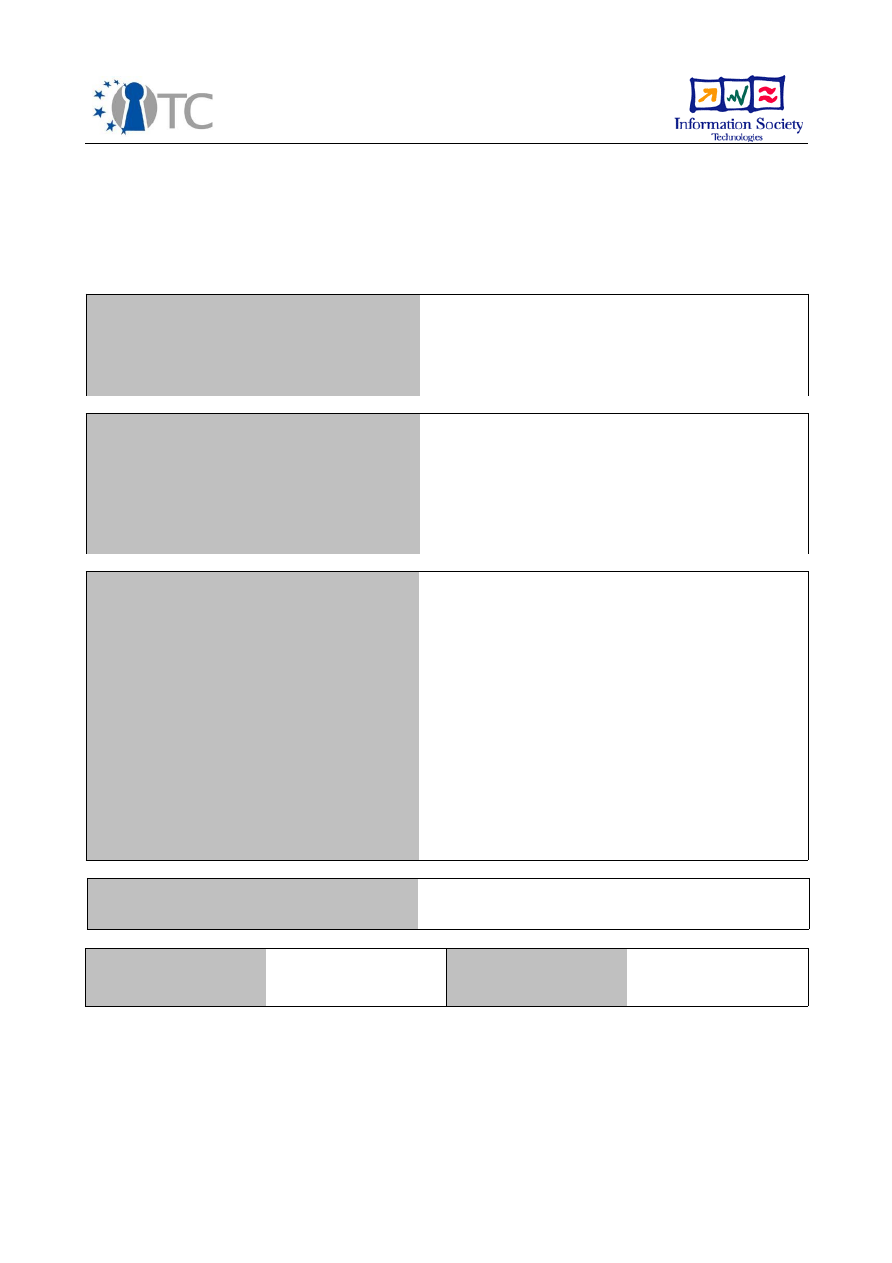
D6.3 Collection of all SWP deliverables (with
nature=R) produced during month 13-24
Project number
IST-027635
Project acronym
Open_TC
Project title
Open Trusted Computing
Deliverable type
Deliverable
Deliverable reference number
IST-027635/D06.3/FINAL | 1.00
Deliverable title
D6.3 Collection of all SWP deliverables (with
nature=R) produced during month 13-24
WP contributing to the deliverable
WP6
Due date
Oct 2007
Actual submission date
Nov 2007
Responsible Organisation
LDV,Lehrstuhl für Datenverarbeitung, TUM
Authors
Chun Hui Suen
Abstract
Keywords
OpenTC WP6
Dissemination level
Public
Revision
FINAL | 1.00
Instrument
IP
Start date of the
project
1
st
November 2005
Thematic Priority
IST
Duration
42 months

D06a.1 Preliminary DRM System Specification
FINAL | 1.00
This document is a compilation of the following deliverables:
●
D06a.3 Final DRM system specification (M 24)
●
D06b.2 A report containing the MEITC specification and test plan (M13)
●
D06b.3 Detailed design and test document (M15)
●
D06c.1 High level requirements specification (for Proof-of-Concept WYSIWYS
application
)
(M 24)
●
D06d.1 EFS C/C++ API Specification (M18)
●
D06e.4 Final MFA System Specification (M 18)
Note: The deliverable D06d.1 has been placed in the annex, as it is still incomplete
and will be revised in the next phase of the project. It is deemed not suitable for public
release and will thus not be included in the public dissemination of this document.
Open_TC Deliverable D06.3
2/2
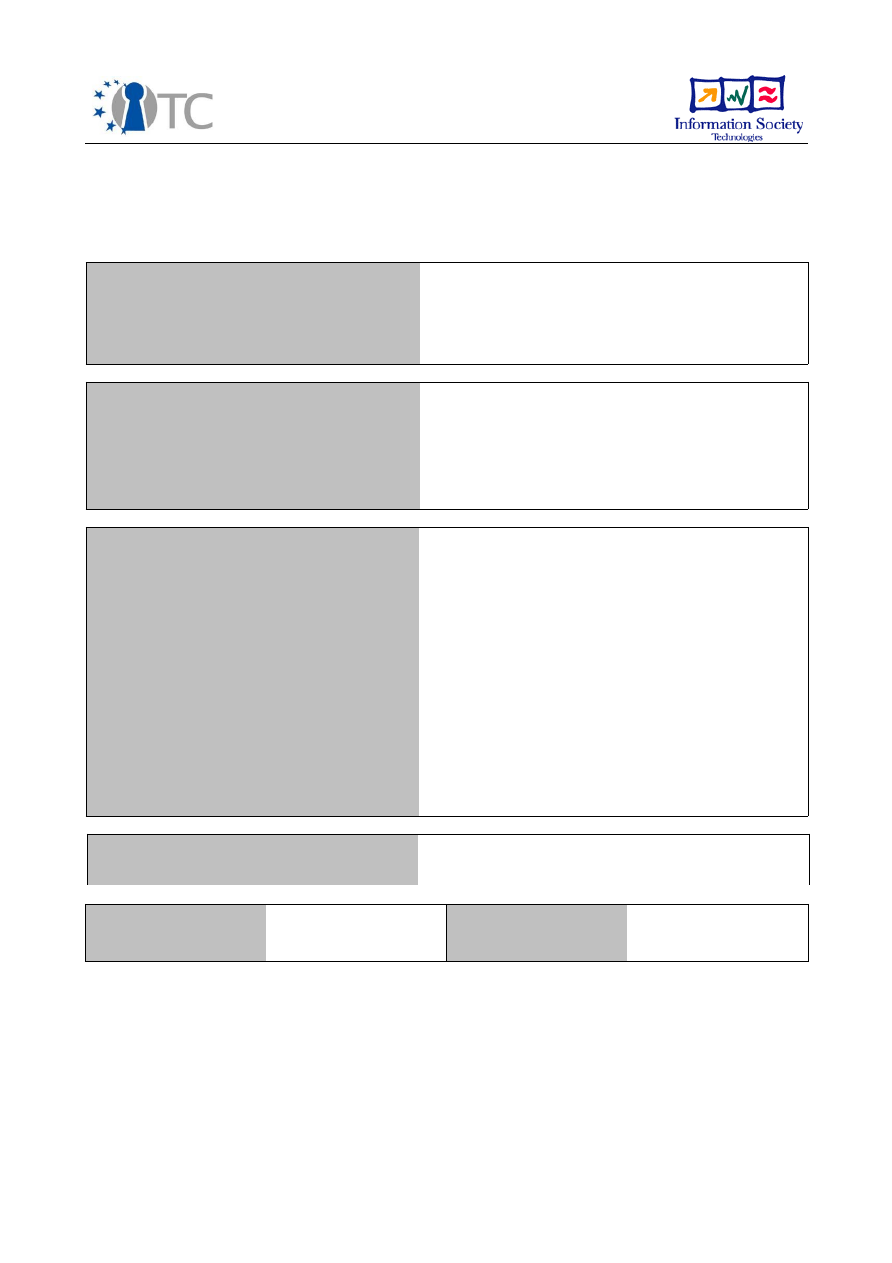
WP06a.3 Final DRM system specification
Project number
IST-027635
Project acronym
Open_TC
Project title
Open Trusted Computing
Deliverable type
Internal document
Deliverable reference number
IST-027635/D06a.3/FINAL | 1.00
Deliverable title
Final DRM system specification
WP contributing to the deliverable
WP6
Due date
Oct 2007
Actual submission date
Oct 2007
Responsible Organisation
LDV,Lehrstuhl für Datenverarbeitung, TUM
Authors
Chun Hui Suen, Florian Schreiner
Abstract
Keywords
DRM, fair, interoperable, MPEG-21
Dissemination level
Public
Revision
FINAL | 1.00
Instrument
IP
Start date of the
project
1
st
November 2005
Thematic Priority
IST
Duration
42 months

D06a.1 Preliminary DRM System Specification
FINAL | 1.00
Table of Contents
1 .Introduction...............................................................................................................4
2 .Use Cases..................................................................................................................4
2.1 Overview................................................................................................................4
2.2 Description of Use Cases........................................................................................5
3 .Design Specifications...............................................................................................10
3.1 Architecture..........................................................................................................10
3.2 Player API and Player application.........................................................................10
3.2.1 Registration.....................................................................................................10
3.2.2 Content Authorization......................................................................................11
3.2.3 Legacy Player Application................................................................................11
3.3 Manager API.........................................................................................................12
3.4 Application loader................................................................................................12
3.5 Core Manager.......................................................................................................13
3.6 License Manager..................................................................................................13
3.6.1 License Interpreter..........................................................................................13
3.6.2 License Translation Manager ..........................................................................14
3.7 State Management...............................................................................................15
3.8 Sealed storage.....................................................................................................15
3.8.1 Key store.........................................................................................................15
3.8.2 License store...................................................................................................16
3.8.3 User store........................................................................................................16
3.9 Utility library.........................................................................................................16
3.1 0OS Services........................................................................................................16
4 .XEN/L4 virtualization environment...........................................................................18
4.1Co mpartment architecture.................................................................................18
4.2In terfaces between compartments.....................................................................18
5 .Component Interaction within the DRM system.......................................................20
5.1 Functional parts of the DRM Core ........................................................................20
5.2 Sequence diagrams..............................................................................................21
5.2.1 Player API ........................................................................................................21
5.2.2 Management API .............................................................................................22
5.3 Interaction between different peers.....................................................................22
5.3.1 License and Content Key transfer....................................................................22
5.4 Domain Management...........................................................................................23
6 .Technical Specifications...........................................................................................24
6.1 External API..........................................................................................................24
6.2 Internal API...........................................................................................................24
7 .Requirements from other Partners...........................................................................25
8 .Glossary of Abbreviations........................................................................................26
9 .References...............................................................................................................27
Open_TC Deliverable D06a.3
2/27

D06a.1 Preliminary DRM System Specification
FINAL | 1.00
List of figures
Figure 1: System Overview...........................................................................................10
Figure 2: License Translation........................................................................................15
Figure 3: Virtualization of the DRM Core.......................................................................18
Figure 4: Interface Chain..............................................................................................19
Figure 5: Internal and external components of DRM Core............................................20
Figure 6: Sequence diagram for media playback.........................................................21
Figure 7: License transfer sequence diagram...............................................................22
Figure 8: Domain Client Management..........................................................................23
Open_TC Deliverable D06a.3
3/27

D06a.1 Preliminary DRM System Specification
FINAL | 1.00
1. Introduction
This document collects the specifications of a DRM system to be developed as sample
application for the OpenTC framework. These specifications define the scope of
system, describe its functional requirements and its design. The design sections of
this document are mainly focused on the definition of the system architecture by
depicting the system modules, the function of each of them and the related
interactions. Specific details of the API and communication protocol are still subject to
change depending on the interfaces provides by the underlying OpenTC framework
developed in workpackage 3 to 5 and implementation issues to be resolved.
The principal scope of the DRM system will be the protection of multimedia content.
Generalization of the DRM system for the protection of other contents, such as
personal data, secret information or medical records of the patients, would be
possible through extension of the DRM system. However, specific implementation of
such generalization will not be implemented in this sub-workpackage.
This document is organized into 9 sections. Section 2 describes the functional
requirements in terms of use cases while sections 3, 4 and 5 include the design
specifications of the system. Section 6 contains the API specification and section 7
shows the requirements for this application within the OpenTC System. Sections 8
and 9 provide glossary and references to the terms and technologies used in the DRM
system. And external companion document contains the detailed API specification.
2. Use Cases
2.1 Overview
The Interoperable DRM system application scenario describes a DRM system that is
based on Trusted Computing and MPEG-21 for protecting multimedia content. The
system can be divided in 2 main parts: the DRM Core and the secure application.
The DRM-core runs as an independent domain that handles the content licenses and
the content keys. It exposes this functionality through an application programming
interface (DRM Core-API) to applications. The DRM-core is responsible for parsing
licenses, deciding on whether access to requested content is allowed and managing
the content keys. The core also support the management of user domains, which
allows a user to play content on multiple platforms, that belong to his domain. The
core handles the registration of other platforms to a domain and issues domain
licenses for these peers.
The secure application is in the simplest case a media player. The application uses the
DRM Core-API provided by the DRM-core to gain access to protected content. After a
verification process, the application receives the content key from the DRM Core and
is able to render the content.
The user can perform different actions with the secure application. Every action
triggers a process between the application and the DRM Core. For the DRM system we
differentiate between these 5 main use cases:
•
Installation of the system
•
Download content
Open_TC Deliverable D06a.3
4/27
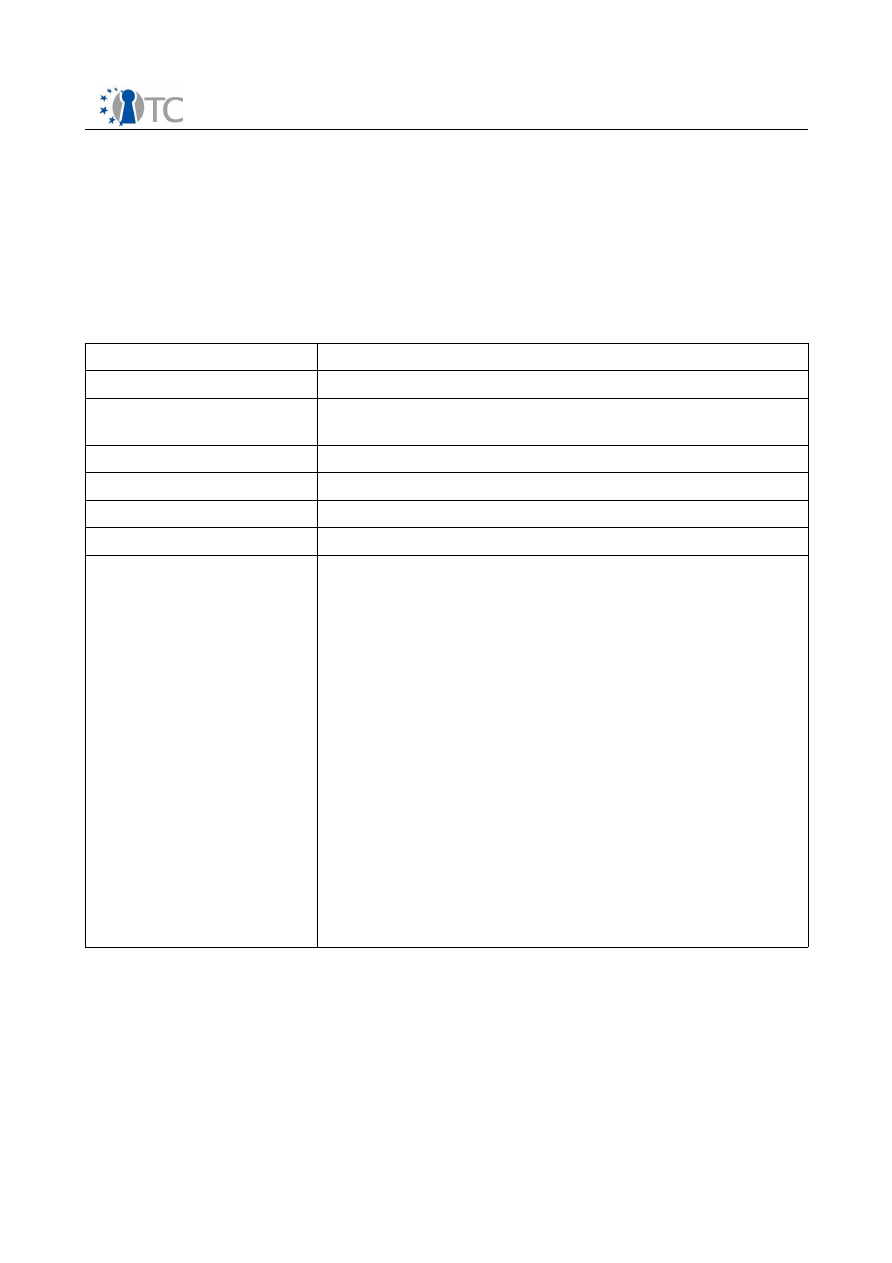
D06a.1 Preliminary DRM System Specification
FINAL | 1.00
•
View / Consume Content
•
Renew License
•
Transfer License
In the following sections these different use cases are explained in detail. They
describe step by step, what happens when the user intends to perform an action.
2.2 Description of Use Cases
Use Case Unique ID
/ UC 10 /
Title
Installation of the system
Description
The administrator installs the DRM System within the
OpenTC framework.
Actors
Administrator
Preconditions
The OpenTC framework was started.
Postconditions
The DRM Core is installed/initialized.
Comment
Normal Flow
1. The administrator installs a DRM-Core and starts it
in a separate compartment.
2. The administrator installs the DRM player in a
separate secure environment for rendering of the
content.
3. A signed policy file establishes the following
requirements:
•
Trusted I/O Channels: We need a secure audio
and video output path for rendering content.
•
Access to the trusted services from the
compartment, especially to the DRM Core.
Access to the Core will be limited by its API.
•
Ability to display an application in a Window-
System, which is started in the secure
environment. An efficient method for video
rendering should also be supported in a secure
manner (for example Overlay).
•
Integrity measurement of all applications and
plugIns that can be used to reproduce content
in a secure way.
Open_TC Deliverable D06a.3
5/27

D06a.1 Preliminary DRM System Specification
FINAL | 1.00
Use Case Unique ID
/ UC 20 /
Title
Download content and install license
Description
The user downloads a content.
Actors
User
Preconditions
The OpenTC framework was started and the DRM Core is
running in a secure environment.
Postconditions
The content keys and the license are kept secure in the
sealed storage.
Comment
Normal Flow
1. The user downloads a container file either from a
provider or another user. The file consists of the
multimedia content. The downloading and the
storage can be unsecured, because the data is
always encrypted.
The license can also be transferred in this step. It
doesn't need to be protected, since it is signed by
the content provider.
2. The user starts the secure environment.
3. The user starts the player application for the
retrieval of the content keys.
4. The player application establishes a secured
connection to the provider for exchanging the
content keys.
5. The DRM Core generates an attestation identity
keys (AIKs) and encryption keys using the TPM, so
that the content provider can encrypt the content
key.
6. The user receives the content with an embedded
license. This license is forwarded to the DRM core.
7. The license for the content is checked and
preprocessed in the DRM core. The encrypted
content is decrypted and stored in sealed storage.
The important information of the license is stored
in the sealed store.
Open_TC Deliverable D06a.3
6/27

D06a.1 Preliminary DRM System Specification
FINAL | 1.00
Use Case Unique ID
/ UC 30 /
Title
View / Consume content
Description
The user tells the player that he wants to view or
consume the content of a protected file.
Actors
User
Preconditions
The OpenTC framework was started and the player
application and DRM Core are running in a secure
environment.
Postconditions
Comment
Normal Flow
1. The user starts a player application, which runs in
the secure environment.
2. The user triggers the application to access a
protected media file for rendering.
3. The player application registers with the DRM-
Core. Then it asks the DRM-core through the API to
enable access to the protected information by
handing out the content key from the key store.
4. The Core is presented with the content's unique DII
(Digital Item Identifier) along with the requested
action (e.g. play, print, burn etc.) and decides on
whether access is granted or not. If yes, the DII is
used to query the key store for the content key.
The key store itself is an encrypted file and is
protected by sealing its key to a trusted system
configuration. Thus, the core can only access the
key store when the system is in a known trusted
state.
5. Then the DRM-Core hands out the content key to
the application. It poses no threat since the system
and the player application are trusted.
Open_TC Deliverable D06a.3
7/27

D06a.1 Preliminary DRM System Specification
FINAL | 1.00
Use Case Unique ID
/ UC 40 /
Title
Renew License
Description
Generally licenses are valid until a final date. After this
date, the license expires and the user has to renew his
license from a license server.
Actors
User
Preconditions
The OpenTC framework was started and the DRM Core is
running in a secure environment.
Postconditions
New license is stored securely in the sealed storage.
Comment
Normal Flow
1. The user triggers the license renewal and the
player application connects to the content
provider.
2. The DRM-Core performs an authentication
procedure similar to that in the download
procedure.
3. The player application replaces the existing license
by a new one.
Open_TC Deliverable D06a.3
8/27

D06a.1 Preliminary DRM System Specification
FINAL | 1.00
Use Case Unique ID
/ UC 50 /
Title
Transfer License
Description
Licenses are transferred to other computers or are
translated to other DRM-Systems.
Actors
User
Preconditions
The OpenTC framework was started and the DRM Core is
running in a secure environment. Manager application
and target DRM system are running in a secure
environment.
Postconditions
Transferred license is stored secure in target DRM
system.
Comment
Normal Flow
1. The user initiates a transfer.
2. Then the Manager application establishes a secure
and authenticated connection between the two
systems. The license and content key are
transmitted securely. A similar authentication
procedure as in the download and renew license
use case is required.
3. In case a different DRM system needs to be
supported, the existing license must be translated
by the DRM Core. The translation may also require
a re-encryption of the content. Furthermore, the
translated license has to be signed by the DRM
Core, which will use the TPM to enable trust to its
signature.
4. The player application transmits the content itself.
This is not a security problem, since the
transferred data is always encrypted.
Open_TC Deliverable D06a.3
9/27
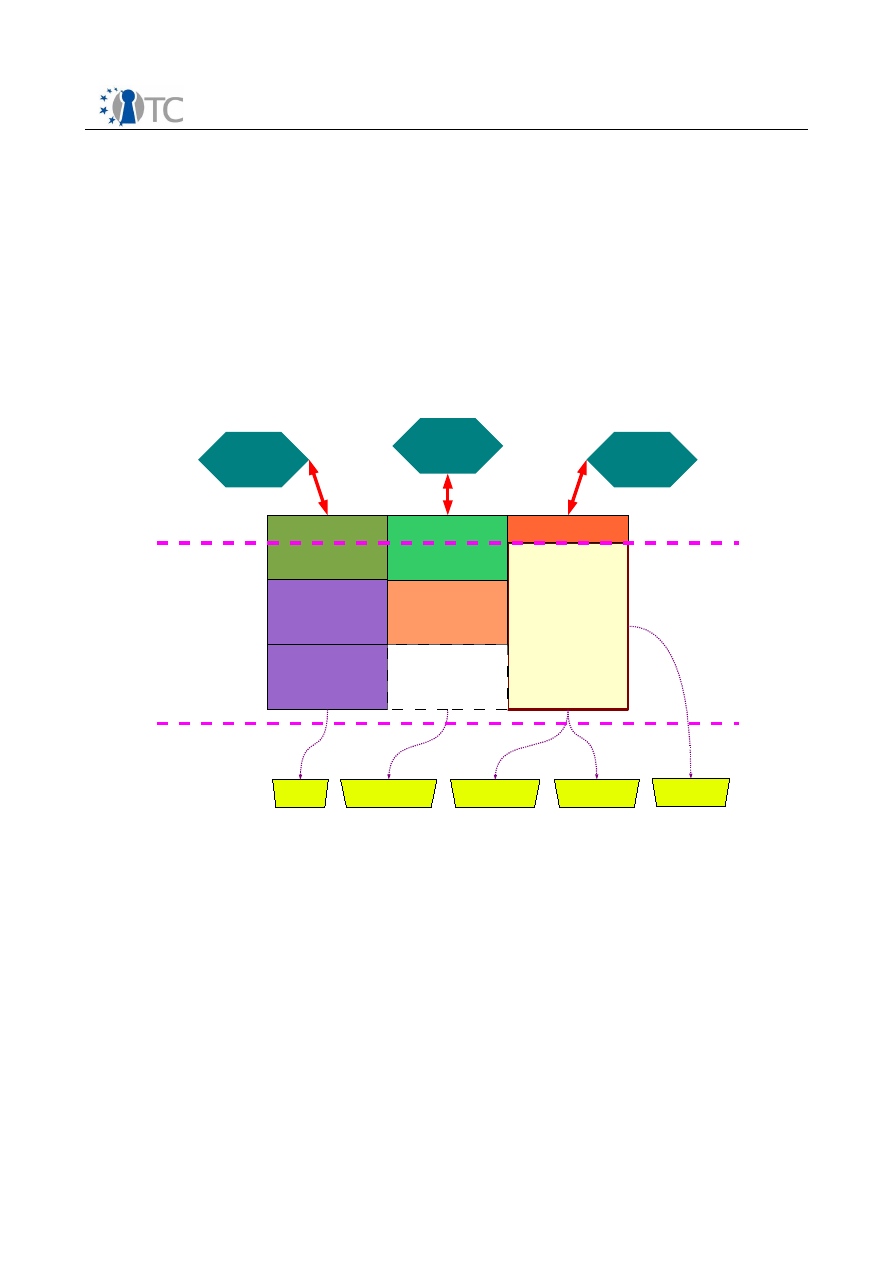
D06a.1 Preliminary DRM System Specification
FINAL | 1.00
3. Design Specifications
3.1 Architecture
The diagram below shows the major components which make up the OpenTC DRM
system. The entire system can be divided into 3 sections, namely applications running
in userspace, the DRM Core which is running in a secure compartment, and security
services provided by the operating system and compartment management. The
precise separation of the system components among different secured compartments
is explained in section . The following sections will explain the individual components
of the system in detail.
3.2 Player API and Player application
The Player API is used for two purposes: the registration of a player application
(Player) and the content authorization. The following sections describe these two
functionalities in details.
3.2.1 Registration
Each Player who wants to access a protected content must register with the DRM Core
first. During registration, the Player and DRM Core starts a secure channel which can
only be opened if the core and player are running in a trusted state (provided by
OpenTC framework).
Additionally, the Core gets some information about the player, e.g. the version number
or process information, so that the Core can distinguish between multiple players on
Open_TC Deliverable D06a.3
10/27
Figure 1: System Overview
License
Manager
(License
Interpretation
& Translation)
Player
API
Manager
API
Core
Manager
Sealed storage
(Key/License
Store)
Application
Loader
Sealing
Secure Time
Attestation
Crypto. Lib.
Measurement
Player
Manager
GUI
I/O
OSServices
DRM
Core
Userspace Applications
Utility Library
State
Management

D06a.1 Preliminary DRM System Specification
FINAL | 1.00
the same machine. After the authentication the capability negotiation follows, where
the core negotiates a common rule set with the Player instance. This rule set defines
the REL commands, that both, player and core, have a common understanding of. This
mechanism enables the Core to discover, which commands the player supports and in
what way the Core can control the Player.
This restriction description can be done by using the subset of REL commands related
to representing conditions on operations, time and state. This allows a well defined
command set to be used, without defining a new standard.
After successful registration, the player is considered trustworthy to handle the
protected content in a correct and predictable way.
3.2.2 Content Authorization
After a successful registration the player can request the content key for a particular
protected content. This triggers a process of retrieving the associated license(s) of the
selected content and interpretation of this license. The Core then comes to the
decision if the player is allowed to access the content or not. This “Result” is described
in a XML format similar to the MPEG-21 REL and is transmitted to the Player.
If the Result is positive and the Player is generally allowed to access the content.
Together with a positive Result, the Core also transmits the content key so that the
Player can decrypt the content.
Furthermore the Result may contain several additional conditions, which have to be
enforced during the process of rendering. The content provider can define these
conditions to specify in what way the content can be rendered. An example condition
would be that the player should play only the first 10 seconds of a song. The player
has to understand these conditions in order to be able to enforce it correctly.
The capabilities of the player for these conditions are negotiated during the
registration, so the Core knows which conditions the player is able to enforce. For
example during the registration, the player informs the core, that he is able to enforce
the rule “play only the first x seconds” and the Core saves this property in an internal
storage. When a license is validated and this rule should be applied for the value 10,
then the Core generates a Result, which contains the rule that states “play only the
first 10 seconds”.
Decryption Modules are needed, when the Player receives a positive Result and then
wants to decrypt a specific content. Generally every content can use its own
encryption algorithm depending on the producer of the content. If the Player wants to
decrypt these contents, he needs access to all corresponding encryption libraries. This
functionality is provided by the Utility Library, which the player can use to get access
to a corresponding implementation of the encryption algorithm. The Utility Library is a
part of the API and provides a standardized interface for essential algorithms. The
mechanism within the Utility Library is explained in section 3.9.
3.2.3 Legacy Player Application
All specifications in the API are standardized and can be used by the player
applications. Generally the Player should be compatible to the DRM-System to know
the API of the core and how to handle content. An optional feature is to provide
support for legacy players, which cannot access the API directly. Players of that kind
Open_TC Deliverable D06a.3
11/27

D06a.1 Preliminary DRM System Specification
FINAL | 1.00
are not aware of the DRM Core, but maybe favored by users for whatever reason.
These cases are handled by capturing the file reading operation and redirecting the
request to the DRM core during the read cycle. In this way, the handling of license
authentication and interpretation occurs transparent to the application.
For the player, the whole process is similar to a normal file access. The player receives
the unprotected content from the socket and can render it. The file access capturing in
this case converts and forwards requests through the API to the DRM Core. Since all
applications, including the legacy ones, run in the secured environment, handing out
the content key or the decrypted content itself is no problem, since it is guaranteed
that the applications cannot compromise it.
3.3 Manager API
Manager API provides an interface to management features of the DRM Core, The
provided functionalities can be divided in the following four categories:
•
License Management:
–
Insertion of new licenses into the DRM Core
–
Renewal of existing licenses
–
Deletion of invalid or expired licenses
•
License Transfer:
–
Generation of a Transfer Licenses to an external peer
–
Request for attestation keys
–
Generation of signed certificates
•
User Management:
–
Adding and Removing users of the system
•
Domain Management:
–
Registration and de-registration of Domains
License Management is used to update the license storage of the DRM Core. For a new
content, the respective licenses can be added and for an expired content, the
corresponding license can be renewed or removed. The License Transfer functions
provide information for the acquisition and transfer of licenses to external peers. The
Domain Management and User Management functions allow the Manager GUI to
update the current domains and the users of the system.
The Manager API (defined in
ManagementInterface
) differs from the Player API, so
that playback and administrative functions of the DRM Core are clearly separated.
3.4 Application loader
The initial loading of the DRM Core needs to be done in a secure manner. This should
be handled by the compartment and device manager, which will check the integrity of
the compartment image before loading the DRM Core. In addition to the main image, a
secure persistent storage is used to provide secure storage for the DRM Core, that will
be discussed in sections and .
Open_TC Deliverable D06a.3
12/27

D06a.1 Preliminary DRM System Specification
FINAL | 1.00
3.5 Core Manager
The central component of the system is the Core Manager. It's tasks are the central
management of the different parts of the DRM-Core. It coordinates the requests from
the application layer and forwards them to the appropriate components. It also
contains the error handling such as fail over, treatment of invalid data, error logging
and exception handling.
3.6 License Manager
The core manager implements the interface to the Player and Manager GUI, and
coordinates the management and enforcement of licenses. When the player wants to
decrypt a protected content for a particular action, it sends a request to the core
manager, with a reference to the protected content and the request parameters. This
request contains the rights and the corresponding license, which have to be verified. A
request may also consist of multiple licenses.
Upon request from the player, the DRM Core makes the appropriate query to the key /
license storage, and sends the complete request to the license manager. In this case
the License Interpreter has to verify each license and determine if the right may be
granted over the content.
Depending on the license type, this is performed by the appropriate license
interpreter, generating an internal representation of the license. When the license is
positively authorized, the content key is retrieved from the key storage and returned
to the player with an appropriate player restriction description.
When this player restriction needs to be adapted, or if a license is requested, then the
query is passed to the license translation manager.
3.6.1 License Interpreter
The licenses, that are stored in the sealed storage are in an XML format. Before these
licenses can be interpreted, license parsing needs to be carried out. This process maps
a license into an internal representation suitable for interpretation.
The parsing process takes place in two steps. First, the formal integrity of the received
data is validated, for e.g. XML-formatted licenses this includes schema- or DTD-
validation.
In the second step the authenticity and integrity of the data must be validated. The
most utilized approach is using digital signatures on the license, like XML dsig,
together with X509 based certification chains. To leave the possibility to extend the
concept to new formats, the signature checking uses the utility library as plug-in
architecture for the verification.
After the parsing of the license, the interpretation can be performed. In this process
the internal representation of the license is matched against the operation request
from the player application. The matching returns either a positive or negative result.
A positive result implies that the player application is allowed to decrypt and render
the specified content. However, depending on the license, a positive result may also
include additional restrictions which the player must support and enforce.
The OpenTC license model strives to support the concept of a “fair” DRM system as
well. This means, that the content creator has the possibility to create licenses, that
Open_TC Deliverable D06a.3
13/27

D06a.1 Preliminary DRM System Specification
FINAL | 1.00
are beneficial not only for the content provider, but also the consumer of a content.
The DRM system is designed in such way, that all participants will be treated equally,
so that every participant can either act like a content consumer or a content provider.
A content provider can use the system to protect his own creation against any misuse.
Nevertheless the content provider can still decide to restrict the usage of the content
in an “unfair” way. This decision isn't based on a technical problem, but rather a
consequence of the business model. In order to have a fair usage of DRM, each
participant has to consider carefully its business model. The business model should
provide different added-value to the user, by granting additional rights to the user. We
foresee the following rights, which would support a “fairer” usage of DRM:
●
copy
●
burn
●
sell
With the right to “copy”, the consumer can create a limited amount of private copies.
By transferring these copies, the content can be shared with a small number of
OpenTC devices, which belong to the domain of the user. This domain is defined
beforehand in the license, which contains a specified maximum number of devices
within the domain.
In the same way, the right “burn” grants the user to save the content on a disc. “Sell”
means, that a consumer can sell the content to another user. With these technical
possibilities, the DRM works almost transparently to the consumer.
3.6.2 License Translation Manager
In order to support interoperability between different systems, we propose to include a
license translation system, to support the translation of licenses between different
license description schemes, e.g. Open Mobile Alliance (OMA) REL, Digital Video
Broadcast Content Protection or Content Management DVB-CPCM. This allows content
to be received from or exported to foreign DRM systems or to external devices which
do not support the MPEG-21 REL license format.
This enables a seamless experience for the user, by allowing multimedia content to
easily move between different interoperable systems and devices.
The parsing of the license to be translated is first performed, which creates an internal
representation of the license. This is then handed to the translation engine with the
required translation requirements, such as target license language and profile.
Requirements for the translation system are:
●
Element name translation / adaptation
●
Restructuring of license elements to a legal structure in the other language
●
Contractive translation of unsupported elements
Figure 2 shows the translation between two license languages. Element renaming can
be handled trivially, but restructuring and contractive translation (where an alternative
description must be generated that best matches the original element) of elements
not found in the original language, will require intelligent rules for such
transformation.
Open_TC Deliverable D06a.3
14/27

D06a.1 Preliminary DRM System Specification
FINAL | 1.00
The proposed solution is to use an expert system architecture to transform a
knowledge representation of the original license into another license language.
Transformation rules can be built to translate the element names, make appropriate
contractive translation of elements which are not found in the target language, and an
output phase which generates the output license in a different structure.
3.7 State Management
The State Manager is responsible for managing system and license-related states.
System states are a general framework to access information related to the DRM
system (such as current player capabilities and credentials) and machine-related
parameters (such as time and location). License-related states are used to store
persistent information needed for license interpretation (such as playback counter).
3.8 Sealed
storage
The sealed store consists of three parts: the key store, the license store and the user
store.
3.8.1 Key store
A particularly important component of the core is the key store. The key store contains
the keys which are used to access (namely decrypt) the protected content in the
system. The DRM Core ensures that a content key is given out only when a requested
action is allowed by the license. The key store is organized as a table which contains
keys and unique content identifiers. The same identifiers are used in the licenses to
reference content. Respective technologies are part of the MPEG-21 standard. The key
store is implemented as a secure database, which is decrypted by the core when a
secure environment is established. This is done with the help of the TPM, which seals
the key storage master key, so that it can only be accessed when the system is in a
secure state. The core itself is thus only able to retrieve the master key when the
system has not been compromised.
Open_TC Deliverable D06a.3
15/27
Figure 2: License Translation

D06a.1 Preliminary DRM System Specification
FINAL | 1.00
3.8.2 License store
As described previously, License Interpretation Manager relies on an internal
representation of licenses. The structure of this Internal license store is similar to the
structure defined in MPEG-21. To speed up the evaluation of licenses by the License
Interpretation Manager, each single syntactic object of a license, namely principal,
digital item, grant and condition, is mapped to a specific internal object representation
that is optimized for the evaluation process. The internal storage offers some basic
search methods on the storage objects for selecting certain items based on different
criteria or for matching two items against each other. The license is also stored in the
secure database, to protect against any unauthorized change to the license outside of
the DRM Core. Regarding the semantic of the stored elements, we strictly use values
from the RDD-Standard issued within the MPEG-21 framework.
3.8.3 User store
The User store contains credentials of the user of the system. This information is
needed to authenticate different consumers and to verify if a consumer is allowed to
access the content. The storage contains an identifier of every user and public/private
key pair for the verification of signatures. The user authentication depends also on the
user management of the underlying operating system, so that the credentials might
change or additional information might be needed.
3.9 Utility library
In order to support an extensible DRM system, a utility library is provided to both the
player application and the DRM Core. This utility library provides a centralized
mechanism in which new tools for decoding, encryption, decryption, signing, and so
on, can be retrieved and made available.
The Player Application can request a decryption tool from the Utility library to be able
to decode the content. The DRM Core may also need cryptographic tools, for signature
verification or self-signing generated licenses (for instance, in the case of license
translation from another DRM system).
The Utility library follows the concept of MPEG-21 IPMP tools, in which tools for specific
functions can be identified and automatically retrieved for the target platform. This
allows the DRM Core and player to support new media (new codecs) and licenses (new
cryptographic tools) when newer tools become available.
An important security aspect is that this utility library itself must be verified
beforehand, and must run within a secured environment. Mechanism to verify the
integrity of the retrieved tools, such as tool signing, must be implemented to ensure
that the tool cannot be modified to introduce security weaknesses.
3.10 OS Services
The necessary OS services required by the DRM Core are secure time, sealing,
compartment measurement, attestation, cryptographic libraries. Secure time
mechanism provides a trustworthy source of time, on which time-related license
conditions can be verified.
Sealing of the license and key stores of the DRM Core, and measurement of the DRM
Open_TC Deliverable D06a.3
16/27

D06a.1 Preliminary DRM System Specification
FINAL | 1.00
Core compartment should be performed by the OS compartment manager, prior to the
starting of the DRM Core compartment.
Services to aid the attestation of the DRM Core to services on the Internet, such as the
generation of AIK keys, need to be provided by the underlying framework.
Standard cryptographic libraries are also necessary in order to perform decryption and
hash operations as required by the DRM Core and Player application.
Open_TC Deliverable D06a.3
17/27
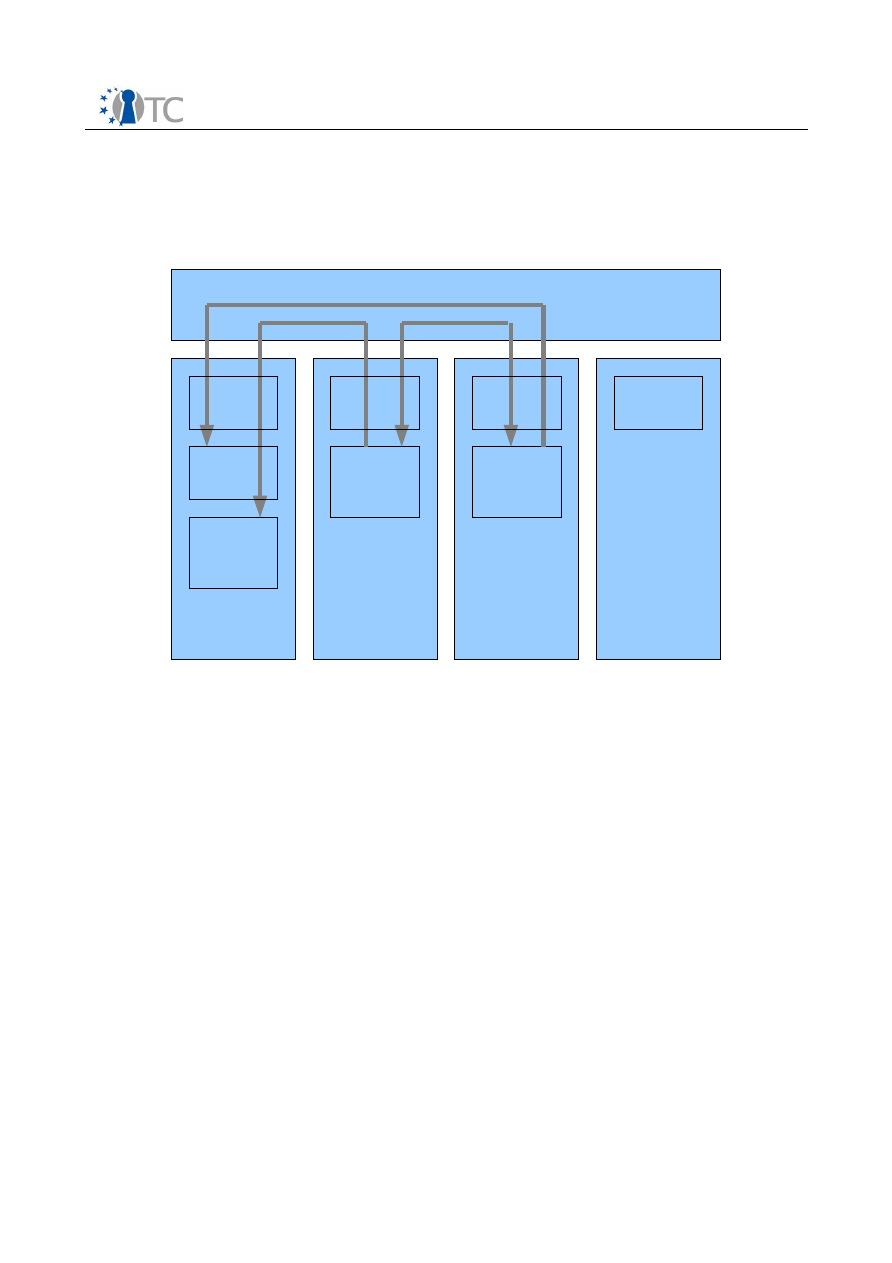
D06a.1 Preliminary DRM System Specification
FINAL | 1.00
4. XEN/L4 virtualization environment
4.1 Compartment architecture
In order to take advantage of the secure application isolation provided by the
virtualization framework in OpenTC, higher security can be achieved by separating the
player application and DRM Core into separate compartments. Figure 3 shows virtual
machine partitioning of different components. The DRM Core as described in section 3
runs in a protected compartment, while the OpenTC Player runs in a different
protected compartment. Since the information traffic between the DRM Core and
player is not high, this is not a big performance penalty. The hypervisor, and OS
components such as kernel and drivers are not described in this document.
For the rendering of the content, the player needs access to device drivers/kernel
modules. This access is controlled by security policies which only allows
communication with signed device drivers/kernel modules in the service compartment.
This enforces the secure output path criteria. The DRM Core has access to a secure
storage provided by the service compartment. Sealing is used to encrypt this storage,
such that the DRM Core can only access it when the OS and the DRM Core are not
modified.
Open_TC Deliverable D06a.3
18/27
Figure 3: Virtualization of the DRM Core
Hypervisor
Service
Compartment
Protected
Compartment1
Protected
Compartment2
Unprotected
Compartment
kernel
Sealed
storage
DRM
Core
Secure
Application
kernel
kernel
kernel
Signed
drivers
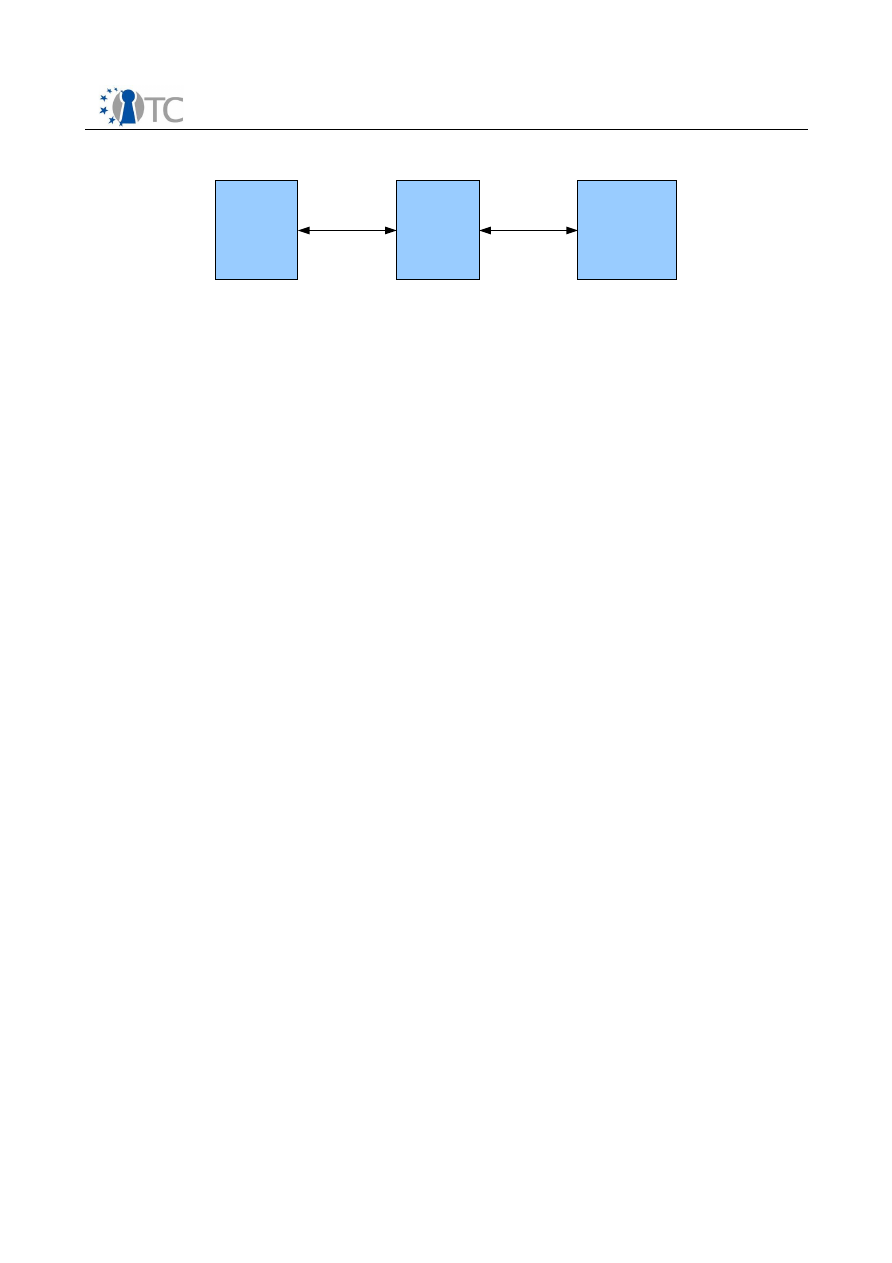
D06a.1 Preliminary DRM System Specification
FINAL | 1.00
4.2 Interfaces between compartments
A generic way to achieve communication between two compartments is the definition
of a network RPC between them. This form is used for the connection from the secured
application to the DRM Core. The security policy of the channel can be defined via an
interface from the operating system. Furthermore some rules of the license may have
to be applied, e.g. the content may not be rendered at the same time in more than
one player application. XML-RPC [7] is the RPC protocol used in this case, as it
provides a simple implementation as well as widely available cross-platform libraries
for binding with many languages. This RPC interface exposes methods from the
PlayerInterface
and
ManagementInterface.
The interface between the DRM Core and secure sealed storage is implicit, in that it is
achieved by mounting secure mount points within the compartment of the DRM Core.
This is controlled by the compartment and device manager in service compartment.
The sealed storage is used for the storage of the licenses and the content keys.
Open_TC Deliverable D06a.3
19/27
Figure 4: Interface Chain
Sealed
storage
DRM
Core
Secure
Application
Mounted
directory
Network
RPC
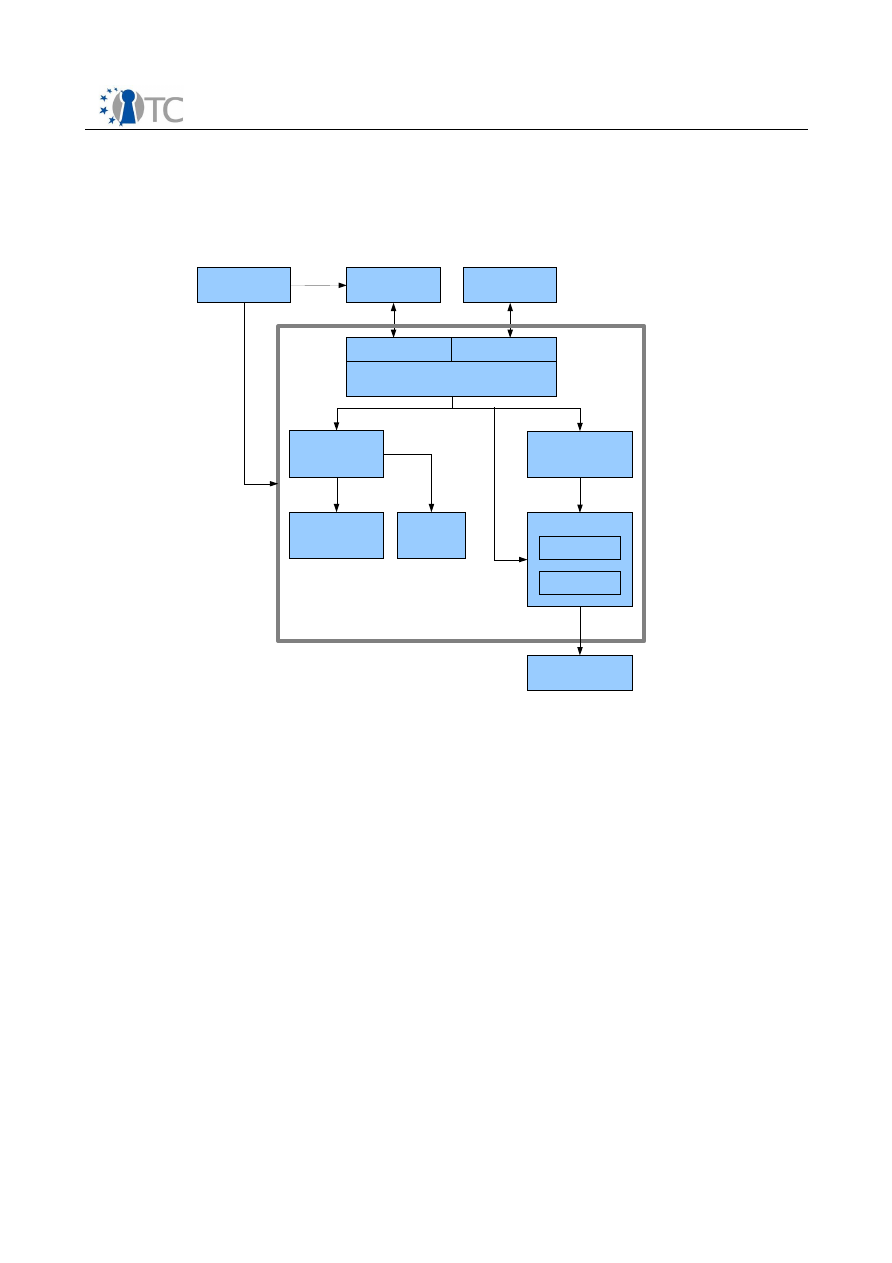
D06a.1 Preliminary DRM System Specification
FINAL | 1.00
5. Component Interaction within the DRM system
5.1 Functional parts of the DRM Core
The DRM Core consists of five key functional parts: The Core Manager, License
Manager, License Translation Manager, State Manager and Database Manager. The
Database Manager is a component that provides the access to the sealed storage.
Figure 5 shows the inter-relations of the different modules.
The Core Manager provides the API's to the user level applications. The Core Manager
is directly connected to the License Manager, the State Manager and the Database
Manager.
The License Manager can process licenses and then decides to which component the
license should be forwarded. If a license shall be interpreted, he uses the License
Interpreter, which parses the license and compares it to a given set of conditions. The
License Translation Manager is used, if a license has to be converted to or from other
DRM-Systems. The Manager can either import or export a license from another
compatible system.
The State Manager contains the current states of the applications and contents. It
monitors all players that are connected to the DRM Core and provides state
information about players, system and digital items.
The Database Manager has a connection to the key store and the license store. The
Core Manager can request specific keys and licenses from the Database Manager,
Open_TC Deliverable D06a.3
20/27
Figure 5: Internal and external components of DRM Core
Core Manager
Player Interface
Manager Interface
OpenTC Player
Manager GUI
Database Manager
State Manager
License
Manager
License
Translation
Manager
License
Interpreter
Sealed & encrypted
storage
Key store
License store
DRM Core
Utility Library
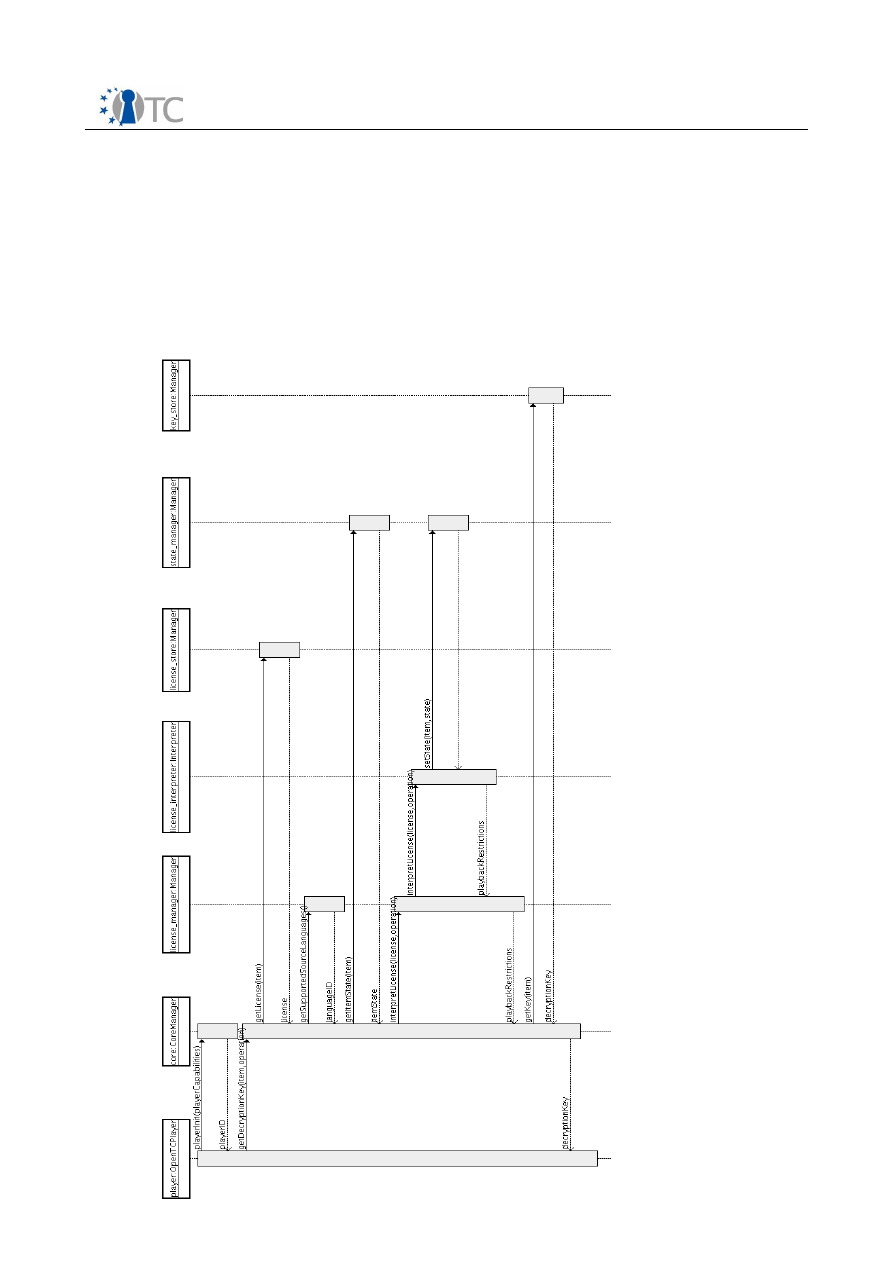
D06a.1 Preliminary DRM System Specification
FINAL | 1.00
which are then retrieved from the key store or the license store.
5.2 Sequence diagrams
5.2.1 Player API
Figure 6 shows the sequence diagram for interaction between the player and different
components within the DRM Core. The player application first performs an initial
Open_TC Deliverable D06a.3
21/27
Figure 6: Sequence diagram for media playback
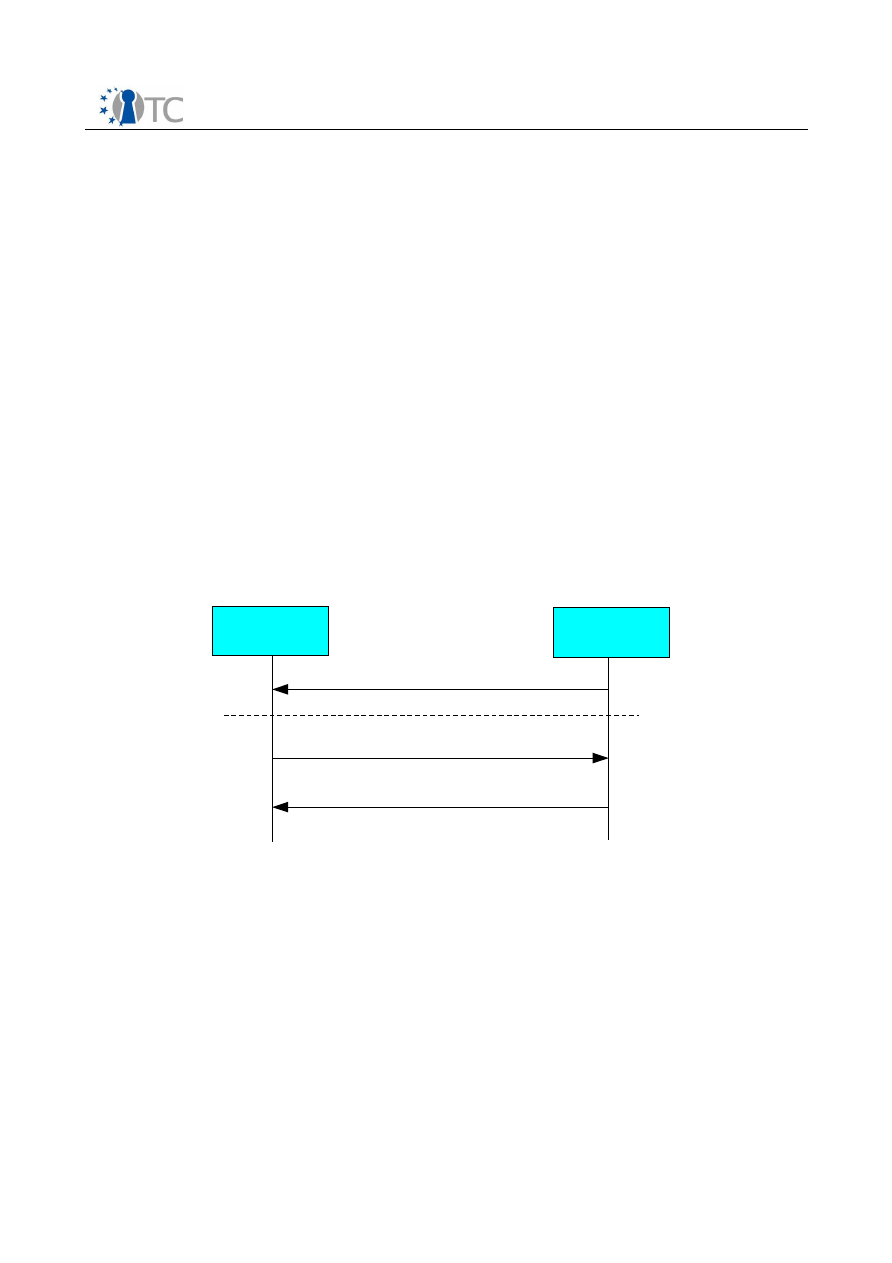
D06a.1 Preliminary DRM System Specification
FINAL | 1.00
handshake with the DRM Core by reporting its playback capabilities, and receives as a
response a
PlayerID,
which the DRM Core uses to identify different players
connected to the core. Upon the player requesting to decrypt a digital item, the core
manager handles the request and calls the appropriate modules within the DRM Core
to process the request. Upon success, the content key is retrieved and returned to the
player.
5.2.2 Management API
The functions of the Management API are processed in a similar way to the ones of the
Player API. The functions called from the Management GUI are processed by the
CoreManager, which passes the parameters to the corresponding component.
5.3 Interaction between different peers
5.3.1 License and Content Key transfer
A license and Content Key has to be transferred, when a content is moved from one
peer to another, e.g. when a content is sold to another user.
The figure shows the sequence diagram of the key and license transfer from user B to
user A.
In a first step the public key of the user B need to be transferred to user A. This step
can be skipped, if the key of user B can be verified by a certificate hierarchy based on
a trusted root certificate. After that, User A transmits the Content Request Certificate
to User B. The Content Request Certificate contains a public encryption from User A
and a content identifier to request a specific content from User B. The certificate is
signed by User A using an AIK.
User B responds with the Encrypted Content key, that is encrypted with the public key
of user A. User A can decrypt the key and store the key in the key storage of the DRM
core. Then user B transmits the license, which is signed using his private key. User A
verifies the signature and stores the license in the license store. If the transmission
were successful, user B removes the license and the content key from his sealed
Open_TC Deliverable D06a.3
22/27
Figure 7: License transfer sequence diagram
User A
User B
Public Key
Peer B
Content Request Certificate
Encrypted Content Key
Signed license
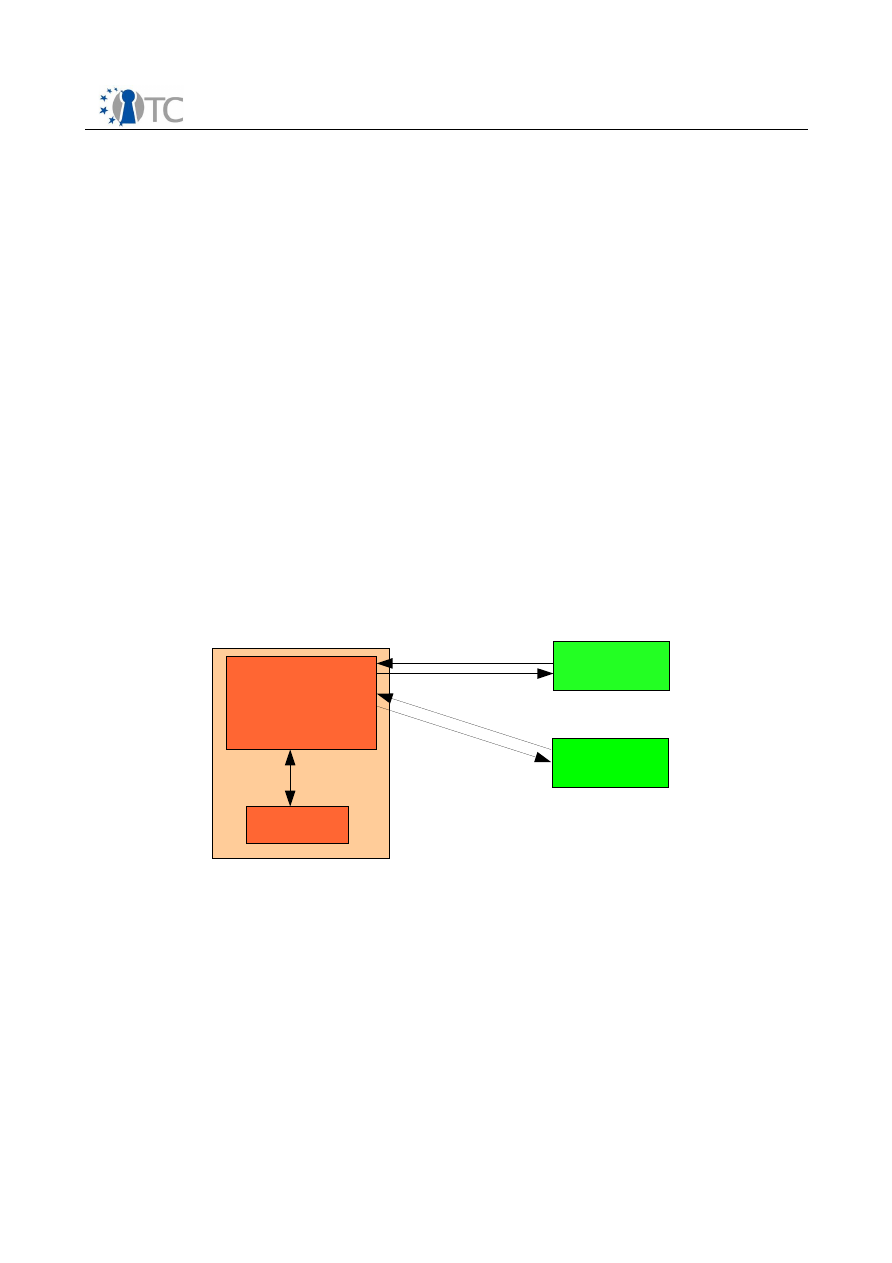
D06a.1 Preliminary DRM System Specification
FINAL | 1.00
storage.
5.4 Domain Management
The DRM-Core supports the usage of domains, which allow users to share the content
with other platforms. A content can be consumed on every platform, that belongs to
the same domain. The license of the content specifies the maximum number of peers,
that are allowed to join the domain. Every content has an own domain, so each
content can be assigned to any other peer, when the limit of peers has not exceeded.
A peer can act either as a domain controller or as a domain client. The domain
controller manages the domain and controls the number of peers, that joined the
domain. The domain client is a member of the domain, who is able to play the content.
The following figure 8 shows the management of the domain clients. If a domain client
wants to play a content as a domain member, it contacts the domain controller. The
domain controller checks that the number of domain clients is not exceeded. After
that, the domain controller registers the requesting client as a domain member and
generates a domain license for the client. The domain license is a temporary license,
that is issued for the domain client and that is signed by the domain controller. With
this license, the domain client has the permission to play the content as a member of
the domain.
Open_TC Deliverable D06a.3
23/27
Figure 8: Domain Client Management
DRM Core
Domain Controller
Peer A
Domain Client
Peer C
Domain Client
Peer B
Reques
t Domain L
icense
Domain License
Domain
License
...
Request Domain License
Create Domain License

D06a.1 Preliminary DRM System Specification
FINAL | 1.00
6. Technical Specifications
The technical API specifications is described in a separate companion document
“System API Specifications”, formatted in a javadoc style. The System API
Specifications describes both external and important internal API used in the DRM
core.
6.1 External API
The DRM Core exposes 2 main API to the player and management software, namely,
the
PlayerInterface
and
ManagementInterface
. These 2 interfaces are used by the
network backend component of the DRM core, which handles communication between
the core, and the player and management software respectively.
6.2 Internal API
The System API Specifications also specifies important internal API and classes. This
illustrates the internal structure and organization of the DRM Core.
Open_TC Deliverable D06a.3
24/27

D06a.1 Preliminary DRM System Specification
FINAL | 1.00
7. Requirements from other Partners
The secure application is generally a media player that uses the DRM Core-API to
render protected content. The application needs to be secure, because it is allowed to
decrypt the content. To maintain the security of the system, the player application
should run in a separate compartment, whose integrity and authenticity were checked
before its execution.
Furthermore the DRM system expects the presence of an underlying trusted system
and requires the following services from it:
●
Secure Environment.
The DRM Core and the media player application may
only execute when a secured environment is present. Thus, the underlying
system must provide:
●
Memory isolation and protection of processes running in the secure
environment.
●
Secure audio and video output paths to certified (signed) hardware
drivers and/or hardware. No unauthorized application or service
should be able to read from this output path. Optionally cryptographic
protection between the driver and the hardware can also be applied
when supported by the hardware.
●
A means to measure the integrity of the DRM system and associated
applications. This implies the existence of a method for measuring
applications before they are loaded and executed. (this is implicitly
enforced by the installation policy definition)
●
Cryptographic services.
The DRM Core requires several cryptographic
services which have to be provided by the underlying system:
●
A Trusted Software Stack (TSS), supporting AIK generation and
sealing. AIKs are required for authentication/remote attestation
purposes, while sealing is used to lock cryptographic keys to specific
system configurations. The core can thus ensure that content keys
are only accessible when the systems integrity is ensured. (this is
done indirectly by TPA)
●
Sealed Storage. The DRM Core will use sealed storage for its license
and key databases. (this is implicitly mounted by the domain builder)
●
A system-wide database of certificates of root certification authorities,
along with services to verify certificates.
●
Central policy management.
Operation of the DRM Core and the media
player application will be subject to an operation policy. This policy
management would define policy governing communication and management
functions of domains in the OpenTC framework.
Open_TC Deliverable D06a.3
25/27

D06a.1 Preliminary DRM System Specification
FINAL | 1.00
8. Glossary of Abbreviations
Abbreviation
Explanation
API
Application programming interface
DI
Digital Item
DII
Digital Item Identifier
DRM
Digital Rights Management
DVB-CPCM
Digital Video Broadcast – Copy Protection
and Content Management
dsig
Digital signature
DTD
Document Type Definition
GUI
Graphical User Interface
I/O
Input / Output
IPMP
Intellectual Property Management and
Protection
MPEG
Motion Pictures Experts Group
OMA
Open Mobile Alliance
OpenTC
Open Trusted Computing
OS
Operating System
RDD
Rights Data Dictionary
REL
Rights Expression Language
TPM
Trusted Platform Module
TSS
Trusted Software Stack
UC
Use Case
XML
Extensible Markup Language
Open_TC Deliverable D06a.3
26/27

D06a.1 Preliminary DRM System Specification
FINAL | 1.00
9. References
[1] MPEG: MPEG-21 Multimedia Framework Part 1: Vision, Technologies and
Strategy. Reference: ISO/IEC TR 21000-1:2004. From ISO/IEC JTC 1.29.17.11.
[2] MPEG: MPEG-21 Multimedia Framework Part 3: Digital Item Identification.
Reference: ISO/IEC TR 21000-3:2003. From ISO/IEC JTC 1.29.17.03.
[3] MPEG: MPEG-21 Multimedia Framework Part 4: Intellectual Property
Management and Protection Components. Reference: ISO/IEC TR 21000-4. From
ISO/IEC JTC 1.29.17.04.
[4] MPEG: MPEG-21 Multimedia Framework Part 5: Rights Expression Language.
Reference: ISO/IEC FDIS 21000-5:2004. From ISO/IEC JTC 1/SC 29/WG 11.
[5] MPEG: MPEG-21 Multimedia Framework Part 6: Rights Data Dictionary.
Reference: ISO/IEC TR 21000-6:2004. From ISO/IEC JTC 1.29.17.06.
[6] Open Mobile Alliance (2005): DRM Specification Candidate Version 2.0.
http://www.openmobilealliance.org/release_program/drm_v2_0.html
[7] XML-RPC Specification
http://www.xmlrpc.com/spec
(Oct 2007)
Open_TC Deliverable D06a.3
27/27
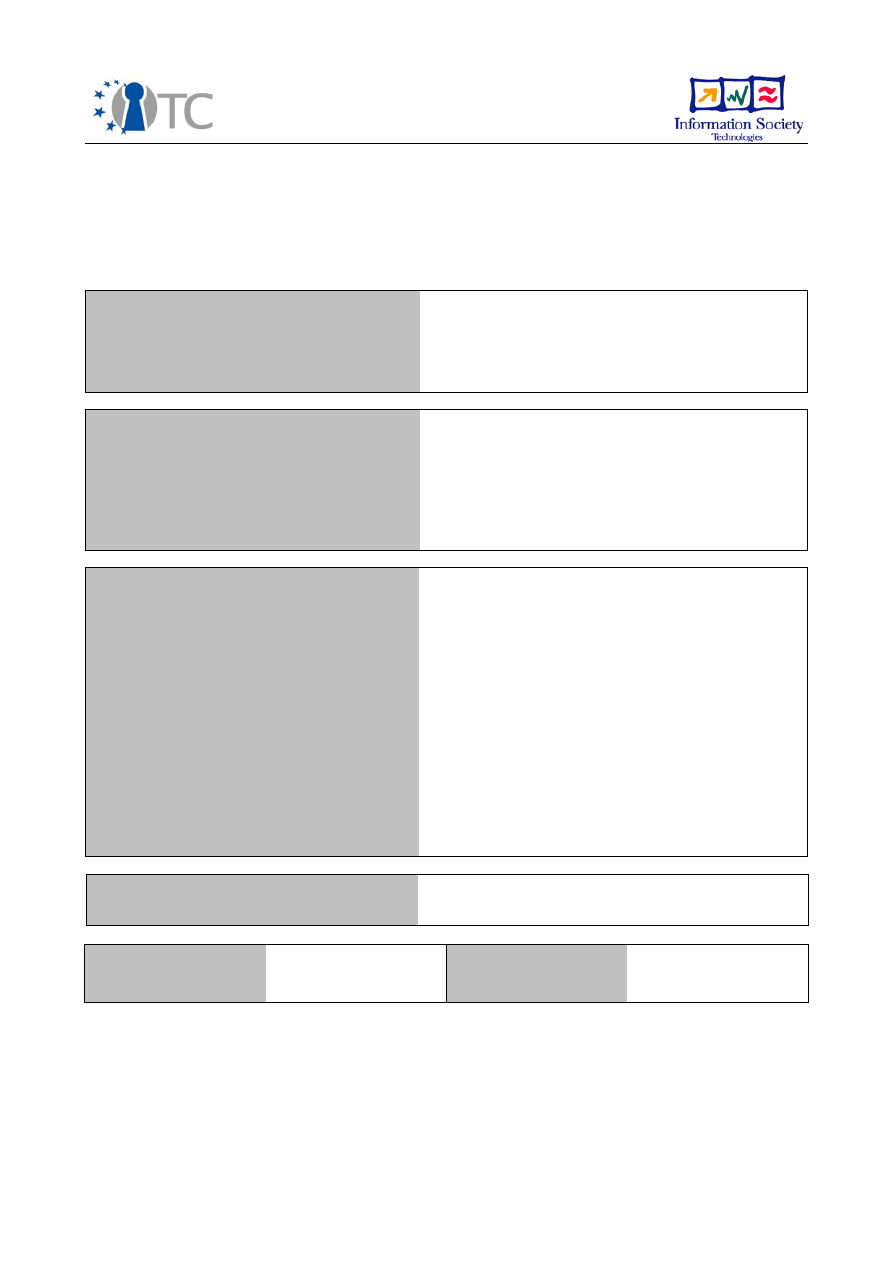
WP06a Final DRM system specification
Companion document: System API Specification
Project number
IST-027635
Project acronym
Open_TC
Project title
Open Trusted Computing
Deliverable type
Internal document
Deliverable reference number
IST-027635/D06a.3/FINAL | 1.00
Deliverable title
D6a.3 Final System Specification:
System API Specification
WP contributing to the deliverable
WP6
Due date
Oct 2007
Actual submission date
Oct 2007
Responsible Organisation
LDV,Lehrstuhl für Datenverarbeitung, TUM
Authors
Chun Hui Suen, Florian Schreiner
Abstract
Keywords
DRM, fair, interoperable, MPEG-21
Dissemination level
Public
Revision
FINAL | 1.00
Instrument
IP
Start date of the
project
1
st
November 2005
Thematic Priority
IST
Duration
42 months

Table Of Content
ManagementInterface
.................................................................................................................... 3
PlayerInterface
.............................................................................................................................. 6
DomainClientInterface
................................................................................................................... 7
DbManager
.................................................................................................................................... 8
LicenseManager
.......................................................................................................................... 10
LicenseManagerImpl
................................................................................................................... 12
InterpreterInterface
...................................................................................................................... 13
MPEG21Interpreter
..................................................................................................................... 14
StateManager
.............................................................................................................................. 15
de.tum.ldv.opentc.manager.core
................................................................................................. 16
CoreManager
.................................................................................................................... 17
de.tum.ldv.opentc.manager.user
................................................................................................. 20
User
.................................................................................................................................. 20
UserManager
.................................................................................................................... 20
de.tum.ldv.opentc.manager.util
................................................................................................... 22
IPMPTool
.......................................................................................................................... 22
Ipmp
.................................................................................................................................. 23
de.tum.ldv.opentc.model
............................................................................................................. 25
CoreAssignedRandomKey
............................................................................................... 25
Int32Identifier
.................................................................................................................... 26
Item
................................................................................................................................... 27
ItemIdentifier
..................................................................................................................... 28
ItemState
.......................................................................................................................... 28
Key
.................................................................................................................................... 30
License
............................................................................................................................. 32
Mpeg21Rel
....................................................................................................................... 33
PeerIdentity
....................................................................................................................... 34
Rel
.................................................................................................................................... 34
RestrictedKey
................................................................................................................... 35
de.tum.ldv.opentc.model.ex
......................................................................................................... 37
KeyNotFound
.................................................................................................................... 37
LicenseAuthorizationFailed
............................................................................................... 38
NoLicenseInCore
.............................................................................................................. 38
OtcException
.................................................................................................................... 39
de.tum.ldv.opentc.model.state
..................................................................................................... 40
ManagerState
................................................................................................................... 40
PlayerState
....................................................................................................................... 40
SystemState
..................................................................................................................... 42

Index
............................................................................................................................................ 44

Interface ManagementInterface
<
Methods
>
public interface ManagementInterface
This class provides a second external interface for administrative functions to the DRM Core, such as
license management and controlling attestation.
Author:
chunhui
Methods
createDomainLicense
public
License
createDomainLicense(
ManagerState
managerState,
PeerIdentity
partner,
Item
item)
Request for a domain license from this core. This is usually requested from a domain member to
the the target DRM core to issue a license for the client.
Parameters:
managerState - state returned during initialization
item - Digital item in question.
partner - target(principal) of new license
Returns:
A transferable license.
createTransferLicense
public
License
createTransferLicense(
ManagerState
managerState,
PeerIdentity
partner,
Item
item,
boolean deleteSource)
Initiate a license transfer to an external peer.
Parameters:
managerState - state returned during initialization
item - Digital item in question.
partner - target(principal) of new license
deleteSource - This simultaneously removes the content key and license from the local
DRM core
Returns:
A transferable license.

deleteLicense
public
License
deleteLicense(
ManagerState
managerState,
License
itemLicense)
Generate a license indicating that the particular license of an item has been removed from the
local DRM core. It returns a deauthorization notice, which is a REL prove signed by the core, that
the license has been removed.
Parameters:
managerState - state returned during initialization
itemLicense - license to deauthorize
Returns:
deauthorization notice license
getAllLicenses
public java.util.List getAllLicenses()
Dump all licenses. (Used as a management feature to view all licenses stored in the DRM Core.
Returns:
All XML licenses in the DRM Core.
getAttestationKey
public
Key
getAttestationKey(
ManagerState
managerState,
Rel
relType,
java.lang.String serverURL)
Obtain an attestation key to be used for downloading content.
Parameters:
managerState - state returned during initialization
playerID - same ID as given by the Core during @method playerInit
relType - REL language used.
serverURL - URL of the server to obtain license.
Returns:
an attestation key to be used for downloading content

getLicense
public java.util.List getLicense(
ManagerState
managerState,
Item
item)
Obtain license for a particular item.
Parameters:
managerState - state returned during initialization
item - Digital item in question.
Returns:
All XML license related to the specified digital item.
getLocalIdentity
public
PeerIdentity
getLocalIdentity(
ManagerState
managerState)
Get identity of local DRM core
Parameters:
managerState - state returned during initialization
Returns:
peer identity
insertLicense
public void insertLicense(
ManagerState
managerState,
License
license,
Item
item)
Insert license into database.
Parameters:
license - license to be inserted.
item - The digital item associated with the license.
managerInit
public
ManagerState
managerInit(java.lang.String userID)
Initialize a connection to the management interface
Returns:
ManagerState object

signGeneratedLicense
public
License
signGeneratedLicense(
ManagerState
managerState,
License
unsignedLicense,
Item
item,
CoreAssignedRandomKey
key)
Request the DRM core to sign an application generated license (in the case of application
generated content).
Parameters:
managerState - state returned during initialization
unsignedLicense - application generated license
item - item reference
key - an empty CoreAssignedRandomKey Object. The actual key will be generated by the
core and stored
Returns:
signature for license
Interface PlayerInterface
<
Methods
>
public interface PlayerInterface
This class provides the main external interface to the OpenTC player.
Methods
getDecryptionKey
public
Key
getDecryptionKey(
PlayerState
playerState,
Item
item,
java.lang.String operation)
Main method to request for a decryption key for media playback.
Parameters:
playerState - same state as given by the Core during @method playerInit
item - Digital item to be played
operation - Operation requested on item
Returns:
Content decryption key if successful

getSupportedREL
public java.util.List getSupportedREL()
Get a list of supported REL languages on this DRM core
Returns:
List of supported REL languages
playerInit
public
PlayerState
playerInit(java.lang.String playerCapabilities,
java.lang.String userID)
Initialization method called by the player
Parameters:
playerCapabilities - XML capabilities description of the player
Returns:
a player state referencing this session with the player
Interface DomainClientInterface
<
Methods
>
public interface DomainClientInterface
Interface for domain clients.
Author:
chunhui
Methods
attachDomainController
public void attachDomainController(java.lang.String url)
Attach a new domain controller
Parameters:
url - URL of the new domain controller

dettachDomainController
public void dettachDomainController(java.lang.String url)
Dettach a new domain controller
Parameters:
url - URL of the new domain controller
getAttachedDomainURLs
public java.util.LinkedList getAttachedDomainURLs()
Get a list of all domains associated with this DRM Core.
Returns:
List of name of all domains.
requestDomainLicense
public java.util.List requestDomainLicense(
Item
item)
request a license from the domain controller.
Parameters:
item - Digital item in question.
Returns:
All XML licenses related to the specified digital item.
returnDomainLicense
public void returnDomainLicense(java.lang.String url,
License
lic)
Send a deauthorization license of a license deleted from the local DRM core, back to the domain
controller. param url Domain controller param lic deauthorization license
Interface DbManager
<
Methods
>
public interface DbManager
Interface to the database engine.

Author:
chunhui
Methods
deleteLicense
public void deleteLicense(
Item
item)
Delete all licenses related to a digital item.
Parameters:
item - Digital item
getDecryptionKey
public
Key
getDecryptionKey(
Item
item)
Get the content decryption key for a digital item.
Parameters:
item - Digital item
Returns:
content decryption key
getItemState
public
ItemState
getItemState(
Item
item)
Get the item state of a digital item.
Parameters:
item - Digital item
Returns:
Item state
getLicense
public java.util.List getLicense(
Item
item)
Get all licenses related to a digital item.
Parameters:
item - Digital item.
Returns:
All related licenses.

setLicense
public void setLicense(
Item
item,
License
license)
Store a license and item state linked to a digital item.
Parameters:
item - Digital item
license - license
state - item state
setState
public void setState(
Item
item,
ItemState
state)
Store the item state linked to a digital item, without changing its license.
Parameters:
item - Digital item
state - item state
Interface LicenseManager
<
Methods
>
public interface LicenseManager
Interface to the license manager. This is the manager which
Author:
chunhui
Methods
getSupportSourceLanguage
public
Rel
getSupportSourceLanguage()
Get supported REL language which can be parsed.
Returns:
REL language

getSupportTargetLanguages
public java.util.List getSupportTargetLanguages()
Get supported REL languages which can be generated during a license translation.
Returns:
List of REL languages
interpretLicense
public java.lang.String interpretLicense(java.util.List licenseGroup,
Item
item,
java.lang.String operation)
throws
OtcException
Authorize an operation performed on a digital item, based on the group of licenses
Parameters:
licenseGroup - List of licenses
item - digital item
operation - operation
Returns:
REL restriction for the operation
Throws:
de.tum.ldv.opentc.model.ex.OtcException -
translateLicense
public
License
translateLicense(
License
sourceLicense,
Rel
targetLicenseLang,
java.lang.String targetRestrictions)
Translates a license from one REL language to another.
Parameters:
sourceLicense - input license
targetLicenseLang - target REL language
targetRestrictions - translation restrictions.
Returns:
translated license

Class LicenseManagerImpl
java.lang.Object
|
+--de.tum.ldv.opentc.manager.license.LicenseManagerImpl
All Implemented Interfaces:
LicenseManager
<
Constructors
> <
Methods
>
public class LicenseManagerImpl
extends java.lang.Object
implements
LicenseManager
Constructors
LicenseManagerImpl
public
LicenseManagerImpl()
Methods
getSupportSourceLanguage
public
Rel
getSupportSourceLanguage()
getSupportTargetLanguages
public java.util.List getSupportTargetLanguages()
interpretLicense
public java.lang.String interpretLicense(java.util.List licenseGroup,
Item
item,
java.lang.String operation)

translateLicense
public
License
translateLicense(
License
sourceLicense,
Rel
targetLicenseLang,
java.lang.String targetRestrictions)
Interface InterpreterInterface
<
Methods
>
public interface InterpreterInterface
Interface to REL interpreter
Author:
chunhui
Methods
getSupportedInterpretedLanguages
public java.util.List getSupportedInterpretedLanguages()
Return the list of supported languages this interpreter can parse.
Returns:
List of REL languages
getSupportedSourceLanguage
public
Rel
getSupportedSourceLanguage()
Return the supported language this interpreter can parse.
Returns:
List of REL languages

interpretLicense
public java.lang.String interpretLicense(java.util.List licenseGroup,
Item
item,
ItemState
state,
SystemState
system,
java.lang.String operation)
Authorize an operation on a digital item, given a group of licenses, iten state and system state.
Parameters:
licenseGroup - List of licsenses
item - Digital item
state - Item state
system - System state
operation - Operation on digital item
Returns:
REL restriction of operation
Class MPEG21Interpreter
java.lang.Object
|
+--de.tum.ldv.opentc.manager.license.interpreter.MPEG21Interpreter
All Implemented Interfaces:
InterpreterInterface
<
Constructors
> <
Methods
>
public class MPEG21Interpreter
extends java.lang.Object
implements
InterpreterInterface
Constructors
MPEG21Interpreter
public
MPEG21Interpreter()
Methods

getSupportedInterpretedLanguages
public java.util.List getSupportedInterpretedLanguages()
getSupportedLanguage
public
Rel
getSupportedLanguage()
getSupportedSourceLanguage
public
Rel
getSupportedSourceLanguage()
interpretLicense
public java.lang.String interpretLicense(java.util.List licenseGroup,
Item
item,
ItemState
state,
SystemState
system,
java.lang.String operation)
Interface StateManager
<
Methods
>
public interface StateManager
State manager
Author:
chunhui
Methods

checkCurrentUse
public int checkCurrentUse(
Item
item,
java.lang.String operation)
Check current operation count
Parameters:
item - digital item
operation - operation on item
Returns:
current count of operation
checkLimit
public int checkLimit(
Item
item,
java.lang.String operation)
Check limits of counter
Parameters:
item - digital item
operation - operation on item
Returns:
maximum count of operation
countUse
public int countUse(
Item
item,
java.lang.String operation)
Increment counter for operation on digital tiem
Parameters:
item - digital item
operation - operation on item
Returns:
current count
Package de.tum.ldv.opentc.manager.core
Class Summary
CoreManager
The CoreManager coordinates the requests from the application layer and forwards them to the
appropriate components.

de.tum.ldv.opentc.manager.core
Class CoreManager
java.lang.Object
|
+--de.tum.ldv.opentc.manager.core.CoreManager
All Implemented Interfaces:
ManagementInterface
,
PlayerInterface
<
Constructors
> <
Methods
>
public class CoreManager
extends java.lang.Object
implements
ManagementInterface
,
PlayerInterface
The CoreManager coordinates the requests from the application layer and forwards them to the
appropriate components. It implements the ManagerInterface and PlayerInterface
Author:
chunhui
Constructors
CoreManager
public
CoreManager(java.lang.String localIdentity)
Methods
addDomainController
public void addDomainController(
ManagerState
managerState,
java.lang.String url)
createDomainLicense
public
License
createDomainLicense(
ManagerState
managerState,
PeerIdentity
partner,
Item
item)

createTransferLicense
public
License
createTransferLicense(
ManagerState
managerState,
PeerIdentity
partner,
Item
item,
boolean deleteSource)
deleteLicense
public
License
deleteLicense(
ManagerState
managerState,
License
itemLicense)
getAllLicenses
public java.util.List getAllLicenses()
getAttestationKey
public
Key
getAttestationKey(
ManagerState
mgrState,
Rel
relType,
java.lang.String serverURL)
getDecryptionKey
public
Key
getDecryptionKey(
PlayerState
playerState,
Item
item,
java.lang.String operation)
getLicense
public java.util.List getLicense(
ManagerState
mgrState,
Item
item)

getLocalIdentity
public
PeerIdentity
getLocalIdentity(
ManagerState
managerState)
getSupportedREL
public java.util.List getSupportedREL()
insertLicense
public void insertLicense(
ManagerState
mgrState,
License
lic,
Item
item)
managerInit
public
ManagerState
managerInit(java.lang.String userID)
playerInit
public
PlayerState
playerInit(java.lang.String playerCapabilities,
java.lang.String userID)
removeDomainController
public void removeDomainController(
ManagerState
managerState,
java.lang.String url)
signGeneratedLicense
public
License
signGeneratedLicense(
ManagerState
managerState,
License
unsignedLicense,
Item
item,
CoreAssignedRandomKey
key)

Package de.tum.ldv.opentc.manager.user
Class Summary
User
UserManager
de.tum.ldv.opentc.manager.user
Class User
java.lang.Object
|
+--de.tum.ldv.opentc.manager.user.User
<
Constructors
> <
Methods
>
public class User
extends java.lang.Object
Constructors
User
public
User(java.lang.String UserID)
Methods
getUserName
public java.lang.String getUserName()
de.tum.ldv.opentc.manager.user
Class UserManager
java.lang.Object
|
+--de.tum.ldv.opentc.manager.user.UserManager

<
Constructors
> <
Methods
>
public class UserManager
extends java.lang.Object
Constructors
UserManager
public
UserManager()
Methods
addUser
public
User
addUser(java.lang.String userID)
listUsers
public java.util.List listUsers()
removeUser
public void removeUser(
User
userObj)

Package de.tum.ldv.opentc.manager.util
Interface Summary
IPMPTool
Interface for IPMP tool
Class Summary
Ipmp
Class to manage all IPMP tools in the system
de.tum.ldv.opentc.manager.util
Interface IPMPTool
<
Methods
>
public interface IPMPTool
Interface for IPMP tool
Author:
chunhui
Methods
getDescription
public java.lang.String getDescription()
Get tool description
Returns:
tool description
getName
public java.lang.String getName()
Get String name of this tool
Returns:
Name of tool

process
public java.lang.Object process(
Item
item,
java.lang.Object obj)
"Action" method of this tool to process a target object
Parameters:
item - Digital item to be processed
obj - processing parameter object
Returns:
result object
de.tum.ldv.opentc.manager.util
Class Ipmp
java.lang.Object
|
+--de.tum.ldv.opentc.manager.util.Ipmp
<
Constructors
> <
Methods
>
public class Ipmp
extends java.lang.Object
Class to manage all IPMP tools in the system
Author:
chunhui
Constructors
Ipmp
public
Ipmp()
Methods

getTools
public static java.util.List getTools()
Get a particular tool based on a string search
Parameters:
toolDescription -
Returns:
list of IPMP objects registered as IPMP tools

Package de.tum.ldv.opentc.model
Interface Summary
ItemIdentifier
Class Summary
CoreAssignedRandomKey
Int32Identifier
Item
Reference to a digital Item.
ItemState
Item state object
Key
Generic Key object
License
License object
Mpeg21Rel
PeerIdentity
Rel
REL language type
RestrictedKey
Content key with an associated usage restriction
de.tum.ldv.opentc.model
Class CoreAssignedRandomKey
java.lang.Object
|
+--
Key
|
+--de.tum.ldv.opentc.model.CoreAssignedRandomKey
<
Constructors
>
public class CoreAssignedRandomKey
extends
Key

Constructors
CoreAssignedRandomKey
public
CoreAssignedRandomKey(int length,
int kType)
de.tum.ldv.opentc.model
Class Int32Identifier
java.lang.Object
|
+--de.tum.ldv.opentc.model.Int32Identifier
All Implemented Interfaces:
ItemIdentifier
<
Constructors
> <
Methods
>
public class Int32Identifier
extends java.lang.Object
implements
ItemIdentifier
Constructors
Int32Identifier
public
Int32Identifier(int id)
Methods
equal
public boolean equal(
ItemIdentifier
item)

getInt32ID
public int getInt32ID()
toString
public java.lang.String toString()
Overrides:
toString in class java.lang.Object
de.tum.ldv.opentc.model
Class Item
java.lang.Object
|
+--de.tum.ldv.opentc.model.Item
<
Constructors
> <
Methods
>
public class Item
extends java.lang.Object
Reference to a digital Item.
Author:
chunhui
Constructors
Item
public
Item(
ItemIdentifier
id)
Constructor
Parameters:
id - ID of this item.
Methods

getID
public
ItemIdentifier
getID()
Read the ID of this item.
Returns:
ID of item
de.tum.ldv.opentc.model
Interface ItemIdentifier
<
Methods
>
public interface ItemIdentifier
Methods
equal
public boolean equal(
ItemIdentifier
item)
toString
public java.lang.String toString()
Overrides:
toString in class java.lang.Object
de.tum.ldv.opentc.model
Class ItemState
java.lang.Object
|
+--de.tum.ldv.opentc.model.ItemState
<
Constructors
> <
Methods
>
public class ItemState
extends java.lang.Object

Item state object
Author:
chunhui
Constructors
ItemState
public
ItemState(
ItemIdentifier
item_ID)
Constructor
Parameters:
item_ID -
Methods
getItemID
public
ItemIdentifier
getItemID()
Get digital item ID
Returns:
Item ID
getStateProperty
public java.lang.Object getStateProperty(java.lang.String key)
Get Item state property
Parameters:
key -
Returns:
stored value

setStateProperty
public void setStateProperty(java.lang.String key,
java.lang.Object data)
Set Item state property
Parameters:
key -
data -
de.tum.ldv.opentc.model
Class Key
java.lang.Object
|
+--de.tum.ldv.opentc.model.Key
Direct Known Subclasses:
CoreAssignedRandomKey
,
RestrictedKey
<
Fields
> <
Constructors
> <
Methods
>
public class Key
extends java.lang.Object
Generic Key object
Author:
chunhui
Fields
AES_TYPE
public static final int AES_TYPE
Constructors

Key
public
Key(int length,
int kType,
byte[] key)
Constructor
Parameters:
length - number of bytes
kType - key type
key - byte array of key data
Key
public
Key(int length,
int kType,
java.lang.String keyInHex)
Constructor
Parameters:
length - number of bytes
kType - key type
key - String of key data in hexadecimal string notation
Methods
getKType
public int getKType()
Get key type
Returns:
key type
getKey
public byte[] getKey()
Get key data
Returns:
byte array of key

getLength
public int getLength()
get length of key
Returns:
length of key
de.tum.ldv.opentc.model
Class License
java.lang.Object
|
+--de.tum.ldv.opentc.model.License
<
Constructors
> <
Methods
>
public class License
extends java.lang.Object
License object
Author:
chunhui
Constructors
License
public
License(
Rel
rel,
java.lang.String text)
Constructor
Parameters:
rel - REL language type
text - String of license
Methods

getRel
public
Rel
getRel()
Get REL language type
Returns:
REL language type
getText
public java.lang.String getText()
Get string text of license
Returns:
license string
de.tum.ldv.opentc.model
Class Mpeg21Rel
java.lang.Object
|
+--
Rel
|
+--de.tum.ldv.opentc.model.Mpeg21Rel
<
Constructors
> <
Methods
>
public class Mpeg21Rel
extends
Rel
Constructors
Mpeg21Rel
public
Mpeg21Rel()
Methods

getMpeg21Rel
public static
Rel
getMpeg21Rel()
de.tum.ldv.opentc.model
Class PeerIdentity
java.lang.Object
|
+--de.tum.ldv.opentc.model.PeerIdentity
<
Constructors
>
public class PeerIdentity
extends java.lang.Object
Constructors
PeerIdentity
public
PeerIdentity()
de.tum.ldv.opentc.model
Class Rel
java.lang.Object
|
+--de.tum.ldv.opentc.model.Rel
Direct Known Subclasses:
Mpeg21Rel
<
Constructors
> <
Methods
>
public abstract class Rel
extends java.lang.Object
REL language type
Author:
chunhui

Constructors
Rel
public
Rel()
Methods
getName
public java.lang.String getName()
Get name of this REL type
Returns:
REL name
de.tum.ldv.opentc.model
Class RestrictedKey
java.lang.Object
|
+--
Key
|
+--de.tum.ldv.opentc.model.RestrictedKey
<
Constructors
> <
Methods
>
public class RestrictedKey
extends
Key
Content key with an associated usage restriction
Author:
chunhui
Constructors

RestrictedKey
public
RestrictedKey(
Key
k,
java.lang.String usageRestriction)
Construction
Parameters:
k - normal key object
usageRestriction - Usage restriction in REL description
Methods
getUsageRestriction
public java.lang.String getUsageRestriction()
get usage restriction
Returns:
Usage restriction String

Package de.tum.ldv.opentc.model.ex
Class Summary
KeyNotFound
LicenseAuthorizationFailed
NoLicenseInCore
OtcException
de.tum.ldv.opentc.model.ex
Class KeyNotFound
java.lang.Object
|
+--java.lang.Throwable
|
+--java.lang.Exception
|
+--
OtcException
|
+--de.tum.ldv.opentc.model.ex.KeyNotFound
All Implemented Interfaces:
java.io.Serializable
<
Constructors
>
public class KeyNotFound
extends
OtcException
Constructors
KeyNotFound
public
KeyNotFound()

de.tum.ldv.opentc.model.ex
Class LicenseAuthorizationFailed
java.lang.Object
|
+--java.lang.Throwable
|
+--java.lang.Exception
|
+--
OtcException
|
+--de.tum.ldv.opentc.model.ex.LicenseAuthorizationFailed
All Implemented Interfaces:
java.io.Serializable
<
Constructors
>
public class LicenseAuthorizationFailed
extends
OtcException
Constructors
LicenseAuthorizationFailed
public
LicenseAuthorizationFailed(java.lang.String reason)
de.tum.ldv.opentc.model.ex
Class NoLicenseInCore
java.lang.Object
|
+--java.lang.Throwable
|
+--java.lang.Exception
|
+--
OtcException
|
+--de.tum.ldv.opentc.model.ex.NoLicenseInCore
All Implemented Interfaces:
java.io.Serializable
<
Constructors
>
public class NoLicenseInCore
extends
OtcException

Constructors
NoLicenseInCore
public
NoLicenseInCore()
de.tum.ldv.opentc.model.ex
Class OtcException
java.lang.Object
|
+--java.lang.Throwable
|
+--java.lang.Exception
|
+--de.tum.ldv.opentc.model.ex.OtcException
All Implemented Interfaces:
java.io.Serializable
Direct Known Subclasses:
KeyNotFound
,
LicenseAuthorizationFailed
,
NoLicenseInCore
<
Constructors
>
public class OtcException
extends java.lang.Exception
Constructors
OtcException
public
OtcException()

Package de.tum.ldv.opentc.model.state
Class Summary
ManagerState
PlayerState
State associated with a connected media player
SystemState
Sytem states in DRM core.
de.tum.ldv.opentc.model.state
Class ManagerState
java.lang.Object
|
+--de.tum.ldv.opentc.model.state.ManagerState
<
Constructors
>
public class ManagerState
extends java.lang.Object
Constructors
ManagerState
public
ManagerState()
de.tum.ldv.opentc.model.state
Class PlayerState
java.lang.Object
|
+--de.tum.ldv.opentc.model.state.PlayerState
<
Constructors
> <
Methods
>
public class PlayerState
extends java.lang.Object

State associated with a connected media player
Author:
chunhui
Constructors
PlayerState
public
PlayerState(int playerId,
java.lang.String playerCapabilities)
Constructor
Parameters:
playerId - ID given by initialization.
playerCapabilities - player capabilities
PlayerState
public
PlayerState(java.lang.String playerCapabilities)
Constructor. playerID is automatically assigned in increasing sequence.
Parameters:
playerCapabilities - player capabilities
Methods
getPlayerCapabilities
public java.lang.String getPlayerCapabilities()
Get player capabilities.
Returns:
player capabilities
getPlayerId
public int getPlayerId()
get player ID.
Returns:
player ID

getProperty
public java.lang.String getProperty(java.lang.String key)
Get property of player state
Parameters:
key - key of property
Returns:
data of stored property
setProperty
public void setProperty(java.lang.String key,
java.lang.String data)
Set property into player state.
Parameters:
key - key of property
data - data of property
de.tum.ldv.opentc.model.state
Class SystemState
java.lang.Object
|
+--de.tum.ldv.opentc.model.state.SystemState
<
Constructors
> <
Methods
>
public class SystemState
extends java.lang.Object
Sytem states in DRM core.
Author:
chunhui
Constructors
SystemState
public
SystemState()

Methods
getState
public static
SystemState
getState()
get system state.
Returns:
system state
getSystemDate
public java.util.Date getSystemDate()
Get system date.
Returns:
system date

INDEX
A
addDomainController
... 17
addUser
... 21
attachDomainController
... 7
AES_TYPE
... 30
C
checkCurrentUse
... 16
checkLimit
... 16
countUse
... 16
createDomainLicense
... 3
createDomainLicense
... 17
createTransferLicense
... 3
createTransferLicense
... 18
CoreAssignedRandomKey
... 25
CoreAssignedRandomKey
... 26
CoreManager
... 17
CoreManager
... 17
D
deleteLicense
... 4
deleteLicense
... 9
deleteLicense
... 18
dettachDomainController
... 8
DbManager
... 8
DomainClientInterface
... 7
E
equal
... 26
equal
... 28
G
getAllLicenses
... 4
getAllLicenses
... 18
getAttachedDomainURLs
... 8
getAttestationKey
... 4
getAttestationKey
... 18
getDecryptionKey
... 6
getDecryptionKey
... 9
getDecryptionKey
... 18
getDescription
... 22
getID
... 28
getInt32ID
... 27
getItemID
... 29
getItemState
... 9
getKey
... 31
getKType
... 31
getLength
... 32
getLicense
... 5
getLicense
... 9
getLicense
... 18
getLocalIdentity
... 5
getLocalIdentity
... 19
getMpeg21Rel
... 34
getName
... 22
getName
... 35
getPlayerCapabilities
... 41
getPlayerId
... 41
getProperty
... 42
getRel
... 33
getState
... 43
getStateProperty
... 29
getSupportedInterpretedLanguages
... 13
getSupportedInterpretedLanguages
... 15
getSupportedLanguage
... 15
getSupportedREL
... 7
getSupportedREL
... 19
getSupportedSourceLanguage
... 13
getSupportedSourceLanguage
... 15
getSupportSourceLanguage
... 10
getSupportSourceLanguage
... 12
getSupportTargetLanguages
... 11
getSupportTargetLanguages
... 12
getSystemDate
... 43
getText
... 33
getTools
... 24
getUsageRestriction
... 36
getUserName
... 20

I
insertLicense
... 5
insertLicense
... 19
interpretLicense
... 11
interpretLicense
... 12
interpretLicense
... 14
interpretLicense
... 15
Int32Identifier
... 26
Int32Identifier
... 26
InterpreterInterface
... 13
Ipmp
... 23
Ipmp
... 23
IPMPTool
... 22
Item
... 27
Item
... 27
ItemIdentifier
... 28
ItemState
... 28
ItemState
... 29
K
Key
... 30
Key
... 31
Key
... 31
KeyNotFound
... 37
KeyNotFound
... 37
L
listUsers
... 21
License
... 32
License
... 32
LicenseAuthorizationFailed
... 38
LicenseAuthorizationFailed
... 38
LicenseManager
... 10
LicenseManagerImpl
... 12
LicenseManagerImpl
... 12
M
managerInit
... 5
managerInit
... 19
ManagementInterface
... 3
ManagerState
... 40
ManagerState
... 40
MPEG21Interpreter
... 14
MPEG21Interpreter
... 14
Mpeg21Rel
... 33
Mpeg21Rel
... 33
N
NoLicenseInCore
... 38
NoLicenseInCore
... 39
O
OtcException
... 39
OtcException
... 39
P
playerInit
... 7
playerInit
... 19
process
... 23
PeerIdentity
... 34
PeerIdentity
... 34
PlayerInterface
... 6
PlayerState
... 40
PlayerState
... 41
PlayerState
... 41
R
removeDomainController
... 19
removeUser
... 21
requestDomainLicense
... 8
returnDomainLicense
... 8
Rel
... 34
Rel
... 35
RestrictedKey
... 35
RestrictedKey
... 36
S
setLicense
... 10
setProperty
... 42
setState
... 10
setStateProperty
... 30
signGeneratedLicense
... 6
signGeneratedLicense
... 19
StateManager
... 15
SystemState
... 42
SystemState
... 42
T
toString
... 27
toString
... 28
translateLicense
... 11
translateLicense
... 13
U
User
... 20
User
... 20
UserManager
... 20
UserManager
... 21
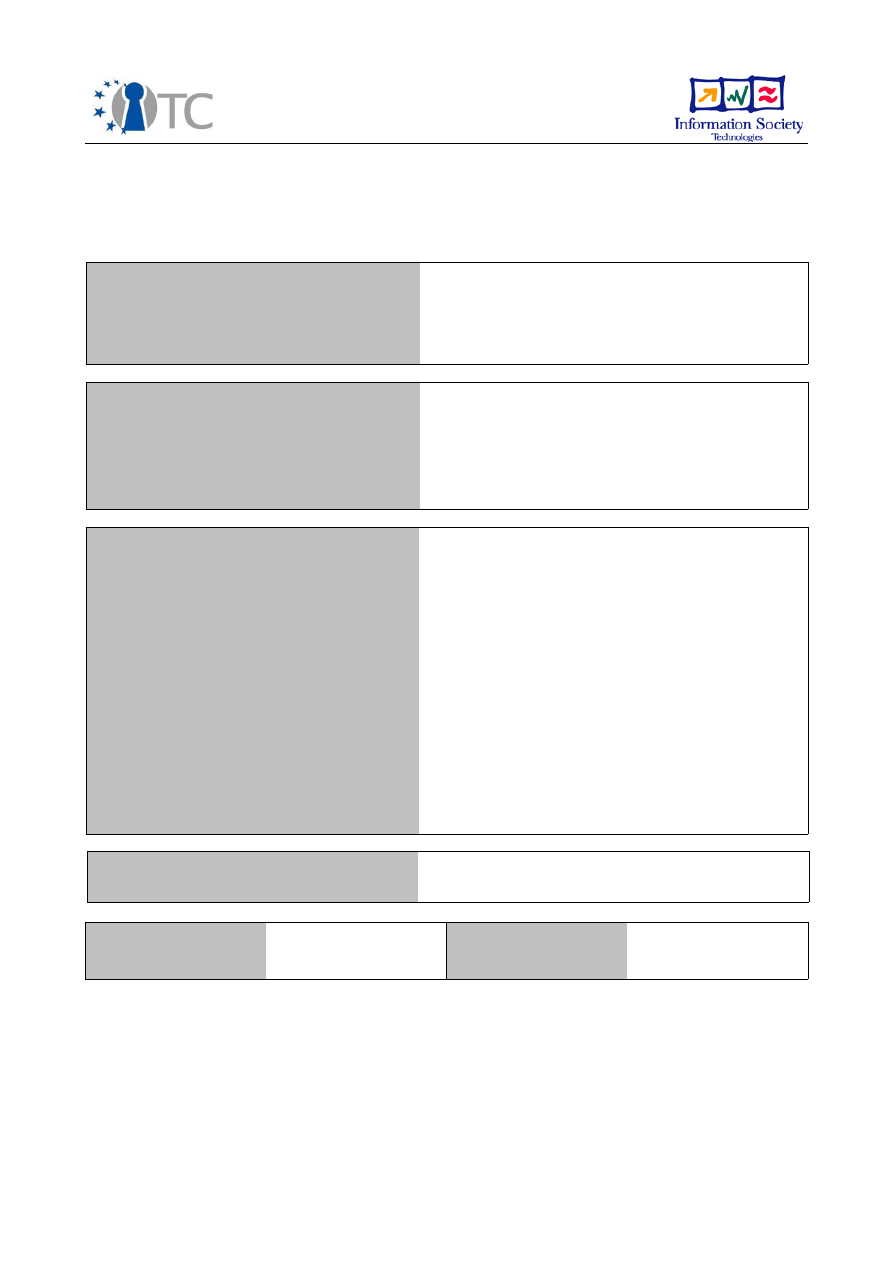
WP06b.2 MEITC Specification and Test Plan
Project number
IST-027635
Project acronym
Open_TC
Project title
Open Trusted Computing
Deliverable type
Deliverable
Deliverable reference number
IST-027635/D6b.2/ Final / 1.00
Deliverable title
WP06b.2 MEITC Specification and Test Plan
WP contributing to the deliverable
WP 6
Due date
Oct 07
Actual submission date
28 Oct 07
Responsible Organisation
TUBITAK
Authors
Görkem Çetin, Kadir İmamoğlu, Volkan Erol
Abstract
This internal deliverable is the specification
and test plan for MEITC system
Keywords
Dissemination level
Public
Revision
Instrument
IP
Start date of the
project
1
st
November 2005
Thematic Priority
IST
Duration
42 months

D6b.2 MEITC Specification and Test Plan
Table of Contents
1 Introduction...............................................................................................................3
1.1 Purpose..................................................................................................................3
1.2 Scope.....................................................................................................................3
1.3 Definitions, acronyms, and abbreviations..............................................................4
1.3.1 Definitions........................................................................................................4
1.3.2 Acronyms..........................................................................................................4
1.4 References.............................................................................................................4
1.5 Overview................................................................................................................4
2 Overall Description....................................................................................................4
2.1 Product perspective...............................................................................................4
2.1.1 System interfaces.............................................................................................5
2.1.2 User Interfaces.................................................................................................5
2.1.3 Hardware interfaces.........................................................................................5
2.1.4 Software interfaces...........................................................................................6
2.1.5 Communications interfaces..............................................................................6
2.1.6 Memory constraints..........................................................................................7
2.1.7 Operations........................................................................................................7
2.2 Product functions...................................................................................................8
2.3 User characteristics................................................................................................8
2.4 Assumptions and dependencies.............................................................................9
3 Use Cases and Specific requirements........................................................................9
3.1 External interfaces.................................................................................................9
3.2 Use Cases.............................................................................................................10
3.3 Performance requirements...................................................................................27
3.4 Design constraints................................................................................................27
3.4.1 Standards compliance....................................................................................27
3.5 Software System Attributes..................................................................................28
3.5.1 Reliability........................................................................................................28
3.5.2 Availability......................................................................................................28
3.5.3 Security..........................................................................................................28
3.5.4 Maintainability................................................................................................28
3.5.5 Portability.......................................................................................................28
4 Test plan..................................................................................................................28
5 Appendix - 1 : Definitions.........................................................................................29
6 Appendix - 2 : Acronyms..........................................................................................29
List of figures
Figure 1:The general structure of the MEITC and communications among MEITC
components....................................................................................................................8
Figure 2:Architecture of the MEITC system...................................................................10
Internal document
2/31

D6b.2 MEITC Specification and Test Plan
1
Introduction
1.1 Purpose
The purpose of this document is to describe the Software Requirement Specifications
(SRS), the use cases and test plan of the Message Exchange Infrastructure for Trusted
Computing (MEITC) system which is a sub-workpackage of the Open Trusted
Computing (Open TC) project to be developed by TUBITAK-UEKAE. Open TC is a
European Union Sixth Framework Programme Project which was started after the FP6
IST4 call.
1.2 Scope
The system developed will be a fully secure message exchange infrastructure for
Linux Operating System by using the Trusted Platform Module (TPM) and the Trusted
Software Stack (TSS), built over a virtualization layer. This infrastructure will ensure
confidentiality, authentication, non-repudiation and data integrity on the installed
base. In this document, the functionality and system requirements specifications of
the MEITC's five base components also will be defined. These five base components
are the following.
●
MEITC Database Server
●
MEITC Mail Server
●
MEITC Web Server
●
MEITC Trusted Log Server
●
MEITC Certificate Service Provider
MEITC Database Server:
A database server will host users' mailboxes. All e-mail
headers, user information and quota information will be kept in this database.
MEITC Mail Server:
This component will handle all the e-mail traffic and it will use
the Trusted Log and the Certificate Service Provider (CSP) to implement the security
services for the messages, namely, integrity checking and non-repudiation.
MEITC Web Server:
This component will be the front-end for users and the system
administrators. Users and system administrators of MEITC will connect to this web
server via their web based browsers to compose or read e-mail messages.
MEITC Trusted Log Server:
This component guarantees the integrity checking of e-
mails and also the non-repudiation: it holds a record for each e-mail that includes data
about the message (i.e. the sender and the recipient addresses, etc.), the digest
calculated over the message and optionally the details of the remote attestation of the
various components.
MEITC Certificate Service Provider:
This component will hold users' digital
certificates and keys for signing and encrypting e-mails. It can use the TPM as crypto
device for asymmetric operations and also other hardware signing devices. Symmetric
encryption will be done by using the cryptographic trusted services developed within
OPEN TC Work package 5. The user and the CSP keys will be sealed to the state of the
CSP in order to be released only if the system integrity is provided.
Internal document
3/31

D6b.2 MEITC Specification and Test Plan
The server running the Trusted Log Server (LS) and Certificate Service Provider (CSP)
is also responsible to provide measurement values of the compartments, and check
this value before other servers are up and running. See Figure 1 for more information
on the MEITC system implementation.
1.3 Definitions, acronyms, and abbreviations
1.3.1 Definitions
Appendix 1 in the section 5 (Annex 1) contains definitions for words used within this
document.
1.3.2 Acronyms
Appendix 2 in the section 6 (Annex 2) contains commonly used acronyms used in this
report.
1.4 References
●
IEEE Recommended Practice for Software Requirements Specifications IEEE Std
830-1998
●
PET (Private Electronic Transaction) Use Case Document
●
OPEN TC D02.1 Requirements Definition and Specification
IST-027635 / D02.1 / Final | 1.00
●
OPEN TC Annex I - “Description of Work”
●
Siani Pearson (ed.): Trusted Computing Platforms: TCPA Technology in Context,
Prentice Hall PTR2003
●
TCG Specification Architecture Overview
1.5 Overview
This document is prepared in accordance with the IEEE Std 830-1998, IEEE
Recommended Practice for Software Requirements Specifications, and extended by
including use cases.
In the following sections of this documentation the software requirement specifications
of the MEITC system will be explained in a more detailed manner. Second section
(Overall Description) of this document gives a general description of the MEITC. In this
section, we will explain, respectively, product perspective, product functions, user
characteristics, constraints, assumptions and dependencies. In the third section we
will define the specific requirements in order to facilitate our work in the design step.
The specific requirements that we will talk about are respectively, external interfaces,
functions, performance requirements, logical database requirements, design
constraints and software system attributes.
2
Overall Description
2.1 Product perspective
In this part, the software specification requirements defined for the MEITC system will
be explained in a more detailed manner. We will define also under which constraints
the MEITC system will be developed. The interfaces, which will connect the internal
and external components with the MEITC, will be explained. Additional requirements
Internal document
4/31

D6b.2 MEITC Specification and Test Plan
such as memory constraints, additional operations and site adaptation requirements
will also be defined here.
This project is not self-contained system. It depends to a larger system which will be
developed in OPEN TC. This larger system which is a trusted environment must be
ready to support the MEITC system.
The users of the MEITC system will use an unmodified web based browser (Mozilla
Firefox, Konqueror, Internet Explorer etc.) to access their accounts. In the client side of
the MEITC system users need to have a Trusted Platform Module (TPM) enabled
computer for remote attestation purposes. In a MEITC environment, users will be able
to read, send and delete e-mail messages securely.
2.1.1 System interfaces
All of the machines in the system will work with TPM support. Access to the web server
will be done through a web based browser. In order to guarantee the trustworthiness
of the whole system, web browser and web server will communicate on a trusted
channel by using HTTP on top of the conventional TLS/SSL protocols.
2.1.2 User Interfaces
Users will connect to MEITC system via their web based browsers. Each page of the
messaging system will be prepared using JSP and HTML. There will be two types of
users: system administrators and unprivileged user. System administrators will have
administrative privileges to arrange users accounts. The other user type will not have
administrative privileges, and instead they only have access to their messages in their
own message boxes.
User interface of MEITC should have user-centered design, in which tasks are easily
followed and executed by the end-user. User interface should also satisfy the general
requirements of customer as the software evolves. End-users of MEITC will see a
simple webmail that will give them the ability to read, send and delete e-mails (or
other actions) they would like to take.
2.1.3 Hardware interfaces
Minimum recommended hardware for MEITC system in server side is as follows:
●
At least 2 Ghz Intel or AMD processor
●
Infineon
TPM 1.2 enabled mainboard
●
At least 2 GB of RAM
●
100 GB hard disk. More disk space is needed to handle more inboxes.
●
Ethernet card with a bandwidth of at least 100 Mbps
●
SVGA colour monitor; minimum 800x600 screen resolution, 1024x768
recommended; minimum of 16 bit colours
On the client side, web based browser requires the following hardware specifications.
●
Infineon
TPM 1.2 enabled mainboard
●
Enough free disk space in hard disk
●
128 MB or more RAM
Internal document
5/31

D6b.2 MEITC Specification and Test Plan
●
SVGA colour monitor; minimum 800x600 screen resolution, 1024x768
recommended; minimum of 16 bit colours
2.1.4 Software interfaces
The following software products will be installed on the main MEITC server
components.
MEITC Web Server
●
Any Linux distribution with kernel 2.6
●
TSS Version: 1.2
●
PKI
●
Tomcat version >= 5.0
●
Apache Web Server version >= 2.0
●
Open SSL
●
OPEN TC Crypto Utilities
●
OPEN TC Measurement Service
●
OPEN TC Attestation Service
MEITC Database and Mail Server (also includes CSP and Trusted Log Server
for the first prototype)
●
Any Linux distribution with kernel 2.6
●
MySQL Version >= 5.0
●
Postfix Version >= 2.3
●
OPEN TC Measurement Service
●
OPEN TC Sealing Service
On the client side the main required software product is a web based browser with
Hyper Text Markup Language (HTML) version 4.0, Java and Javascript enabled. The
following web based browsers are recommended.
●
Mozilla Firefox, version 1.0 or higher
●
Microsoft Internet Explorer (MSIE), version 5.0 or higher
2.1.5 Communications interfaces
Default communication protocol for data transmission between servers and the client
is Transmission Control Protocol / Internet Protocol (TCP/IP). At the upper level Hyper
Text Transfer Protocol (HTTP, default port=80) and Secure Socket Layer (SSL, default
port = 443) will be used for communication between the web server and client.
Current implementation will depend on the output of WP5 remote attestation
deliverables.
Access to the web server will be done through a web based browser: in order to
guarantee the trustworthiness of the whole system, the browser and the web server
will communicate on a trusted channel by using HTTP on top of the conventional
TLS/SSL protocols enabled for the mutual platform authentication. General structure of
the MEITC system and communication among MEITC components can be visualized in
the figure below:
Internal document
6/31
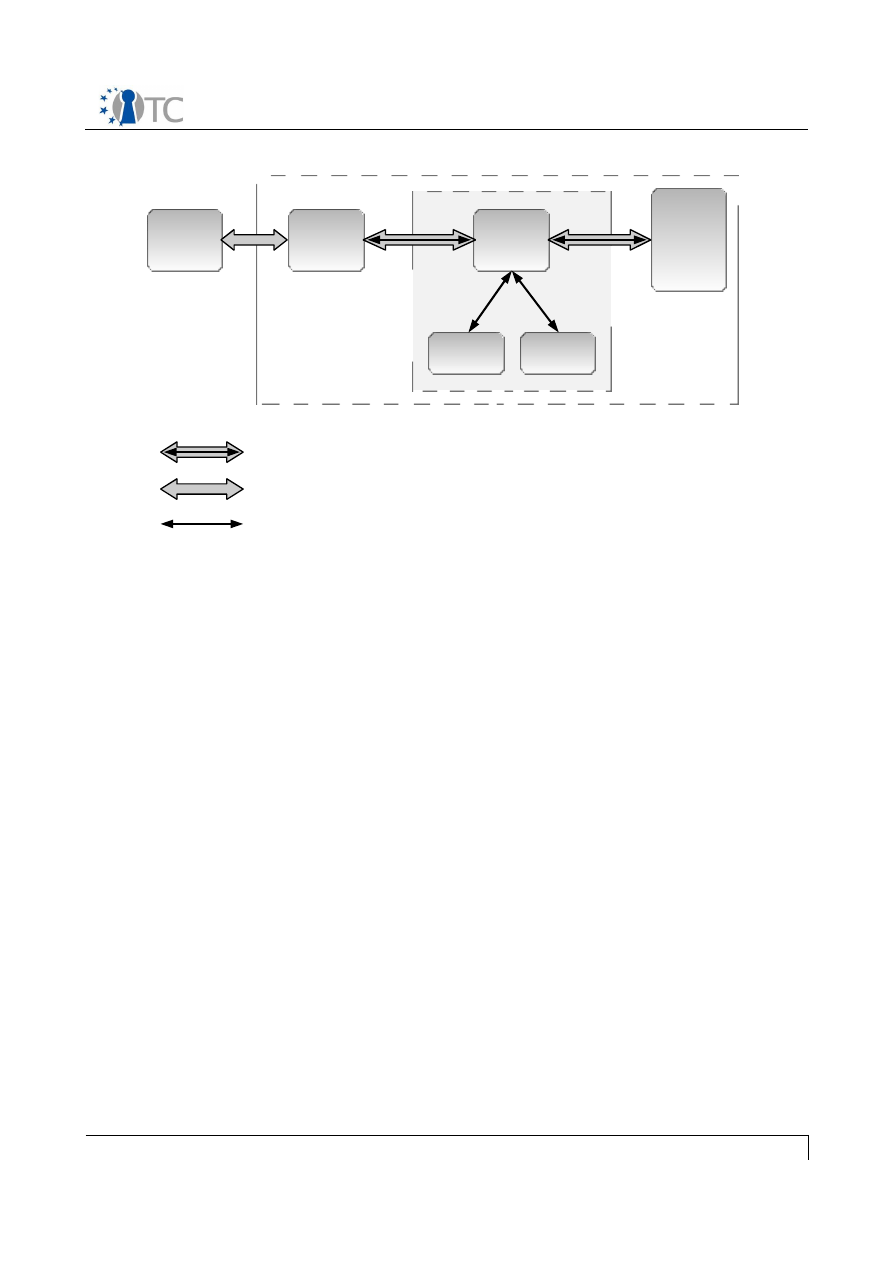
D6b.2 MEITC Specification and Test Plan
In this model, the CSP and TL will be run on the dom0, and all other servers (DB, MS,
WS) will be run on domU, where it's assumed that they are isolated from each other
using Xen virtualization layer technology. MEITC prototype will be based on Xen.
2.1.6 Memory constraints
The server system will be able to run 4 operating systems (instances or
compartments) as once, so the memory would be sufficient for memory-intensive
applications. If the system requires more memory, necessary memory must be added
to the system. On the other hand, depending on the configuration, the number of
compartments can easily be reduced in order to benefit from low memory and CPU
power.
The client computer, which runs the web browser, should have enough physical
memory to run this program.
2.1.7 Operations
Following items are a list of operations end users and administrators can do.
●
User can login to the message exchange system
●
User can read a message
●
User can delete a message
●
User can send a message
●
User can ask for a certificate
●
Administrator can define a user account
Internal document
7/31
Figure 1:The general structure of the MEITC and communications among
MEITC components.
Web
browser
MEITC
web
server
MEITC
mail
server
MEITC
DB
server
MEITC
Trusted Log
MEITC
CSP
SSL/TLS with remote attestation or via OTC TCB
Trusted channels
SSL/TLS with remote attestation
via OTC TCB

D6b.2 MEITC Specification and Test Plan
●
Administrator can remove a user account
●
Administrator can change / reset a user password
●
Administrator can manage CA (i.e generate, revoke or accept certificates and
certificate requests)
2.2 Product functions
MEITC message exchange system is an application, which will ensure the “trusted”
message exchange between the predefined users in the system by using the trusted
computing modules. There are five base components in the system. These
components are respectively, MEITC Database Server (DB), MEITC Mail Server (MS),
MEITC Web Server (WS), MEITC Trusted Log Server (LS) and MEITC Certificate Service
Provider (CSP). These components' functionalities are explained in the section 1.2
(Scope) of this document.
The user names should be generated in CSP and in database, to be authenticated by
the system. Communication between client system and web server will be ensured in
a “trusted” manner by using attestation services and encryption.
Following operations can be made by end users:
●
Read an email
●
Send an e-mail
●
Delete existing e-mails
●
Request a certificate
●
View a certificate
A user friendly and interactive interface with a help system will be designed for users
in order to do these operations easily.
The operations, that the system administrator can do, are defined respectively as:
●
Define a new user account
●
Delete an existing user account
●
Reset / change users' passwords
●
Accept a certificate
●
Revoke a certificate
A system administrator interface will also be defined to realize the defined actions.
If necessary, additional roles can be defined in the following parts of the project life
cycle.
2.3 User characteristics
We have foreseen that the users, who will use the MEITC system, should have an
existing knowledge about how to use Internet or an e-mail client software like
Thunderbird, Outlook etc. The potential users of the MEITC system will be
organisational users. In many organisations, the computer user profile is more that the
expected ones for our application. When designing the system, necessary precautions
will be applied to realize a usable and intuitive user interface, which can be utilized by
users who don't have specific computer knowledge.
Internal document
8/31
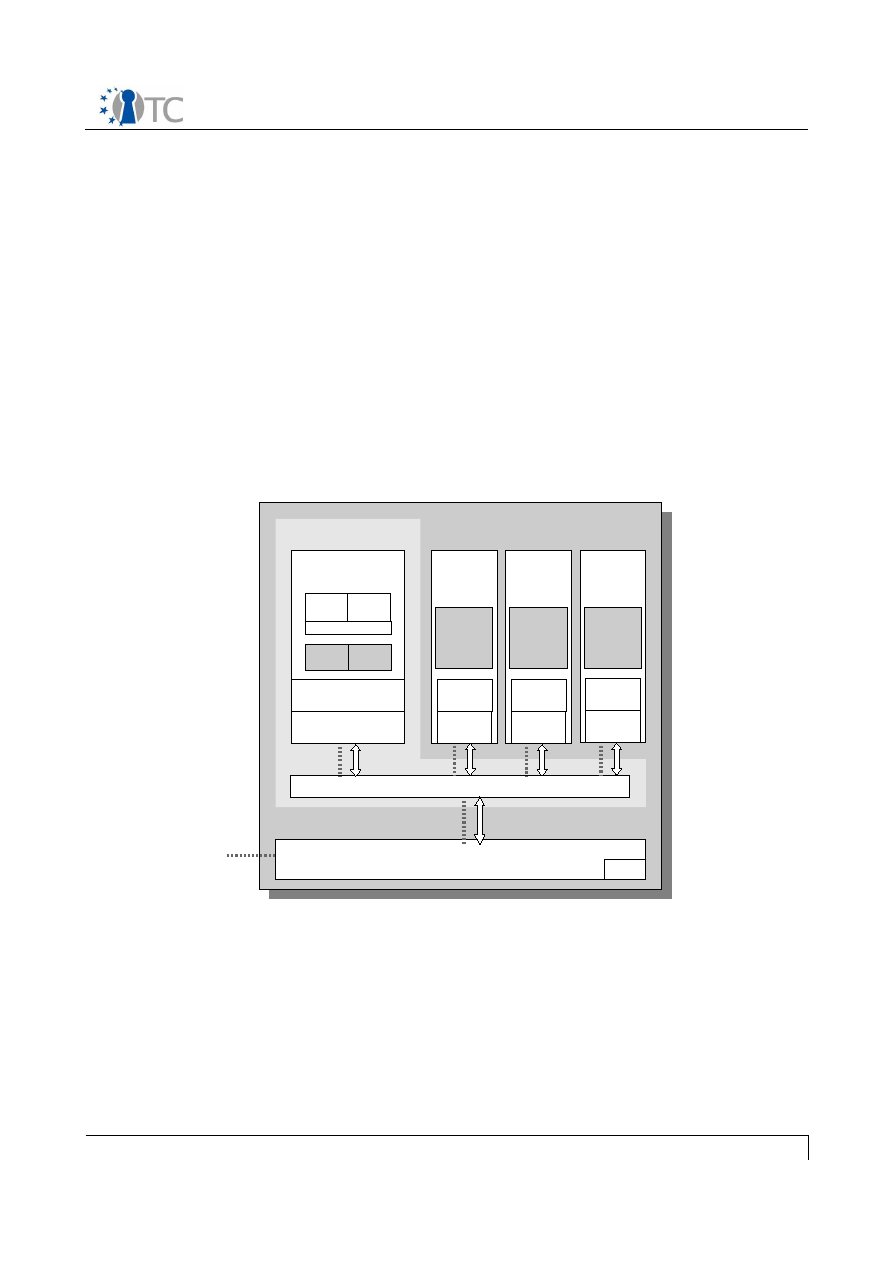
D6b.2 MEITC Specification and Test Plan
For the system administrator we have foreseen that, they know at least what trusted
computing is. Similarly, we have considered that the administrator knows how to
define user accounts or change the existing users' definitions.
For these two user profiles (i.e users and administrators), intuitive help menus will be
created in order to facilitate the work of the users.
2.4 Assumptions and dependencies
We assume that all the software modules which will be developed in WP5 will be ready
during the development phase. This will ensure that MEITC implementation will work in
the desired manner. The delay of these modules' implementation can affect the MEITC
implementation process.
The following figure shows the architecture of the MEITC system and the relationship
between the main components of the MEITC. In the first phase of the project, two
components holding CSP, web server, DB server and mail server will be provided.
3
Use Cases and Specific requirements
In this part of the SRS document, we will explain the MEITC application use cases
specific requirements in a manner that can help the design phase of the project. We
will consider the relations of MEITC with other modules developed in the Open TC
project. In this part, the inputs and the outputs of the system will also be examined.
3.1 External interfaces
Internal document
9/31
Figure 2:Architecture of the MEITC system
Physical Hardware
(CPU, e.g. AMD Pacifica)
Virtualization Layer
S e c u r i t y K e r n e l
Trusted
Management
VM(s)
Linux OS
HW Drivers
Trust
Mgr
TPM
Server
TPM
CSP
MEITC Mail
server VM
MEITC
Mail server
Linux OS
minimal
vDrivers
MEITC Web
server VM
MEITC
Web server
Linux OS
minimal
vDrivers
MEITC DB
server VM
MEITC
DB server
Linux OS
minimal
vDrivers
Trusted
log
Encr Services

D6b.2 MEITC Specification and Test Plan
MEITC will work over stacks mentioned in the previous paragraph and will
communicate with other components via trusted channels. For the MEITC CSP, openssl
crypto service will be used. This CSP will in turn evolve into a certificate authority (CA)
which will manage user keys together with certificates. Private keys will be used for
signing the e-mails and public keys will be used for encrypting. End users will be able
to validate signed e-mails.
3.2 Use Cases
In this section, we will see what the users and the system administrators can do when
using the MEITC system.
General assumptions and requirements
The assumptions below describe the security aspects of the environment in which the
result will be used or is extended to be used. These assumptions are heavily based on
PET Banking Demonstrator Use Cases document.
AR 10: Correct hardware
The underlying hardware is non-malicious and behaves as expected. Optionally, the
correct properties of the hardware can be attested by platform certificate
AR 20: Trusted Administrator
Standard services for compartment administration and platform management must be
trusted to act in accordance with the wishes of users, since they have to access
security-critical information.
AR 30: Physical attacks
Physical attacks against the underlying hardware platform must not happen.
AR 40: Xen based system
The MEITC system will benefit from virtualization, so, a Xen based system is already
installed on the system, featuring dom0 (the hypervisor) and domU (the virtual
machines).
AR 50: Trusted bootloader
A trusted bootloader, specifically tGRUB, is required to be used to measure the
integrity of the system.
AR 60: TPM driver
A TPM driver is required to reach the TPM module on the mainboard.
AR 70: Trusted Software Stack (TSS)
Internal document
10/31

D6b.2 MEITC Specification and Test Plan
A trusted software stack (v1.x) is required to use the TPM driver.
Internal document
11/31

D6b.2 MEITC Specification and Test Plan
UC name
UC 10: MEITC system startup
Primary actors
System administrator
Stakeholders and interest
All MEITC servers
Assumptions
1. The MEITC components are installed on a
trusted computing base
2. A script is used which will allow all servers
to identify their status
3. The TPM ownership is already taken by the
system administrator
Postconditions
All the servers have remotely attested and are up
and running
Main flow
1. System is powered on by the administrator
2. dom0 is checked and booted by tGRUB
3. dom0 starts up the DB, WS and MS servers
on different domU compartments
4. dom0 checks running status of the domU
compartments
Alternative flow
2.a If integrity checking process fails, the system
halts
5.a.1 If one of the compartments do not boot
properly, then the system administrator makes
sure that the corresponding domU starts
5.a.2 Operation continues with step 3
System requirements
See assumptions in 2.5
Open issues
None
Internal document
12/31

D6b.2 MEITC Specification and Test Plan
UC name
UC 11: Taking TPM Ownership
Primary actors
System administrator
Stakeholders and interest
All MEITC servers
Assumptions
1. The MEITC components are installed on a
trusted computing base
2. The ownership of the system's TPM has not
yet been taken.
Postconditions
TPM Ownership has been taken.
Main flow
1. The ownership of the system's TPM is
properly taken.
Alternative flow
1. The system administrator takes the
ownership of the system. As part of this
process, he specifies the owner password.
System requirements
See assumptions in 2.5
Open issues
None
Internal document
13/31

D6b.2 MEITC Specification and Test Plan
UC name
UC 12: Remote Attestation
Primary actors
System administrator
Stakeholders and interest
All MEITC servers
Assumptions
1. The MEITC components are installed on a
trusted computing base
2. The TPM ownership is already taken by the
system administrator. (UC 11)
3. The known-good values of any
compartment is known by remaining
compartments.
Description
ClientA is the name of the user requesting trusted
channel. ClientB is the name of the user
answering this request.
Postconditions
ClientA and ClientB attested each others trusted
state.
Main flow
1. ClientA tries to connect to ClientB.
2. In order to allow the target computer to
attest the state of the source computer,
ClientA computes a quote of its state.
3. ClientB verifies the quote from ClientA.
4. In order to allow the source computer to
attest the state of the target computer, the
target client computes a quote of its state.
5. ClientA verifies the quote from ClientB.
6. Attestation succeeds.
Alternative flow
3.a.1. Due to modifications of the source
computer, the attestation fails
5.a.1. Due to modifications of the target
computer, the attestation fails
System requirements
See assumptions in 2.5
Open issues
None
Internal document
14/31

D6b.2 MEITC Specification and Test Plan
UC name
UC 15: Establishing a trusted channel
Primary actors
Trusted channel application
Stakeholders and interest
All MEITC servers
Assumptions
1. MEITC components are installed on a
trusted computing base
2. Attestation configuration files have been
prepared.
3. The TPM ownership is already taken by the
system administrator (UC 11).
4. MEITC System has been started (UC 10).
Description
1. The listener compartment is named “LC”
and the requesting compartment is named
“RC”.
Postconditions
Secure trusted channel is established.
Main flow
1. Application on LC reads the configuration
file.
2. Application on LC starts the listener.
3. Application on LC waits and tries to detect
possible incoming connections.
4. If an incoming connection is detected,
application on LC opens an SSL connection
to RC.
5. LC makes a successful remote attestation
with RC using UC 12 and a session is
started.
6. LC establishes a secure channel for
communication
Alternative flow
5.a.1. If attestation (UC 12) fails go to step3.
5.a.2. If attestation already has been made go to
step 6.
5.a.3. If session timeouts go to step 3.
System requirements
See assumptions in 2.5
Open issues
None
Internal document
15/31

D6b.2 MEITC Specification and Test Plan
UC name
UC 40: Add a new user
Primary actors
System administrator
Stakeholders and interest
MEITC web server, MEITC database server, web
browser
Assumptions
The system administrator is logged in to the
system.
Postconditions
User created.
Main flow
1. System administrator uses the web
interface to choose “add user” operation.
2. System administrator enters to the web
interface for user details.
3. Web server demands from the database if
the entered username is already defined.
4. Database server responds that the user is
not already defined.
5. User information is registered to the
database server.
6. Database server informs the web server
that new user is created.
7. Web server informs administrator that the
new user is created.
Alternative flow
4.a.1 If the user is already defined the database
server sends an error message to web server.
4.a.2 Web server displays the message on the
web browser.
4.a.3 Web browser demands from the system
administrator to enter users' informations one
more time.
4.a.4 The operations continue with the step 2.
System requirements
See assumptions in 2.5
Open issues
None
Internal document
16/31

D6b.2 MEITC Specification and Test Plan
UC name
UC 50: Delete an existing user
Primary actors
System administrator
Stakeholders and interest
MEITC web server, MEITC database server, web
browser
Assumptions
The system administrator is logged in to the
system.
Postconditions
User is deleted
Main flow
1. System administrator uses the web
interface to choose “delete user” operation.
2. System administrator enters the username
to be deleted to the web interface.
3. Web server demands from the database
whether this username is already defined.
4. Database server responds the username is
already defined.
5. Web server sends a confirmation request to
the web browser.
6. Web browser requests confirmation from
the system administrator.
7. System administrator confirms the
operation.
8. Web browser sends the confirmation to the
web server.
9. Web server sends the delete operation to
the database server.
10.User is deleted from the database and a
message is sent to the web server.
11.Web server passes this message to the web
browser.
12.Web browser displays that the selected
user is deleted.
Alternative flow
4.a.1 If the user is not already defined, database
server sends to the web server an error message.
4.a.2 Web server displays this message on web
browser.
4.a.3 Web browser requests from the system
administrator to select another username.
4.a.4 The operation continues with the step 2.
Internal document
17/31

D6b.2 MEITC Specification and Test Plan
7.a.1 System administrator doesn't confirm the
operation.
7.a.2 Operation is interrupted.
System requirements
See assumptions in 2.5
Open issues
None
Internal document
18/31

D6b.2 MEITC Specification and Test Plan
UC name
UC 60: User authenticates via MEITC
Primary actors
User
Stakeholders and interest
All MEITC servers and web browser on client side
Assumptions
1. User is already defined in MEITC system.
2. A web browser is installed in the client side
platform.
Postconditions
User is authenticated via MEITC
Main flow
1. User opens web browser in the client side.
2. Web browser establishes a trusted channel
with the MEITC Web server as explained in
UC 12: a mutual remote attestation is
executed.
3. User enters her username and password.
4. Web browser sends username and
password to the web server.
5. Web server sends username and password
to the mail server.
6. Mail server asks the database server for the
username and password
7. Database server returns username and
password.
8. Mail server checks username and password
with the database server.
Alternative flow
10.a. If the authentication process fails, operation
stops.
System requirements
See assumptions in 2.5
Open issues
1. How to implement the mutual remote
attestation is still an issue
Internal document
19/31

D6b.2 MEITC Specification and Test Plan
UC name
UC 100: Accessing user's inbox
Primary actors
User
Stakeholders and interest
All MEITC servers
Assumptions
1. MEITC system is running
2. The user is authenticated as in UC 60.
Postconditions
User accesses her inbox
Main flow
1. WS connects to MS for accessing the mail
inbox data of the user
2. MS gets the inbox data from DB server
3. DB server gives the user data to MS
4. MS sends the data to WS
5. WS forwards the data to the client
6. User chooses next operation
Alternative flow
1.a.1 If MS is not properly functioning, then web
server gives an appropriate error message and
goes back to login page
2.a.1 If DB is not properly functioning, then web
server gives an appropriate error message and
goes back to login page
System requirements
See assumptions in 2.5
Open issues
None
Internal document
20/31
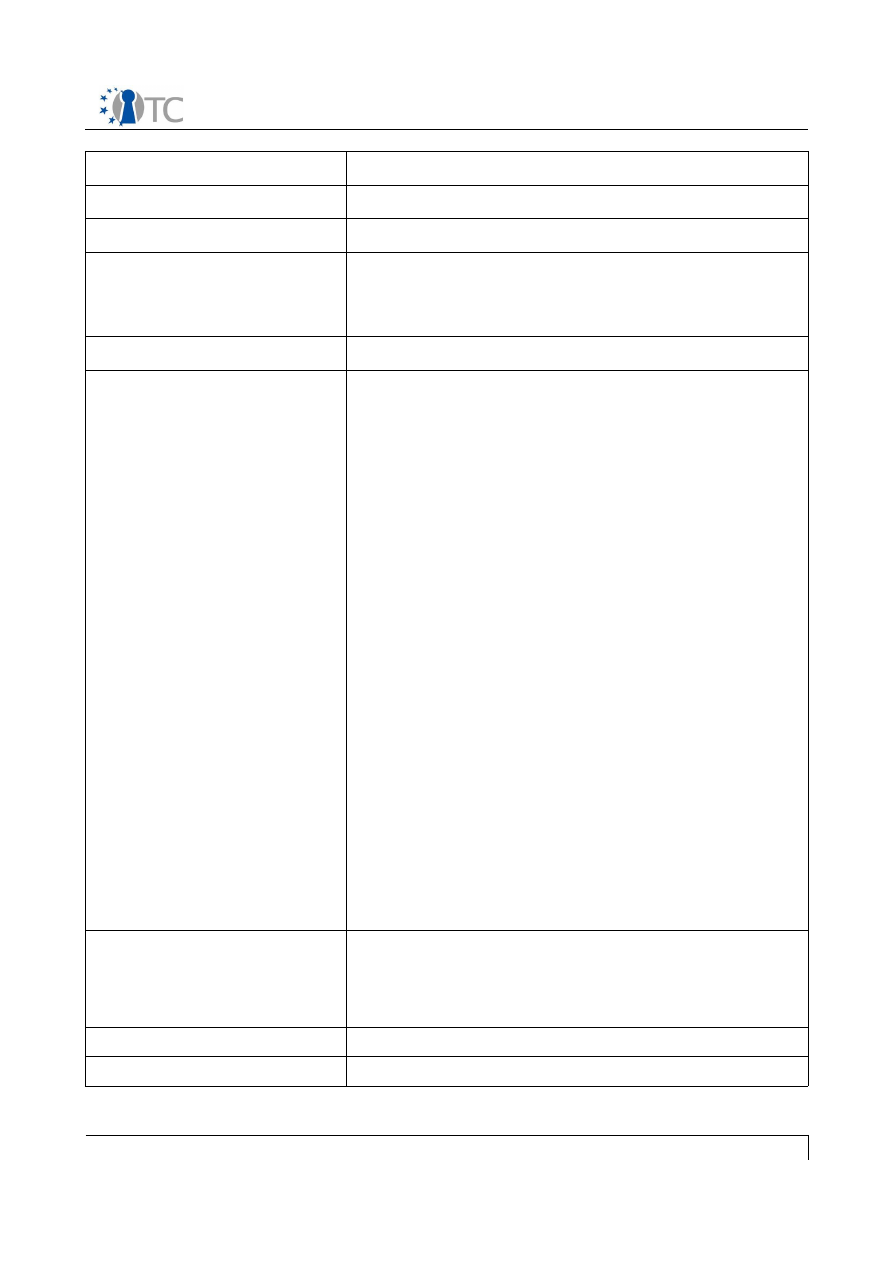
D6b.2 MEITC Specification and Test Plan
UC name
UC 110: Sending an e-mail
Primary actors
User
Stakeholders and interest
All MEITC servers
Assumptions
1. MEITC system is running
2. User is authenticated as in UC 60.
3. User can read mails as explained in UC 100.
Postconditions
User sends an e-mail
Main flow
1. User composes the e-mail and selects the
signing and encryption options.
2. Client sends the e-mail data to the WS.
3. WS sends the e-mail data to the MS.
4. MS sends the e-mail data to the CSP for
signing and encrypting the e-mail.
5. MS generates the signature for the e-mail
by using the sender's private key and/or
encrypts it by using the public keys of the
recipient.
6. MS sends the e-mail transmission
information to trusted log server (LS).
7. LS stores a record that contains details of
the e-mail and the digest calculated over
the message bytes; this secure record is
held for non-repudiation purposes.
8. MS sends the e-mail data to the DB.
9. DB stores the signed and/or encrypted e-
mail to the sender's and the recipients'
mailboxes.
10.MS sends the acknowledge of the operation
and the update of the mailbox to the WS
11.WS forwards the acknowledge to the web
browser.
Alternative flow
1. In any of the steps above, if the
corresponding (affected) server is not
functioning properly, then the WS sends a
reply showing the error to the user.
System requirements
See assumptions in 2.5
Open issues
None
Internal document
21/31

D6b.2 MEITC Specification and Test Plan
UC name
UC 120: Deleting an e-mail
Primary actors
User
Stakeholders and interest
All MEITC servers
Assumptions
1. MEITC system is running, not necessarily
with all compartments.
2. The user is authenticated as in UC 60.
3. The user can read her e-mail as explained
in UC 100.
4. The user has her inbox open.
Postconditions
The user deletes the selected e-mail
Main flow
1. User selects the appropriate e-mail to be
deleted
2. User clicks on the Delete button
3. WS sends this information to MS
4. MS deletes the e-mail and informs DB
5. E-mail is deleted from the DB
Alternative flow
1. In any of the steps above, if the
corresponding (affected) server is not
functioning properly, then the WS sends a
reply showing the error to the user.
System requirements
See assumptions in 2.5
Open issues
None
Internal document
22/31

D6b.2 MEITC Specification and Test Plan
UC name
UC 200: Requesting a certificate
Primary actors
User
Stakeholders and interest
All MEITC servers
Assumptions
1. MEITC system is running.
2. User logins to the certificate manager.
Postconditions
User requests a certificate
Main flow
1. User requests for a new certificate.
2. This request is stored in the DB repository.
3. The request process is continued by the
administrator in UC 230
Alternative flow
System requirements
See assumptions in 2.5
Open issues
Normally this should be done by administrator.
Usual certificate requesting mechanisms will be
investigated.
Internal document
23/31

D6b.2 MEITC Specification and Test Plan
UC name
UC 210: Revoking a certificate
Primary actors
User
Stakeholders and interest
All MEITC servers
Assumptions
1. MEITC system is running
2. User has a certificate
3. User logins to the certificate manager.
Postconditions
Certificate is revoked
Main flow
1. User asks for revoking his certificate.
2. This request is stored in the DB repository.
3. The revocation process is continued by the
administrator in UC 240
Alternative flow
System requirements
See assumptions in 2.5
Open issues
None
Internal document
24/31

D6b.2 MEITC Specification and Test Plan
UC name
UC 220: Viewing a certificate
Primary actors
User
Stakeholders and interest
All MEITC servers
Assumptions
1. MEITC system is running.
2. User logins to the certificate manager.
3. User already has a certificate.
Postconditions
User views the selected certificate.
Main flow
1. User clicks on the menu item in order to
view the certificate.
Alternative flow
None
System requirements
See assumptions in 2.5
Open issues
All users should be able to see other's
certificates.
Internal document
25/31

D6b.2 MEITC Specification and Test Plan
UC name
UC 230: Accepting a certificate request
Primary actors
User
Stakeholders and interest
All MEITC servers
Assumptions
1. User has requested a certificate as in UC
200.
2. MEITC system is running.
3. Administrator logins to the certificate
manager.
Postconditions
Certificate request is granted and certificate is
generated.
Main flow
1. Administrator views the certificate request.
2. Administrator accepts the certificate
request.
3. Certificate is generated by CSP and stored
on the database.
4. When the user logs in again, he'll be
informed that certificate is generated.
Alternative flow
3.a. System administrator rejects certificate
request.
System requirements
See assumptions in 2.5
Open issues
None
Internal document
26/31

D6b.2 MEITC Specification and Test Plan
UC name
UC 240: Accepting a certificate revoke
request
Primary actors
User
Stakeholders and interest
All MEITC servers
Assumptions
1. User has issues a certificate revocation
request as in UC 210.
2. MEITC system is running.
3. Administrator logins to the certificate
manager.
Postconditions
Certificate revocation request is accepted and
certificate is revoked.
Main flow
1. Administrator views the certificate
revocation request.
2. Administrator accepts the certificate
revocation request.
3. Certificate is revoked generated by CSP and
revocation information is stored on the
database.
4. Certificate is deleted from the DB.
Alternative flow
3.a. System administrator rejects certificate
revocation request.
System requirements
See assumptions in 2.5
Open issues
This process can optionally automatically be
issued by the system, immediately after user
request, without administrator intervention.
3.3 Performance requirements
In this step of the project, it is not possible to give numerical performance
requirements. Normally, the application focuses on the security of messaging system.
Therefore the performance of the system is not considered as an important issue for
the project yet.
3.4 Design constraints
In this section, the standards that the MEITC have to comply with and the hardware
constraints to be obeyed will be examined.
3.4.1 Standards compliance
Generally, the components developed in the OPEN TC project will support TPM 1.2 and
Internal document
27/31

D6b.2 MEITC Specification and Test Plan
TSS 1.2. In this case the TSS implementation written for Linux will have to comply with
the standards prepared by the Trusted Computing Group (TCG). TSS developed in
Open TC project will support the version 1.2 of the standards, and so will MEITC. For
hardware compliance, MEITC will utilize Infineon TPM 1.2 supported mainboards.
3.5 Software System Attributes
Software system attribute requirements for the MEITC system are as follows.
3.5.1 Reliability
Software developed for MEITC system must run without any critical problems on
installed base. All requests in the software system must run correctly and finish
requests without any error. When an error occurs in the system, accurate knowledge
should be given to the user. The minimal configurations for computers must be
provided in the MEITC systems. Reliability shall depend on the reliability of hardware
devices. Failure of one will render the other useless for this application. For this
project, all systems in server side will be running on OpenSUSE. For the initial
prototype, Pardus Linux will be used.
3.5.2 Availability
This system is designed to run 24 hours a day and be readily available to the user.
System administrator makes necessary controls for the availability of the MEITC
system. Administrator of the system must be sure of running web, e-mail, database
and CSP services correctly. In any problems if necessary computers can be restarted
by the system administrator and loss or corrupted data can be restored from backups.
3.5.3 Security
To make a secure system, unnecessary ports in the MEITC system should be closed for
internal and external access. For the end users connecting to the system via browser
necessary ports like HTTP (80), OpenSSL (443) and TSS communication should be
open.
3.5.4 Maintainability
User administration and application running in the MEITC system will be via web
browser based interface. Necessary OpenSSL certificates which will be used in the
system should be installed for each user computers separately for a smooth run.
MEITC system should be backed up during predefined intervals. In this way we can
decrease data loss and corruption when system collapses. Database, Trusted Log and
CSP server backups must be taken frequently.
3.5.5 Portability
All the applications developed are portable to other Linux distributions since they will
be provided with RPM packages together with source code. MEITC is not portable itself
to other platforms.
4
Test plan
MEITC test plan will include unit tests, module test, integration test and usability test
during the project development phase. “MEITC Detailed Design and Test Document”
includes an extended test document which is based on this test plan. All tests except
Internal document
28/31
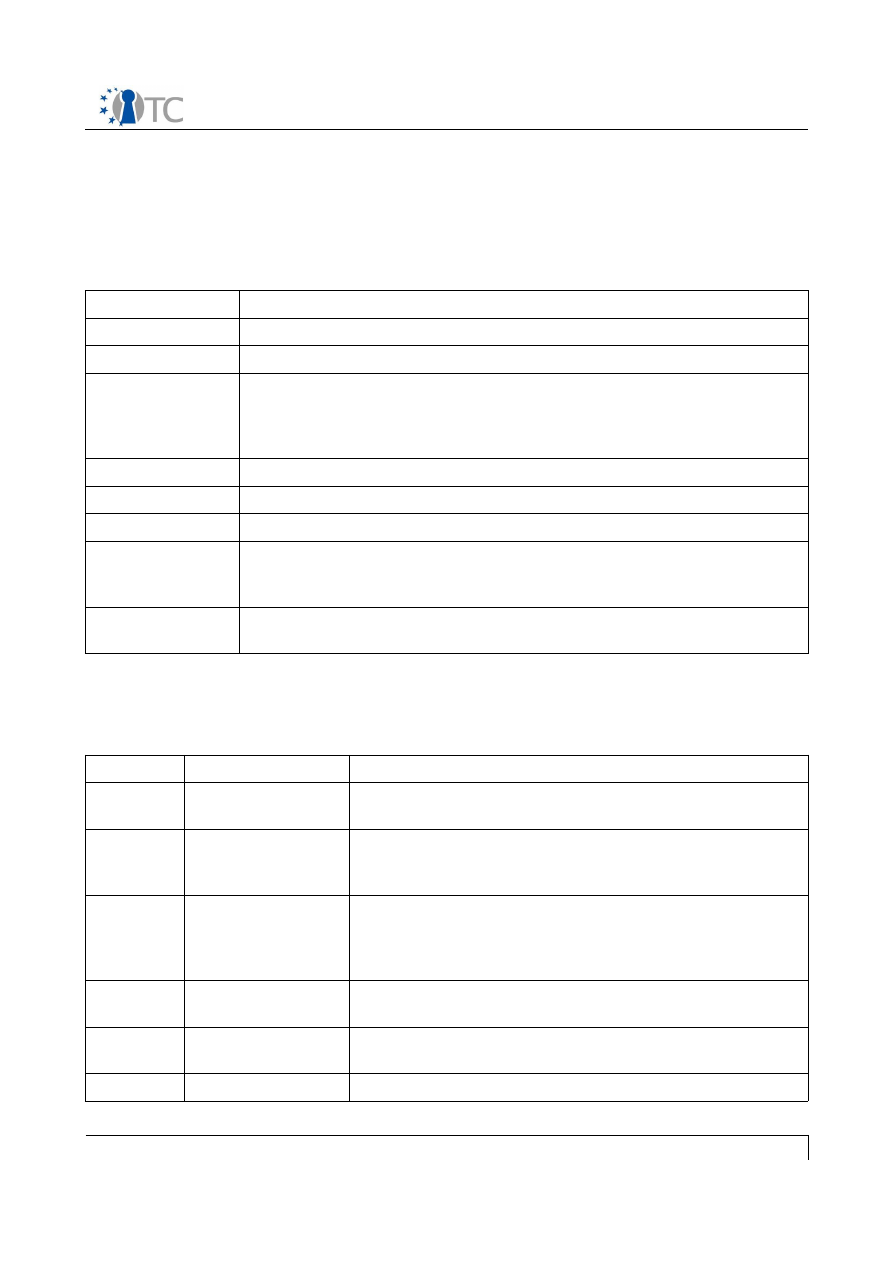
D6b.2 MEITC Specification and Test Plan
usability test will be accomplished by TUBITAK staff who whote the application itself.
5
Appendix - 1 : Definitions
Table 1 contains definitions for words used within this document.
Table 1. Definitions
Terminology
Definition
Apache
A general purpose web server
Browser
Software used to view hypertext documents
Integrity
Measurement
Integrity measurement is the process of obtaining metrics of
platform characteristics that affect the integrity (trustworthiness)
of a platform; storing those metrics; and putting digests of those
metrics in PCRs
Java
A programming language created by Sun Microsystems
MySQL
MySQL is a database management system
Postfix
Postfix is an open source mail transfer agent
Sealing
Sealing provides assurance that a protected messages are only
recoverable when the platform is functioning in a very specific
known configuration.
Remote
Attestation
Remote attestation is a way to prove to a challenger that you're
truly running the software on your computer that you say you are.
6
Appendix - 2 : Acronyms
Commonly used acronyms used in this report are given in Table 2.
Table 2. Acronyms
Acronym
Terminology
Definition
CSP
Certificate Service
Provider
CSP is the certificate service provider for MEITC
DB
Database
DB is a collection of information organized in such a
way that a computer program can quickly select
desired pieces of data
HTML
Hyper Text
Markup Language
HTML, a subset of Standard Generalized Mark-Up
Language (SGML) for electronic publishing, the
specific standard used for the World Wide Web
(WWW)
HTTP
Hyper Text
Transfer Protocol
HTTP, the actual communications protocol that
enables web browsing
LS
Log Server
LS is the machine to which log events are sent by the
system
MEITC
Message
MEITC is a secure message exchange environment.
Internal document
29/31

D6b.2 MEITC Specification and Test Plan
Acronym
Terminology
Definition
Exchange
Infrastructure for
Trusted
Computing
OPEN TC
Open Trusted
Computing
OPEN TC consortium is an R&D project focusing on
the development of trusted and secure computing
systems based on open source software.
Open SSL Open Secure
Socket Layer
OpenSSL is a popular package to add cryptographic
security to applications communicating over a
network
JSP
Java Server Pages Java Server Pages (JSP) are normal HTML with Java
code pieces embedded in them. A JSP compiler is
used to generate a Servlet from the JSP page.
PKI
Public Key
Infrastructure
PKI is a secure method for exchanging information.
PKI uses a public/private key, to encrypt IDs,
documents, or messages. It starts with a certificate
authority (CA), which issues digital certificates. Digital
certificates or digital IDs authenticate the identity of
people and organizations over a public system such
as the Internet.
SRS
Software
Requirements
Specification
SRS is a complete description of the behaviour of the
system to be developed.
SVN
Subversion
SVN is a tool which allows development teams to
safely coordinate and track software source code
changes.
TC
Trusted
Computing
Trusted computing is a combination of software and
hardware supporting applications to ensure that data
cannot be accessed unless the user’s system is
operating as expected and has not been tampered
with.
TCB
Trusted
Computing Base
TCB is a part of a platform that is assumed to perform
its tasks correctly, even if the platform itself is
corrupted.
TCP/IP
Transmission
Control Protocol /
Internet Protocol
TCP/IP is a set of protocols developed to allow
cooperating computers to share resources across a
network.
TPM
Trusted Platform
Module
The TPM is a micro controller that stores keys,
passwords and digital certificates.
TSS
Trusted Software
Stack
The TSS is a software specification that provides a
standard API (Application Programming Interface) for
accessing the functions of the TPM.
Internal document
30/31

D6b.2 MEITC Specification and Test Plan
Acronym
Terminology
Definition
WS
Web Server
A web server is a computer that stores web
documents and makes them available for the rest of
the world to see through the world wide web.
Internal document
31/31
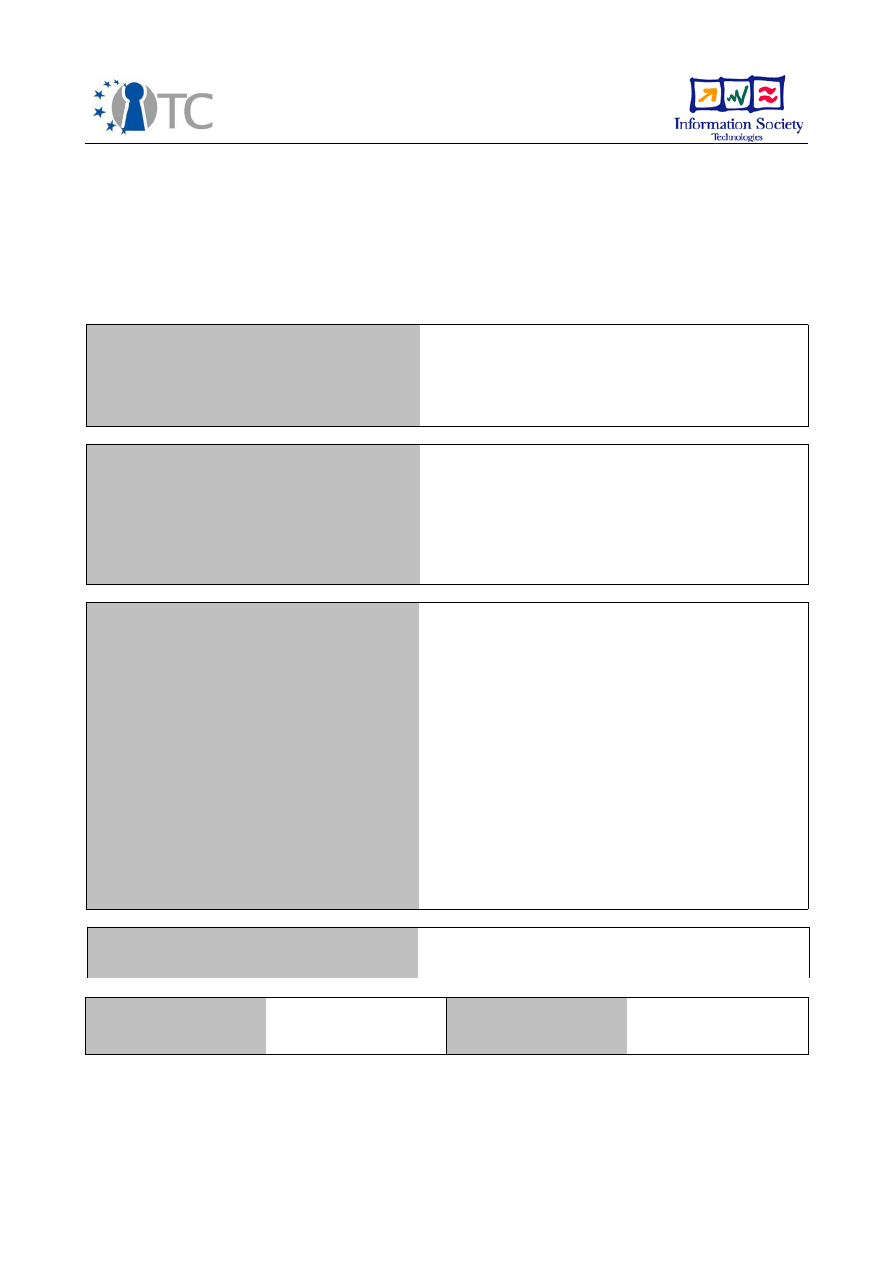
WP06b.3 MEITC Detailed Design and Test
Document
Project number
IST-027635
Project acronym
Open_TC
Project title
Open Trusted Computing
Deliverable type
Deliverable
Deliverable reference number
IST-027635/D6b.2/ Final / 1.00
Deliverable title
WP06b.3 MEITC Detailed Design and Test
Document
WP contributing to the deliverable
WP 6
Due date
Oct 07
Actual submission date
28 Oct 07
Responsible Organisation
TUBITAK
Authors
Görkem Çetin, Kadir İmamoğlu, Volkan Erol
Abstract
This internal deliverable is the detailed
design and test plan for MEITC system
Keywords
Dissemination level
Public
Revision
Instrument
IP
Start date of the
project
1
st
November 2005
Thematic Priority
IST
Duration
42 months

OTC-364: WP06b.3 MEITC Detailed Design and Test Document
Table of Contents
1 Introduction...............................................................................................................5
1.1 Purpose..................................................................................................................5
1.2 Definitions and abbreviations ................................................................................5
2 Design description.....................................................................................................5
2.1 Design philosophy..................................................................................................6
2.2 Implementation Language.....................................................................................6
2.3 Design Overview....................................................................................................6
2.4 MEITC Components and Software Modules............................................................8
2.4.1 MEITC WebServer Component..........................................................................8
2.4.2 MEITC MailServer Component...........................................................................9
2.4.3 MEITC DBServer Component............................................................................9
2.4.4 MEITC LogServer Component.........................................................................10
2.4.5 MEITC CertificateServices Component............................................................10
2.4.6 MEITC Administrator Component....................................................................11
2.4.7 MEITC Webmail Component............................................................................11
2.4.8 Meitc System Component...............................................................................11
2.4.9 MEITC Measurement component....................................................................12
2.4.1 0 MEITC TrustedBoot Component....................................................................12
2.4.1 1 MEITC Attestator component........................................................................13
2.4.1 2 MEITC Connector Component.......................................................................13
2.4.1 3 MEITC ApplicationServer Component ..........................................................13
2.4.1 4 MEITC Sealing Component ...........................................................................14
2.4.1 5 MEITC TimeServices Component..................................................................14
3 Project standards, conventions and procedures......................................................14
3.1 Design standards.................................................................................................14
3.2 Documentation standards....................................................................................15
3.3 Naming conventions.............................................................................................15
3.4 Programming standards.......................................................................................16
3.5 Database Design..................................................................................................18
3.5.1 Admin table....................................................................................................18
3.5.2 Alias table.......................................................................................................18
3.5.3 domain table...................................................................................................19
3.5.4 domain_admins table......................................................................................20
3.5.5 Log table.........................................................................................................20
3.5.6 mailbox table..................................................................................................20
3.5.7 Vacation table.................................................................................................21
3.6 Software development tools.................................................................................21
4 Design issues...........................................................................................................22
4.1 Localization..........................................................................................................22
5 Test plan..................................................................................................................22
6 Sequence diagrams.................................................................................................24
6.1 MEITC system startup sequence diagram............................................................24
6.2 Adding a new user sequence diagram.................................................................25
6.3 Deleting an existing user sequence diagram.......................................................26
6.4 Sending an e-mail sequence diagram..................................................................27
Internal document
2/50

OTC-364: WP06b.3 MEITC Detailed Design and Test Document
6.5 Sending a signed e-mail sequence diagram.........................................................28
6.6 Sending an encrypted e-mail sequence diagram.................................................29
6.7 Sending a signed and encrypted e-mail sequence diagram.................................30
6.8 Deleting an e-mail sequence diagram..................................................................31
6.9 Accessing user's inbox sequence diagram...........................................................32
6.1 0User authenticates via MEITC sequence diagram...............................................33
6.1 1Taking TPM ownership sequence diagram.........................................................34
6.1 2Establishing a trusted channel sequence diagram.............................................35
6.1 3Remote attestation sequence diagram..............................................................36
6.1 4Creating a certificate sequence diagram............................................................37
6.1 5Creating a certificate request sequence diagram..............................................38
6.1 6Creating a certificate revocation request sequence diagram.............................39
6.1 7Revoking a certificate sequence diagram..........................................................40
7 MEITC All Classes diagram.......................................................................................41
8 Installation...............................................................................................................42
8.1 Package structure................................................................................................42
8.2 File and directory structure..................................................................................42
8.2.1 Web Server.....................................................................................................42
8.2.2 Mail Server......................................................................................................44
8.2.3 Database Server.............................................................................................44
9 Graphical user interface ..........................................................................................44
9.1 Webmail GUI.........................................................................................................44
9.1.1 User Login Screen...........................................................................................45
9.1.2 Inbox Screen...................................................................................................45
9.1.3 Compose Email Screen...................................................................................46
9.2 Admin GUI............................................................................................................46
9.2.1 Admin Login screen........................................................................................46
9.2.2 Main menu screen..........................................................................................47
9.2.3 User list screen...............................................................................................47
9.2.4 Add user screen..............................................................................................47
9.2.5 Delete user list screen....................................................................................48
9.2.6 Delete user screen..........................................................................................48
9.2.7 Reset user list screen.....................................................................................49
9.2.8 Reset user screen...........................................................................................49
9.2.9 Services screen...............................................................................................50
Internal document
3/50

OTC-364: WP06b.3 MEITC Detailed Design and Test Document
List of figures
Figure 1: MEITC first prototype software modules..........................................................7
Figure 2:MEITC system startup sequence diagram.......................................................24
Figure 3:Adding a new user sequence diagram............................................................25
Figure 4:Deleting an existing user sequence diagram..................................................26
Figure 5:Sending an e-mail sequence diagram.............................................................27
Figure 6:Sending a signed e-mail sequence diagram...................................................28
Figure 7:Sending an encyrpted e-mail sequence diagram............................................29
Figure 8:Sending a signed and encrypted e-mail sequence diagram...........................30
Figure 9:Deleting an e-mail sequence diagram............................................................31
Figure 10:Accessing user's inbox sequence diagram...................................................32
Figure 11:User authenticates via MEITC sequence diagram.........................................33
Figure 12:Taking TPM ownership sequence diagram....................................................34
Figure 13:Establishing a trusted channel sequence diagram.......................................35
Figure 14:Remote attestation sequence diagram.........................................................36
Figure 15:Creating a certificate sequence diagram......................................................37
Figure 16:Creating a certificate request sequence diagram.........................................38
Figure 17:Creating a certificate revocation request sequence diagram.......................39
Figure 18:Revoking a certificate sequence diagram.....................................................40
Figure 19:MEITC all classes diagram............................................................................41
Figure 20:User login screen..........................................................................................45
Figure 21:Inbox screen.................................................................................................45
Figure 22:Compose email screen.................................................................................46
Figure 23:Admin Login screen......................................................................................46
Figure 24:Main menu screen........................................................................................47
Figure 25:User list screen.............................................................................................47
Figure 26:Add user screen............................................................................................48
Figure 27:Delete user list screen..................................................................................48
Figure 28:Delete user screen........................................................................................49
Figure 29:Reset user list screen...................................................................................49
Figure 30:Reset user screen.........................................................................................50
Figure 31:Services screen............................................................................................50
Internal document
4/50

OTC-364: WP06b.3 MEITC Detailed Design and Test Document
1
Introduction
This detailed design document (DDD) is the high level design of MEITC application
(D06b3). Prior to this document, a report containing the MEITC specification has been
created and submitted which in turn includes the use case scenarios, requirements
and test cases complying IEEE specification requirements document.
Detailed design document introduces how MEITC system will work and various
interfaces between different components of MEITC. Since low level use-case diagrams
have been mentioned in a previous deliverable (D06b2), these will not be considered
again to be included in this document.
Generally speaking, MEITC system should be capable and have an easy to use
interface. For each additional level of complexity that is added, there should be a
compelling reason. Clients and servers are different components for obvious reasons
which has been detailed in D06b2. This framework includes more than one
compartment installations with different capabilities plus many frameworks, utilities
and drivers.
1.1 Purpose
This document defines design, coding standards and tools. Programmers should obey
the standards and use the applications and tools mentioned in Part 2 of this
document. During the implementation of the design, documentation for each
component is produced.
1.2 Definitions and abbreviations
MEITC:
Message Exchange Infrastructure for Trusted Computing
GUI:
Graphical user interface
DDD:
Detailed design document
MS:
Mail server
WS:
Web server
LS:
Log server
CSP:
Certificate service provider
DB:
Database server
HTTP:
Hypertext transfer protocol
TLS:
Transport layer security
SSL:
Secure socket layer
2
Design description
This section aims to describe the architecture of the MEITC system. It also provides
explanations about the choices made for the implementation of different parts of the
system. The section is split into 4 parts which explains the design philosophy, the
implementation language, the design overview and the system components which are
MEITC Web Server (WS), MEITC Mail Server (MS), MEITC Database (DB) server, MEITC
Log Server (LS), MEITC Certificate Service Provider (CSP) and user interfaces and also
Internal document
5/50

OTC-364: WP06b.3 MEITC Detailed Design and Test Document
other software modules defined for implementation purposes. The descriptions of
modules and components are made by the structure of the components and also
paying attention to the virtualization concepts.
2.1 Design philosophy
The preliminary architecture of the MEITC system is explained in the report D06b.2
MEITC Specification and Test Plan. The approach explained in this Detailed Design and
Test Document is based on these specifications. It is always possible that some minor
changes can be made in different components during the implementation phases of
the project but the fixed general and detailed concerns of the MEITC system design is
explained in the following subsections of this document.
2.2 Implementation Language
In the MEITC system, due to the structure of the already developed open source
packages taken for some components, different programming and scripting languages
will be used. For the system installation and configuration, bash shell scripts will be
used. For some applications that interacts directly with the TPM chip, C programming
language will be used. For user interface JSP scripting language will be used. For
modules interacting the core components of the system (for example: one of the
server components) with the user interface the Java programming language will be
used. The components developed will be implemented in a manner that will not cause
major problems for portability.
2.3 Design Overview
The system developed will be a fully secure message exchange infrastructure for
Linux Operating System by using the Trusted Platform Module (TPM) and the Trusted
Software Stack (TSS), built over a virtualization layer. This infrastructure will ensure
confidentiality, authentication, non-repudiation and data integrity on the installed
base.
MEITC system is composed of 6 components: MEITC WS, MEITC MS, MEITC DB Server,
MEITC LS, MEITC CSP and User interface as described in the MEITC Specification and
Test Plan document. As the OpenTC infrastructure uses the virtualization concepts, the
architecture of the system is designed as follows:
The previous architecture was based upon previous discussions and such, they do not
refer to the latest mutual agreement of what MEITC will look like. I'm amending the
following items so they reflect the final MEITC framework.
●
Dom0 contains no software applications other than Trusted Grub (tGrub),
measurement services and helper utilities to start DomU.
●
First prototype only includes MEITC WS, MEITC MS and MEITC DB Server on two
compartments, and 3
rd
year protototype will include MEITC CSP and MEITC LS, ,
where it's assumed that all of these compartments isolated from each other
using Xen virtualization layer technology. MEITC prototype will be based on Xen.
●
For suitability and performance considerations, there can be two virtual
compartments, one holding web services and the other holding database, mail
server, log server and CSP where certificates, keypairs, passwords for users are
hold and is assumed to be more secure than the first compartment. The first
Internal document
6/50
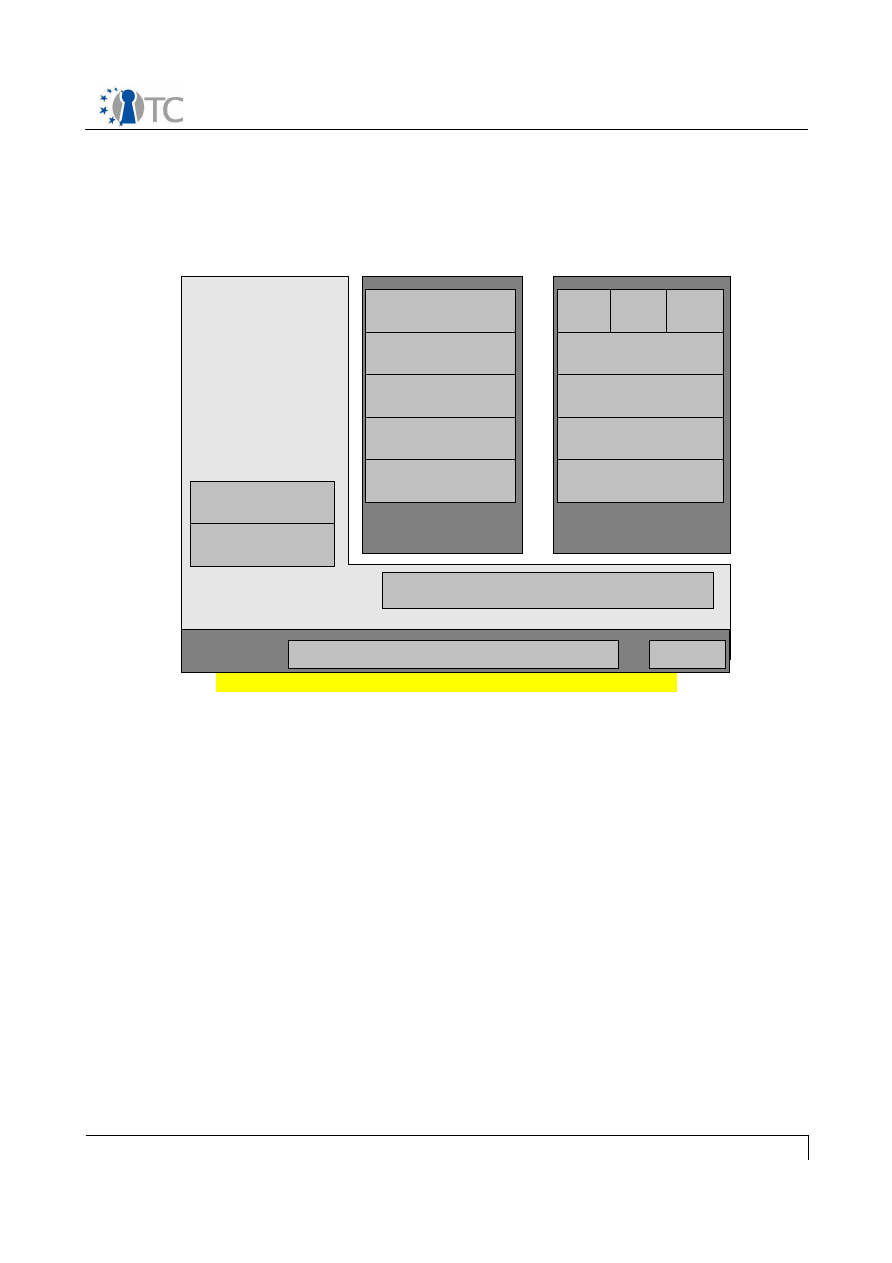
OTC-364: WP06b.3 MEITC Detailed Design and Test Document
prototype will be built on this model.
The general model of these compartments is in the following figure, according to the
first prototype:
Below is a short explanation about each of the MEITC components:
MEITC Database Server:
A database server will host users' mailboxes. User
information and quota information will be kept in this database.
MEITC Mail Server:
This component will handle all the e-mail traffic and it will use
the Trusted Log and the Certificate Service Provider (CSP) to implement the security
services for the messages, namely, integrity checking and non-repudiation. E-mails
will be stored in a directory structure.
MEITC Web Server:
This component will be the front-end for users and the system
administrators. Users and system administrators of MEITC will connect to this web
server via their web based browsers to compose or read e-mail messages.
MEITC Trusted Log Server:
This component guarantees the integrity checking of e-
mails and also the non-repudiation: it holds a record for each e-mail that includes data
about the message (i.e. the sender and the recipient addresses, etc.), the digest
calculated over the message and optionally the details of the remote attestation of the
various components. Trusted log server needs a secure time component from WP05a
in domU which could be used to count ticks after synchronizing from a trusted time
Internal document
7/50
Figure 1: MEITC first prototype software modules
DB
Virtualization layer
Mail server
Trusted log and
secure time service
Certificate services
Connector
domT
domT
Webmail
Administration
Application server
Attestator
Connector
domU
domU
users
certs
Measurement
services
tGRUB
Physical hardware
TPM

OTC-364: WP06b.3 MEITC Detailed Design and Test Document
server.
MEITC Certificate Service Provider:
This component will hold users' digital
certificates and keys for signing and encrypting e-mails. User and CSP keys will be
sealed to the state of the CSP in order to be released only if the system integrity is
effective.
Dom0 is responsible to provide measurement values of the specific files in
compartments, and check this value before corresponding servers are up and running.
The default communication protocol for data transmission between servers and the
client is Transmission Control Protocol / Internet Protocol (TCP/IP). At the upper level
Hyper Text Transfer Protocol (HTTP, default port=80) and Secure Socket Layer (SSL,
default port = 443) will be used for communication between the web server and client.
Proxies will be used for remote attestation in the MEITC system.
Access to the web server will be done through a Javascript compliant web based
browser: in order to guarantee the trustworthiness of the whole system, the browser
and the web server will communicate on a trusted channel using HTTP on top of the
conventional TLS/SSL protocols enabled for the mutual platform authentication.
MEITC system components are named as follows. Each compartment holds one or
more of these components.
●
MEITC WebServer component (in 1
st
compartment)
●
MEITC MailServer component (in 2
nd
compartment)
●
MEITC ApplicationServer component (in 1
st
compartment)
●
MEITC Administrator component (in 1
st
compartment)
●
MEITC Attestator component (in 1
st
compartment)
●
MEITC Connector component (in 1
st
and 2
nd
compartments)
●
MEITC CertificateServices component (in 2
nd
compartment)
●
MEITC DBServer component (in 2
nd
compartment)
●
MEITC LogServer component (in 2
nd
comparment)
●
MEITC Sealing component (dom0 and 2nd compartment)
●
MEITC Measurement component (dom0)
●
MEITC TimeServices component (in 2nd component)
●
MEITC TrustedBoot component (dom0)
●
MEITC Webmail component (in 1st compartment)
The items in red above show the corrent placement of compartments (i.e sealing,
trusted boot and measurement).
As mentioned above, these system components do not necessarily need to be on their
own compartments. Components can logically be distributed in two or more
compartments for better scalability and preserving machine power. Detailed
explanations are made for these components in the next section.
Detailed explainations are made in each of the subsections of the following paragraph
which explains each system components respectively.
Internal document
8/50

OTC-364: WP06b.3 MEITC Detailed Design and Test Document
2.4 MEITC Components and Software Modules
2.4.1 MEITC WebServer Component
Purpose:
This component is the front-end for users and the system administrators.
Users and system administrators of MEITC will connect to this web server via their web
based browsers to compose or read e-mail messages.
Responsibilities:
1. Web Server ensures the connection between the MEITC MS and Administrator
component in many cases.
2. When adding a new user to the system, WS takes user information from the
Administrator component. It checks whether the user is already defined in the
system or not. If the user is already defined, it send an error message to be
displayed on the Administrator component.
3. When a user wants to access his inbox in order to send or receive a message,
MEITC WS component takes inbox data from MEITC MS component.
4. Web server shows the administration interface to request, revoke or delete a
certificate.
Collaboration:
MEITC MailServer Component, MEITC DBServer Component, MEITC
CertificateServices Component, MEITC Administrator Component
SRS References:
1.2, 2.1.1, 2.1.4, 2.1.5, 2.1.6, 2.2, 3.2-UC10, 3.2-UC12, 3.2-UC40,
3.2-UC50, 3.2-UC60, 3.2-UC100, 3.2-UC110, 3.2-UC120, 3.6.2, 3.6.3
2.4.2 MEITC MailServer Component
Purpose:
This component handles all the e-mail traffic and it will use the Trusted Log
and the Certificate Service Provider (CSP) to implement the security services for
messages.
Responsibilities:
1. MEITC MailServer component handles all e-mail traffic using security services
ensured by MEITC infrastructure.
2. When user wants to access to his inbox in order to read/write/delete an e-mail,
MEITC MailServer component gets/sends inbox request from the MEITC WS and
requests this data from MEITC DBServer component.
Collaboration:
MEITC LogServer component, MEITC CertificateServices component,
MEITC DBServer component, MEITC WebServer component.
SRS References:
1.2, 2.1.4, 2.1.5, 2.2, 3.2-UC10, 3.2-UC12, 3.2-UC60, 3.2-UC100,
3.2-UC110, 3.2-UC120, 3.6.2, 3.6.3, 3.6.5
2.4.3 MEITC DBServer Component
Purpose:
This component will host users' mailbox authentication information together
with keys, certificate status information and certificates.
Responsibilities:
Internal document
9/50

OTC-364: WP06b.3 MEITC Detailed Design and Test Document
1. MEITC DBServer component keeps user e-mail preferences including passwords.
2. MEITC DBServer component is responsible for storing user certificates and keys.
3. MEITC DBServer component gets DB requests from webmail and sends required
information back.
4. MEITC DBServer component can get/set certificate status information. Database
is directly informed from certificate requests by using request and certificate
fields in mailbox table which corresponds to each user. There are 3 use cases
for certificates, mentioned below:
1. User has just been created: Both the request field and certificate field is
empty.
2. User requests a certificate, but not yet approved by the administrator:
Request field is populated with certificate request file. Certificate field is still
empty.
3. User requests a certificate and this is approved by the administrator:
Request field still includes the certificate request file. Certificate field is
populated with assigned certificate.
Collaboration:
MEITC MailServer component, MEITC WebServer Component, MEITC
Administrator component
SRS References:
1.2, 2.1.4, 2.1.5, 2.1.8, 2.2, 3.2-UC10, 3.2-UC12, 3.2-UC40, 3.2-
UC50, 3.2-UC60, 3.2-UC100, 3.2-UC110, 3.2-UC120, 3.4, 3.6.2, 3.6.3, 3.6.4, 3.6.5
2.4.4 MEITC LogServer Component
Purpose:
This component guarantees the integrity checking of e-mails and also the
non-repudiation by storing a record for each incoming and outgoing e-mail.
Responsibilities:
1. MEITC LogServer component holds records for each e-mail sent includingthe
hash of the message.
2. When a user wants to send an e-mail, MEITC MS sends e-mail data to MEITC LS
and it generates a secure record for these e-mail data and stores this record.
This will be done by referring to the ticks of TPM together with the referenced
time frame taken from a trusted time server.
Collaboration:
MEITC MailServer component, MEITC TimeServices component
SRS References:
1.2, 2.1.4, 2.1.8, 2.2, 3.2-UC110, 3.4, 3.6.4
2.4.5 MEITC CertificateServices Component
Purpose:
This component stores users' digital certificates and keys for signing and
encrypting e-mails.
Responsibilities:
1. MEITC CertificateServices component stores user certificates for further
information retrieval.
Internal document
10/50

OTC-364: WP06b.3 MEITC Detailed Design and Test Document
2. MEITC CertificateServices component stores user keypairs for encryption and
signing of e-mails.
3. When MEITC Administrator component sends a certificate generation or revoke
request, MEITC CertificateServices component generates the certificate
together with user keys.
Collaboration:
MEITC Administrator component, MEITC ApplicationServer component,
MEITC DBcomponent
SRS References:
1.2, 2.1.4, 2.2, 2.4, 3.1, 3.2-UC60, 3.2-UC110, 3.6.2, 3.6.3, 3.6.4
2.4.6 MEITC Administrator Component
Purpose:
This component provides interaction between the users (including system
administrator) and other components.
Responsibilities:
1. This component is a java application which receives user/administrator requests
and acts accordingly. Administrator component ensures all the interaction
between the users and the MEITC components
2. Administrator component receives the “adduser”, “delete user” and “modify
user” requests from administrator and component.User management is done
via administrator component, which in turn passes the requests to web server.
3. Administrator component receives the signature generation, revoke or view
request from user or administrator and passes this to MEITC WebServer
component. (again, same applies here).
Collaboration:
MEITC Webmail component, MEITC ApplicationServer component,
MEITC WebServer component
SRS References:
1.2, 2.1, 2.1.1, 2.1.2, 2.1.3, 2.1.4, 2.1.5, 2.1.6, 2.1.8, 2.2, 2.3, 3.2-
UC40, 3.2-UC50, 3.2-UC60, 3.2-UC110, 3.2-UC120, 3.6.3, 3.6.4, 3.6.5
2.4.7 MEITC Webmail Component
Purpose:
This component provides web based mail services.
Responsibilities:
1. Sending, receiving and displaying the e-mails passed by MailServer component.
2. Deleting an e-mail on behalf of a user's request.
3. Authenticating via Mailserver component.
Collaboration:
MEITC ApplicationServer component, MEITC WebServer component
2.4.8 Meitc System Component
Purpose:
It is the core module of the system which constitutes the main function for
MEITC system components. It is point of entry for the application. It can be thought as
the engine ensuring the working status of different components.
Internal document
11/50

OTC-364: WP06b.3 MEITC Detailed Design and Test Document
Responsibilities:
1. This the core module for the MEITC system. As it is the point of entry for the
system, it has little direct responsibilities. All other responsibilities are shared
between the components and software classes.
2. In the TPM take ownership operation, the SystemAdministrator chooses the
operation within it.
3. System wants owner and SRK password from the SystemAdministrator.
4. When he gives the password, it calls the TPMTakeOwnership method via the
TPMHelper class.
Collaboration:
MEITC LogServer component, MEITC WebServer component, MEITC
DatabaseServer component, MEITC MailServer component
SRS References:
3.2-UC11
2.4.9 MEITC Measurement component
Purpose:
Dom0 includes the Xen kernel which includes all the trusted computing and
virtualization functionalities provided by the OpenTC infrastructure. Dom0 includes all
the Trusted Computing Base and virtualization functionalities for our implementation.
Responsibilities:
1. During the MEITC system startup process the dom0 checks the compartments in
which the MEITC DB Server, MEITC WS and MEITC MS stay and if the integrity
checks are successful, dom0 starts the MEITC DB Server, MEITC WS and MEITC
MS.
2. MEITC WS, MEITC MS and MEITC DB Server sends messages to dom0 that they
have been properly started.
Collaboration:
MEITC CertificateServices component, MEITC LogServer component,
MEITC WebServer component, MEITC MailServer component, MEITC DatabaseServer
component
SRS References:
3.2-UC10
2.4.10 MEITC TrustedBoot Component
Purpose:
This component contains TrustedGrub boot loader which checks the
measurement values of different compartments in the system and ensures the system
integrity.
Responsibilities:
1. During MEITC startup procedure SystemAdministrator boots dom0 and tGrub
checks integrity of dom0 and domUs in which the MEITC WS, MEITC MS and
MEITC DB Server stay.
2. If the integrity check is successful the compartments are started. If not, the
operation is stopped.
Collaboration:
None
Internal document
12/50

OTC-364: WP06b.3 MEITC Detailed Design and Test Document
SRS References:
3.2, 3.2-UC10
2.4.11 MEITC Attestator component
Purpose:
This component forms the source proxy application during the remote
attestation procedure.
Responsibilities:
1. In the remote attestation procedure, server opens connection with client.
2. Server gets its own TPMQuote and sends it to client.
3. Client verifies the server's quote and if the verification is successful, it sends a
message to the server.
4. Client takes its own TPMQuote and sends it to server.
5. Server verifies client's quote and if the verification is successful, it sends
message to client and attestation is succeeded.
Collaboration:
domT and domU
SRS References:
3.2-UC12
2.4.12 MEITC Connector Component
Purpose:
This component connects domT and domU.
Responsibilities:
1. Connector in domT receives MySQL commands from Administrator component
and sends these commands to domU via an encyrpted channel.
2. Connector in domU recevies these commands and interprets them, sending
directly to MEITC Database component.
3. Connector in domU sends back possible errors and outputs.
Collaboration:
domT and domU
SRS References:
None
(read until here)
2.4.13 MEITC ApplicationServer Component
Purpose:
This component runs MEITC Administrator component and MEITC Webmail
component
Responsibilities:
1. MEITC Administrator component is responsible from starting MEITC
Administrator component and MEITC Webmail component and ensures that they
run properly.
Internal document
13/50

OTC-364: WP06b.3 MEITC Detailed Design and Test Document
Collaboration:
MEITC Administrator component, MEITC Webmail component
SRS References:
None
2.4.14 MEITC Sealing Component
Purpose:
This component seals MEITC CertificateManager component database
against TPM
Responsibilities:
1. MEITC Sealing component seals the keys which reside in MEITC
CertificateManager component database and unseals them when requested by
domT.
Collaboration:
MEITC CertificateManager component, domT
SRS References:
None
2.4.15 MEITC TimeServices Component
Purpose:
This component provides log files utilizing secure time service from TPM.
Responsibilities:
1. MEITC TimeServices component provides trusted time services to for MEITC
LogServer component.
Collaboration:
MEITC LogServer component
SRS References:
None
3
Project standards, conventions and procedures
3.1 Design standards
For the Java and JSP parts of the project, the design method used is object-oriented in
design. The standard UML diagrams is used for representing MEITC components and
software classes.
For the parts of the system which are connected directly to the TPM chip, a procedural
programming language, C, is used so for these parts some special attention has to be
paid. This means:
●
We don't use jumps (goto)
●
We use hierarchical decomposition: if nesting becomes too deep, define a new
lower-level module.
For installation and system startup procedures some bash shell scripts will be written.
Since various Linux distributions use different local startup scripts, the installer will
Internal document
14/50
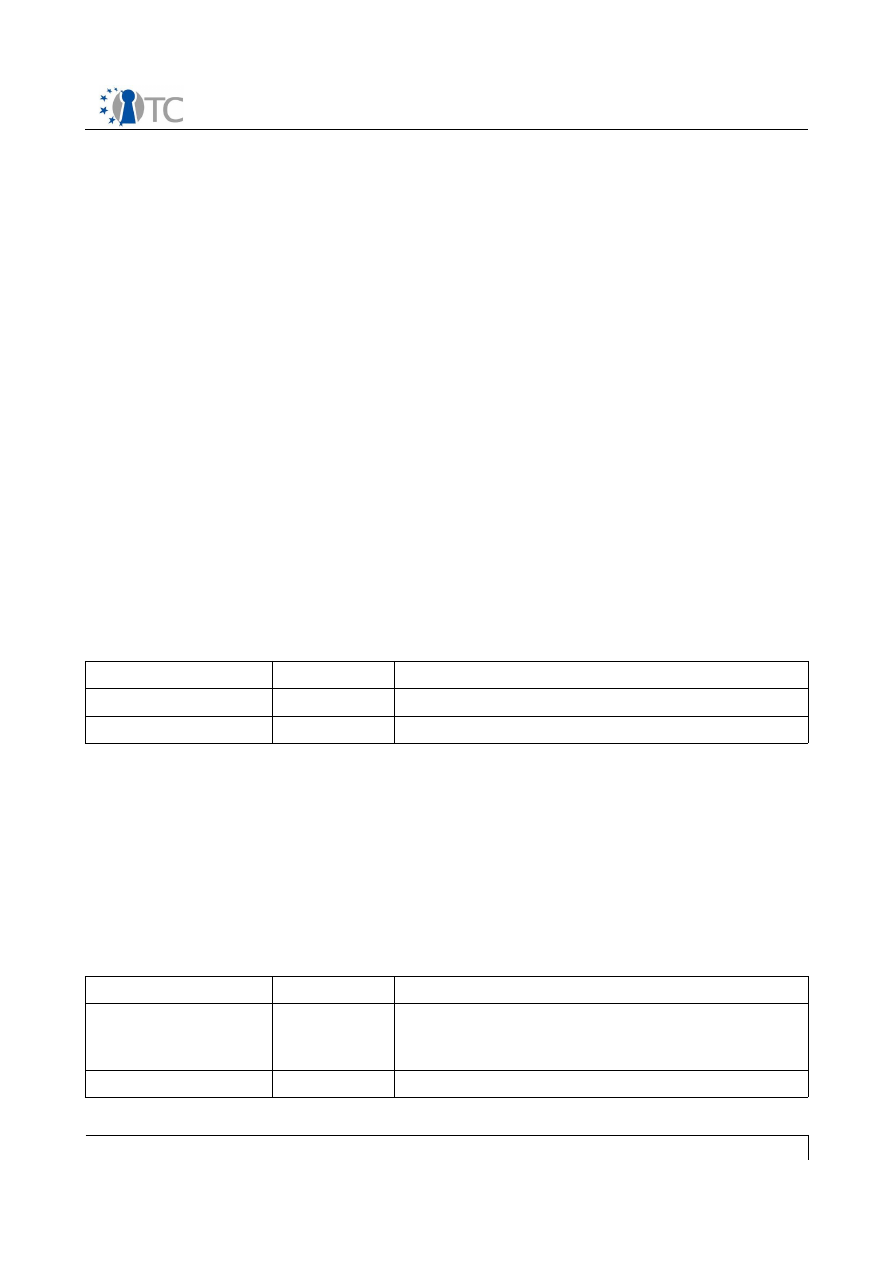
OTC-364: WP06b.3 MEITC Detailed Design and Test Document
detect and identify which Linux distribution is used and install the bash scripts
accordingly. The system will use basic bash 2.0 functions to guarantee a foolproof
system startup by checking for exceptions, control and eliminate possible errors.
3.2 Documentation standards
The tools used for the detailed design are:
●
Visual Paradigm UML modelling software for UML diagrams
●
OpenOffice for documentation
●
Eclipse for Java/JSP programming
●
Vi and Kate text editors for writing shell scripts
3.3 Naming conventions
For Java/JSP part:
●
Variables will be documented in the following style:
int maxSpeed; // the maximum speed of the upper arm
●
Exceptions are defined as Java-style. For example:
TcException
●
Class names will be documented in the same way as variable names, except
that the first letter must be a capital letter, for instance:
Robot
.
●
Interface names will be begin with a big 'I', for instance:
IcompartmentManager
●
Method names will be in the following style:
void thisIsAFunction (int a, int b);
Table 1: Naming Convention for Java/JSP
File Type
Extension
Comment
documentation
html
These are javadoc generated from Java files
source code
.java
Should be same name as the class name
For C part:
●
Variables will be like Java style and will be documented in the same line:
int anyVariable; // this is a comment
●
Function names will be in the following sytle and will be document with a single
line:
// this is a comment for this function
void this_is_a_function (int a, int b);
Table 2: Naming Convention for C
File Type
Extension
Comment
documentation
.odt
If needed some specific documentation will be
made in OpenOffice text format. In C files there
will be comments for code fragments.
source code
.java
Should be same name as the class name
Internal document
15/50
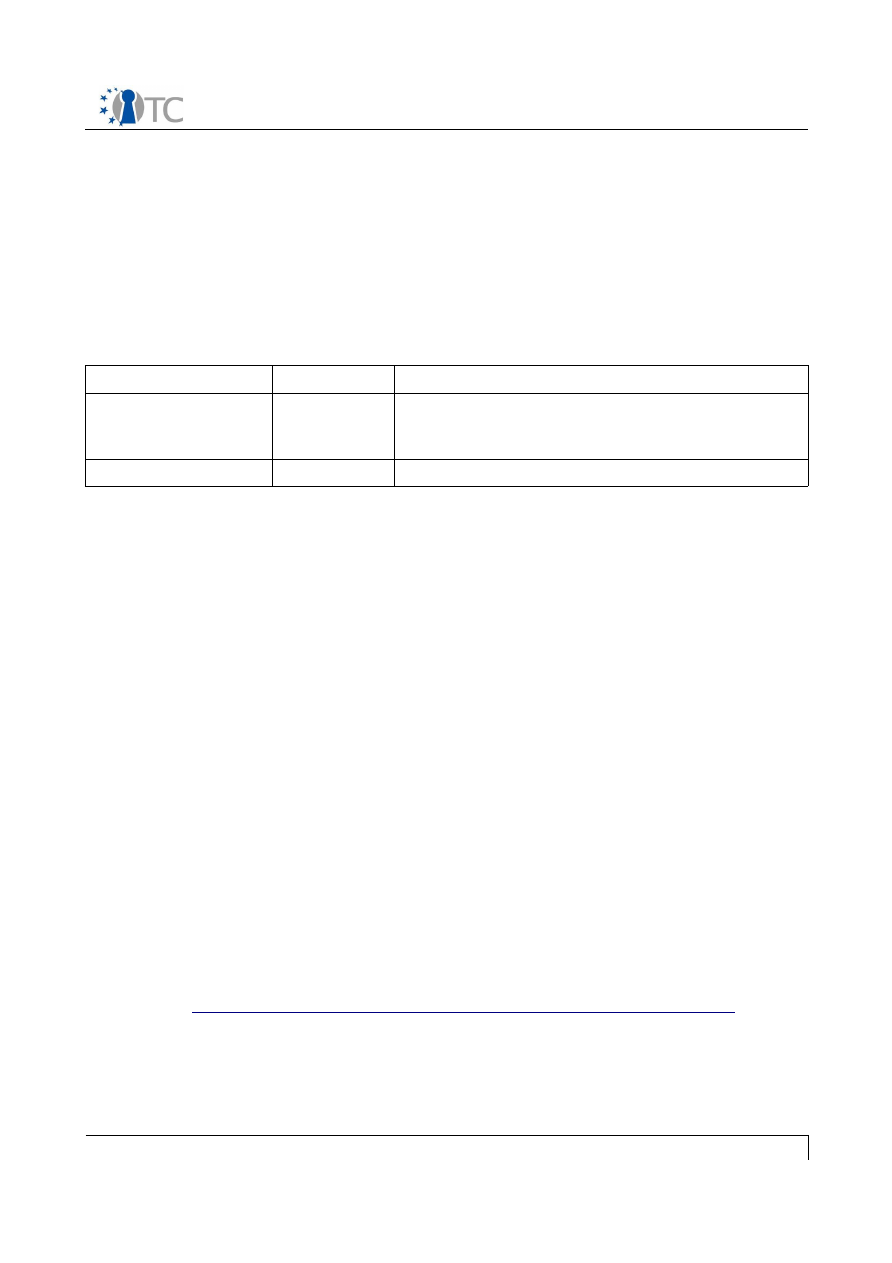
OTC-364: WP06b.3 MEITC Detailed Design and Test Document
For shell scripts:
●
Shell variables are named using the same general rules as C programming
language variables. Capital letters will be used for readability, i.e
TCSD_STARTUP=/usr/sbin/tcsd
●
Function names are all lower letter.
function startvnc () {
exit 0
; }
Table 3 : Naming Convention for shell scripts
File Type
Extension
Comment
documentation
.odt
If needed some specific documentation will be
made in OpenOffice text format. Necessary
comments will be placed in shell scripts
source code
.sh
The script name consists of lowercase letters
3.4 Programming standards
During the MEITC application development the following standards on behalf of coding
and commentary constructs and layouts are used. This means that source code
written in the project must comply to these standards.
●
Standard file headings
●
Header file headings (For .h files ):
// MEITC header file: file name, version: version number
// Author: Author(s) of document
// Created on: creation date
// Description: description of contents
●
Source file headings (For c-code (.c) files ):
// MEITC source file: file name, version: version number
// Author: Author(s) of document
// Created on: creation date
// Description: description of contents
●
Source file headings (For java (.java) files ):
Standard javadoc style headings will be used. For details, see:
http://java.sun.com/j2se/javadoc/writingdoccomments/index.html
●
Source file standard(For(.jsp) files ):
.jsp source files will be coded in the following standard
Internal document
16/50

OTC-364: WP06b.3 MEITC Detailed Design and Test Document
<?xml version = "1.0"?>
<!DOCTYPE html PUBLIC "//W3C//DTD XHTML 1.0 Strict//EN"
"http://www.w3.org/TR/xhtml1strict.dtd">
<! JSP that take does something >
<% page settings %>
<%@ page import = "java.util.*" %>
<html xmlns = "http://www.w3.org/1999/xhtml">
<! head section of the document >
<head>
<title>Some heading</title>
</head>
<! body section of the document >
<body>
<% some jsp statement %>
some html statement
<% some jsp statement
%>
</body>
</html> <! end XHTML document >
●
Standard class definitions (Java classes)
class class name ( (extends, implements) parentclass)
{
tab variable declarations
tab constructor declarations
tab method declarations
}
●
Standard method declarations (Java and C files)
return type method name ( parameters )
●
Standard methods definitions (Java and C files)
return type method name ( parameters )
// precondition: precondition description
// postcondition: postcondition description
// returns: return description
{
Internal document
17/50
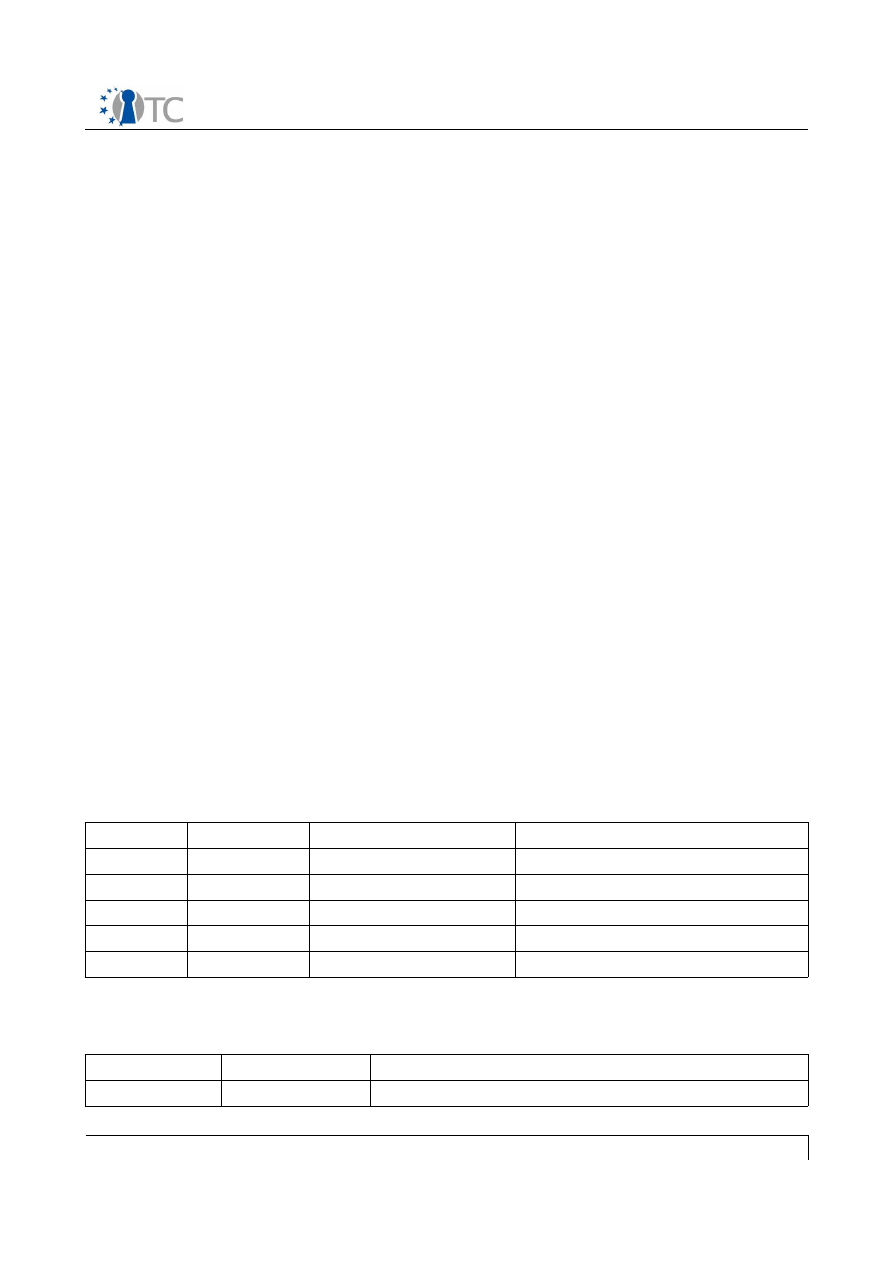
OTC-364: WP06b.3 MEITC Detailed Design and Test Document
implementation
}
●
Standard variable names
Variable names in British English. If a variable name is a combination of several
words then these words are separated by capital letters. For instance: maxInt.
●
Comment language
All comments are written in British English. Shell comments are written clear
and short. No comments are written after the command, and they will be placed
in a new line.
3.5 Database Design
In this documentation a main title (level 1) exists for each table in the database. For
each table; “Fields”, “Referential Integrity Constraints” sub titles (level 2) exists. If
necessary “Indexes” sub titles could be exists in this level (level 2). Before “Fields”
sub titles descriptions about table exists. This descriptions explains table fields and
their usage.
A matrix exists under the “Fields” title. The rows of this matrix contains field
informations and the column of the matrix contains field name, fields type, default
value and descriptions. All field names is defined in the database as given below.
(small/big letter etc. with properties).
MEITC administration screen uses postfixadmin database tables. Postfixadmin
management applicaton works with Postfix mail server with no issues.
3.5.1 Admin table
This table contains administrator user information. This information is used to login
MEITC administration module.
Fields of admin table is defined below.
Name
Type
Default Value
Description
username
varchar(255)
Administrator user name
password
varchar(255)
Administrator password
created
datetime
0000-00-00 00:00:00
Creation time of the record
modified
datetime
0000-00-00 00:00:00
Last update time of the record
active
tinyint(1)
Status of the record
Index of admin table is defined below.
Name
Fields
Description
username
username
To disallow dublicate usernames and allows quick
Internal document
18/50
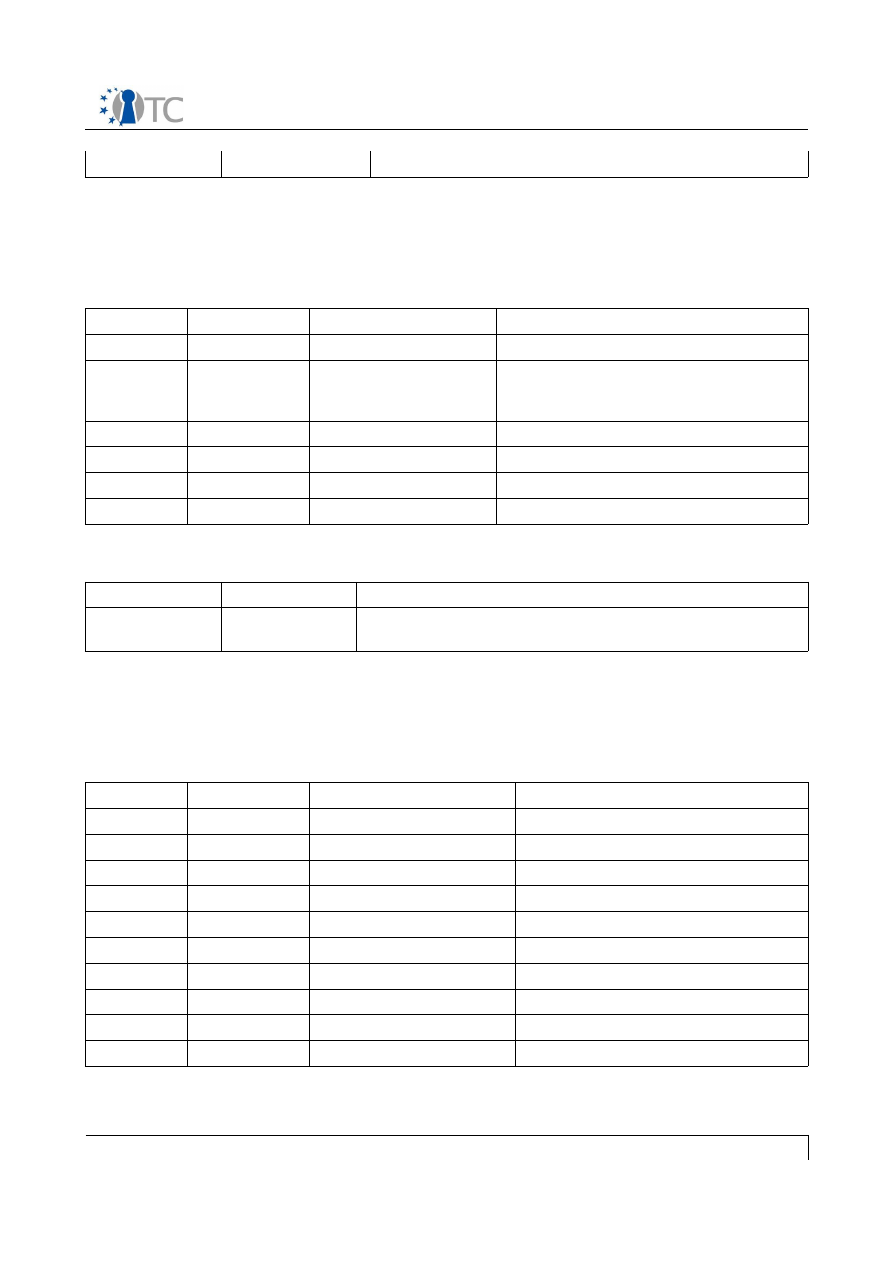
OTC-364: WP06b.3 MEITC Detailed Design and Test Document
access to records
3.5.2 Alias table
Postfix alias information exists in this table. Postfix mail server uses address ve goto
fields. This tables is similar to /etc/aliases file.
Fields of alias table is defined below.
Name
Type
Default Value
Description
address
varchar(255)
Source email address
goto
text
This field is destination email address.
Multiple destination email addresses
need to be separated by a "," (comma).
domain
varchar(255)
Domain name
created
datetime
0000-00-00 00:00:00
Creation time of the record
modified
datetime
0000-00-00 00:00:00
last update time of the record
active
tinyint(1)
1
status of the record
Index of alias table is defined below.
Name
Fields
Description
address
address
To disallow dublicate usernames and allows quick access
to records
3.5.3 domain table
Domain information exists in this table. In this table domain and description fields is
used by postfix mail server.
Fields of domain table is defined below.
Name
Type
Default Value
Description
domain
varchar(255)
domain name
description
varchar(255)
description of the domain name
aliases
int(10)
0
alias quantity
mailboxes
int(10)
0
user account quantity
maxquota
int(10)
0
maximum quota
transport
varchar(255)
backupmx
tinyint(1)
0
created
datetime
0000-00-00 00:00:00
creation time of the record
modified
datetime
0000-00-00 00:00:00
last update time of the record
active
tinyint(1)
1
status of the record
Index table is defined below.
Internal document
19/50
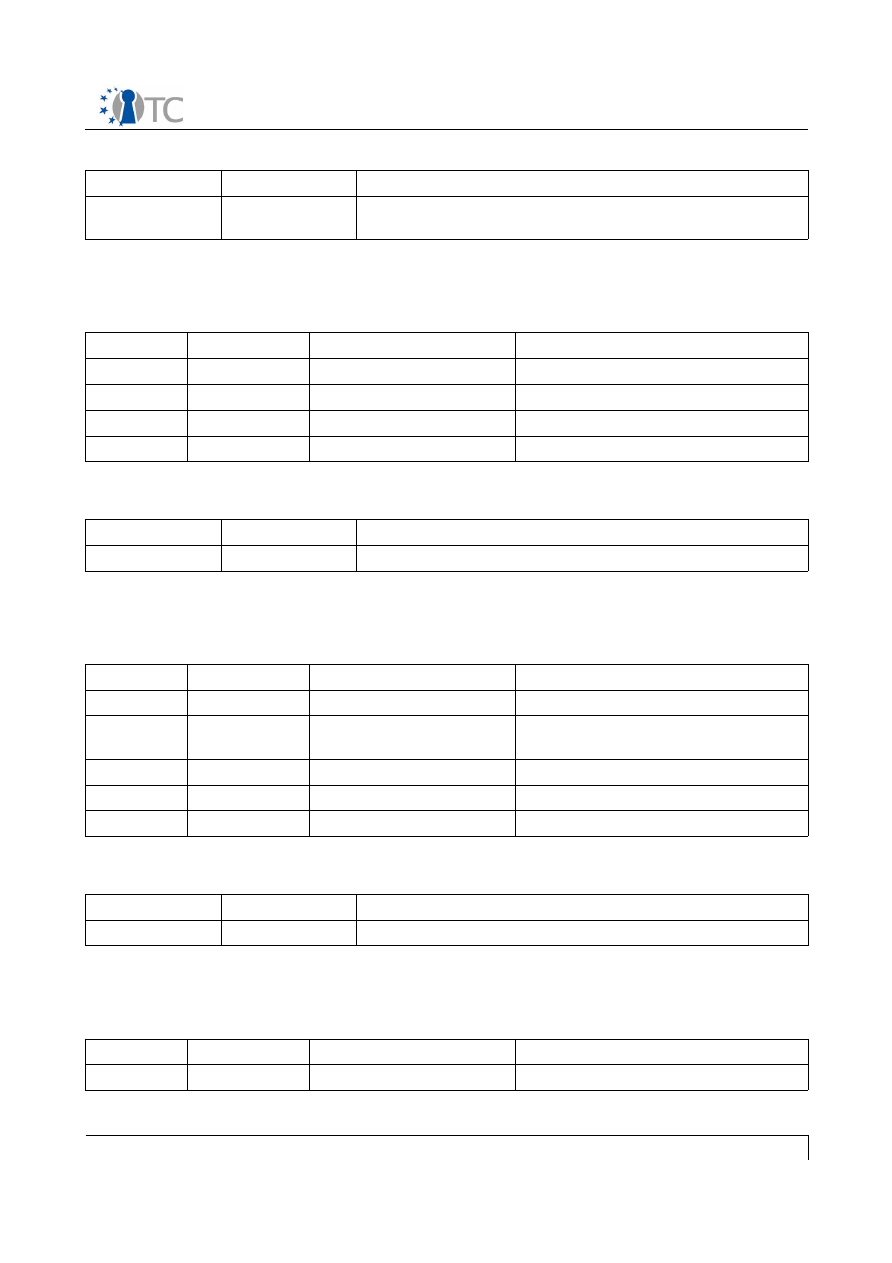
OTC-364: WP06b.3 MEITC Detailed Design and Test Document
Name
Fields
Description
domain
domain
To disallow dublicate usernames and allows quick access
to records
3.5.4 domain_admins table
This table contains domain administration informations. Field table is defined below.
Name
Type
Default Value
Description
username
varchar(255)
domain administration user name
domain
varchar(255)
domain name
created
datetime
0000-00-00 00:00:00
creation time of the record
active
tinyint(1)
status of the record
Index table is defined below.
Name
Fields
Description
username
username
allows quick access to records
3.5.5 Log table
Log information exists in this table. Field table is defined below.
Name
Type
Default Value
Description
timestamp
datetime
0000-00-00 00:00:00
process time
username
varchar(255)
username of the user which made
the process
domain
varchar(255)
domain name
action
varchar(255)
process type
data
varchar(255)
information about process
Index table is defined below.
Name
Fields
Description
timestamp
timestamp
allows quick access to records
3.5.6 mailbox table
Postfix account information exists in this table, also including certificates and keypairs
for users. The following table shows the fields of mailbox table.
Name
Type
Default Value
Description
username
varchar(255)
postfix user name
Internal document
20/50
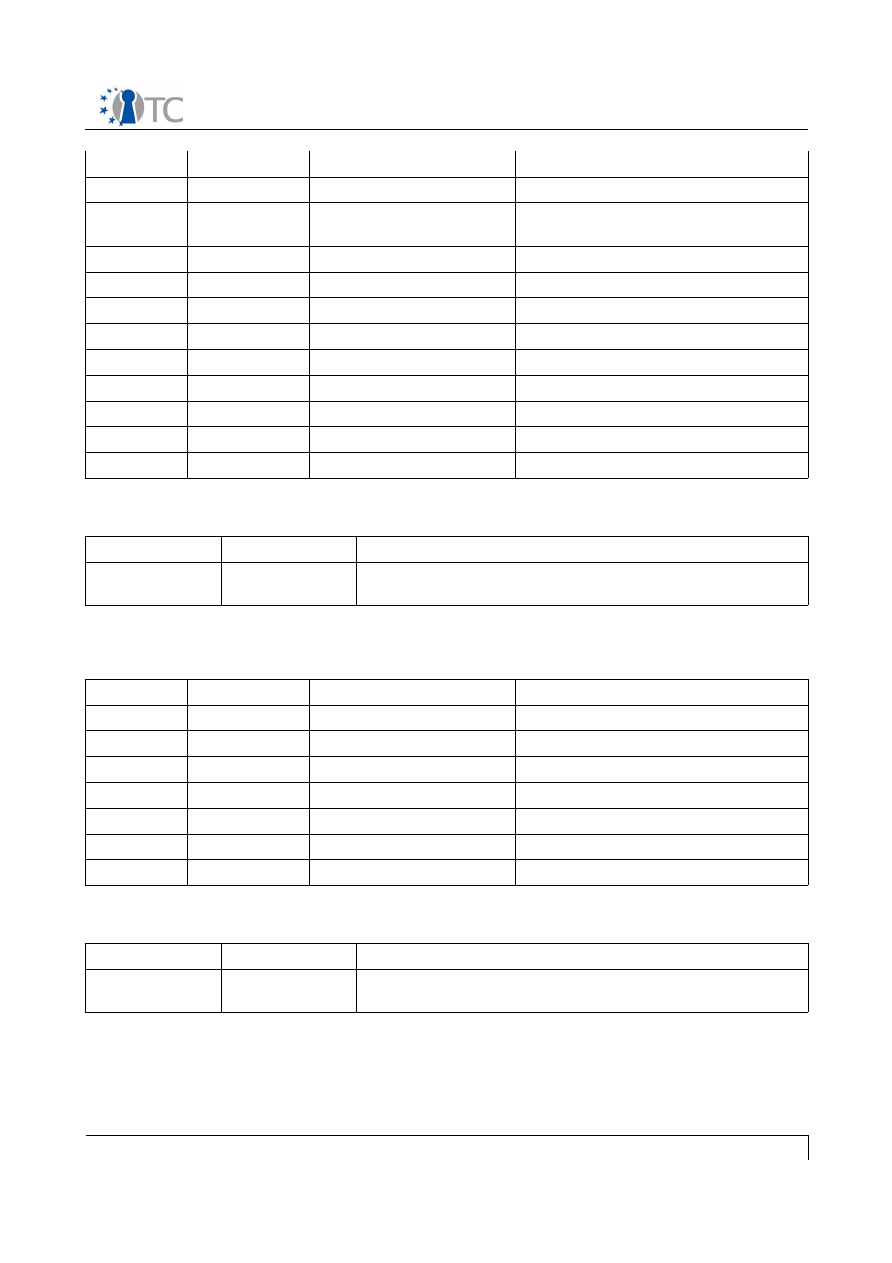
OTC-364: WP06b.3 MEITC Detailed Design and Test Document
password
varchar(255)
postfix user password
name
varchar(255)
real name of the user
maildir
varchar(255)
folder name of the email information
which is saved
quota
int(10)
0
quota information
domain
varchar(255)
domain name
created
datetime
0000-00-00 00:00:00
creation time of the record
modified
datetime
0000-00-00 00:00:00
last update time of the record
active
tinyint(1)
1
status of the record
certreq
text
certificate request
cert
text
certificate of user
publickey
text
public key of user
privatekey
text
private key of user
Following table gives index field.
Name
Fields
Description
username
username
To disallow dublicate usernames and allows quick access
to records
3.5.7 Vacation table
This table keeps a history of days taken for each vacation by the postfix user.
Name
Type
Default Value
Description
email
varchar(255)
e-mail account
subject
varchar(255)
subject of the message
body
text
message content
cache
text
domain
varchar(255)
domain name
created
datetime
0000-00-00 00:00:00
creation time of the record
active
tinyint(1)
1
status of the record
Following table gives index field.
Name
Fields
Description
email
email
To disallow dublicate usernames and allows quick access
to records
3.6 Software development tools
We used Visual Paradigm UML modelling tool for the object-oriented design. In
particular for the drawing of the sequence and class diagrams. For the development of
Internal document
21/50

OTC-364: WP06b.3 MEITC Detailed Design and Test Document
the software Eclipse is used. This tool is the best known and widely used tool for Java
style programming. It consists of a source code editor, java compiler, javadoc
generator, jar builder and with some plugins it is possible to make programming in
widely different programming languages including JSP. For C and bash scripts standard
Linux editors Vi and kate are used.
For our documentation javadoc documents which are generated from the Java source
codes are used. OpenOffice is used for writing requirements and design documents.
4
Design issues
Design issues of MEITC regarding portability, maintainability, extendibility and
reliability has been explained in “WP06b.2 MEITC specification and test plan”. Most
important software system attribute requirements for the MEITC system which will be
developed is localization, defined below.
4.1 Localization
The webmail and the administration pages will have multilingual framework. The
language determination can be done in two ways.
●
Either using the language and locale preferences that are transmitted from the
browser to the server using the HTTP request header field “Accept-Language”.
Since this header is intended primarily for language and cultural preferences.
●
Using the locale determination and localization framework in JSTL.
In our system, we'll go with the second approach. JSTL supports both ways of
determining the user's locale preferences. MEITC webmail and MEITC Admin panel will
specify a fixed locale (usually one that the user has explicitly selected from the list of
supported languages), using JSTL's <fmt:setLocale> action. Once this action is used,
the specified locale is used for all locale-sensitive operations. If the <fmt:setLocale>
action is been used, locale-sensitive operations will search for the first supported
locale from the list of preferred locales provided by the Accept-Language header.
MEITC system is able to show all GUI in English and Turkish, however since a
localization framework is introduced, it's possible to localize the system (user and
admin screens) to other languages to ease communication.
5
Test plan
MEITC test plan will include the following items during the project development phase.
“MEITC Specification and Test Plan” includes a primary test document which is used as
a basis for this plan. It's planned that all tests will start by M30, the time 2
nd
prototype
is ready.
1.
Unit tests:
This will be accomplished by the person who wrote the MEITC
administration screen. In order to find logical design errors, white box testing
will be used.
2.
Module tests:
This testing will be accomplished by all programmers working in
MEITC project. All the modules mentioned in use cases and later in MEITC
detailed design document will be tested. The expected outputs are those which
Internal document
22/50

OTC-364: WP06b.3 MEITC Detailed Design and Test Document
are considered valid during the system's normal operation.
3.
Integration test:
This test will be done after all the MEITC components and
modules are fully tested using unit tests and module tests. All the upper
components (WS, MS, LS, DB) will be combined one by one (i.e incrementally) to
the dom0 and integration tests will be made accordingly.
4.
Usability test:
Since MEITC will be used by humans, functional testing should
be accompanied by usability tests to measure the layout, efficiency and
effectiveness of the user interface. The set of tasks will be identified after the
second prototype in M30 is finished. At the same time the analysis method of
collected data and representative sample of the real user population will be
discussed and finalized.
Internal document
23/50
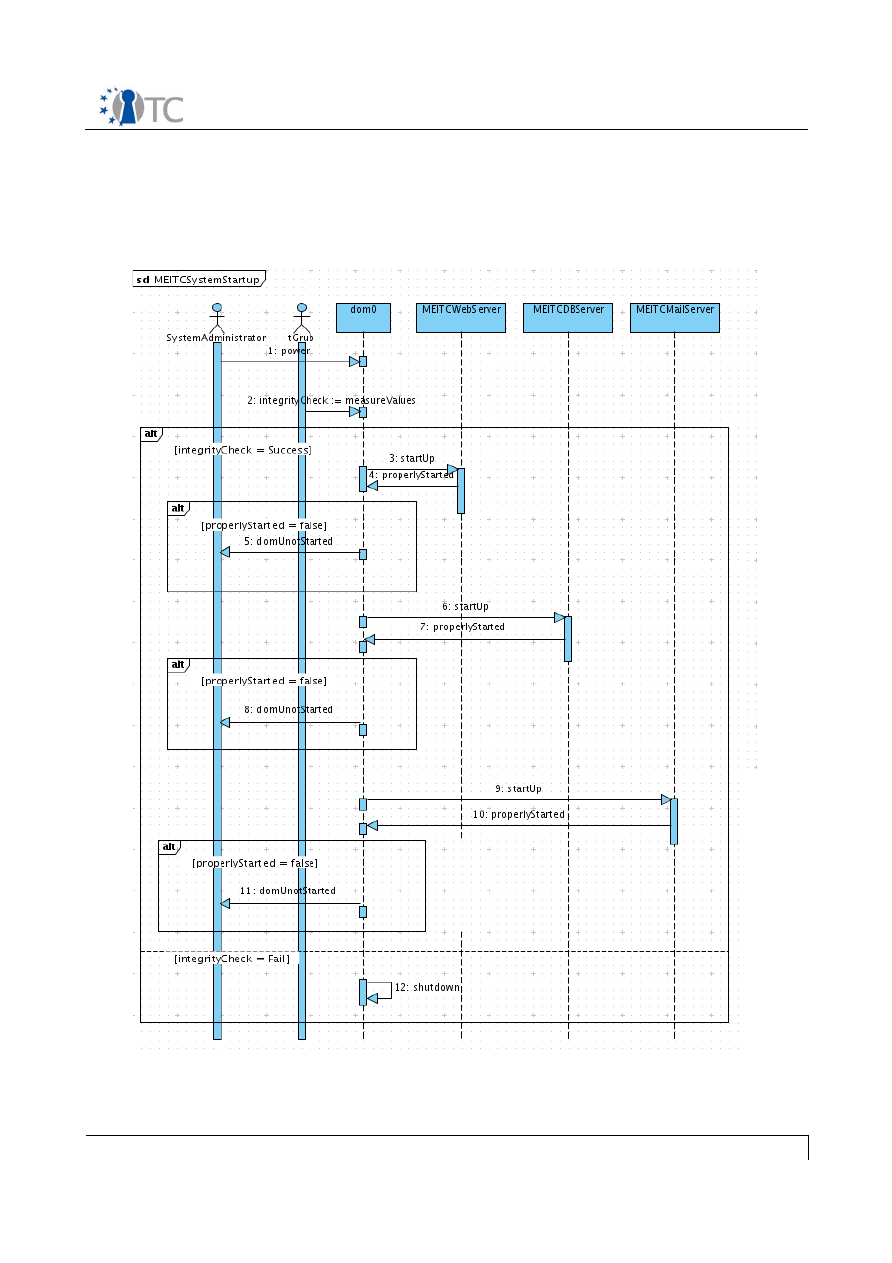
OTC-364: WP06b.3 MEITC Detailed Design and Test Document
6
Sequence diagrams
6.1 MEITC system startup sequence diagram
Internal document
24/50
Figure 2:MEITC system startup sequence diagram
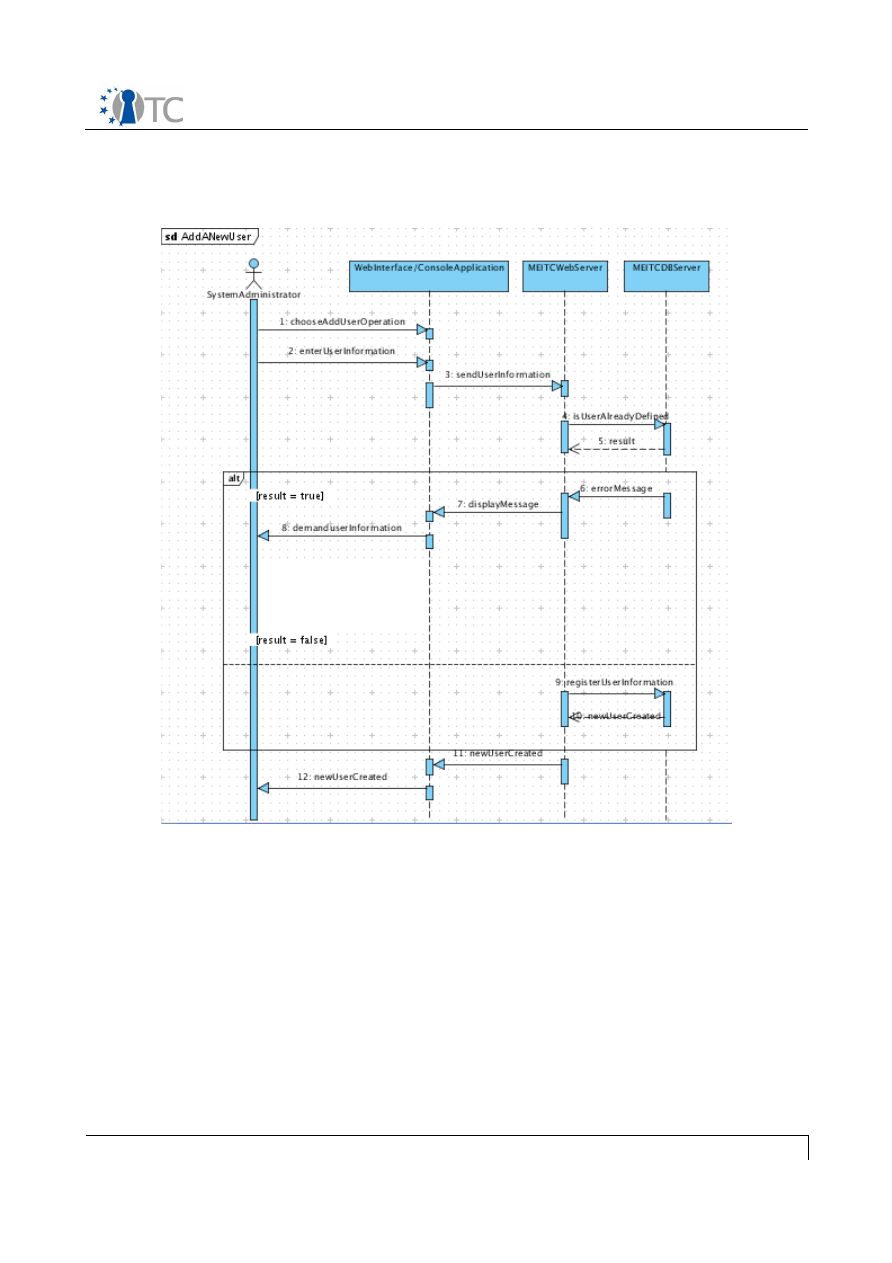
OTC-364: WP06b.3 MEITC Detailed Design and Test Document
6.2 Adding a new user sequence diagram
Internal document
25/50
Figure 3:Adding a new user sequence diagram
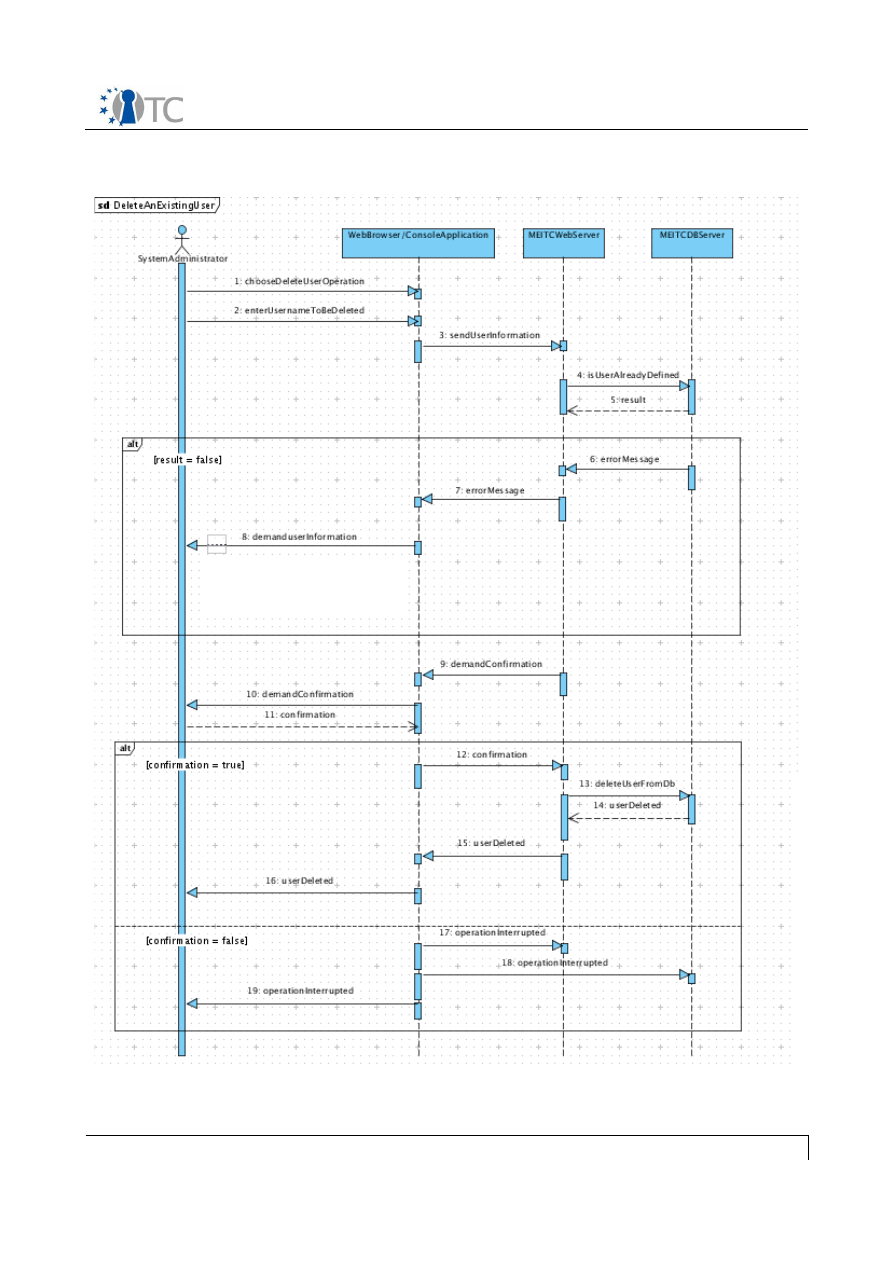
OTC-364: WP06b.3 MEITC Detailed Design and Test Document
6.3 Deleting an existing user sequence diagram
Internal document
26/50
Figure 4:Deleting an existing user sequence diagram
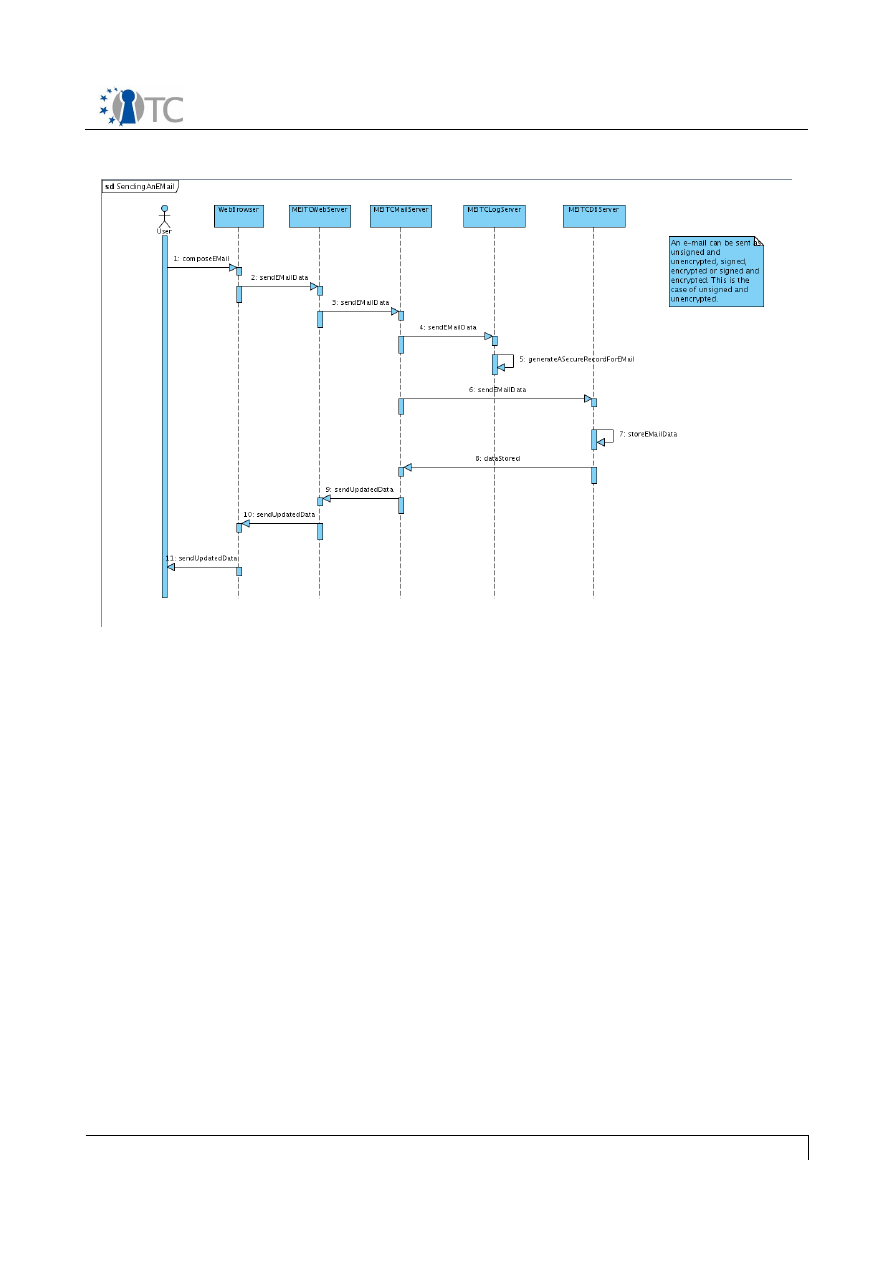
OTC-364: WP06b.3 MEITC Detailed Design and Test Document
6.4 Sending an e-mail sequence diagram
Internal document
27/50
Figure 5:Sending an e-mail sequence diagram
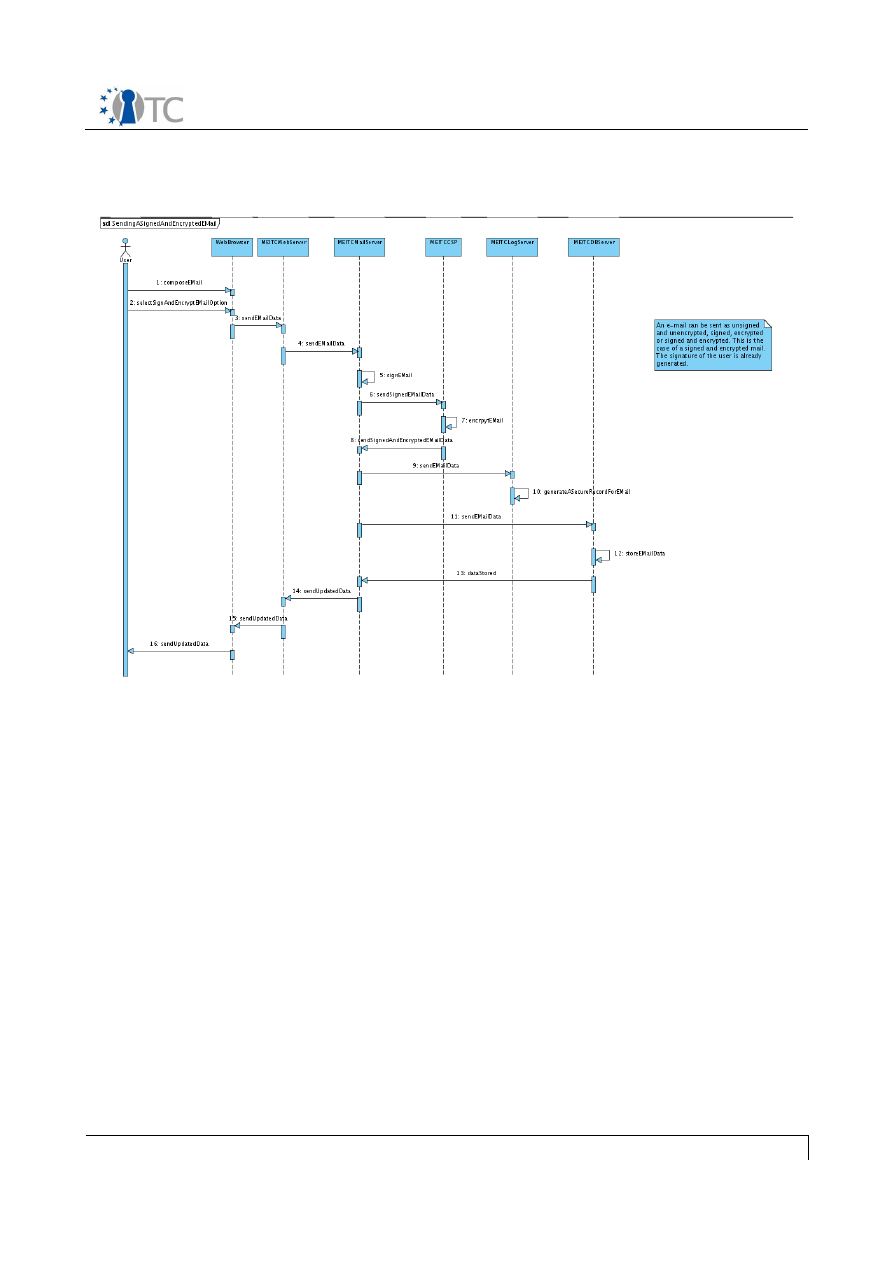
OTC-364: WP06b.3 MEITC Detailed Design and Test Document
6.5 Sending a signed e-mail sequence diagram
Internal document
28/50
Figure 6:Sending a signed e-mail sequence diagram
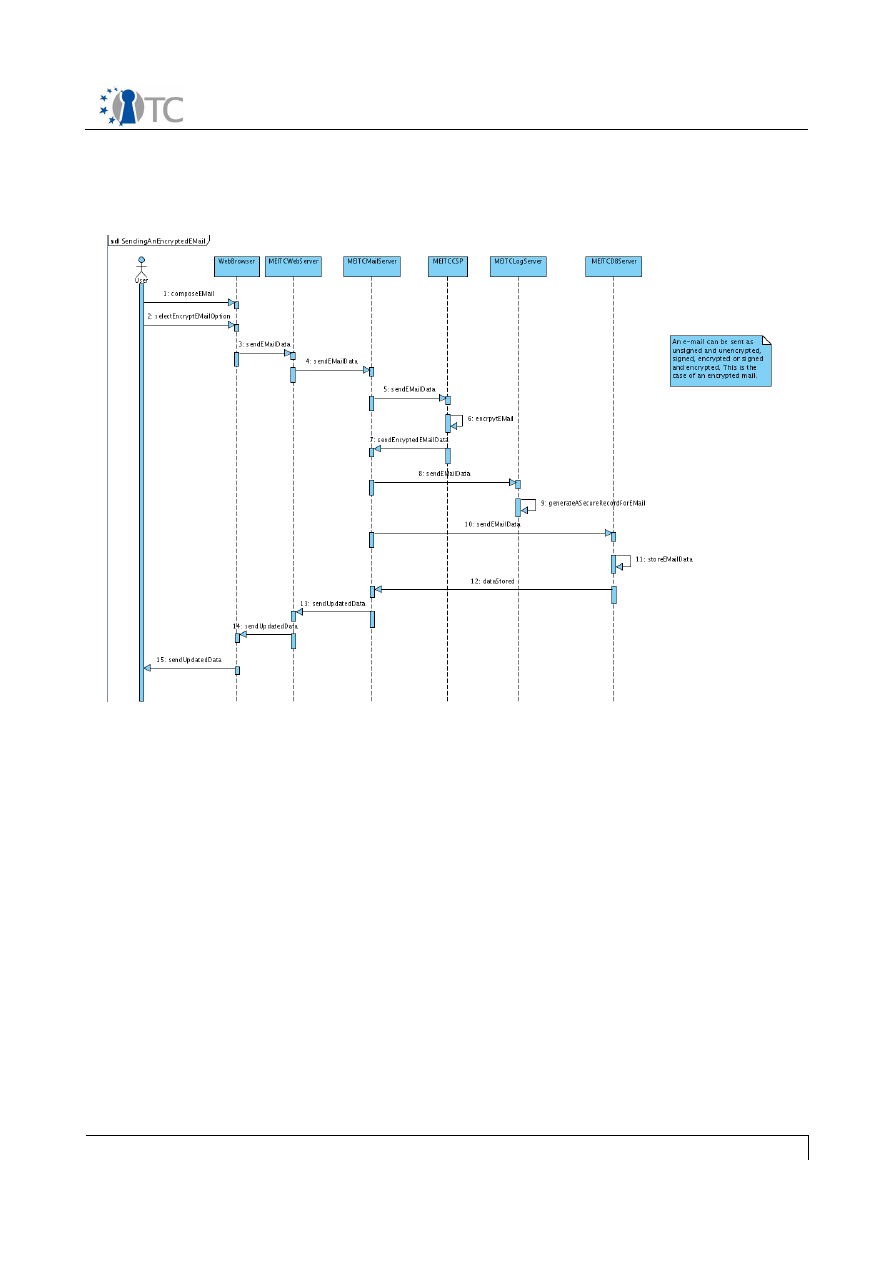
OTC-364: WP06b.3 MEITC Detailed Design and Test Document
6.6 Sending an encrypted e-mail sequence diagram
Internal document
29/50
Figure 7:Sending an encyrpted e-mail sequence diagram
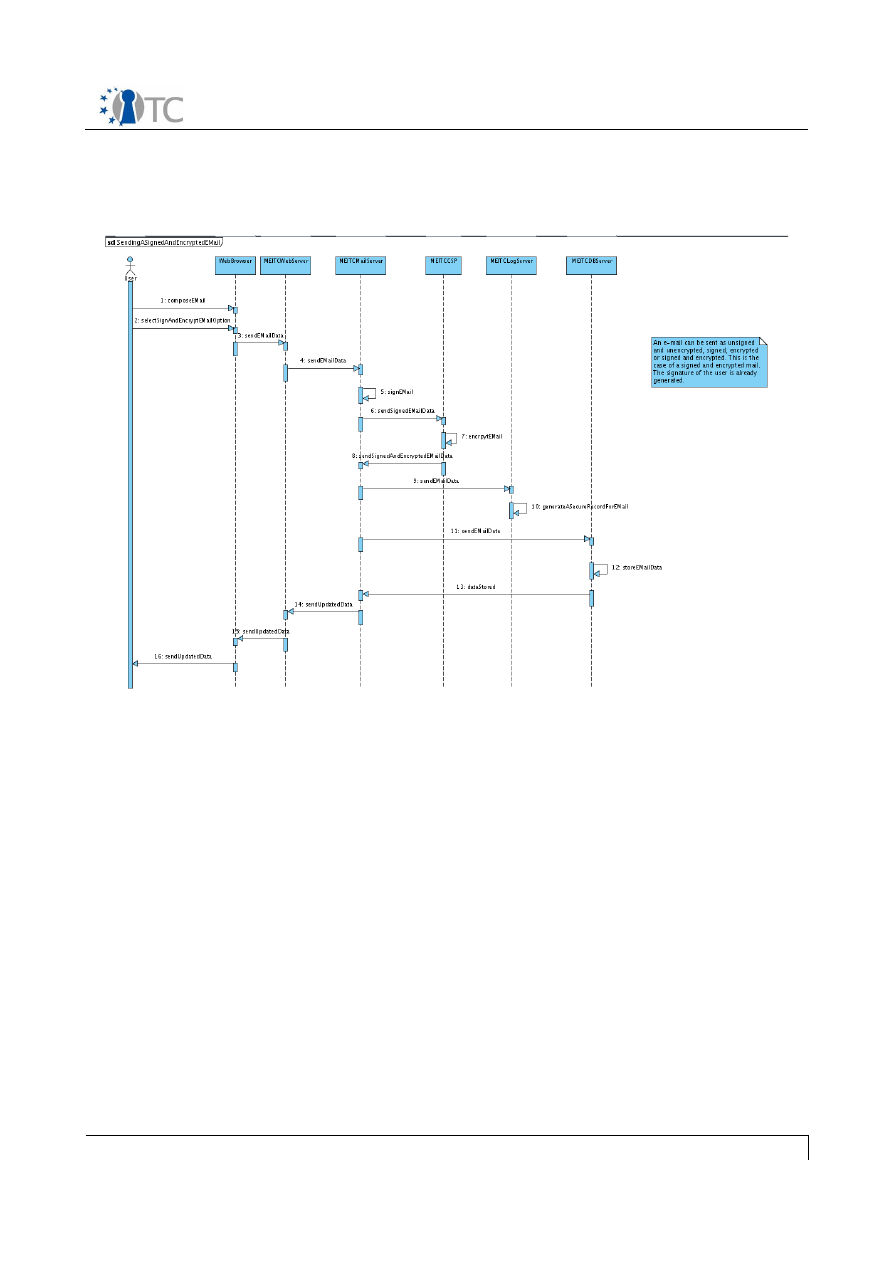
OTC-364: WP06b.3 MEITC Detailed Design and Test Document
6.7 Sending a signed and encrypted e-mail sequence diagram
Internal document
30/50
Figure 8:Sending a signed and encrypted e-mail sequence diagram
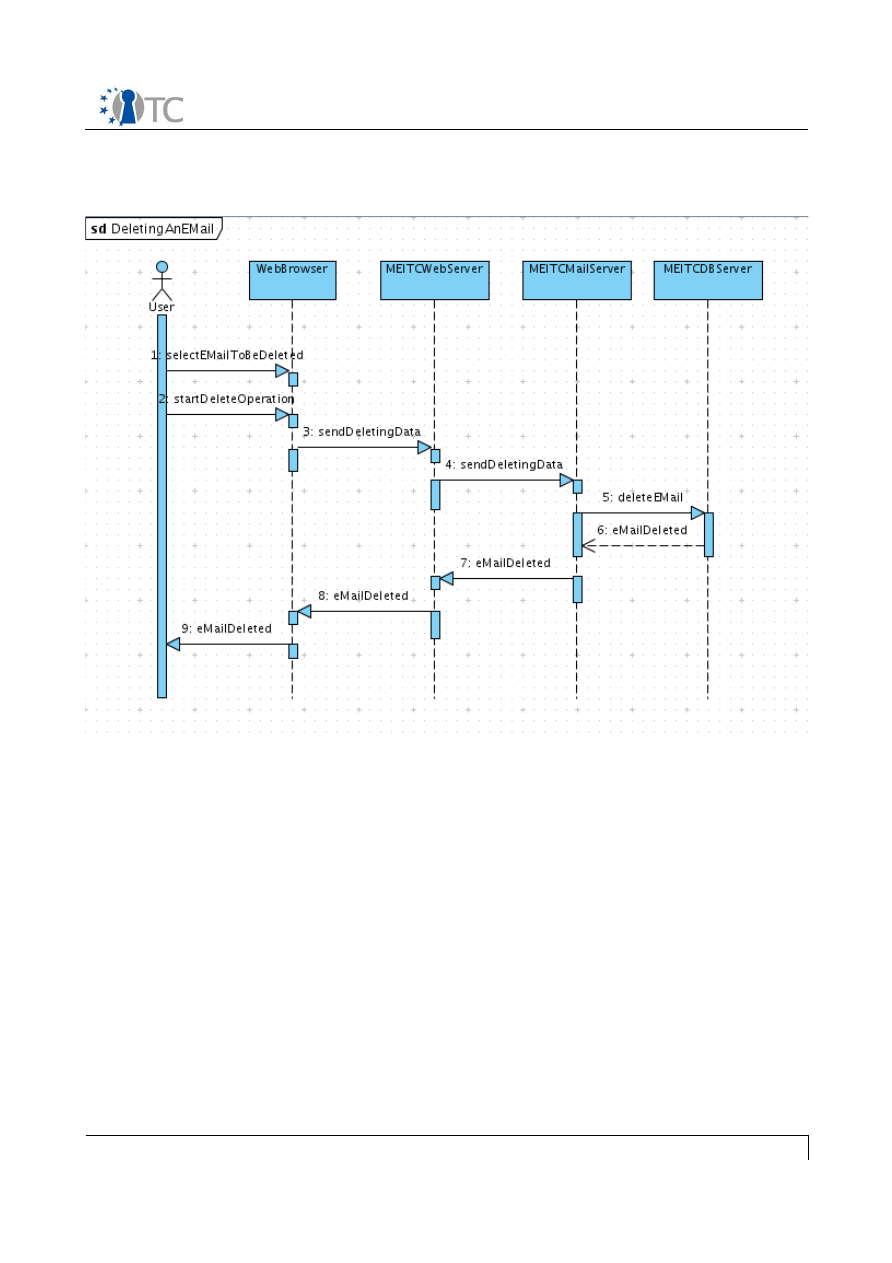
OTC-364: WP06b.3 MEITC Detailed Design and Test Document
6.8 Deleting an e-mail sequence diagram
Internal document
31/50
Figure 9:Deleting an e-mail sequence diagram
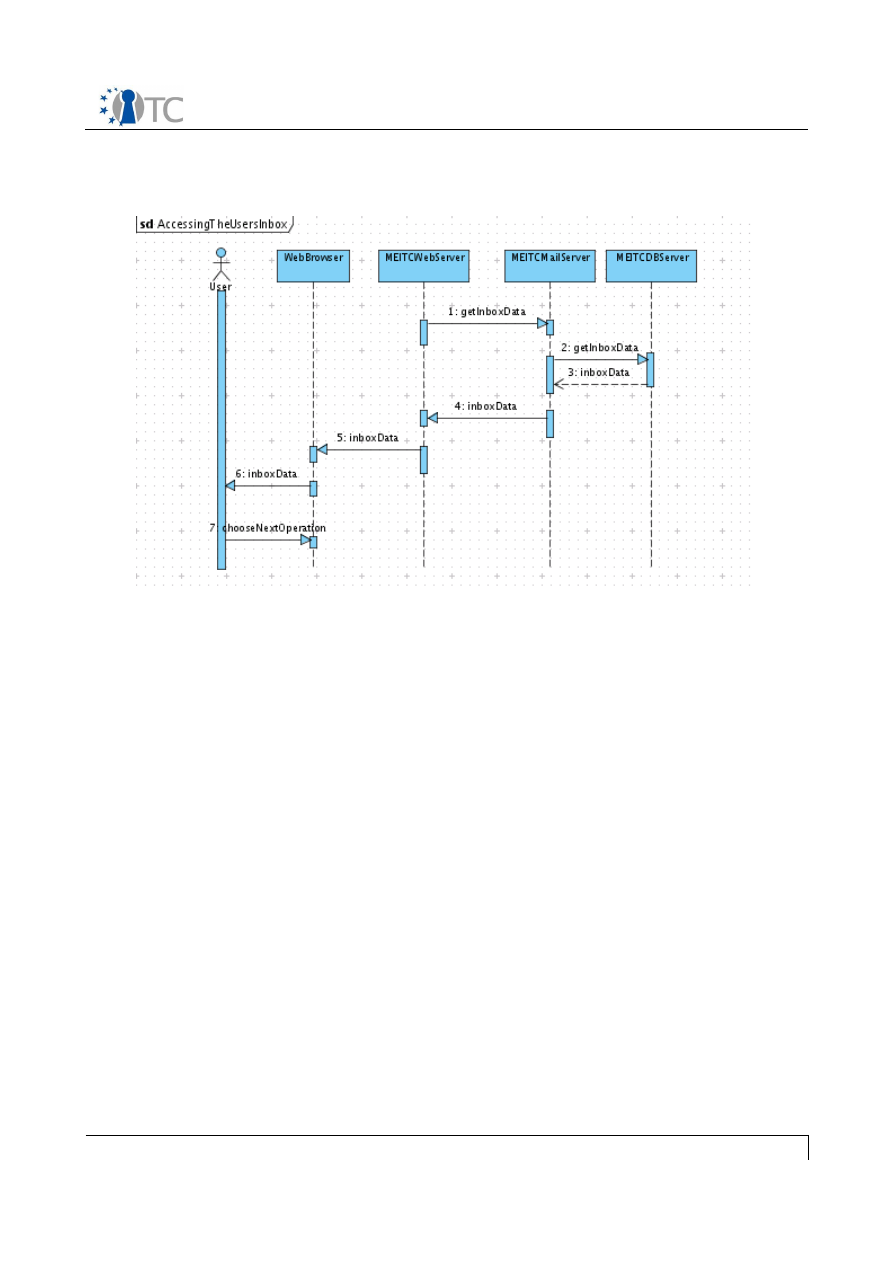
OTC-364: WP06b.3 MEITC Detailed Design and Test Document
6.9 Accessing user's inbox sequence diagram
Internal document
32/50
Figure 10:Accessing user's inbox sequence diagram
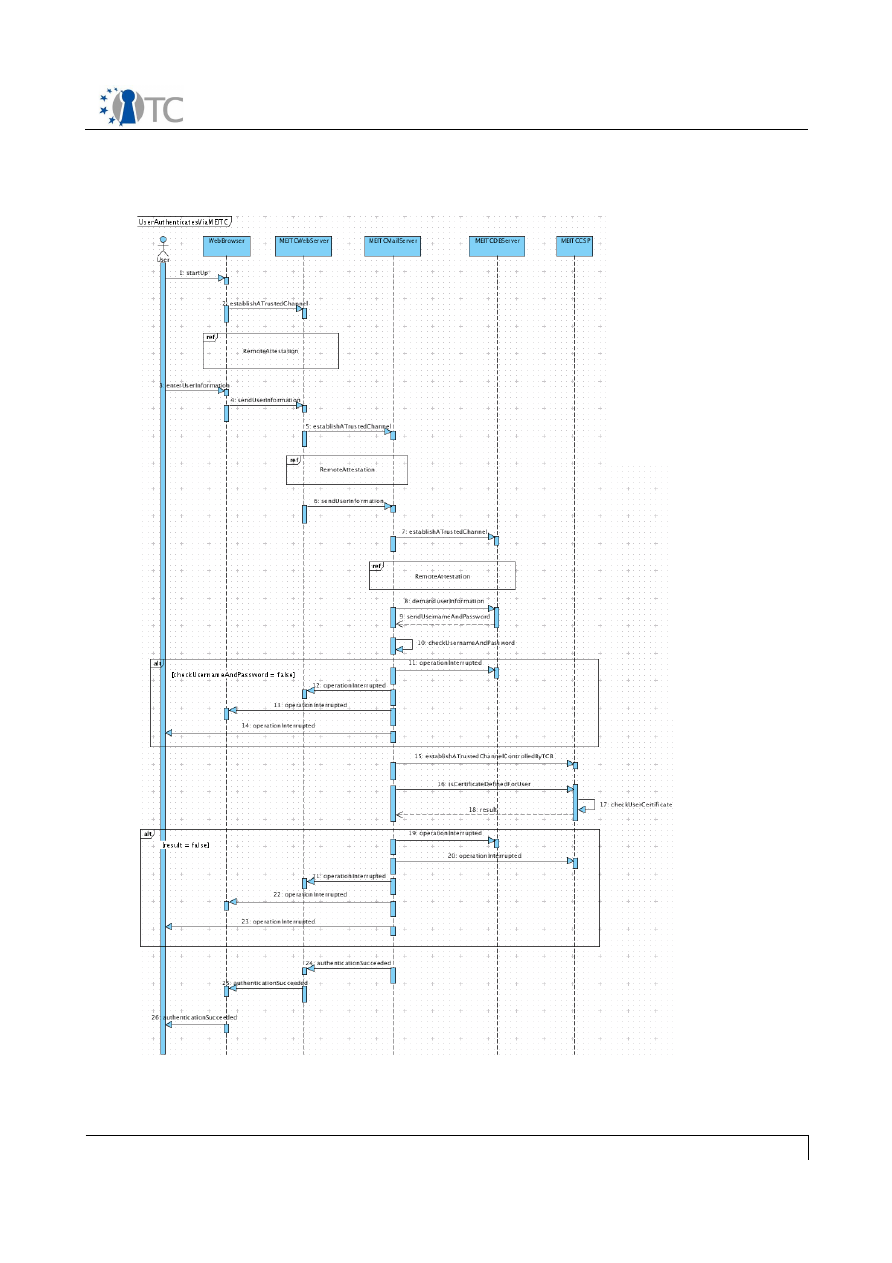
OTC-364: WP06b.3 MEITC Detailed Design and Test Document
6.10 User authenticates via MEITC sequence diagram
Internal document
33/50
Figure 11:User authenticates via MEITC sequence
diagram
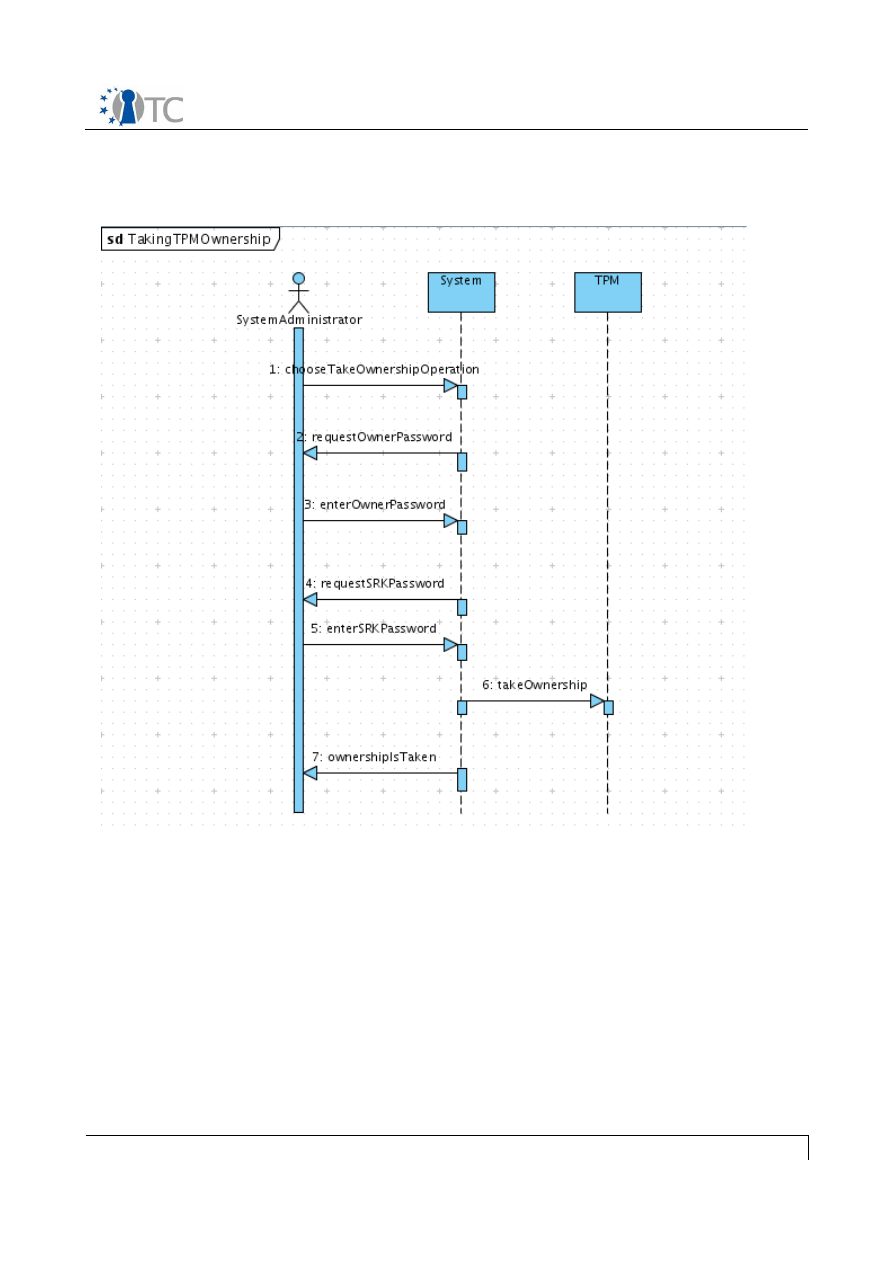
OTC-364: WP06b.3 MEITC Detailed Design and Test Document
6.11 Taking TPM ownership sequence diagram
Internal document
34/50
Figure 12:Taking TPM ownership sequence diagram
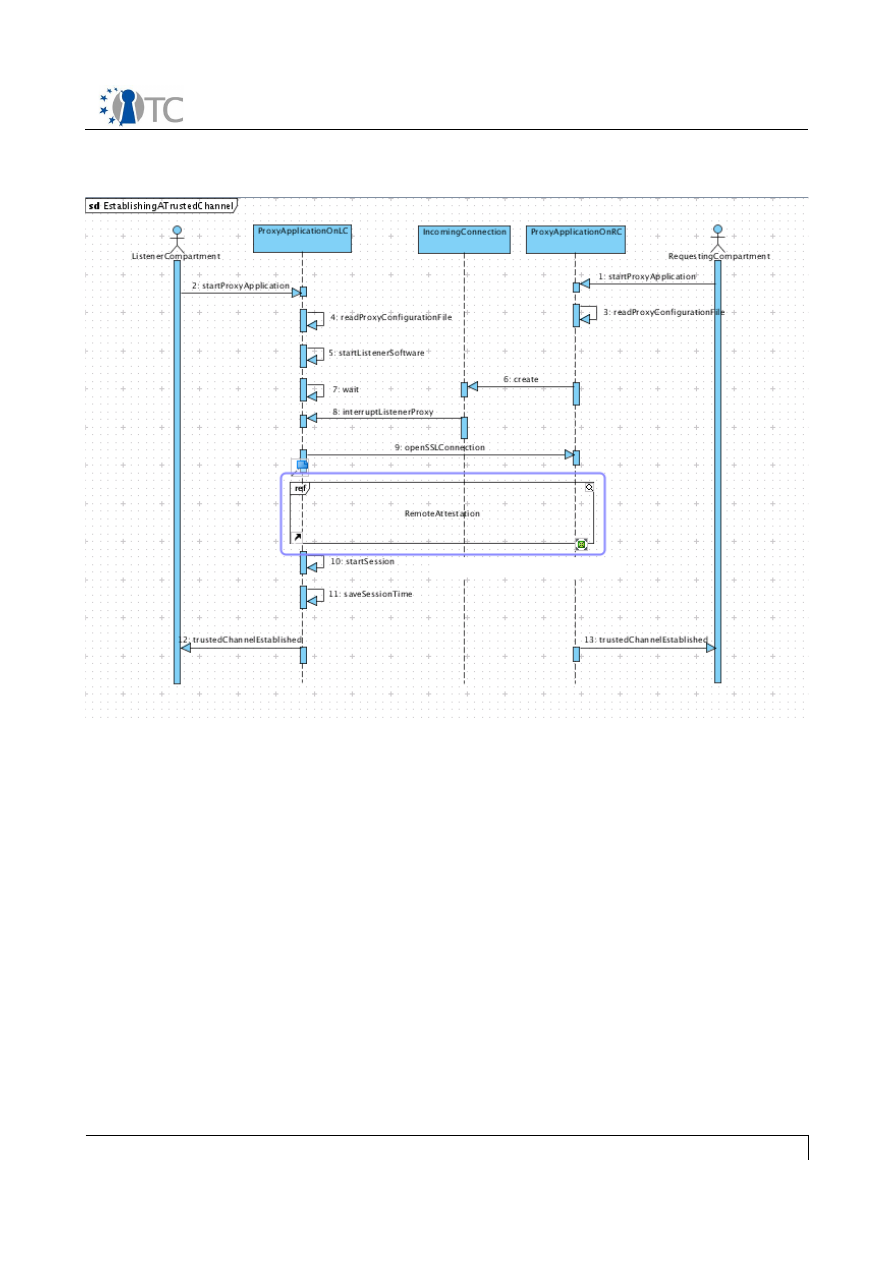
OTC-364: WP06b.3 MEITC Detailed Design and Test Document
6.12 Establishing a trusted channel sequence diagram
Internal document
35/50
Figure 13:Establishing a trusted channel sequence diagram
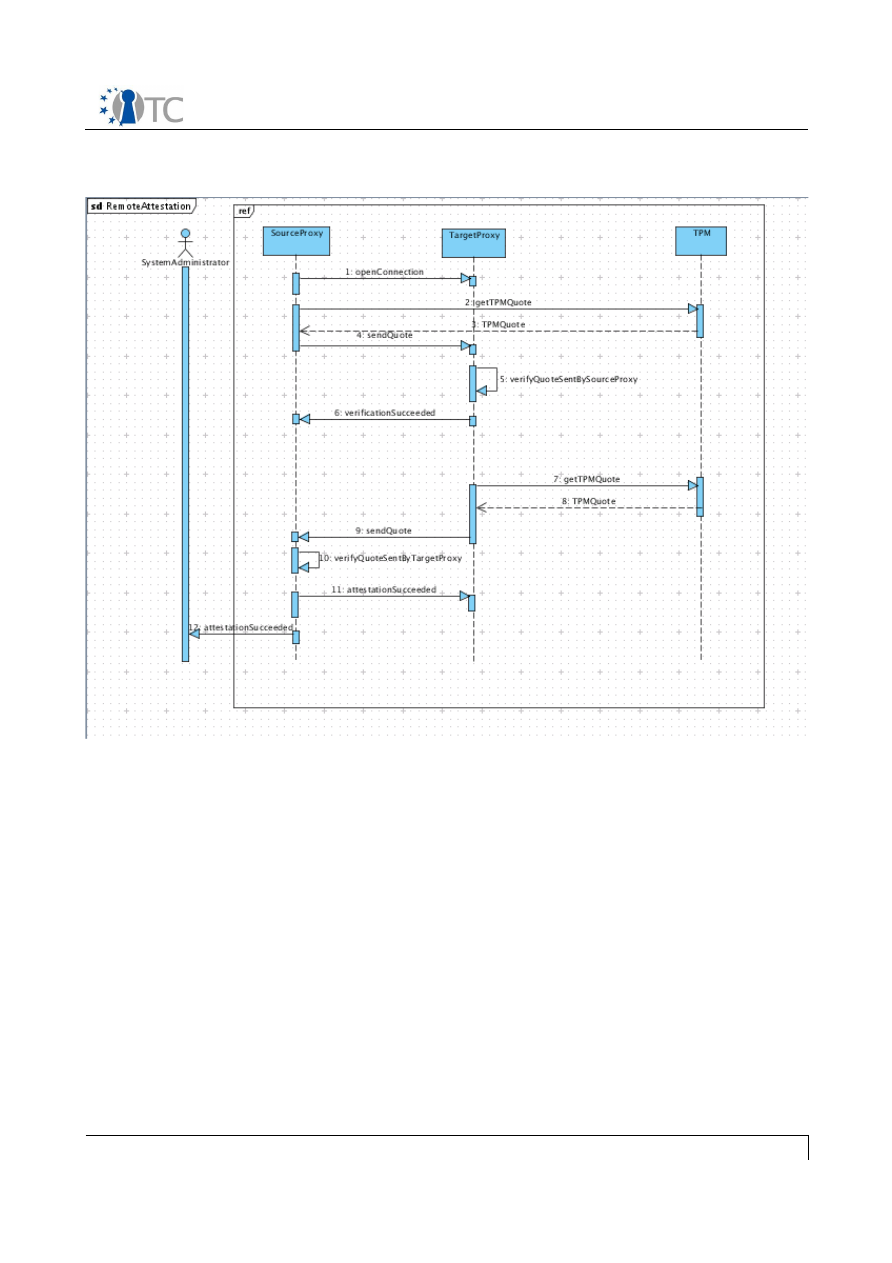
OTC-364: WP06b.3 MEITC Detailed Design and Test Document
6.13 Remote attestation sequence diagram
Internal document
36/50
Figure 14:Remote attestation sequence diagram
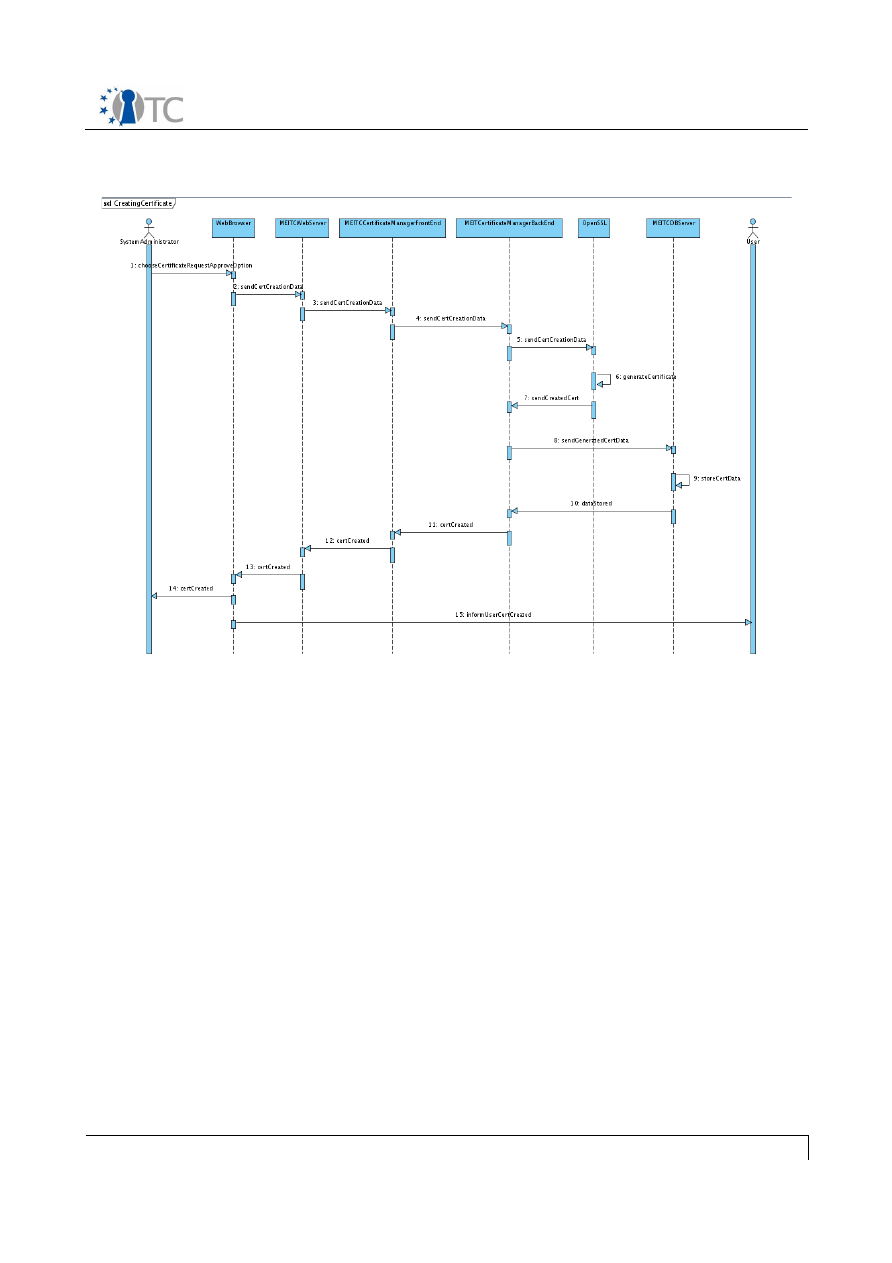
OTC-364: WP06b.3 MEITC Detailed Design and Test Document
6.14 Creating a certificate sequence diagram
Internal document
37/50
Figure 15:Creating a certificate sequence diagram
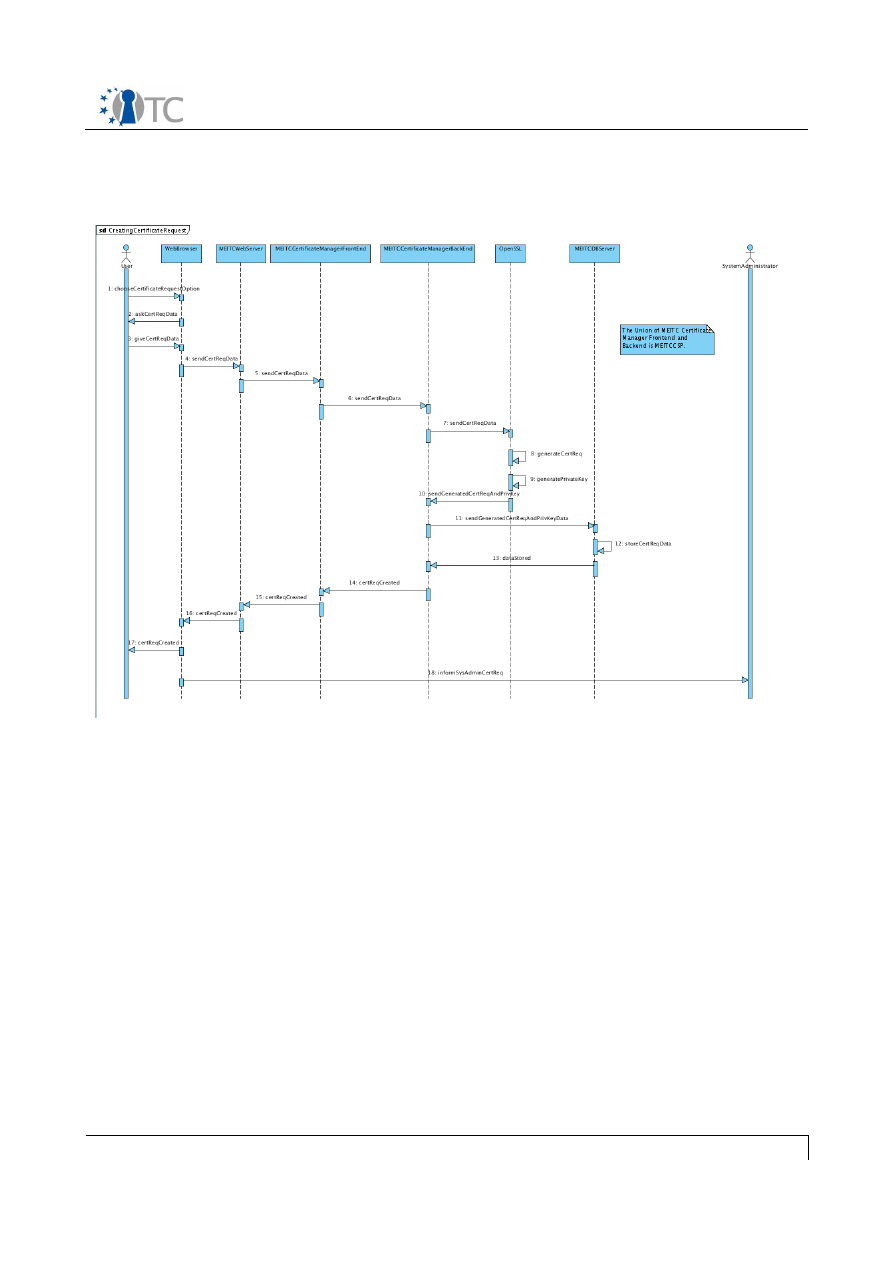
OTC-364: WP06b.3 MEITC Detailed Design and Test Document
6.15 Creating a certificate request sequence diagram
Internal document
38/50
Figure 16:Creating a certificate request sequence diagram
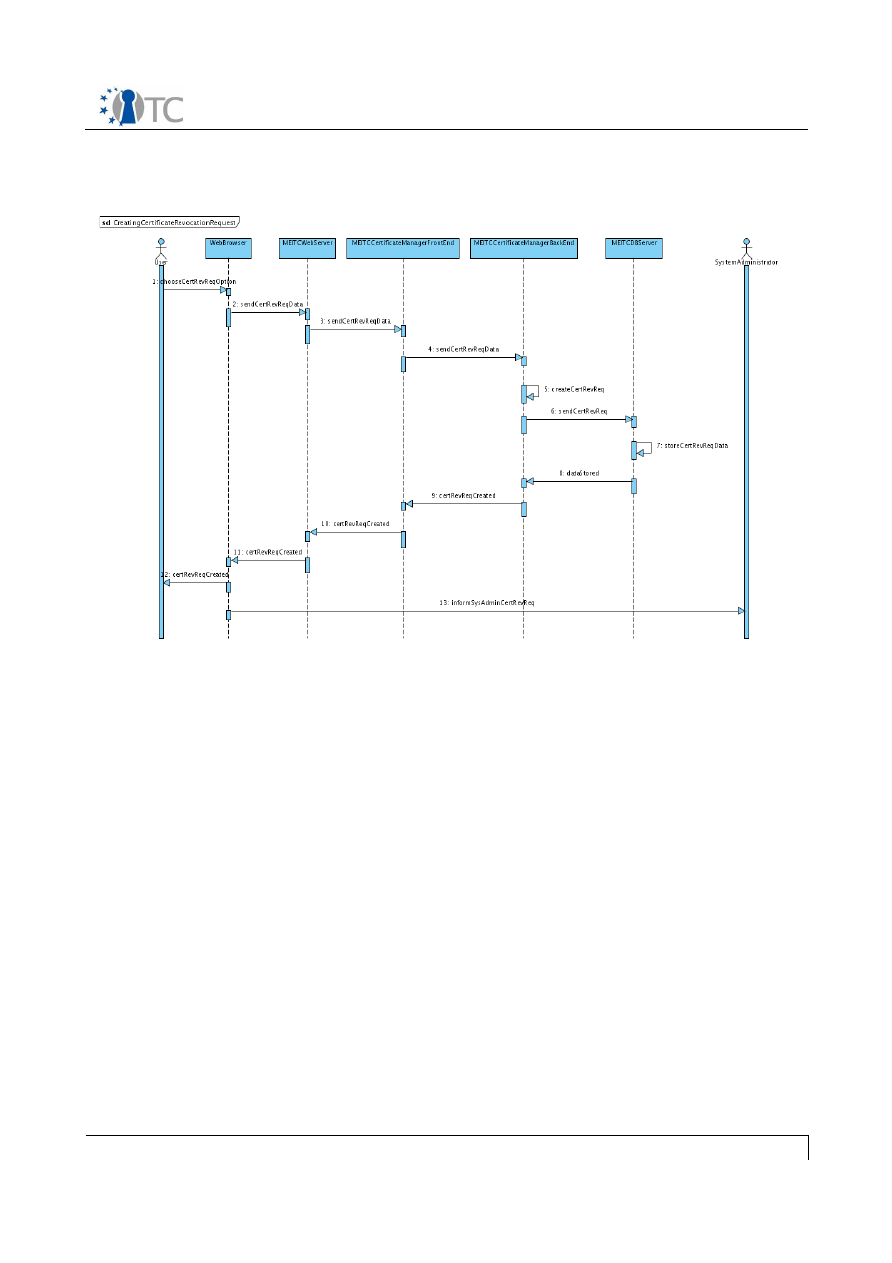
OTC-364: WP06b.3 MEITC Detailed Design and Test Document
6.16 Creating a certificate revocation request sequence diagram
Internal document
39/50
Figure 17:Creating a certificate revocation request sequence diagram
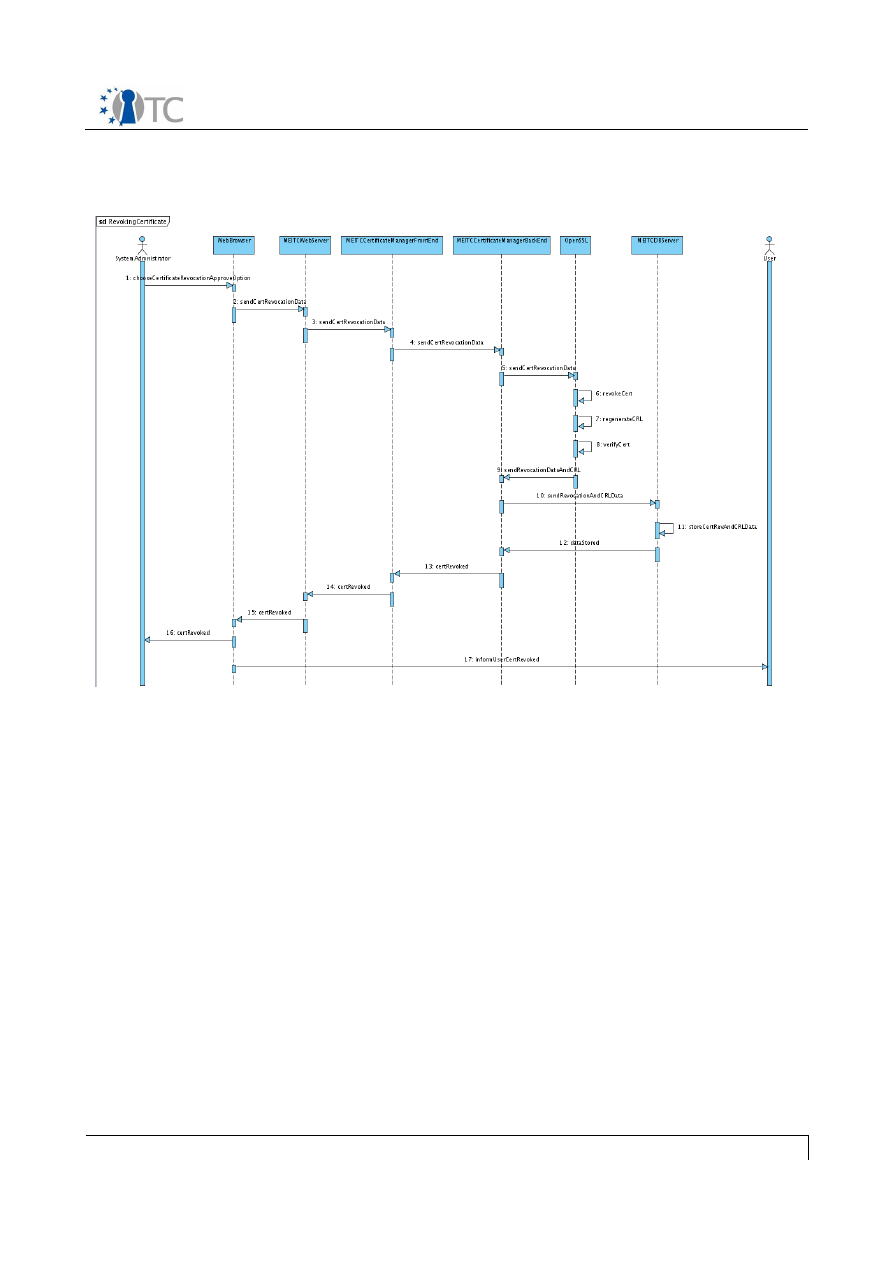
OTC-364: WP06b.3 MEITC Detailed Design and Test Document
6.17 Revoking a certificate sequence diagram
Internal document
40/50
Figure 18:Revoking a certificate sequence diagram
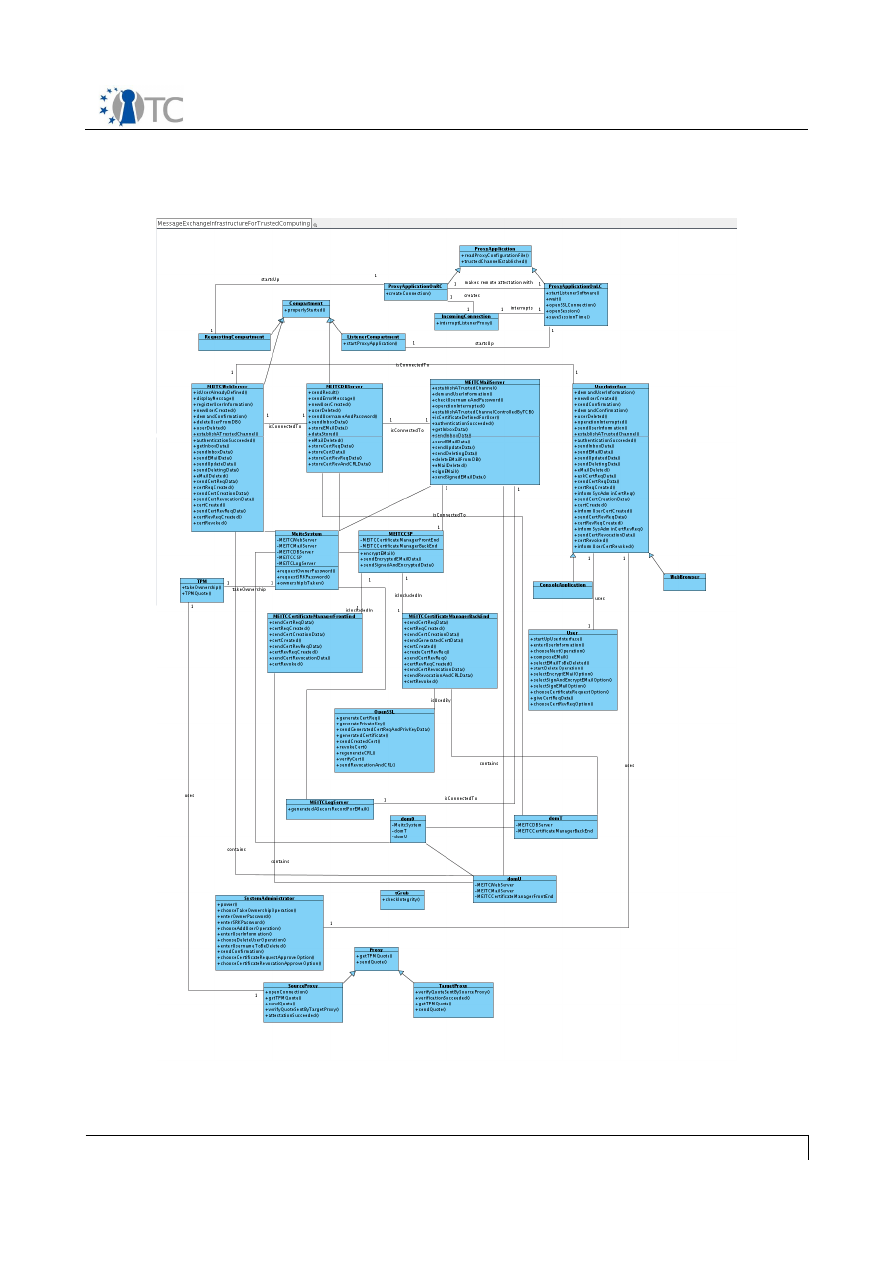
OTC-364: WP06b.3 MEITC Detailed Design and Test Document
7
MEITC All Classes diagram
Internal document
41/50
Figure 19:MEITC all classes diagram

OTC-364: WP06b.3 MEITC Detailed Design and Test Document
8
Installation
This section contains information resolving issues to do with the installation of all parts
of Message Exchange Infrastructure for Trusted Computing (MEITC) system.
8.1 Package structure
In MEITC the following software package structures will be used.
●
RPM (Red Hat Package Manager)
●
PISI (Packages Installed Successfully as Intended)
●
TAR (Tape Archive)
PISI is the package management system of Pardus Linux distribution. It stores and
handles the dependencies for the other packages and libraries in a database in XML
format. Pardus repositories contain Apache, Dovecot, Cyrus-sasl, MySQL, Java
Development Kit and Postfix PISI packages, which are necessary for proper running of
MEITC system.
RPM is a powerful command line driven package management system capable of
installing, uninstalling, verifying, querying, and updating computer software packages.
RPM is a core component of many Linux distributions, such as Red Hat, Fedora, SUSE,
Mandriva and many others. All MEITC software components will be available in RPM
file format.
Tar archive is the most common means of distributing bundles of files. This format is
traditionally produced by the Unix tar command
. Necessary software packages
for
MEITC framework will also be prepared in tar file format. After installing a tar
package, some modifications may be needed to run software packages properly.
8.2 File and directory structure
The following MEITC components file and directory structures are explained in this
section:
●
Web Server
●
Mail Server
●
Database Server
The symbolic name "$PREFIX" is used to refer to the full pathname of the release
directory of installed software.
8.2.1 Web Server
For the message exchange infrastructure on the web server part, the following
softwares should be up and running
●
Apache Web Server: Version 2.0.3 or more
●
Java 2 Standard Edition Runtime Environment (JRE)
●
Apache Tomcat: Version 5.5
●
Claros: Version 1.7
Apache web server is used for the incoming connections to the web server. Apache
Internal document
42/50

OTC-364: WP06b.3 MEITC Detailed Design and Test Document
will redirect the requests via JSP to the mail server, where a Postfix system is installed.
Apache HTML files are located in the following folders:
●
/var/www/localhost/htdocs (Pardus)
●
/srv/www/htdocs/ (openSUSE)
Apache configuration file is located in the following locations:
●
/etc/apache2/httpd.conf (Pardus)
●
/usr/local/apache2/conf/httpd.conf (OpenSUSE)
By default, Apache uses port 80, and Tomcat uses 8080. These settings can be
changed in the configuration files.
Apache Tomcat 5.5 requires the Java 2 Standard Edition Runtime Environment (JRE)
version 5.0 or later. The following directories will be used for JRE.
●
/opt/sun-jdk/bin: Executables for all the development tools contained in the JDK.
The $PATH environment variable will contain an entry for this directory.
●
/opt/sun-jdk/demo: Examples, with source code that shows how to program for
the Java platform.
●
/opt/sun-jdk/include: C-language header files that support native-code
programming using the Java Native Interface and the Java Virtual Machine
Debugger Interface.
●
/opt/sun-jdk/jre: Root directory of the Java runtime environment used by the JDK
development tools.
●
/opt/sun-jdk/lib: Files used by the development tools. Includes tools.jar, which
contains non-core classes for support of the tools and utilities in the JDK.
●
/opt/sun-jdk/man : Contains man pages for the JDK tools.
These are some of the key apache tomcat directories
●
$PREFIX/bin – Startup (startup.sh ), shutdown (shutdown.sh) and other scripts.
●
$PREFIX/conf - Server configuration files (including server.xml).
●
$PREFIX/logs - Log and output files
●
$PREFIX/shared - For classes and resources that must be shared across all web
applications
●
$PREFIX/webapps - Automatically loaded web applications
●
$PREFIX/work - Temporary working directories for web applications
●
/tmp - Directory used by the JVM for temporary files (java.io.tmpdir)
Claros files are located in $PREFIX/webapps/claros. Claros contains the following
directories:
Internal document
43/50

OTC-364: WP06b.3 MEITC Detailed Design and Test Document
●
$PREFIX
/webapps/claros/WEB-INF/config/config.xml
file can be used to
change main configurations.
PREFIX
is the real path to the Tomcat installation.
8.2.2 Mail Server
The mail server is used to handle the incoming and outgoing mails. Mail server runs
postfix and dovecot to answer POP3/IMAP connections and contains following software:
●
Postfix
●
Dovecot
●
Cyrus-sasl
Postfix files are located in /etc/postfix directory. In this directory, settings for MySQL
are defined in order to store users' mailboxes properly in
database. /etc/postfix/main.cf file is used for main Postfix configuration.
Dovecot is used for handling POP3/IMAP connections for Postfix. The incoming
connections and requests for connecting users' mailboxes are redirected to cyrus-sasl
for encyrpted connection. Dovecot's files is located in the following folder:
●
/etc/dovecot
/etc/dovecot/dovecot.cf file is used for configuration.
8.2.3 Database Server
Database server holds the users' mailboxes and informations. It contains following
software packages.
●
Mysql
MySQL’s files is located in the following folders:
●
/etc/mysql : my.cf and mysqlaccess.cf is used for configuration.
●
/var/log/mysql/ : Log files for mysql which is mysql.err, mysql.log and mysqld.err
is located in this path.
9
Graphical user interface
9.1 Webmail GUI
Internal document
44/50
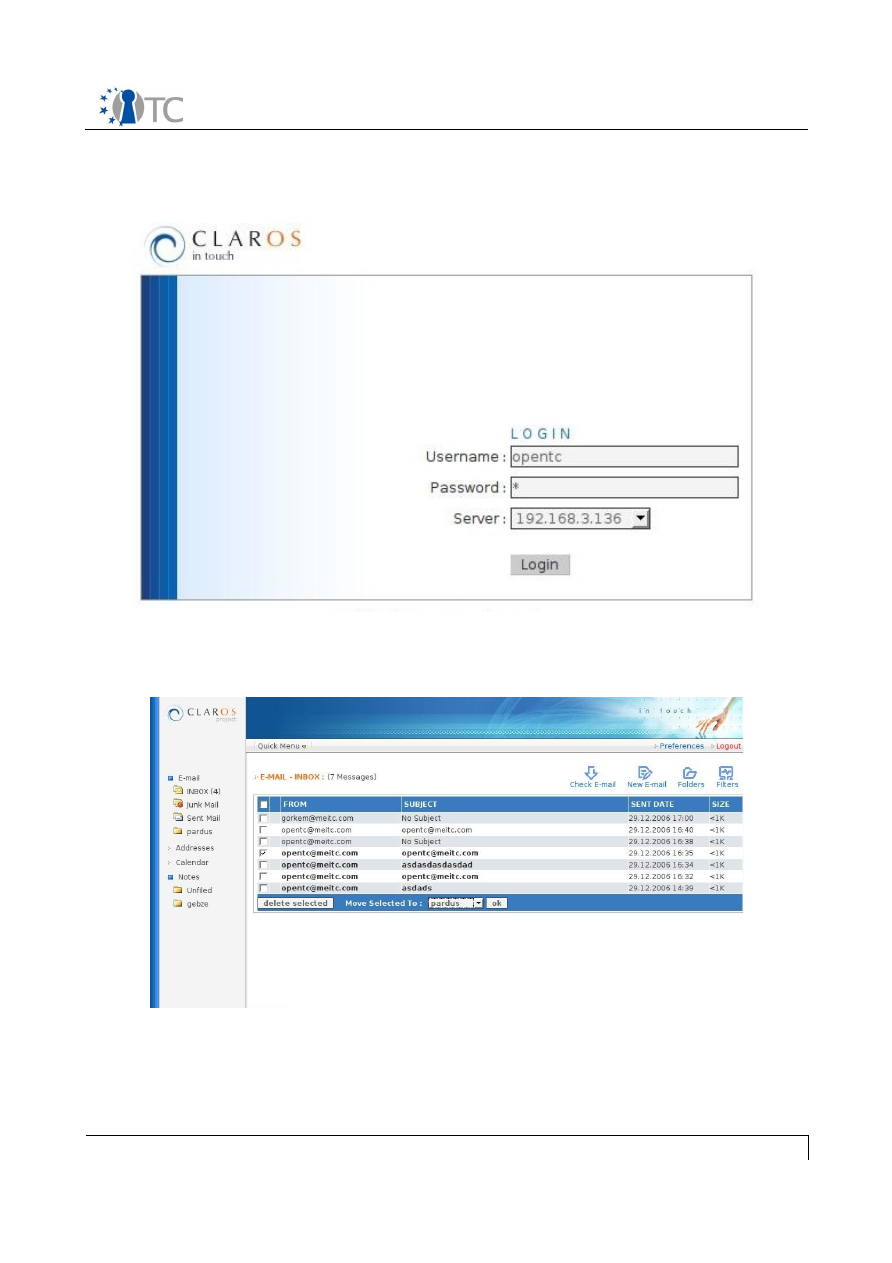
OTC-364: WP06b.3 MEITC Detailed Design and Test Document
9.1.1 User Login Screen
9.1.2 Inbox Screen
Internal document
45/50
Figure 20:User login screen
Figure 21:Inbox screen
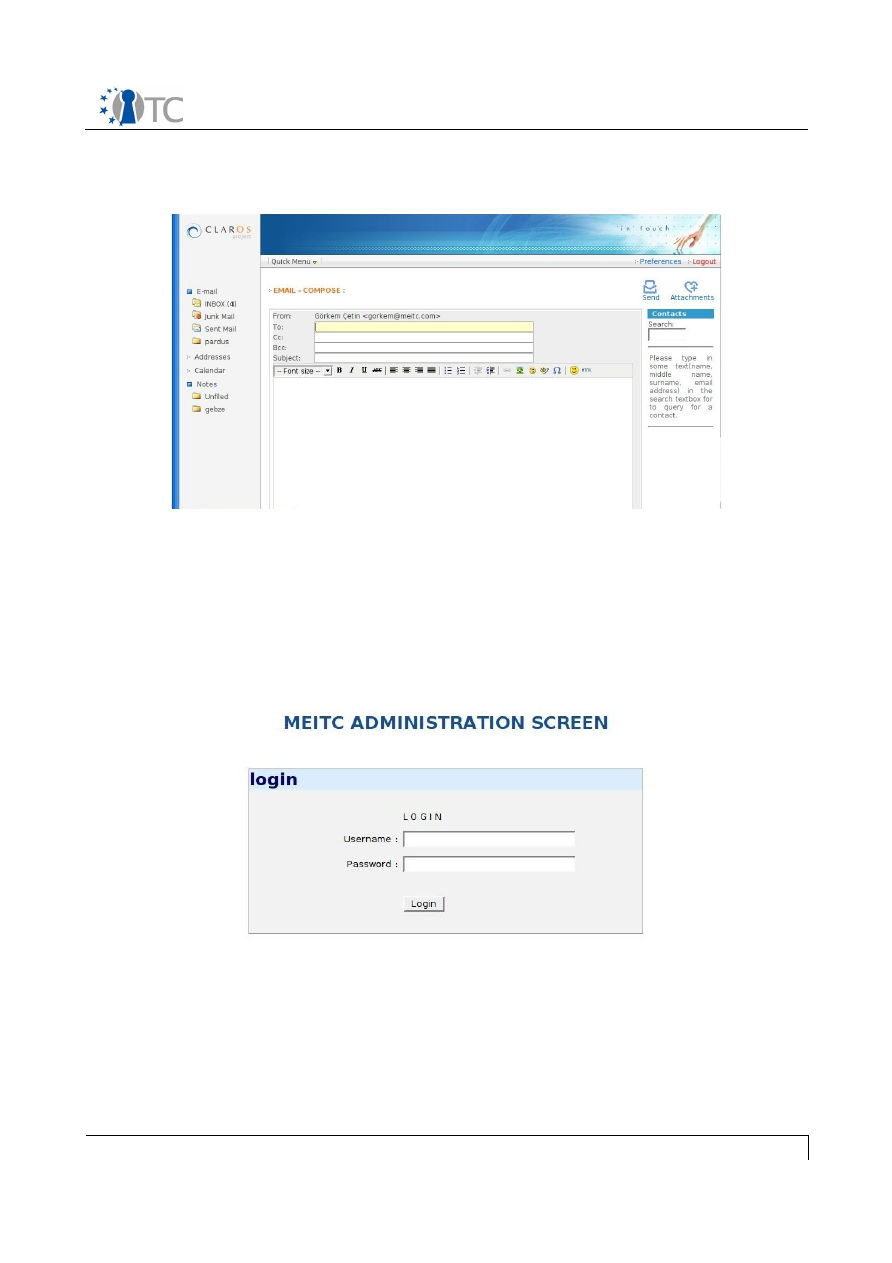
OTC-364: WP06b.3 MEITC Detailed Design and Test Document
9.1.3 Compose Email Screen
9.2 Admin GUI
9.2.1 Admin Login screen
Internal document
46/50
Figure 22:Compose email screen
Figure 23:Admin Login screen
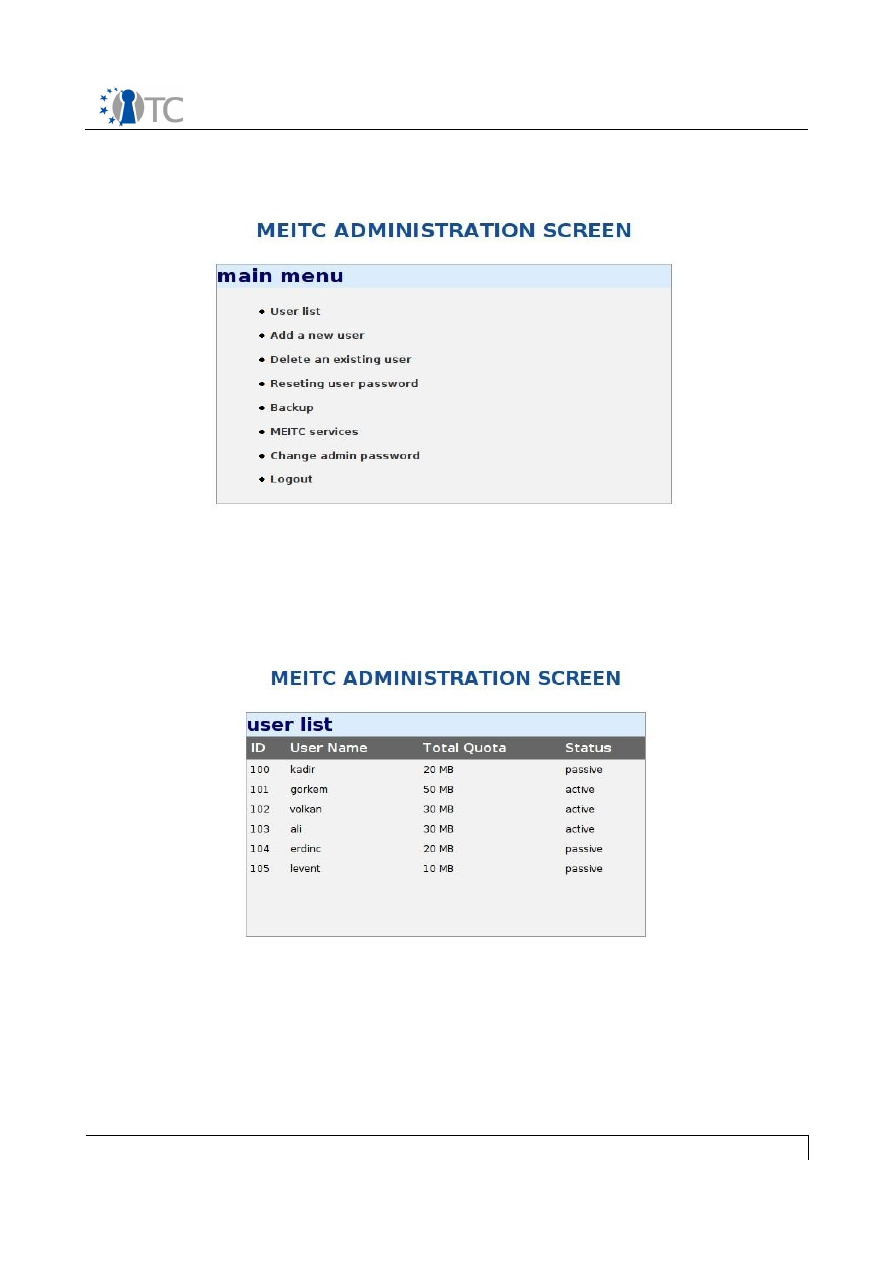
OTC-364: WP06b.3 MEITC Detailed Design and Test Document
9.2.2 Main menu screen
9.2.3 User list screen
9.2.4 Add user screen
Internal document
47/50
Figure 24:Main menu screen
Figure 25:User list screen
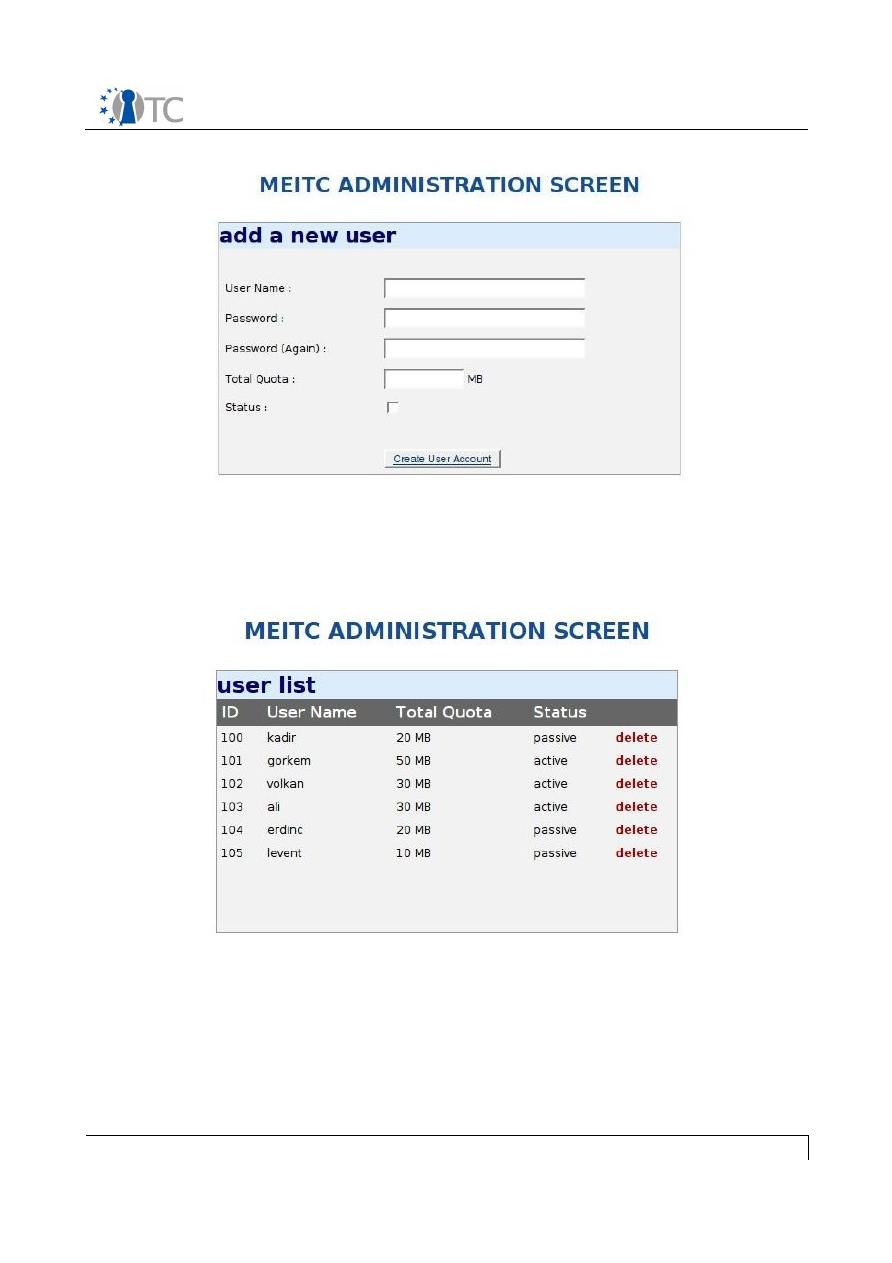
OTC-364: WP06b.3 MEITC Detailed Design and Test Document
9.2.5 Delete user list screen
9.2.6 Delete user screen
Internal document
48/50
Figure 26:Add user screen
Figure 27:Delete user list screen
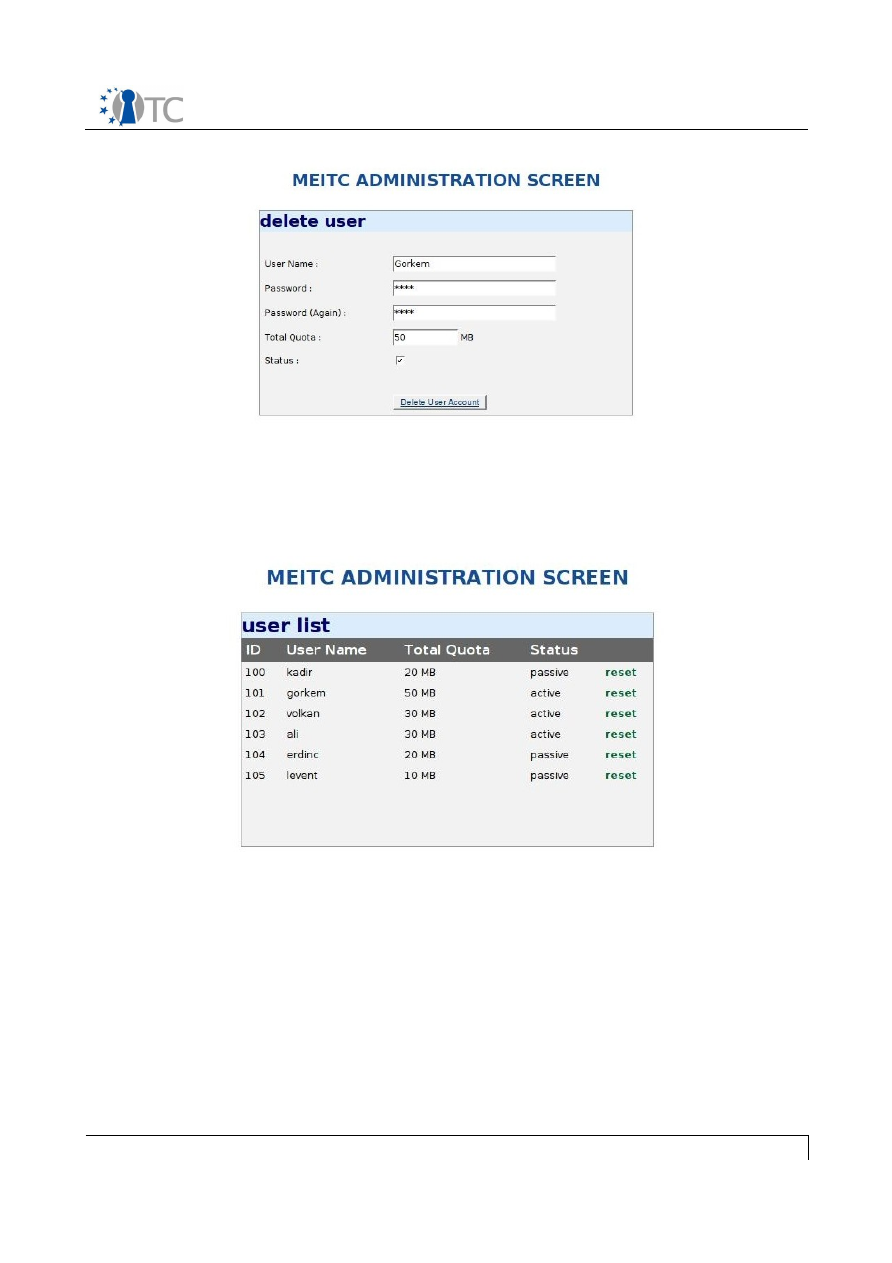
OTC-364: WP06b.3 MEITC Detailed Design and Test Document
9.2.7 Reset user list screen
9.2.8 Reset user screen
Internal document
49/50
Figure 28:Delete user screen
Figure 29:Reset user list screen
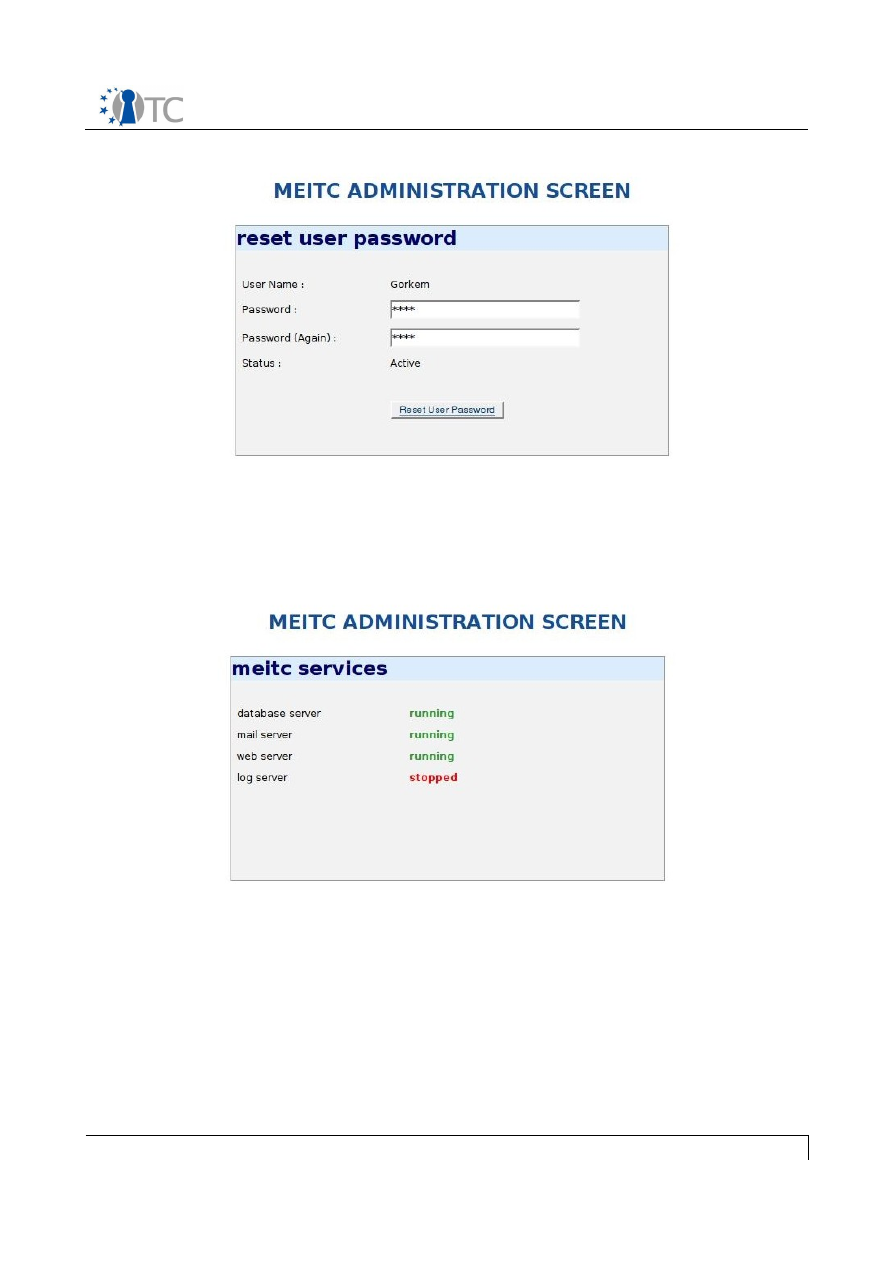
OTC-364: WP06b.3 MEITC Detailed Design and Test Document
9.2.9 Services screen
Internal document
50/50
Figure 30:Reset user screen
Figure 31:Services screen

SWP06.c: WYSIWYS high level requirements
specification
Project number
IST- 027635
Project acronym
Open_TC
Project title
Open Trusted Computing
Deliverable type
Internal deliverable
Deliverable reference number
IST-027635/D06c.1/FINAL 1.00
Deliverable title
WYSIWYS high level requirements
specification
WP contributing to the deliverable
WP6
Due date
Oct 2007 - M24
Actual submission date
Nov 2007
Responsible Organisation
Politecnico di Torino
Authors
Gianluca Ramunno, Marco Vallini (POL)
Abstract
WYSIWYS is a functional and security
requirement for electronic signatures,
especially when used in legal contexts. This
document consists in a high level
requirements specification for a WYSIWYS
application designed for OpenTC security
architecture.
Keywords
Dissemination level
Public
Revision
FINAL 1.00
Instrument
IP
Start date of the
project
1
st
November 2005
Thematic Priority
IST
Duration
42 months

SWP06.c WYSIWYS high level requirements specification FINAL 1.00
Table of Contents
1 Motivation and problem description..........................................................................5
2 Security Environment................................................................................................6
2. 1 Assumptions.........................................................................................................6
2. 2 Threats.................................................................................................................7
3 Functional Requirements (Use Case Model)............................................................10
3. 1 Goal....................................................................................................................10
3. 2 Target Groups....................................................................................................10
3. 3 Roles and Actors.................................................................................................10
3. 4 Overview............................................................................................................10
3. 5 Use Cases (Detailed Description).......................................................................11
3.5. 1 Sign a document............................................................................................13
3.5. 2 Verify a signed document..............................................................................14
3.5. 3 Basic operations............................................................................................15
4 Security Objectives & Security Requirements.........................................................22
4. 1 Security Objectives............................................................................................22
4. 2 Security Requirements.......................................................................................22
5 Supplementary Requirements................................................................................24
5. 1 Preconditions......................................................................................................24
5. 2 Required Criteria................................................................................................24
5. 3 Desired Criteria..................................................................................................24
5. 4 Distinguishing Criteria........................................................................................25
5. 5 Execution Environment......................................................................................25
5.5. 1 Software........................................................................................................25
5.5. 2 Hardware.......................................................................................................25
5. 6 Development Environment.................................................................................25
5.6. 1 Software........................................................................................................25
5.6. 2 Hardware.......................................................................................................25
6 High-Level Software Architecture...........................................................................26
6. 1 Logical view........................................................................................................26
6.1. 1 Packages.......................................................................................................26
6.1. 2 Use case realization.......................................................................................28
7 List of Abbreviations...............................................................................................36
Open_TC Deliverable 06c.1
2/37

SWP06.c WYSIWYS high level requirements specification FINAL 1.00
List of figures
Figure 1: Use cases diagram........................................................................................11
Figure 2: Package diagram...........................................................................................26
Figure 3: UC 30 sequence diagram...............................................................................29
Figure 4: UC 40 sequence diagram...............................................................................30
Figure 5: UC 50 sequence diagram...............................................................................31
Figure 6: UC 60 sequence diagram...............................................................................32
Figure 7: UC 70 sequence diagram...............................................................................33
Figure 8: UC 80 sequence diagram...............................................................................34
Figure 9: UC 90 sequence diagram...............................................................................35
Open_TC Deliverable 06c.1
3/37

SWP06.c WYSIWYS high level requirements specification FINAL 1.00
List of Tables
Table 1: Packages required by use cases.....................................................................28
Open_TC Deliverable 06c.1
4/37

SWP06.c WYSIWYS high level requirements specification FINAL 1.00
1 Motivation and problem description
“What You See Is What You Sign” (WYSIWYS) is a functional and security requirement
for electronic signatures, especially when used in legal contexts (e.g. the European
Directive 1999/93/EC on electronic signatures). To guarantee the trustworthiness of
the content displayed and being signed, there is the need to guarantee a trusted path
from the signing (or verifying) application to the user and in the opposite direction.
Many past and present solutions that claim to be WYSIWYS compliant, in reality they
are not. In fact they do not protect against the Trojan software or “malware” that can
act on either the document image displayed to the user or the user’s input to activate
the signing device operations. This is caused by the insecure architecture of the I/O
subsystems integrated within the current monolithic Operating Systems.
Therefore the design of a WYSIWYS application must also take into account the
underlying architecture in order to guarantee the actual trustworthiness of the
application. In particular trusted input/output paths between the application and the
user must be must be in place in order to guarantee the correct binding between the
document presentation and the data actually signed or verified.
The security properties and services provided by OpenTC architecture can be used as
foundation for a WYSIWYS application; enabling features from OpenTC are the trusted
GUI, the assurance about the integrity of the security architecture and of the
application. Moreover memory isolation through virtualisation and information flow
control policies allow designing the WYSIWYS application in a modular fashion with a
strong confinement of components with different levels of requirements for strength.
Another relevant aspect is the correctness of the document presentation. Given the
complexity of the current document formats, designing and implementing trustworthy
viewers solely for the purpose of a secure electronic signature doesn't match the
market requirements, making this infeasible in practice. However a pragmatic
approach can be used to go in the right direction for achieving this requirement:
standard applications used to produce the documents being signed can be used as
“trusted viewers” provided that they are properly configured to avoid hidden content,
and dynamic content depending on the platform configuration or on the time when the
document is presented.
This document includes a high level requirement specification for a reference
architecture of an application for signing and verifying electronic documents that
satisfies the WYSIWYS requirement.
Open_TC Deliverable 06c.1
5/37

SWP06.c WYSIWYS high level requirements specification FINAL 1.00
2 Security Environment
This section describes the security aspects of the environment in which the
product is intended to be used and the manner in which it is expected to be
employed.
2.1 Assumptions
A description of assumptions shall describe the security aspects of the
environment in which the Target of Evaluation (TOE) will be used or is intended
to be used. This shall include the following:
●
information about the intended usage of the TOE, including such aspects
as the intended application, potential asset value, and possible limitations
of use; and
●
information about the environment of use of the TOE, including physical,
personnel, and connectivity aspects.
/A 10/ Trusted Administrator
The security administrator of the system is non-malicious.
/A 20/ Correct hardware
The underlying hardware (e.g., CPU, devices, TPM, ...) does not contain backdoors, is
non-malicious and behaves as specified.
/A 30/ No Physical attacks
Physical attacks against the underlying hardware platform do not happen.
/A 40/ TOE Binding
The IT-environment offers a mechanism that allows the TOE (WYSIWYS application) to
store information and data like signing keys such that it cannot be accessed by
another TOE configuration. Example mechanisms are the sealing function offered by a
TPM as specified by the TCG in combination with an authenticated bootstrap
architecture, or a tamper-resistant storage in combination with a secure bootstrap
architecture.
/A 50/ No man-in-the-middle attack
A physical attack that relays the whole communication between a local user and the
I/O devices to another device does not happen.
/A 60/ Trusted video path
The architecture underlying TOE provides a reliable and secure video output path.
/A 70/ Trusted input paths
The architecture underlying TOE provides reliable and secure paths for input devices
Open_TC Deliverable 06c.1
6/37

SWP06.c WYSIWYS high level requirements specification FINAL 1.00
(keyboard, mouse, etc.).
/A 80/ Trusted path to cryptographic devices
The architecture underlying TOE provides a reliable and secure path to signing
devices.
/A 90/ CRTM, TPM, boot loader, VMM and basic security services are
trustworthy
The architecture underlying TOE, namely Core Root of Trust for Measurement (CRTM),
TPM, boot loader, Virtual Machine Monitor (VMM) and services providing security
features behave as expected. All of them are referred to as Trusted Computing Base
(TCB) hereinafter.
/A 100/ TCB guarantees memory isolation between VMs
The TCB guarantees memory isolation between Virtual Machines (VMs) also called
compartments.
/A 110/ TCB is able to enforce security policies for information flow control
The TCB can enforce security policies for information flow control between
compartments: it can guarantees authenticity, integrity and confidentiality of
communication channels among compartment.
/A 120/ TCB prevents exploits and replay attacks
The TCB is designed to prevent exploits of uncritical applications to gain access to
security sensitive information and replay attacks, namely resetting the state of an
application by replaying an older state.
/A 130/ TCB provides secure installation services for TOE
TCB provides installation services for all security critical applications like TOE.
/A 140/ Integrity of TOE is guaranteed by TCB
The TCB guarantees the integrity of TOE: either preventing TOE from running if it
compromised or allowing TOE to be started but alerting the user about TOE being
compromised.
2.2 Threats
A description of threats shall include all threats to the assets against which
specific protection within the TOE or its environment is required. Note that not all
possible threats that might be encountered in the environment need to be listed,
only those which are relevant for secure TOE operation.
A threat shall be described in terms of an identified threat agent, the attack, and
the asset that is the subject of the attack. Threat agents should be described by
addressing aspects such as expertise, available resources, and motivation.
Attacks should be described by addressing aspects such as attack methods, any
vulnerabilities exploited, and opportunity.
Open_TC Deliverable 06c.1
7/37

SWP06.c WYSIWYS high level requirements specification FINAL 1.00
If security objectives are derived from only organizational security policies and
assumptions, then the description of threats may be omitted.
/T 10/ Trojan Horse
An adversary may try to get access to sensitive information by deceiving
Administrators or Users such that a application under control of the adversary claims
to be the TOE.
/T 20/ Unauthorised User
An unauthorised user may use TOE to read or modify information owned by another
user.
/T 30/ Unauthorised Administrator
An unauthorised user may use a management functionality of the TOE to grant itself
access to sensitive information.
/T 40/ Unauthorised Data Access
An unauthorised application may read or manipulate user information persistently
stored by TOE.
/T 50/ Denial of Service
An adversary may try to prevent that authorised users can use the TOE by denial of
service attacks against the TCB or the TOE itself.
/T 60/ Document replacement when displayed
A malicious application may try to replace the document being displayed to fool the
user.
/T 70/ Document replacement when being signed
A malicious application may try to replace the document being signed with another
one while keeping displayed the document selected by the user.
/T 80/ Incorrect document visualisation by output device
The output device may be not able to correctly represent all document details, e.g.
due to screen resolution or output device size not enough for a correct representation
or a limited set of available colours.
/T 90/ Misinterpretation of document format
The format of the document to be signed or verified may be wrongly interpreted by
the viewer.
/T 100/ Dynamic code embedded in the document
The document may include dynamic code (i.e. macros) which can, without invalidating
the signature, modify the document visualisation if different platforms are used or the
Open_TC Deliverable 06c.1
8/37

SWP06.c WYSIWYS high level requirements specification FINAL 1.00
document is displayed at different times (e.g. signature or verification time).
/T 110/ Hidden content
The document may include hidden content being signed (e.g. text in the same colour
as the background) without the user being able to notice it.
Open_TC Deliverable 06c.1
9/37

SWP06.c WYSIWYS high level requirements specification FINAL 1.00
3 Functional Requirements (Use Case Model)
3.1 Goal
The goal is designing an application for signing and verifying the electronic documents
that meets the WYSIWYS requirement. To achieve this goal, the design is based on
OpenTC, a security architecture built on top of Trusted Computing and virtualisation
technologies. The application performs the following operations: displaying the
document to be signed and electronically signing the document, displaying an already
signed document and verifying the electronic signature.
3.2 Target Groups
Defines the users/other components that wish to use the product.
●
Home user (Single-user platform at home)
●
Employee (Multi-user platform in enterprise environment)
3.3 Roles and Actors
In this section we define different roles and actors important for the use case
model. Actors are parties outside the system that interact with the system; an
actor can be a class of users, roles users can play, or other systems. Note that,
depending on the use case, some parties or actors may not be involved.
User
: The user of a computing platform is an entity interacting with the platform
under the platform's security policy. Examples are employees using enterprise-owned
hardware.
3.4 Overview
The user can use WYSIWYS application to perform two main operations:
1. signing a document
2. verifying a signed document
Open_TC Deliverable 06c.1
10/37
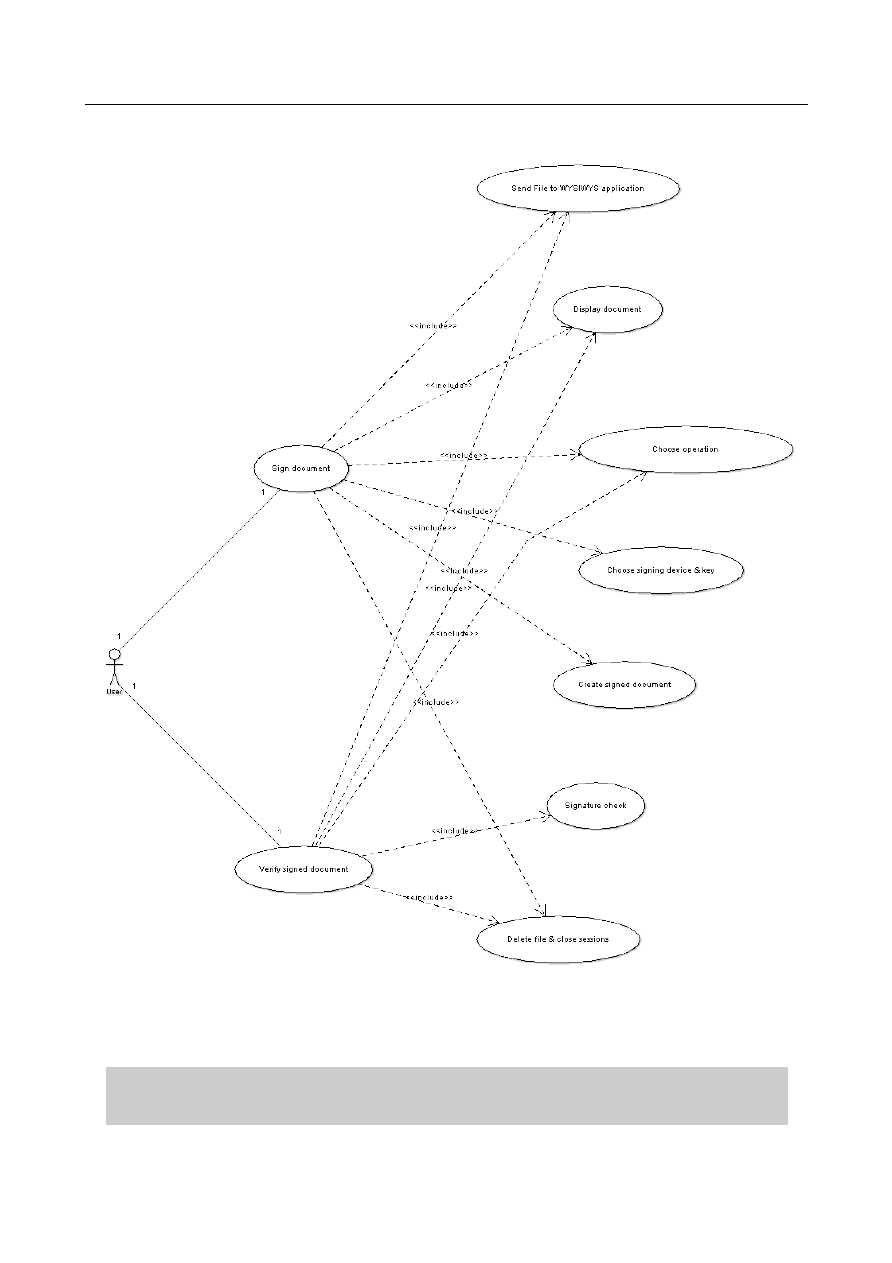
SWP06.c WYSIWYS high level requirements specification FINAL 1.00
3.5 Use Cases (Detailed Description)
Each use case focuses on describing how to achieve a single business goal or
task. From a traditional software engineering perspective a use case describes
just one feature of the system. For most software projects this means that
Open_TC Deliverable 06c.1
11/37
Figure 1: Use cases diagram

SWP06.c WYSIWYS high level requirements specification FINAL 1.00
multiple, perhaps dozens, of use cases are needed to fully specify the new
system. The degree of formality of a particular software project and the stage of
the project will influence the level of detail required in each use case.
A use case defines the interactions between external actors and the system
under consideration to accomplish a business goal.
Use cases treat the system as a "black box", and the interactions with the
system, including system responses, are perceived as such from outside the
system. This is a deliberate policy, because it simplifies the description of
requirements, and avoids the trap of making assumptions about how this
functionality will be accomplished.
A use case should:
●
describe a business task to serve a business goal
●
have no implementation-specific language
●
be at the appropriate level of detail
●
be short enough to implement by one software developer in a single
release.
Open_TC Deliverable 06c.1
12/37

SWP06.c WYSIWYS high level requirements specification FINAL 1.00
3.5.1 Sign a document
Use case unique ID
/UC 10/
Title
Sign document
Short description/purpose(s)
The user wants to sign a document
Actors
User
Includes
/UC 30/ Send file to WYSIWYS
/UC 40/ Display document
/UC 50/ Choose operation
/UC 60/ Choose signing device & key
/UC 70/ Create signed document
/UC 90/ Delete files & close sessions
Preconditions
WYSIWYS application is running
Postcondition
The user receives back the signed
document
Normal Flow
1. Send file to WYSIWYS
application /UC 30/
2. Display document /UC 40/
3. Choose operation (sign) /UC 50/
4. Choose signing device & key /UC
60/
5. Create signed document /UC 70/
6. Signature verification /UC 80/
7. Delete file & close sessions /UC 90/
Open_TC Deliverable 06c.1
13/37

SWP06.c WYSIWYS high level requirements specification FINAL 1.00
3.5.2 Verify a signed document
Use case unique ID
/UC 20/
Title
Verify signed document
Short description/purpose(s)
The user wants to verify a signature
applied to a document
Actors
User
Includes
/UC 30/ Send file to WYSIWYS application
/UC 40/ Display document
/UC 50/ Choose operation
/UC 80/ Signature verification
/UC 90/ Delete file & close sessions
Preconditions
WYSIWYS application is running
Postcondition
The user receives the result of signature
verification
Normal Flow
1. Send file to WYSIWYS
application /UC 30/
2. Display document /UC 40/
3. Choose operation (verify) /UC 50/
4. Signature verification /UC 80/
5. Delete file & sessions /UC 90/
Open_TC Deliverable 06c.1
14/37

SWP06.c WYSIWYS high level requirements specification FINAL 1.00
3.5.3 Basic operations
Use case unique ID
/UC 30/
Title
Send file to WYSIWYS application
Short description/purpose(s)
The user sends file to WYSIWYS
application
Actors
User
Preconditions
WYSIWYS application is running
Postcondition
The document is loaded into WYSIWYS
application
Normal Flow
6. The user sends the application the
document's file using a proper
command
7. The application saves the
document internally
8. The application activates a trusted
interface for user interaction
Open_TC Deliverable 06c.1
15/37

SWP06.c WYSIWYS high level requirements specification FINAL 1.00
Use case unique ID
/UC 40/
Title
Display document
Short description/purpose(s)
The application shows the document and
guarantees a trustworthy display
Preconditions
/UC 30/
Postcondition
The document is shown to the user
Normal Flow
1. The application activates the
correct viewer for the document
format
2. The application loads the document
file from an internal storage
3. The document is displayed to the
user
Open_TC Deliverable 06c.1
16/37

SWP06.c WYSIWYS high level requirements specification FINAL 1.00
Use case unique ID
/UC 50/
Title
Choose operation
Short description/purpose(s)
The user chooses to sign or verify a
document
Actors
User
Preconditions
/UC 40/
Postcondition
The user has chosen the operation to be
executed
Normal Flow
1. The user is required to choose one
operation
2. The user decides to sign or verify
the document
3. The application takes charge of
user's choice
Open_TC Deliverable 06c.1
17/37

SWP06.c WYSIWYS high level requirements specification FINAL 1.00
Use case unique ID
/UC 60/
Title
Choose signing device & key
Short description/purpose(s)
The user selects the signing device and
key
Actors
User
Preconditions
/UC 50/
Postcondition
The signing device and the key are
chosen
Normal Flow
1. The application shows to the user
the list of available signing devices
2. The user chooses the signing
device
3. The application shows to the user
the list of available keys
4. The user chooses the signing key
Open_TC Deliverable 06c.1
18/37

SWP06.c WYSIWYS high level requirements specification FINAL 1.00
Use case unique ID
/UC 70/
Title
Create signed document
Short description/purpose(s)
Create the file containing the signed
document
Preconditions
/UC 60/
Postcondition
The user receives the signed document
Normal Flow
1. The application loads the document
to be signed from the internal
storage
2. The selected signing device
generates the electronic signature
over document file using the
selected key
3. The application creates the file
containing the document and the
signature
4. The application returns to the user
the signed document
Open_TC Deliverable 06c.1
19/37

SWP06.c WYSIWYS high level requirements specification FINAL 1.00
Use case unique ID
/UC 80/
Title
Signature verification
Short description/purpose(s)
The application verifies the correctness of
the electronic signature over the
document
Preconditions
/UC 50/
Postcondition
The user receives the result of verification
Normal Flow
1. The application loads the signed
document to be verified
2. The application actually verifies
correctness of the signature
3. The application returns the result of
the verification to the user
Open_TC Deliverable 06c.1
20/37

SWP06.c WYSIWYS high level requirements specification FINAL 1.00
Use case unique ID
/UC 90/
Title
Delete file & close sessions
Short description/purpose(s)
All sessions are destroyed and the file
internally saved is deleted
Preconditions
/UC 70/ or /UC 80/
Postcondition
The application returned to its initial state
Normal Flow
5. The application deletes the file
from the internal storage
6. The application closes all sessions
Open_TC Deliverable 06c.1
21/37

SWP06.c WYSIWYS high level requirements specification FINAL 1.00
4 Security Objectives & Security Requirements
4.1 Security Objectives
The security objectives shall address all of the security environment aspects
identified. The security objectives shall reflect the stated intent and shall be
suitable to counter all identified threats and cover all identified organizational
security policies and assumptions. A threat may be countered by one or more
objectives for the product, one or more objectives for the environment, or a
combination of these.
/SO 10/ Separability
The use of different security-critical TOE components based on the OpenTC security
architecture has to be at least as secure as the execution of the same applications on
physically separated computing platforms connected via network.
/SO 20/ No unauthorized use of TOE components
Unauthorized entities must not be able to arbitrarily execute TOE components.
/SO 30/ Visual identification of TOE User Interface
The user must be able to reliably identify the User Interface of TOE.
/SO 40/ Correct visualisation of the document
TOE must correctly visualise the document being signed or verified.
/SO 50/ Binding between visualisation and signature/verification operations
TOE must actually sign or verify the document being displayed to the user.
4.2 Security Requirements
This part of the requirement specification defines the security requirements that
have to be satisfied by the product. The statements shall define the functional
and assurance security requirements that the product and the supporting
evidence for its evaluation need to satisfy in order to meet the security
objectives.
/SR 10/ No communication among TOE components and external parties
Security policies should be enforced to guarantee that TOE components cannot
interact with external parties.
/SR 20/ Information flow
Security policies should be enforced to guarantee that information flow is only possible
among TOE components. Primarily, eves dropping on another, non-cooperating
compartment must be foiled.
Open_TC Deliverable 06c.1
22/37

SWP06.c WYSIWYS high level requirements specification FINAL 1.00
/SR 30/ Integrity of document to be signed or verified
TOE should guarantee that the displayed document cannot be corrupted while being
signed or verified.
/SR 40/ Trusted WORM Storage
The TOE should use a trusted storage Write Once Read Many (WORM) for storing
documents to be signed or verified and used by TOE components during all
intermediate operations.
/SR 50/ Trusted RW Storage
The TOE should use a trusted storage Read/Write for temporary files during
operations.
Open_TC Deliverable 06c.1
23/37

SWP06.c WYSIWYS high level requirements specification FINAL 1.00
5 Supplementary Requirements
Obligatory criteria, mandatory for successful completion.
5.1 Preconditions
Requirements that have to be fulfilled already, because they were needed for the
development process.
/PR 100/ Trusted Computing Base
The TOE is build upon OpenTC, a security architecture for Trusted Computing Base.
/PR 200/ Reliable document viewer
The TOE should use at least one application that is considered reliable as viewer for
one specific document format (e.g. OpenDocument).
5.2 Required Criteria
Mandatory criteria, that are obligatory for successful completion.
/RC 10/ Xen support
The realization of the use cases should be based on a Xen-based architecture.
/RC 20/ Single-user support
The TOE should support at least one user.
/RC 30/ Cryptographic devices
The TOE should support all common cryptographic devices - hardware and software -
through standard interfaces (particularly PKCS#11).
/RC 40/ Document formats
The TOE should support virtually any type of document format via plug-in based
architecture for document viewers.
5.3 Desired Criteria
Optional criteria, that are not mandatory for successful completion.
/DC 10/ Multi-user support
The security architecture should be able to handle multiple users.
/DC 20/ L4 support
The realization of the use cases should be based on an L4-based architecture.
Open_TC Deliverable 06c.1
24/37

SWP06.c WYSIWYS high level requirements specification FINAL 1.00
5.4 Distinguishing Criteria
What our product does not provide.
5.5 Execution Environment
This section specifies software and hardware the user requires at least to run our
product successfully.
5.5.1 Software
●
Standard Linux 2.6.x distribution
●
Xenolinux 3.1.x (Linux 2.6.x running on top of Xen 3.1.x hypervisor)
●
OpenOffice 2.3 or higher
●
(optional) L4-Linux (Linux 2.6.x running on top of Fiasco, L4V2 µ-kernel)
5.5.2 Hardware
●
Intel LT/VT or AMD-V Platform
●
TPM 1.2 Platform
5.6 Development Environment
This section specifies hard- and software that developers need at least to
implement the product successfully.
5.6.1 Software
●
Linux 2.6.x
●
gcc 4.2.x
●
eclipse-3.1
●
OpenOffice 2.3 or higher
5.6.2 Hardware
●
Intel LT/VT or AMD-V Platform
●
TPM 1.2 Platform
Open_TC Deliverable 06c.1
25/37
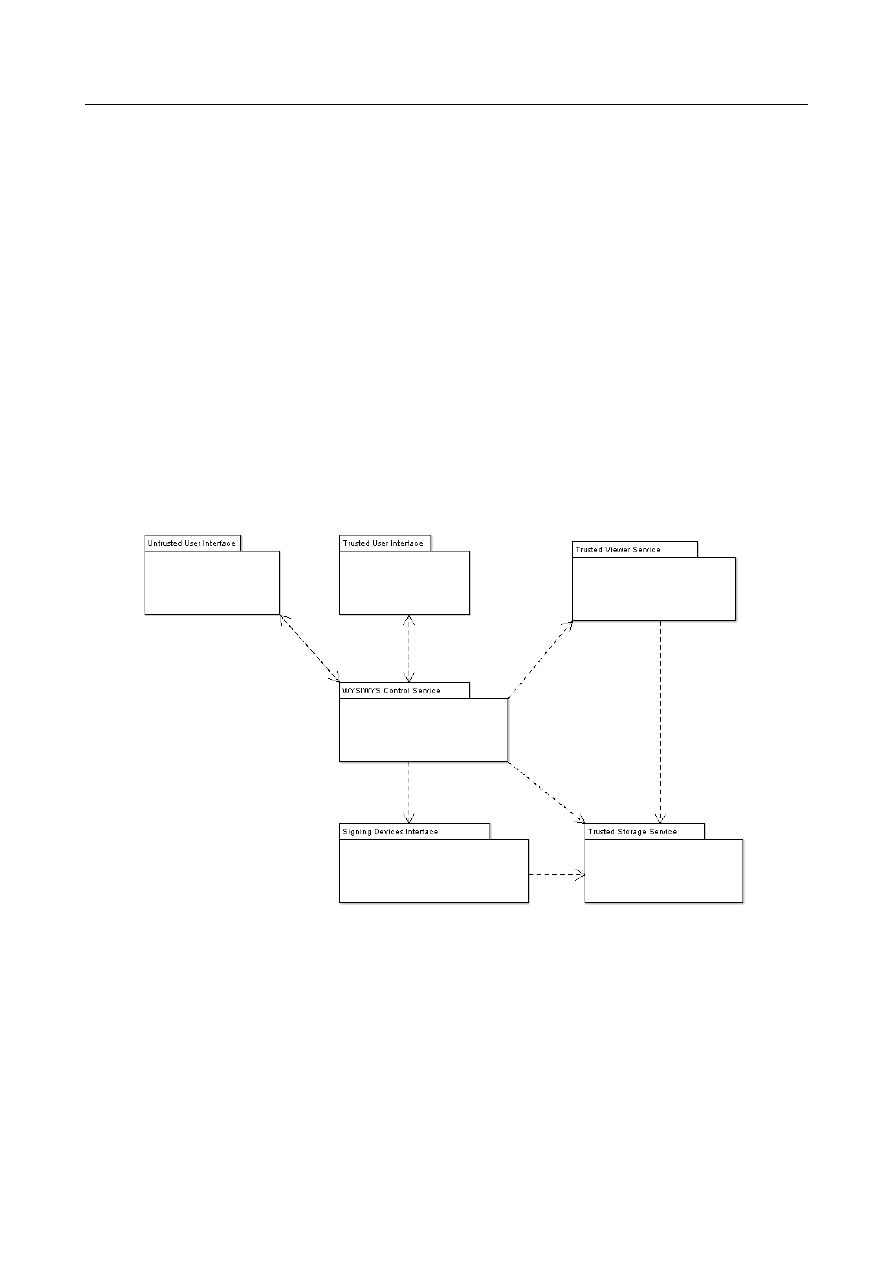
SWP06.c WYSIWYS high level requirements specification FINAL 1.00
6 High-Level Software Architecture
6.1 Introduction
This section contains some views of a high-level software architecture for a WYSIWYS
application. In particular the granularity of the views is at package level; each package
includes a group of components that share the same level of strength for security
requirements. Such groups can be actually compartmented using a different virtual
machines. To show the interactions among those virtual machine sequence diagrams
are used, thus overloading their semantic, since they are normally used to show
interactions among objects.
6.2 Logical views
6.2.1 Packages
In figure 2 the package diagram shows the 'use' relationships among different
packages.
Untrusted User Interface
It is the standard interface provided to the user by the environment for daily
operations (like browsing the Internet, reading e-mails and writing documents); it
allows the user to start WYSIWYS application and to choose the document file to sign
or verify.
Trusted User Interface
It is part of WYSIWYS application and it allows the user to interact with
WYSIWYS
Open_TC Deliverable 06c.1
26/37
Figure 2: Package diagram

SWP06.c WYSIWYS high level requirements specification FINAL 1.00
Control Service
to choose the operation (sign or verify) to be executed and related
options.
WYSIWYS Control Service
It implements the application logic and controls all packages. It receives the document
file to be signed or verified from
Untrusted User Interface
and it manages the
interactions between all packages.
Signing Devices Interface
It exposes a simple API to give access to the signing devices. Different types of
devices can be supported: software and hardware (commonly used smart-cards or
TPM). Each user can use a (sub)set of all devices the platform makes available. Such
devices hold the users' keys.
Trusted Viewer Service
It shows the document to be signed or verified. It guarantees a trustworthy
visualisation using the correct viewer with regards to the document format.
Trusted Storage Service
It allows a trusted storage of the document file for all WYSIWYS operations. It
implements a WORM storage (Write Once Read Many). Only who write a File can
delete it while every package can read it.
Open_TC Deliverable 06c.1
27/37

SWP06.c WYSIWYS high level requirements specification FINAL 1.00
6.2.2 Use case realisation
Table 1 lists required packages for the realisation of each use case for the basic
operations. Then a possible implementation of such use cases is described through the
interaction of components grouped in packages via sequence diagrams.
Open_TC Deliverable 06c.1
28/37
Use Case
Required packages
/UC 30/ Send file to WYSIWYS application
Untrusted User Interface,
Trusted User Interface,
WYSIWYS Control Service,
Trusted Storage Service
/UC 40/ Display document
WYSIWYS Control Service,
Trusted Storage Service,
Trusted Viewer Service
/UC 50/ Choose operation
Trusted User Interface,
WYSIWYS Control Service
/UC 60/ Choose signing device & key
WYSIWYS Control Service,
Signing Devices Interface,
Trusted User Interface
/UC 70/ Create signed document
Untrusted User Interface,
WYSIWYS Control Service,
Trusted Storage Service,
Signing Devices Interface
/UC 80/ Signature verification
WYSIWYS Control Service,
Trusted User Interface,
Signing Devices Interface,
Trusted Storage Service
/UC 90/ Delete file & close sessions
Trusted User Interface,
WYSIWYS Control Service,
Trusted Storage Service,
Trusted Viewer Service
Table 1: Packages required by use cases
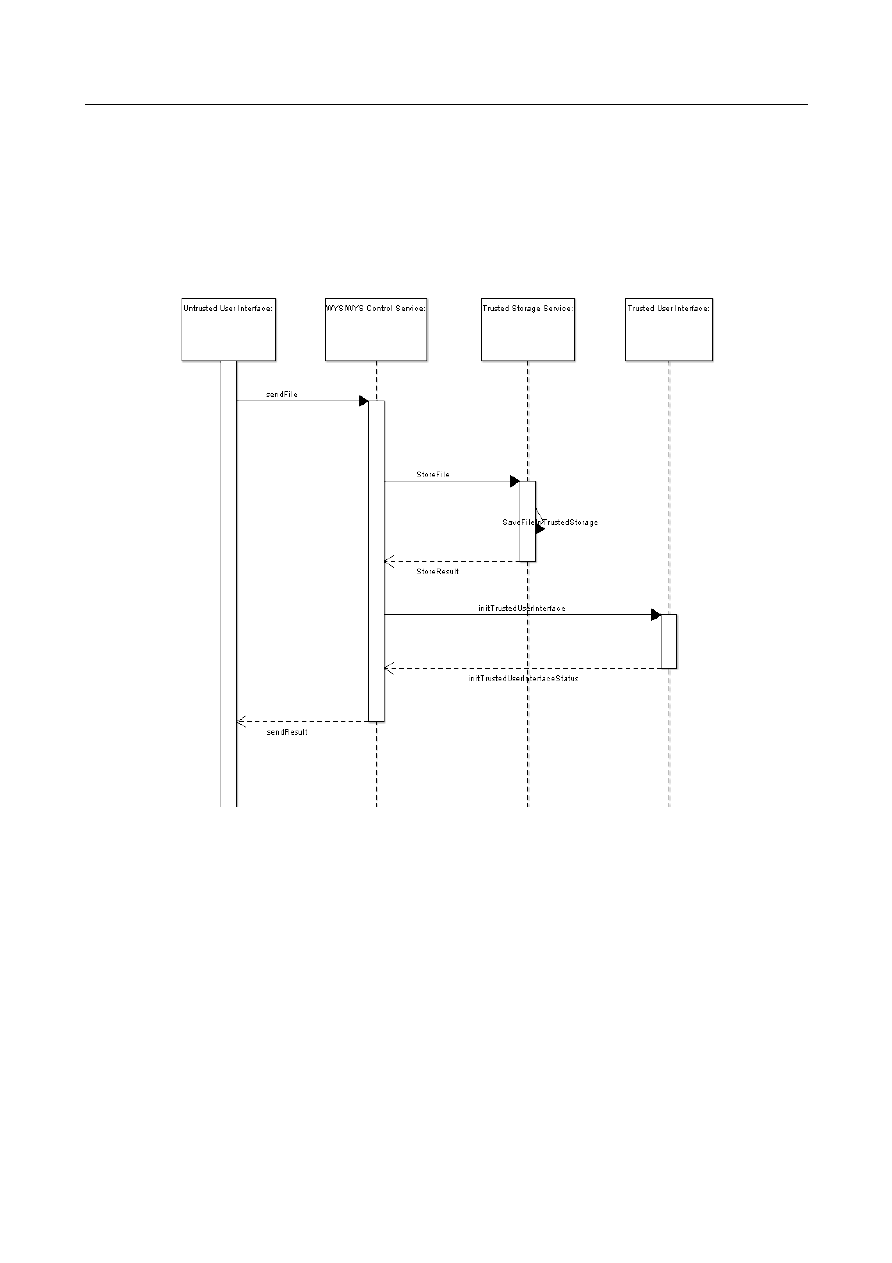
SWP06.c WYSIWYS high level requirements specification FINAL 1.00
/UC 30/ Send File to WYSIWYS application
The
User
selects the file to be signed or verified through the
Untrusted User Interface
that sends that file to
WYSIWYS Control Service.
The file is then sent to
Trusted
Storage Service
that saves it in the secure Write Only Read Many storage.
Trusted
Storage Service
returns a result about the correctness of the saving operation. Then
WYSIWYS Control Service
immediately activates the
Trusted User Interface
to interact
with the
User
.
Open_TC Deliverable 06c.1
29/37
Figure 3: UC 30 sequence diagram
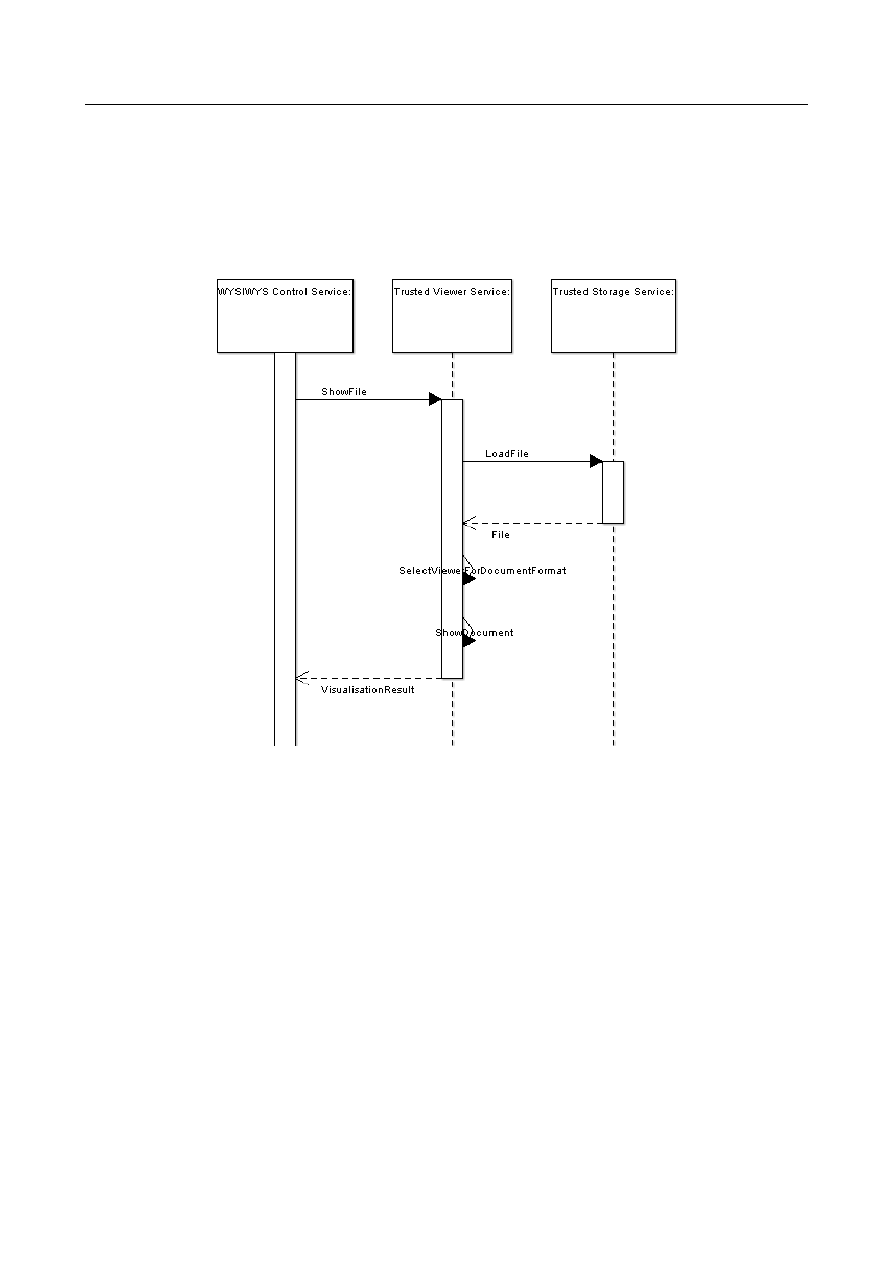
SWP06.c WYSIWYS high level requirements specification FINAL 1.00
/UC 40/ Display document
WYSIWYS Control Service
requests
Trusted Viewer Service
to show the document.
Trusted Viewer Service
loads the document file directly from
Trusted Storage Service
,
then activates the proper viewer with regards to the file format and shows document.
The
Trusted Viewer Service
returns a result about the correctness of the display
operation.
Open_TC Deliverable 06c.1
30/37
Figure 4: UC 40 sequence diagram
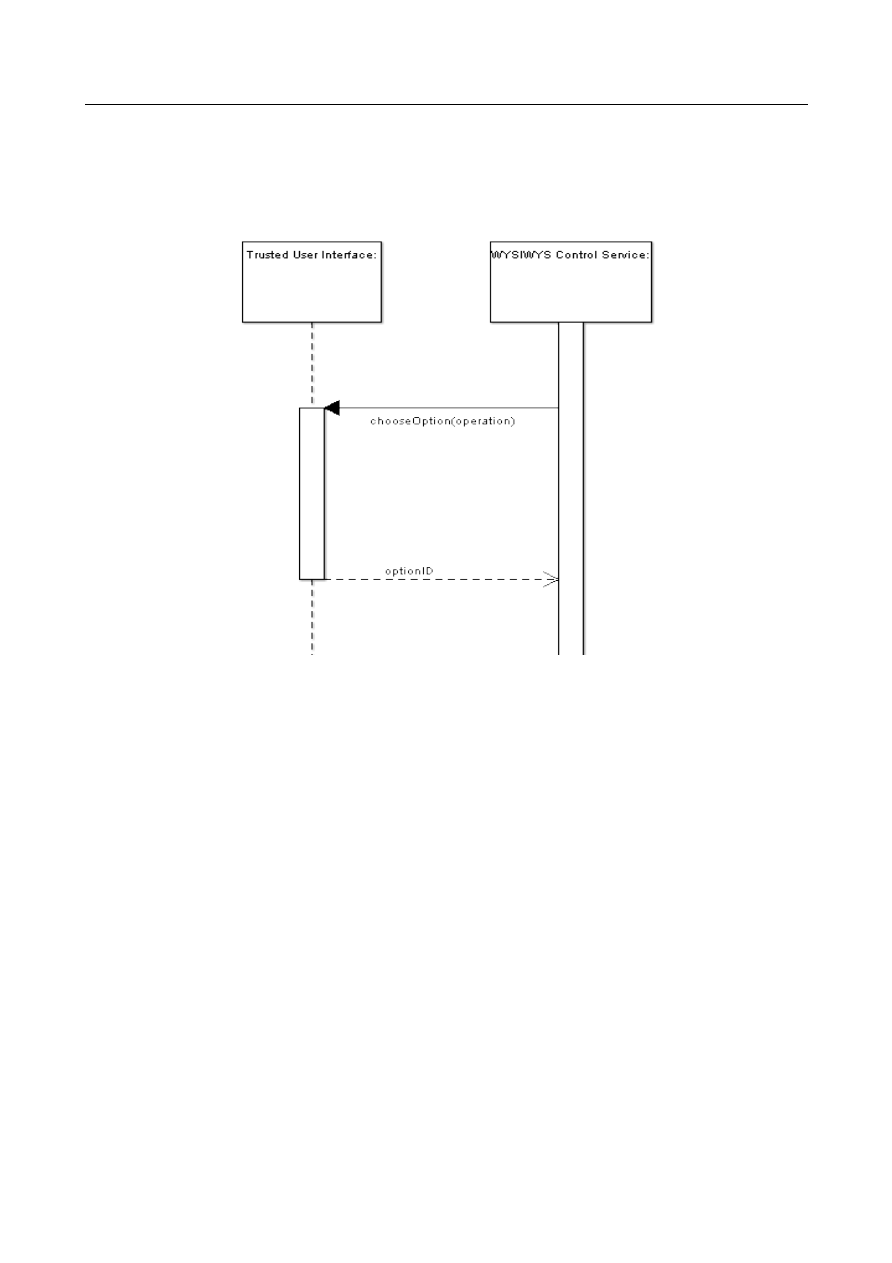
SWP06.c WYSIWYS high level requirements specification FINAL 1.00
/UC 50/ Choose operation
WYSIWYS Control Service
requests
Trusted User Interface
to show the list of allowed
operations (sign or verify) to
User
. He/she selects the wanted operation and the choice
is then taken in charge of by
WYSIWYS Control Service
.
Open_TC Deliverable 06c.1
31/37
Figure 5: UC 50 sequence diagram
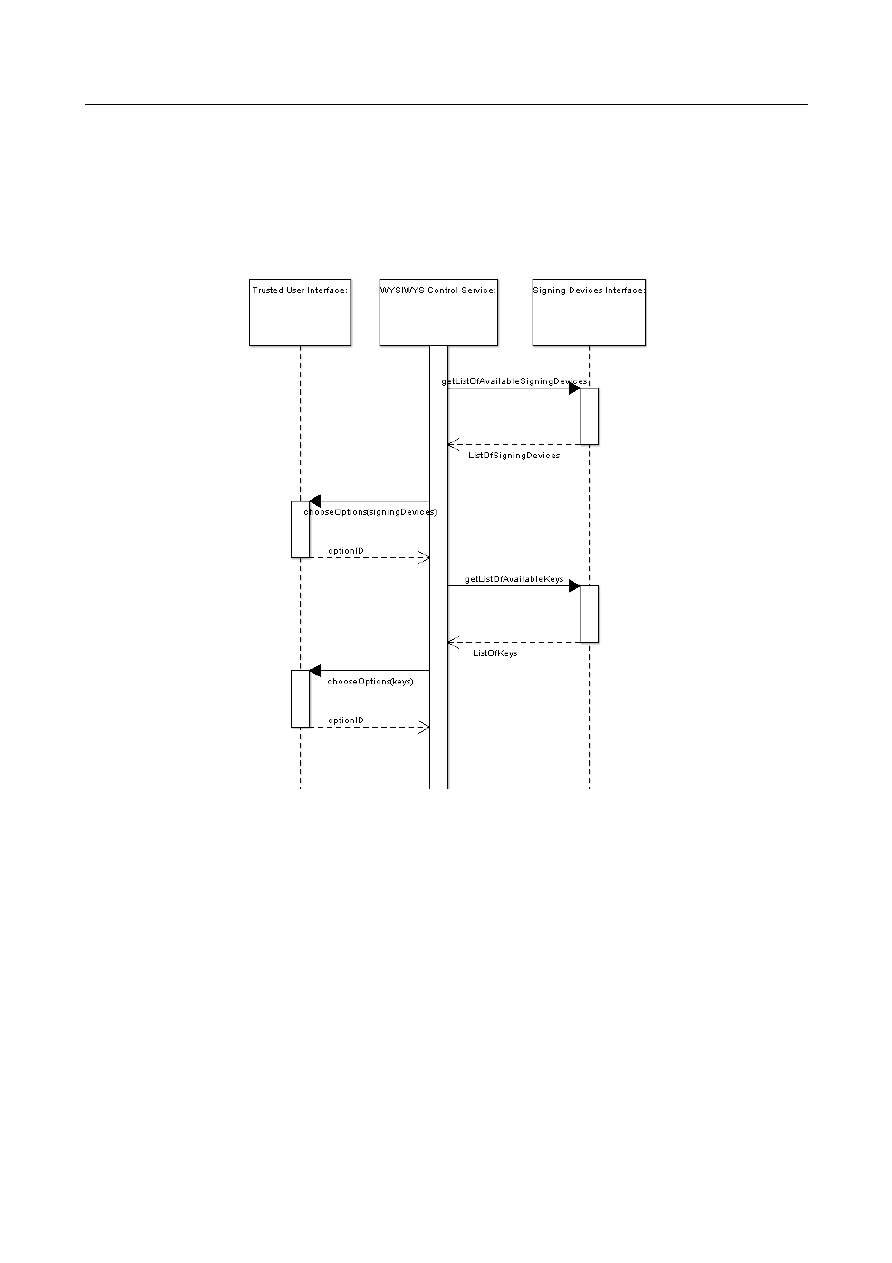
SWP06.c WYSIWYS high level requirements specification FINAL 1.00
/UC 60/ Choose signing device & key
WYSIWYS Control Service
has received the command to sign the document, so it
requests
Signing Devices Interface
for the list of available signing devices for the
User
.
Through
Trusted User Interface
the
User
chooses the signing device to be used. A
similar sequence of operations is performed to allow the
User
to select the wanted
signing key for the chosen device.
Open_TC Deliverable 06c.1
32/37
Figure 6: UC 60 sequence diagram
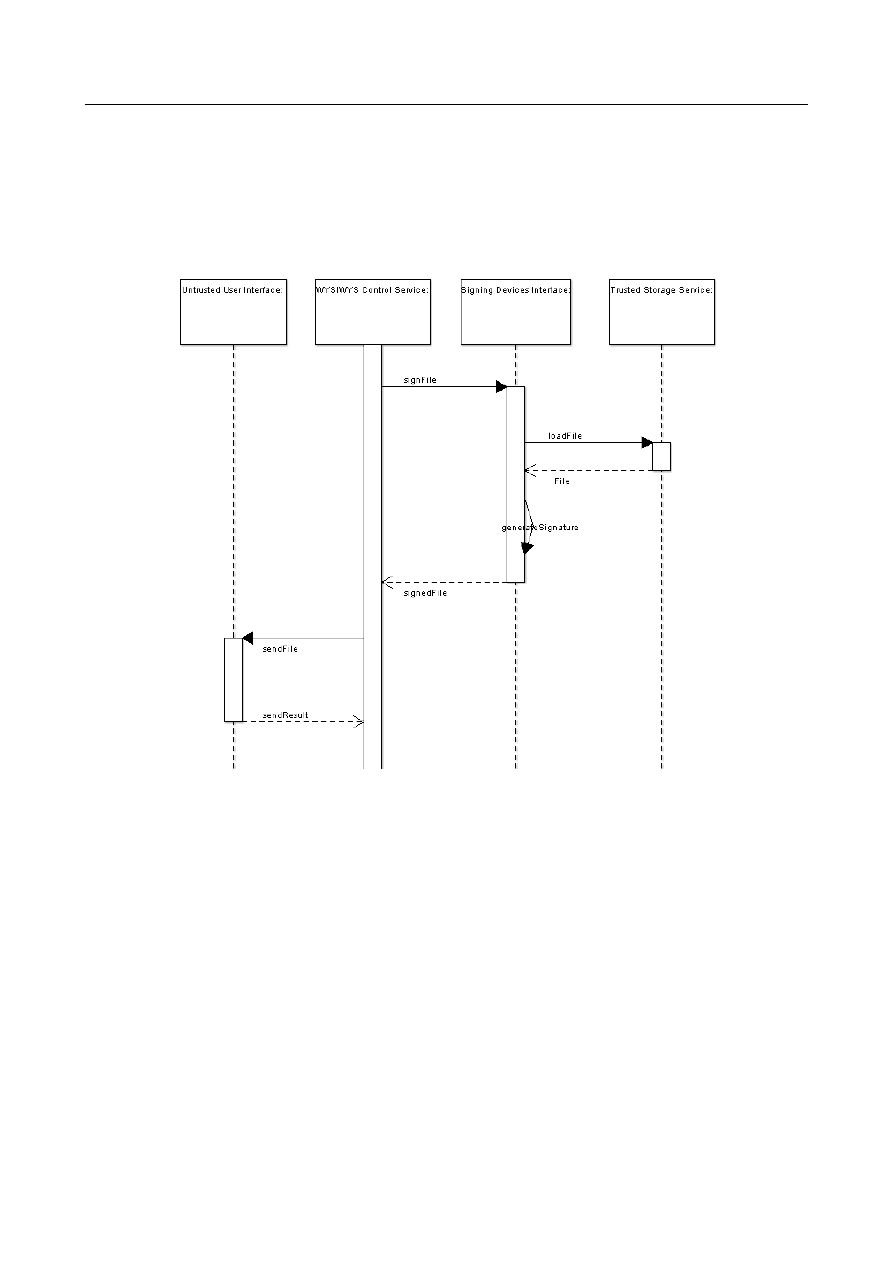
SWP06.c WYSIWYS high level requirements specification FINAL 1.00
/UC 70/ Create signed document
WYSIWYS Control Service
requests
Signing Devices Interface
to sign the document file.
Signing Devices Interface
directly loads the file from
Trusted Storage Service
and signs
the document using the chosen device and key. Then the file just created is sent back
to
WYSIWYS Control Service
that in turns returns the signed document to
User
through
the
Untrusted User Interface
.
Open_TC Deliverable 06c.1
33/37
Figure 7: UC 70 sequence diagram
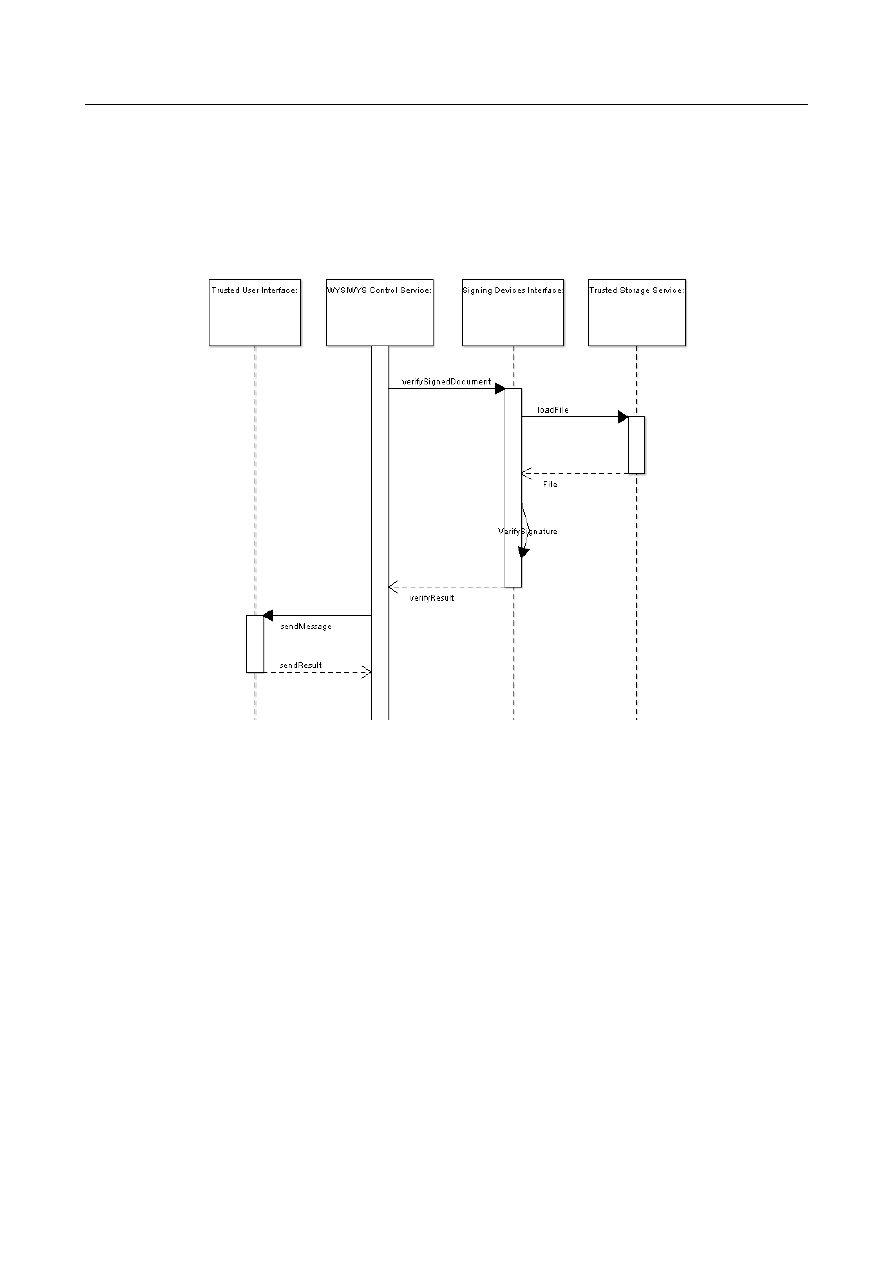
SWP06.c WYSIWYS high level requirements specification FINAL 1.00
/UC 80/ Signature verification
WYSIWYS Control Service
requests
Signing Devices Interface
to verify a signed
document.
Signing Devices Interface
loads the file directly from
Trusted Storage
Service
and verifies the signature. Then it returns the result of the verification to
WYSIWYS Control Service
that in turns returns the result to
User
through
Trusted User
Interface
.
Open_TC Deliverable 06c.1
34/37
Figure 8: UC 80 sequence diagram
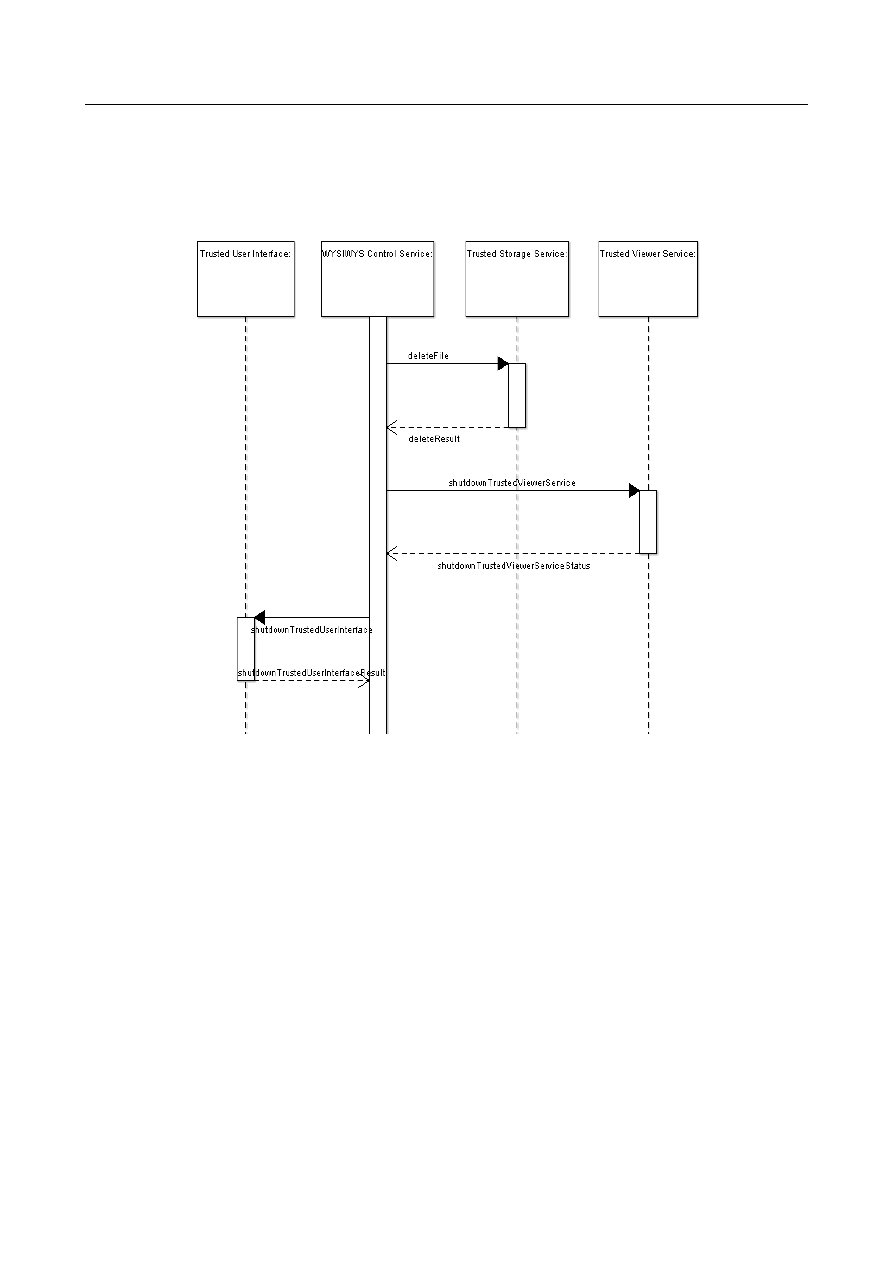
SWP06.c WYSIWYS high level requirements specification FINAL 1.00
/UC 90/ Delete file & close sessions
WYSIWYS Control Service
deletes from
Trusted Storage Service
the file previously
loaded upon user's choice, then it requests
Trusted User Interface
and
Trusted Viewer
Service
to close the relative session opened for the operation requested.
Open_TC Deliverable 06c.1
35/37
Figure 9: UC 90 sequence diagram

SWP06.c WYSIWYS high level requirements specification FINAL 1.00
7 List of Abbreviations
Listing of term definitions and abbreviations used in the overview documents and
architectural design specification (IT expressions and terms from the application
domain).
Abbreviation
Explanation
CPU
Central Processing Unit
IT
Information Technology
RW
Read/Write
TC
Trusted Computing
TCB
Trusted Computing Base
TCG
Trusted Computing Group
TOE
Target of Evaluation
TPM
Trusted Platform Module
VM
Virtual Machine
VMM
Virtual Machine Monitor
WORM
Write Once Read Many
WYSIWYS
What You See Is What You Sign
Open_TC Deliverable 06c.1
36/37

SWP06.c WYSIWYS high level requirements specification FINAL 1.00
8 Acknowledgements
The authors want to thank Ahmad-Reza Sadeghi from Ruhr University Bochum and
Chris Stüble from Sirrix AG for providing the template used for this document and ans
example on how to use it. The authors want also to thank Francesco Sartorio for the
substantial contribution to the requirements analysis.
Open_TC Deliverable 06c.1
37/37
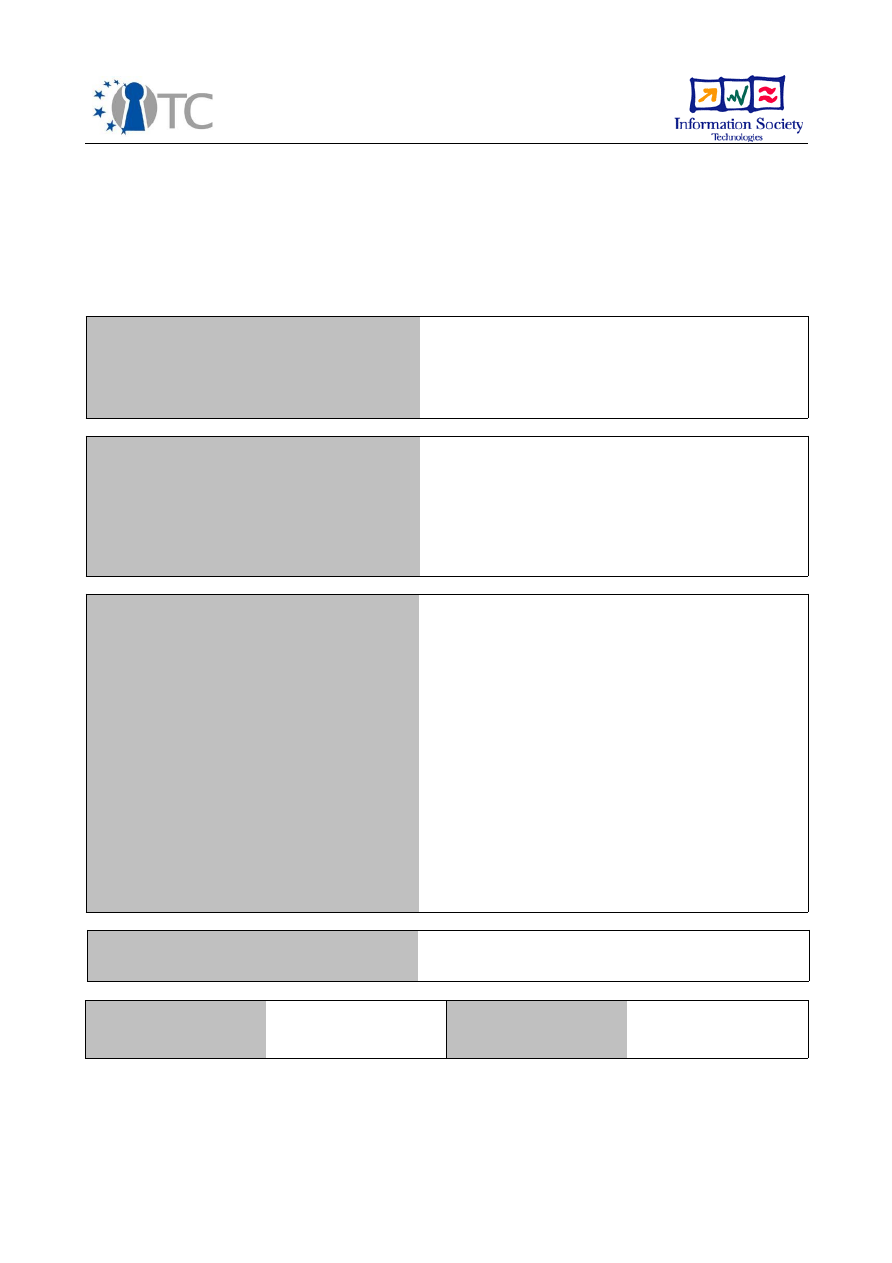
D6e.4: Final MFA System Specification
D6e.5: Complete MFA System Prototype
Project number
IST-027635
Project acronym
Open_TC
Project title
Open Trusted Computing
Deliverable type
Internal Report
Deliverable reference number
IST-027635/D6e.4, D6e5/PUBLIC | 1.00
Deliverable title
Final MFA System Specification,MFA Concept
Prototype
WP contributing to the deliverable
WP6
Due date
April 2007 M18, October 2007 M24
Actual submission date
November 13 2007
Responsible Organisation
INTEK
Authors
Irina Beliakova, Andrej Sokolov
Abstract
This document specifies MFA System which
use trusted platform features for a secure,
multifactor authentication to remote
computers. The system allows to make
remote logon by using TPM credentials
and/or password. The document contains
system architecture, components, their
interactions, data structures ,s function calls
and implementation of the MFA Concept
prototype.
Keywords
PAM, TPM, Credential Manager, MFA
Dissemination level
Public
Revision
PUBLIC | 1.00
Instrument
IP
Start date of the
project
1
st
November 2005
Thematic Priority
IST
Duration
42 months

MFA Final System Specification
Table of Contents
1 Introduction...............................................................................................................4
2 Requirements breakdown..........................................................................................4
3 High level design specification...................................................................................4
3.1 MFA system architecture........................................................................................5
3.2 Client Authentication Protocol ...............................................................................7
3.2.1 Registration tickets..........................................................................................11
4 MFA System API.......................................................................................................11
4.1 Data Types...........................................................................................................11
4.2 Data Structure Types...........................................................................................11
4.2.1 mfa_c_typeServiceList.....................................................................................12
4.2.2 mfa_c_typePCRList ..........................................................................................12
4.2.3 mfa_c_typeRegTicket ......................................................................................12
4.2.4 mfa_c_typeUserPolicy......................................................................................13
4.2.5 mfa_ic_TypeContainnerHeader........................................................................14
4.2.6 mfa_ic_TypeSocket .........................................................................................14
4.3 Interface definition...............................................................................................15
4.3.1 MFA Server Functions......................................................................................15
4.3.2 MFA Client Functions.......................................................................................17
4.3.3 MFA Channel Module Functions.......................................................................19
4.3.4 MFA Credentials and Policy Configuration Functions.......................................24
5 MFA System Prototype Component Description.......................................................28
5.1 PAM Configuration ...............................................................................................29
5.2 MFA PAM Module..................................................................................................30
5.3 Client Credentials and Policy DB..........................................................................30
5.4 MFA Client Manager ............................................................................................31
5.5 Low level interaction protocol..............................................................................31
5.5.1 Container.........................................................................................................31
5.5.2 Commands.......................................................................................................31
5.5.3 Registration process .......................................................................................32
5.5.4 Authentication process ...................................................................................32
5.6 Utility for work with registration tickets...............................................................33
6 MFA prototype Installation instructions....................................................................33
7 Usage of MFA prototype for registration and authentication ..................................34
7.1 Registration a new MFA user to the server...........................................................34
7.2 Logon to the server..............................................................................................34
7.3 MFA Prototype system list of files.........................................................................35
8 Referenced Documents............................................................................................36
Open_TC Deliverable 6e.3
2/36

MFA Final System Specification
Illustration Index
Figure 1: MFA System Architecture................................................................................5
Figure 2: Client Authentication Protocol.........................................................................7
Figure 3: Client Authentication Protocol.........................................................................8
Figure 4: Client Registration Protocol.............................................................................9
Figure 5: Client Registration Protocol...........................................................................10
Open_TC Deliverable 6e.3
3/36

MFA Final System Specification
1
Introduction
The TPM Multifactor Authentication (MFA) system is an application of the Trusted
Computing technology and shows the benefits of such technology for ensuring that
only a user who owns a registered platform equipped with a TPM may have access to
the remote computer resources.
Multifactor authentication to remote server involves components executed at server
and client computers. Client components register User and Client TPM Platform with
the Remote server. Client components use the local TPM through TSS. The user can
login to a remote server (services/application) when the User and Client Platform
registration are completed.
The parameters of multifactor authentication system are controlled by authentication
policies.
This document gives high level design specification of a MFA system architecture,
components description, protocol of the components interaction, installation
instructions and high level API.
2
Requirements breakdown
As long as an authorized system is used to access corporate resources, the entire
infrastructure can be thought of as protected. Even if somebody's credentials have
been stolen, the intruder will have to operate from a trusted corporate platform to
gain the access to the resources. On the other hand even the authorized user may
mistakenly try to gain the access from improperly configured system, such as home
computer, untrusted device, and etc. - the platforms that by definition are outside the
corporate control.
The multifactor authentication, including both user and client platform authentication
covers up most of these threats. The access to the network is granted only if both
elements - user and platform - are successfully authenticated.
For this to work, an installed and running TSS on the client platform is required.
Implementation of Multifactor Authentication application expects the presence of an
underlying trusted framework and requires the following services from it:
●
Trusted Software Stack (TSS) for Linux according to TCG specification. TSS stack
must support basic TCG functionality including Attestation Identities Keys (AIK)
generation, TPM Platform Configuration Registers (PCRs) calculation, storing,
and retrieval.
●
Security services such as OpenSSL to provide secure communication protocol.
●
PAM Authentication Framework
3
High level design specification
A MFA system could consist of several server and client computers connected with
each other. Each of clients has a TPM module (Server may have a TPM, too). Servers
provides to remote clients computer, services (SSH, FTP and so on) that could be
accessed remotely after successful user credential authentication. During user
authentication MFA system can check:
Open_TC Deliverable 6e.3
4/36
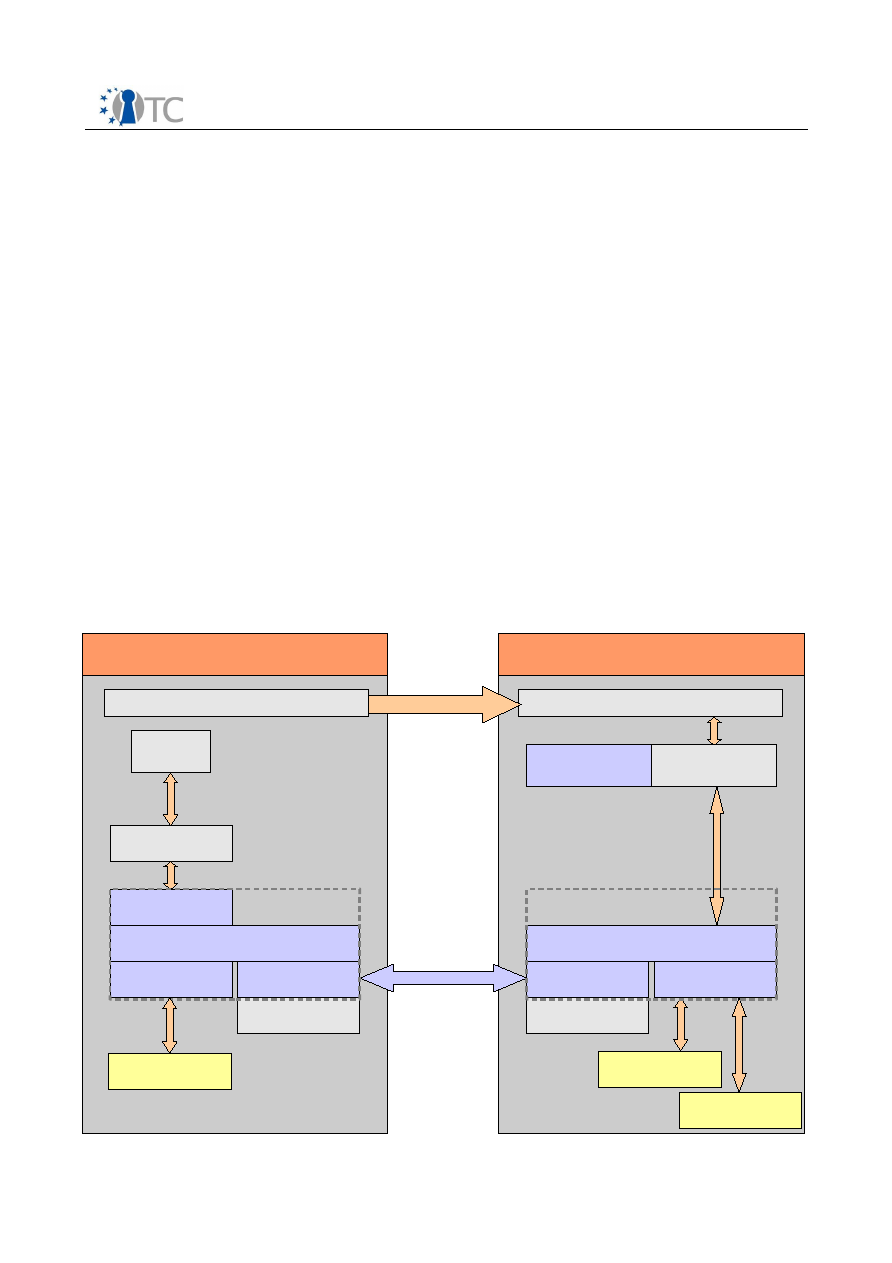
MFA Final System Specification
●
remote client platform attestation identities key (AIK) or user key (UK),
●
remote operating system (OS) and software set by platform configuration
registers (PCRs).
MFA System is based on the PAM Framework. The Pluggable Authentication Modules
(PAM) library is a generalized API for authentication-related services which allows a
system administrator to add new authentication methods simply by installing new PAM
modules and modifying authentication policies by editing special user policy
configuration files.
One of the goals of MFA implementation is easy integration with different services
that use pluggable authentication modules (PAM) for authentication without any
changes in applications/service source code on the servers and clients.
3.1
MFA system architecture
The MFA architecture includes two component types: MFA Server and MFA Client.
The client and server components are installed by the system administrator. After the
installation is completed the user has access to the client system and the system
administrator has access to server computer.
These components can run on on a single Linux box with TSS and TPM as well as on
top of the Open_TC framework. The MFA System Architecture is presented in the
Figure 1.
Open_TC Deliverable 6e.3
5/36
Figure 1: MFA System Architecture
MFA Client
MFA Server
Client application (ssh, ftp etc)
Server application (sshd, ftpd etc)
Application connection
MFA Client Manager
PAM Framework
PAM
Configuration
MFA PAM
Interconnect
library
Interconnect
library
Secure exchange
SSL library
SSL library
Configuration
library
Configuration
library
Servers DB
Client
credentials DB
TPM driver
MFA TPM library
Client
Policy DB
TSS Framework

MFA Final System Specification
MFA Server includes the following components:
●
Server application
– standard sshd, ftpd or other that realized required
service and support PAM framework;
●
MFA PAM
– is a PAM standard module. It is called directly by
service/application to authenticate users. The system uses the PAM possibilities
to add multifactor authentication/registration to the services. This module
communicates with MFA Client Manager;
●
PAM Configuration
– system file (one for each service) that describes the list
and sequences of the actions that called from PAM Framework;
●
Configuration library
– library that include functions to control User and
Platform Credentials, Policy Data Base;
●
Clients Credential and Policy DB
– database, that keep securely User and
Platform credentials and policy. It is a set of files and directories;
●
Interconnect library
– library of functions for interconnection within PAM MFA
module and MFA Client Manager;
●
External modules
:
○
TPM TSS
○
SSL library for work with keys and certificates.
MFA Client includes the following components:
●
Clients Application
– standard applications (ssh, ftp or etc.);
●
MFA Client manager
– a service that processes any request from the server,
to provide the information about client credentials, certificates and any user
platform data;
●
Configuration library
– library that include functions to control User Platform
Credentials and Policies;
●
Servers DB
– database, that keep registered Servers key (certificates). It is a
set of files;
●
Interconnect library
– library of functions for interconnection within PAM MFA
module and MFA Client Manager;
●
External modules
:
○
TPM TSS to access to the TPM;
○
SSL library for work with keys and certificates.
Client components perform the following tasks:
●
Process Server Requested actions to gather User TPM Credentials;
●
Interact with TPM through TSS stack;
●
Send data to the MFA PAM module on servers;
●
Log MFA System activity.
Server components perform the following tasks:
Open_TC Deliverable 6e.3
6/36
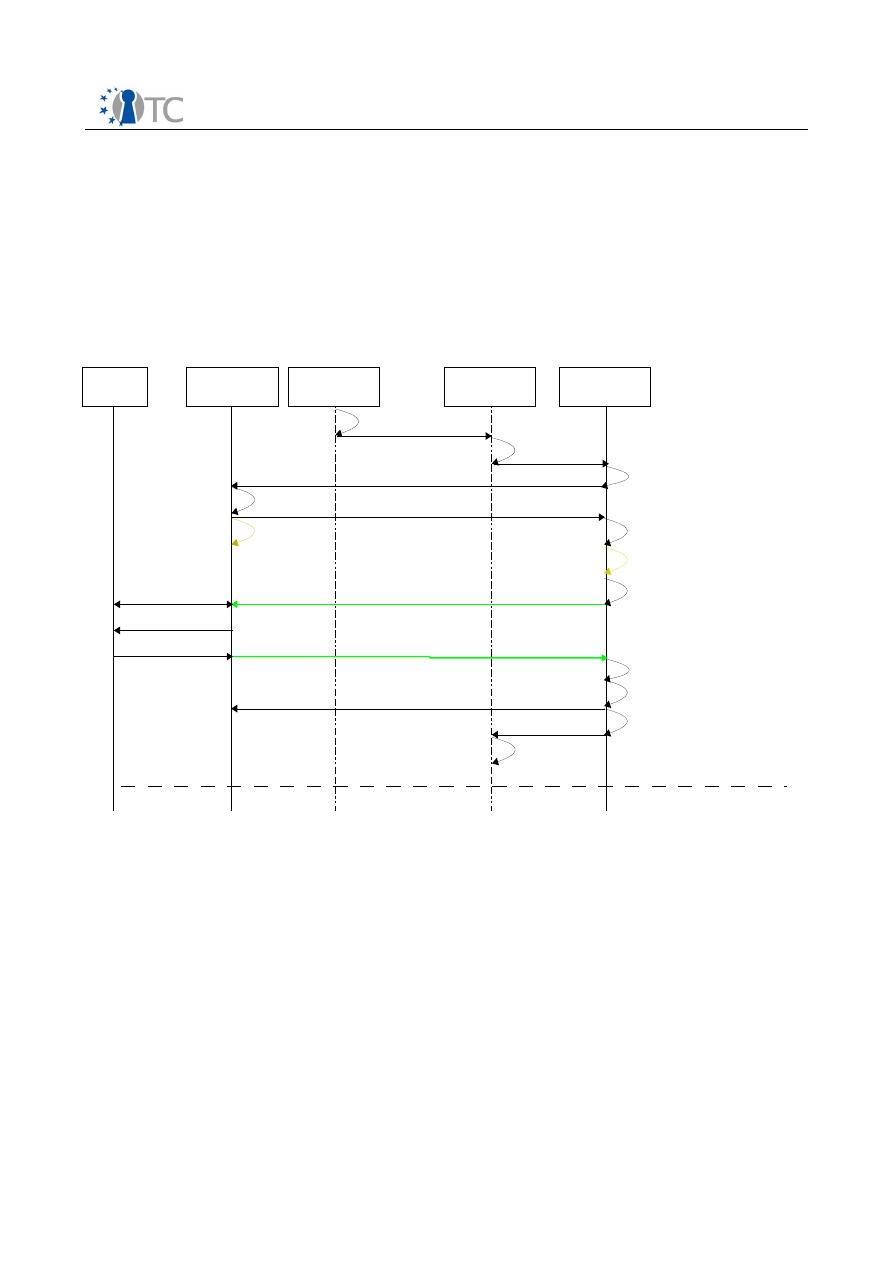
MFA Final System Specification
●
Authenticate and Register Client Platform & User;
●
Keep Client Platform/User database;
●
Control Credentials & Policy settings;
●
Interact with MFA Client Manager on client machine.
3.2
Client Authentication Protocol
Client/server message flow of the client authentication process is presented on the
Figure 2.
MFA server acts as one of pluggable authentication module and usage of it by different
applications can be configured in standard PAM configuration file.
When MFA PAM is started by application/service it does the next steps:
1. MFA PAM (Server side):
○
get call parameters: login name, application/service name, connection
properties;
○
check that user has configured policy to access to the service;
○
connect to MFA Client Manager on remote client;
○
exchange by public keys (certificates) with Client;
○
check that access to the requested service for the user from this Client is
allowed according configured policy;
○
send request for the client authentication platform and user credentials to
Open_TC Deliverable 6e.3
7/36
Figure 2: Client Authentication Protocol
Take User & Service name for Login
Call Service, Send Name
Start PAM
framework
Check: User name,
User policy ,
requested service, remote IP
Open connection, send Server name
Retrieve server public
key (certificate)
from DB
Send Client name
Check Client name, retrieve
User/platform policy, parameters
(key UUID, PCRS Index, pwd),
generate challenge
Retrieve registered Client
credentials from DB
Request Client Credentials according policy. Information encrypted
by Client Public key
Check TPM Status
Get Credentials(Quote)
Return Credentials
Send Client Credentials. Information encrypted by Server Public key
Close connection
Verify User/Platform Credentials
Return authentication
SUCCESS or FAILURE
Close PAM
framework
MFA Authentication finished
MFA Client
Manager
MFA Client
application
MFA Server
application
MFA PAM
TSS
Retrieve client public key
(certificate) from DB
Validate certificate
Validate certificate
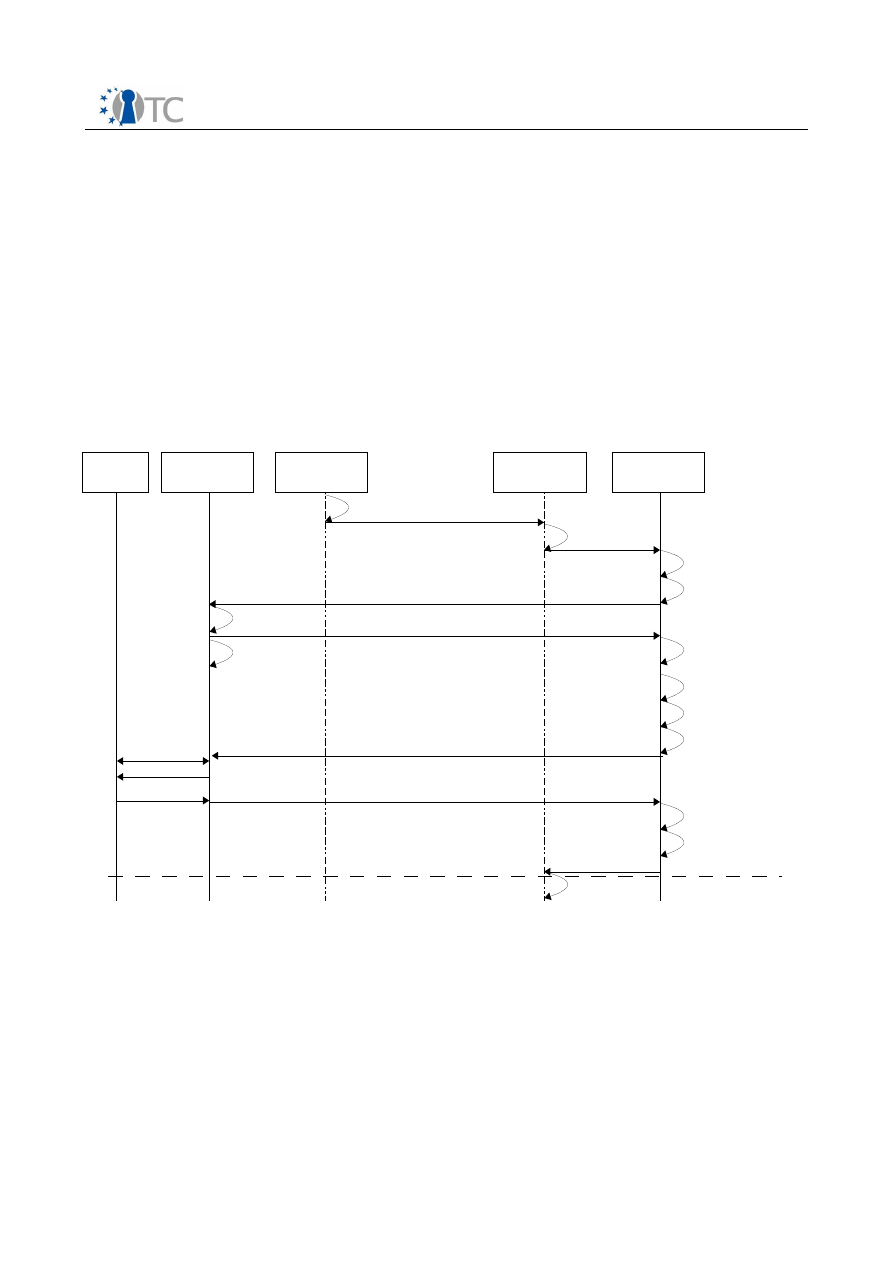
MFA Final System Specification
MFA Client Manager.
○
MFA Client Manager (Client side):
○
check that the remote Server is registered and enabled in the Client
configuration (during registration process);
○
create the client platform credentials according Server request policy;
○
send encrypted credential information to the Server.
2. MFA PAM (Server side):
○
retrieve from Configuration registered reference platform credentials and
compare with credentials received from client;
○
return PAM_SUCCESS or PAM_AUTH_ERR;
○
in case PAM_SUCCESS the user logon to the service/application is completed
and service/application can be used by user on the Server;
○
close connection to MFA Client Manager
.
Client Registration Protocol
Client/server message flow of the client authentication process is presented on the
Figure 3.
Main task of registration procedure is to collect user and platform client credentials for
future logon to the remote service and be sure that we got information exactly from
computer about we think.
Before starting the registration:
•
server has to be installed server part of MFA PAM system;
Open_TC Deliverable 6e.3
8/36
Figure 3: Client Authentication Protocol
Take User & Service name for Login
Call Service, Send Name
Start PAM
framework
Retrieve User
policy from DB
Check: User name,
Requested service,
Remote IP
Open connection, send Server name
Retrieve server
public key or
certificate from DB
Send Client name
Check Client name
and User policy
Retrieve Registered
Client Credentials
from DB
Request Client Credentials (transfered encrypted by Client Public key)
Check TPM Status
Request TPM Credentials
Send Signed Credentials
Send Client Credentials (Information transfered encrypted by Server Public key)
Close connection
Validate User/platform
Credentials
Return authentication
SUCCESS or FAILURE
Close PAM
framework
MFA Authentication finished
MFA Client
Manager
MFA Client
application
MFA Server
application
MFA PAM
TSS
Retrieve client
public key or
Certificate from DB,
Validate certificate
(through CA)
Validate certificate
(through CA)
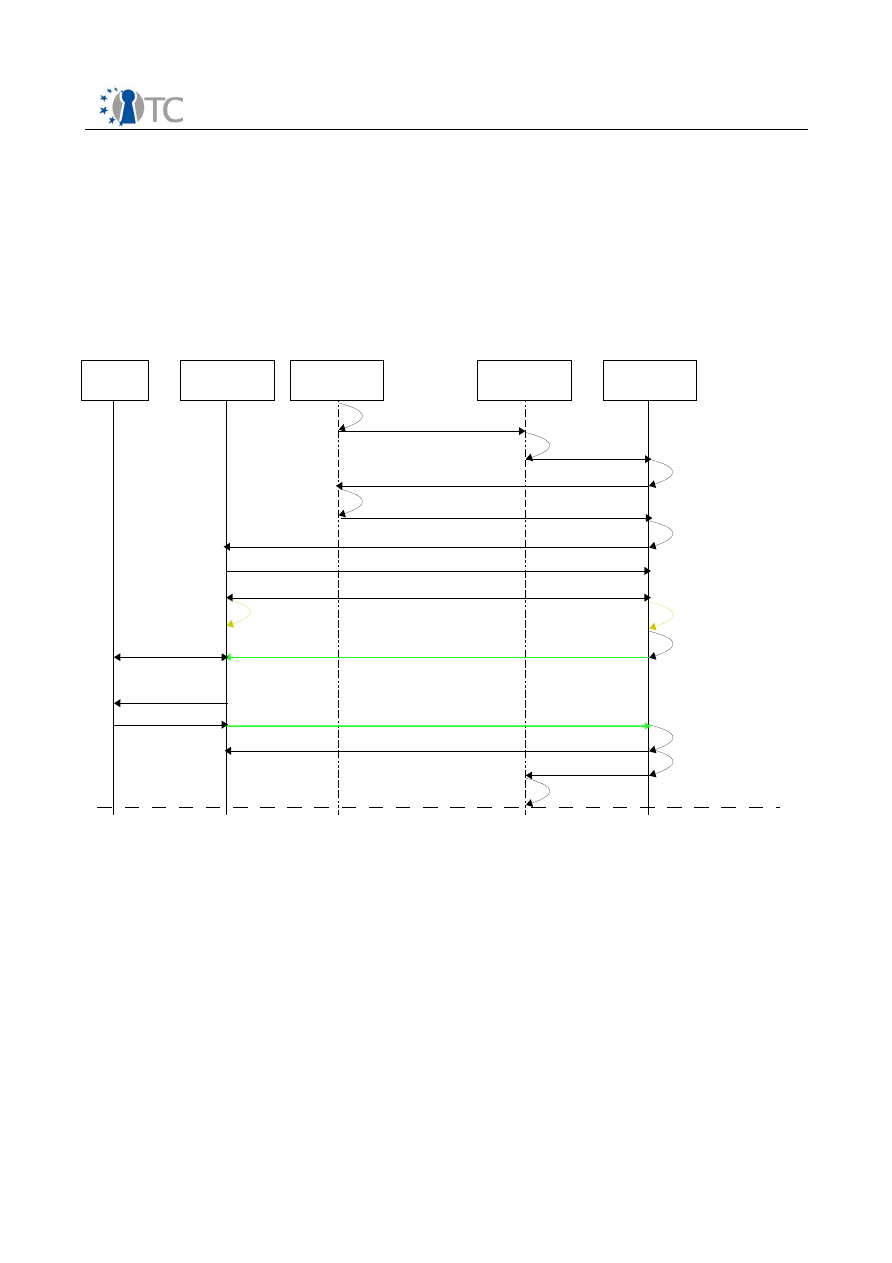
MFA Final System Specification
•
client computer has installed TSS;
•
client computer has installed client part of MFA PAM system;
•
client and server have installed their own public key (certificates);
•
in the case of usaging AIKs, the client has to have own AIK (AIK certificate).
As the first step of registration user (U) need to connect with server administrator (SA)
(by defined for server or organization procedure) and describe his computer, installed
software, required services, scheduler of services usage and etc. If server
administrator approve user's request registration procedure could be started.
Registration steps:
1. SA: add new login name (if necessary), add registration ticket and policy for
new client computer for MFA server configuration: set available services, usage
policy and registration password;
2. SA: inform user about user login name, standard and registration passwords;
3. U (or user computer administrator – based on organization policy): check
condition of client computer, OS and other software;
4. U: start one of possible console-based client application (for example: ssh) with
registration user name (reg_<user name>) and server name or IP as
parameters;
5. MFA PAM (server side):
○
get call parameters: login name, application/service name, connection
Open_TC Deliverable 6e.3
9/36
Figure 4: Client Registration Protocol
Take User for Registration
Call Service, Send Name
Start PAM
framework
Check User name,
User policy,
remote IP
Open connection, send Server name
Send Client name
Request Client Credentials according policy.
Information encrypted by Client Public key
Check TPM Status
Create Credentials,:
(Platform key, Pcrs,
key UUID)
Send Client Credentials. Information encrypted by Server Public key
Validate User/platform
Credentials and save it
Return authentication
FAILURE (No logon)
Close PAM
framework
MFA Registration finished
MFA Client
Manager
MFA Client
application
MFA Server
application
MFA PAM
TSS
Exchange by public keys (certificates)
Validate certificate
Save key( certificate)
Validate certificate
save key (certificate)
Delete registration
ticket
Request Registration password
Send Registration password
Type Registration
password by User
Verify registration
password
Check Client name,
retrieve User and
Platform policy
(PCRS Index, pwd).
Close connection
Return Credentials
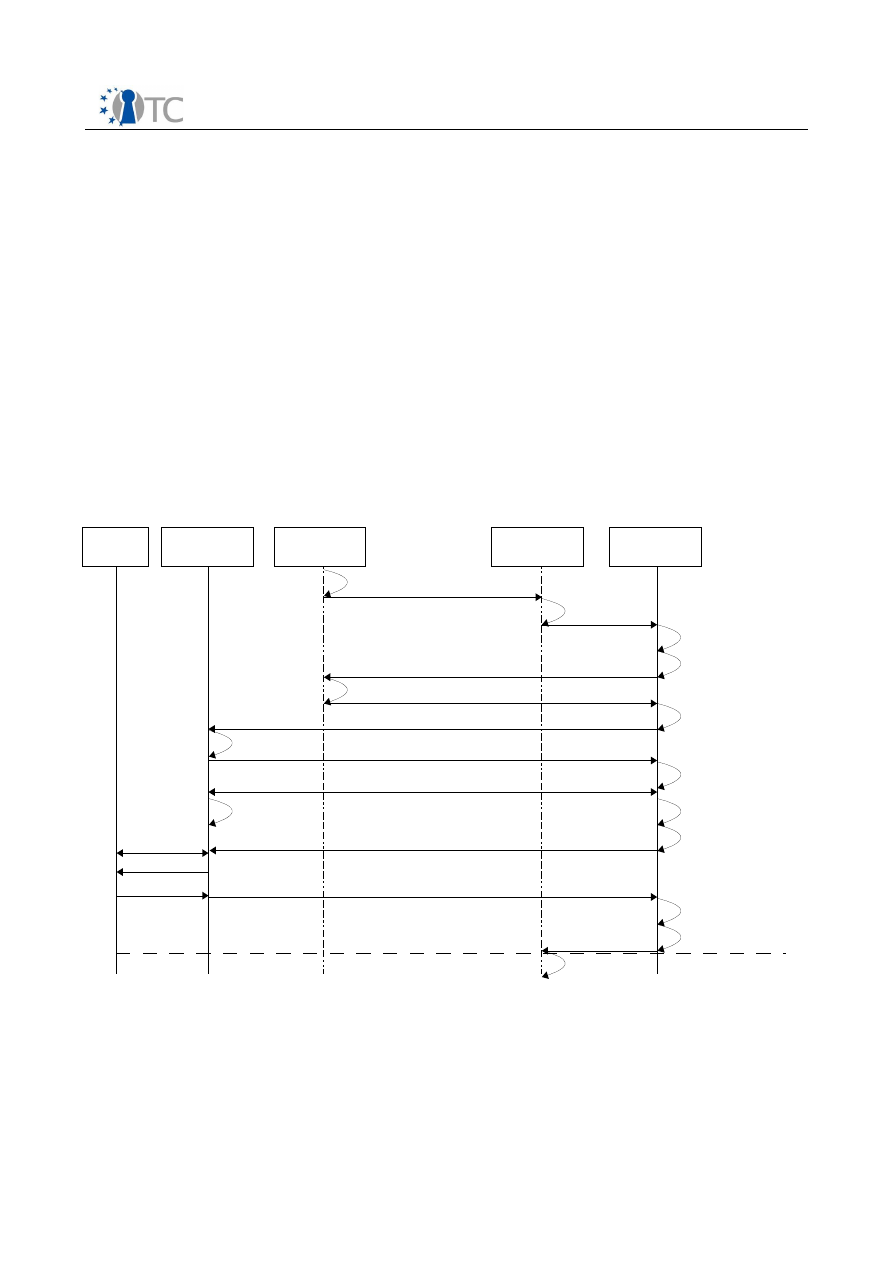
MFA Final System Specification
properties;
○
check that connection with call parameters is possible according to
configured policy;
○
exchange public keys (certificates) with Clients;
○
send request to MFA Client Manager for new user client and platform
credentials, according to policy.
6. MFA Client Manager (client side):
○
exchange public keys (certificates) with Server;
○
collect user platform credentials according server request and policy,
○
send collected credentials to the server.
7. MFA PAM (server side):
○
validate user and client platform credentials and store it in the Configuration
DB;
○
return PAM_AUTH_ERR;,
○
close connection to MFA client manager.
8. Registration procedure finished.
Policies
The policy determines what type authentication is required to access the remote
service. Remote platform credential based on:
●
client platform attestation identities key (AIK) or user key (UK);
●
operating system (OS) and software set by platform configuration registers
Open_TC Deliverable 6e.3
10/36
Figure 5: Client Registration Protocol
Take User & Service name for Registration
Call Service, Send Name
Start PAM
framework
Retrieve User
policy from DB
Check that User name
is OK for registration,
check Remote IP
Open connection, send Server name
Retrieve server
public key or certificate
from DB
Send Client name
Check Client name
and User policy
Request Client Credentials (transfered encrypted by Client Public key)
Check TPM Status
Create/Request TPM Credentials
Send Signed Credentials
Send Client Credentials (Information transfered encrypted by Server Public key)
Validate User/platform
Credentials and save it
Return authentication
FAILURE
Close PAM
framework
MFA Registration finished
MFA Client
Manager
MFA Client
application
MFA Server
application
MFA PAM
TSS
Exchange by keys or certificates (if necessary)
Validate certificate
(through CA).
Save certificate
Validate certificate
(through CA).
Save certificate
Close connection,
delete registration
ticket
Request Registration password
Send Registration password
Type Registration
password by User
Verify registration
password
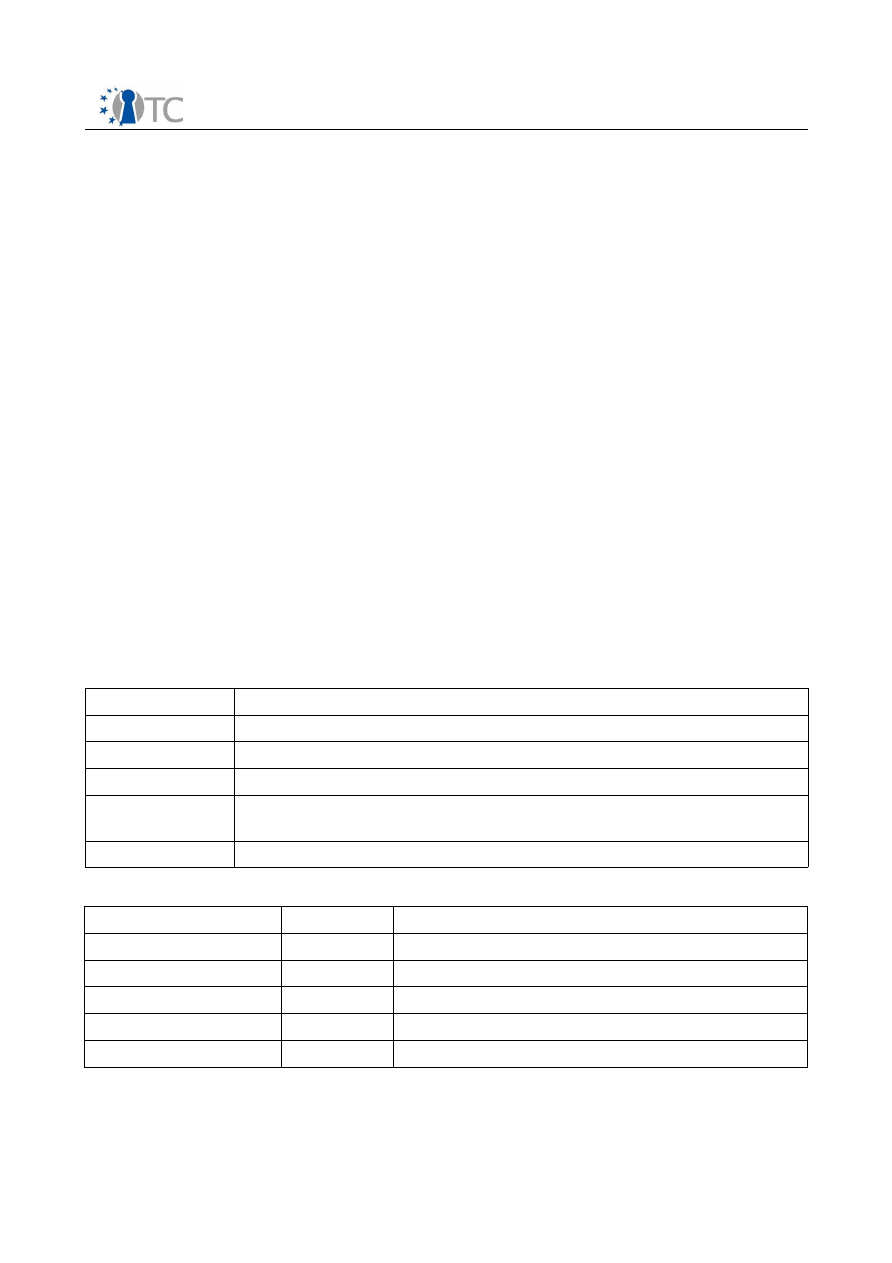
MFA Final System Specification
(PCRs).
3.2.1
Registration tickets
Registration tickets is used for registration process and define registration policy. It
contains following main parts:
●
count of possible client platform could be registered for the user;
●
user registration password;
●
configuration of Client platform credential-policy;
●
list of available services for user from the client platform.
4
MFA System API
MFA Prototype is implemented as a set of libraries that could be used for developing
other MFA applications. This chapter describes developed API from low level up to high
level functions.
4.1
Data Types
This section describes the basic data types defined by this API.
Pointer Size:
Pointer size becomes 32 bits on 32-bit systems and 64 bits with 64-bit system.
Basic Types:
There are some new types for 64-bit systems that were derived from the basic C
language integer and long types, so they work in existing code. These are the
expected values and definitions.
Type
Definition
UINT16
Unsigned INT16
UINT32
Unsigned INT32
BYTE
Unsigned character
MFA_UNICODE
MFA_UNICODE character. MFA_UNICODE characters are to be
treated as an array of 16 bits.
MFA_PVOID
void Pointer (32 or 64 bit depending on architecture)
Derived Types:
Type
Definition
Usage
INTERCONNECT_DATA
UINT32
Interconnect Object attributes
SERVER_RESULT
UINT32
result of a MFA interface command
CONFIG_RESULT
UINT32
result of a MFA interface command
INTERCONNECT_RESULT
UINT32
result of a MFA interface command
CLIENT_RESULT
UINT32
result of a MFA interface command
4.2
Data Structure Types
Open_TC Deliverable 6e.3
11/36

MFA Final System Specification
This section describes the structures defined by this API.
4.2.1
mfa_c_typeServiceList
This structure provides list of Service that works with MFA.
Definition:
typedef struct mfa_c_tdServicesList {
UINT16
Count;
char**
List;
} mfa_c_typeServicesList;
Parameters:
Count
Count of the Servces in the List
List
Pointer to List of MFA Services
mfa_c_typePCR
Definition:
typedef struct mfa_c_tdPCR {
UINT8
Number;
BYTE
Value[SHA_DIGEST_LENGTH];
} mfa_c_typePCR;
Parameters:
Number
Number of PCR
Value
Value of PCR
4.2.2
mfa_c_typePCRList
This structure provides list of MFA Client Platform PCRs.
Definition:
typedef struct mfa_c_tdPCRList {
UINT16
Count;
mfa_c_typePCR*
List;
} mfa_c_typePCRList;
Parameters:
Count
Count of the Platform configuration registers in PCR List
List
Pointer to List of Platform Configuration Register (PCR) numbers
4.2.3
mfa_c_typeRegTicket
This structure provides MFA authentication Policy String.
Definition:
typedef struct mfa_c_tdRegTicket {
int
TicketsCount;
char RegLogin[CONFIG_MAX_USERNAME_LENGTH + 1];
Open_TC Deliverable 6e.3
12/36

MFA Final System Specification
char RegPassword[CONFIG_MAX_REGPASS_LENGTH + 1];
mfa_c_typePCRList PCRs;
int KeyType;
mfa_c_typeServicesList ServicesList;
int TicketFile;
} mfa_c_typeRegTicket;
Parameters:
TicketsCount
Count of registration tickets
RegLogin
Registration user name
RegPassword
Plain registration password
PCRs
List of PCRs to save/check
KeyType
Type of key for signature: CONFIG_KEY_NONE | CONFIG_KEY_USER |
CONFIG_KEY_AIK
ServicesList
List of services available for user, service "ALL" - for all services
TicketFile
store of the open ticket file descriptor
4.2.4
mfa_c_typeUserPolicy
This structure provides information about MFA Client Platform and User data, including
credentials, services, state, policy and so on. It used with the functions:
mfa_server_GetUserCredential
and
mfa_server_SetUserCredentials
Structure contains policy and credential information for user and peer pair
Definition:
typedef struct mfa_c_tdUserPolicy {
CONFIG_TRUE_OR_FALSE
EnablePolicy;
int
PeerStatus;
char
Login[CONFIG_MAX_USERNAME_LENGTH + 1];
mfa_c_typePCRList
PCRs;
int
KeyType;
TSS_UUID
KeyUUID;
char*
KeyPasswordHEX;
mfa_c_typeServicesList ServicesList;
RSA*
RSAPublicKey;
} mfa_c_typeUserPolicy;
Parameters:
EnablePolicy
Enable or disable policy flag (TRUE or FALSE)
Peer status
CONFIG_PEER_(ENABLE|DISABLE|NOT_REGISTERED)
filled in by mfa_c_GetUserPolicy function
Login
login name
PCRs
list of PCRs numbers and values
Open_TC Deliverable 6e.3
13/36

MFA Final System Specification
KeyType
type of key for signature: CONFIG_KEY_NONE | CONFIG_KEY_USER |
CONFIG_KEY_AIK
Key UUID
KeyUUID;
KeyPasswordHEX
TPM key password HEX string
ServicesList
List of services available for user, service "ALL" - for all services
RSAPublicKey
RSA public key
4.2.5
mfa_ic_TypeContainnerHeader
Definition:
typedef struct mfa_ic_tdContainerHeader {
UINT16
Data_length;
BYTE
Flags;
BYTE
Data_SHA1[SHA_DIGEST_LENGTH];
} mfa_ic_typeContainerHeader;
Parameters:
Data_length
Size of data packet
Flags
INTERCONNECT_DATA_PLAIN
INTERCONNECT_DATA_RSA_ENCRYPT
Data_SHA1
Value of SHA1 of data packet
4.2.6
mfa_ic_TypeSocket
Main structure for interconnect communication functions.
Definition:
typedef struct mfa_ic_tdSocket {
int
Socket;
BYTE
Local_IP4[4];
in_port_t Local_Port;
BYTE
Remote_IP4[4];
in_port_t
Remote_Port;
int
Timeout;
char*
Remote_host_name;
EVP_PKEY*
Remote_public_key;
char*
Local_host_name;
EVP_PKEY*
Local_private_key;
size_t
Shared_key_size;
BYTE*
Shared_key;
} mfa_ic_typeSocket;
Parameters:
Socket
Open_TC Deliverable 6e.3
14/36

MFA Final System Specification
Socket handler
Local_IP4[4]
Local IP address for the socket
Local_Port
Local port for the socket
Remote_IP4
Remore IP address for the socket
Remote_Port
Remote port for the socket
Timeout
Connection timeout in seconds (default is INTERCONNECT_TIMEOUT)
Remote_host_name
Name of remote host
Remote_public_key
Public key of remote host
Local_host_name
Name of local host
Local_private_key
My private key
Shared_key_size
Size of shred key for symmetric encryption
Shared_key
Shared key for symmetric encryption
4.3
Interface definition
The syntax used in describing the MFA application is based on the common procedural
language constructs. Data types are described in terms of ANSI C.
4.3.1
MFA Server Functions
mfa_server_reg_InitializeConnection
Initialize a connection from server to the client during registration.
Definition
:
SERVER_RESULT mfa_server_reg_InitializeConnection(
mfa_ic_typeSocket* socket,
char* client_host,
char** client_name);
);
Parameters:
socket
Pointer to
mfa_ic_typeSocket
structure
client_host
DNS client name
client_name
Generated Client name
Return Values:
SERVER_RESULT
Open_TC Deliverable 6e.3
15/36

MFA Final System Specification
mfa_server_auth_InitializeConnection
Initialize a connection from server to the client during authentication.
Definition
:
SERVER_RESULT mfa_server_auth_InitializeConnection(
mfa_ic_typeSocket* socket,
char* client_host,
char** client_name);
);
Parameters:
socket
Pointer to
mfa_ic_typeSocket
structure
client_host
DNS client name
client_name
Generated Client name
Return Values:
SERVER_RESULT
mfa_server_ValidateUserCredential
This method sends request to client for credentials according to policy,
verifies credentials based on the matched and reference credentails, return Success,
or Failure.
Definition
:
SERVER_RESULT mfa_server_ValidateUserCredential(
mfa_ic_typeSocket* socket,
mfa_c_typeUserPolicy* policy,
char* client_name
);
Parameters:
socket
Pointer to
mfa_ic_typeSocket
structure
policy
Pointer to structure
mfa_c_typeUserPolicy
client_name
Client name
Return Values:
SERVER_RESULT
mfa_server_ObtainUserCredential
This method sends request to client for registration credentials according to policy.
Definition
:
SERVER_RESULT mfa_server_ObtainUserCredential(
mfa_ic_typeSocket* socket,
char* client_name,
mfa_c_typeRegTicket* reg_ticket,
mfa_c_typeUserPolicy* policy
);
Parameters:
Open_TC Deliverable 6e.3
16/36

MFA Final System Specification
socket
Pointer to
mfa_ic_typeSocket
structure
client_name
Client name
reg_ticket
Pointer to
mfa_c_typeRegTicket
structure
policy
Pointer to structure
mfa_c_typeUserPolicy
Return Values:
SERVER_RESULT
mfa_server_ClientAuthentication
This method performs the full cycle of remote User And Platform authentication.
Definition:
SERVER_RESULT mfa_server_ClientAuthentication(
char* client_name, //in
char* user_name, //in
char* service //in
);
Parameters:
client_name
Name of the client host platform
user_name
Client User Name, who wanted to be logged on
service
Service name
Return Values:
SERVER_RESULT
mfa_server_ClientRegistration
This method performs the full cycle of remote Platform User And Platform registration.
Definition:
SERVER_RESULT mfa_server_ClientRegistration(
char* client_host,
char* user_name,
char* reg_password
)
Parameters:
client_host
DNS n
ame of the client host platform, that should be registered
user_name
Client User Name, who wanted to be registered
reg_password
Password for registration
Return Values:
SERVER_RESULT
4.3.2
MFA Client Functions
Open_TC Deliverable 6e.3
17/36

MFA Final System Specification
mfa_ichl_NewTPMPublicKeyReply
Client Response to
mfa_ichl_NewTPMPublicKeyRequest
Definition:
INTERCONNECT_RESULT mfa_ichl_NewTPMPublicKeyReply(
mfa_ic_typeSocket* socket,
char*
key_password
);
Parameters:
socket
Pointer to
mfa_ic_typeSocket
structure
key_password
String with key password
Return Values:
INTERCONNECT_RESULT
mfa_ichl_QuoteReply
Retrieve information about user platform Credentials from TPM and send this
information to the server.
This function is called after server have sent
mfa_ichl_QuoteRequest.
Definition:
INTERCONNECT_RESULT mfa_ichl_QuoteReply(
mfa_ic_typeSocket* socket,
char* quota_param_str
);
Parameters:
socket
Pointer to
mfa_ic_typeSocket
structure
quota_param_str
String with requested parameters for quote action
Return Values:
INTERCONNECT_RESULT
mfa_ichl_QuoteRequest
This function has two mode:
1. request PCRs values from Client and put them to response_pcrs for registration,
2. request Signature of PCRs values for authentication and verify it (this mode is
used if response_pcrs == NULL).
Definition:
INTERCONNECT_RESULT mfa_ichl_QuoteRequest(
mfa_ic_typeSocket* ic_socket,
char* key_password_hex,
TSS_UUID key_uuid,
RSA* rsa_public_key,
mfa_c_typePCRList request_pcrs,
mfa_c_typePCRList* response_pcrs)
Parameters:
Open_TC Deliverable 6e.3
18/36

MFA Final System Specification
socket
Pointer to
mfa_ic_typeSocket
structure
key_password_hex
Pointer to Key Password
key_uuid
Key identificater
rsa_public_key
Pointer to Public key for signature verification
request_pcrs
mfa_c_typePCRList structure with Pcrs numbers that should be quote
response_pcrs
Pointer to the structure mfa_c_typePCRList with the value of the Pcrs
Return Values:
INTERCONNECT_RESULT
ClientSideAuthentication
This method performs the actions to get Platform User And Platform authentication
data.
Definition:
CONFIG_RESULT
ClientSideAuthentication(
mfa_ic_typeSocket* socket,
char* server_name)
Parameters:
socket
Pointer to
mfa_ic_typeSocket
structure
server_name
Server Name
Return Values:
CONFIG_RESULT
ClientSideRegistration
This method performs the actions to get Platform User And Platform registration data.
Definition:
CONFIG_RESULT
ClientSideRegistration(
mfa_ic_typeSocket* socket,
char* server_name)
Parameters:
socket
Pointer to
mfa_ic_typeSocket
structure
server_name
Server Name
Return Values:
CONFIG_RESULT
4.3.3
MFA Channel Module Functions
mfa_ic_OpenConnection
This method open connection to remote host.
Open_TC Deliverable 6e.3
19/36

MFA Final System Specification
Definition:
INTERCONNECT_RESULT mfa_ic_OpenConnection
(
char*
remote_host_name, // in
in_port_t
remote_port,
// in
mfa_ic_type_Socket* socket
// out
);
Parameters:
remote_host_name
Remote host name or IP
remote_port
Port on remote host we connect to
socket
Pointer to
mfa_ic_typeSocket
structure
Return Values:
INTERCONNECT_RESULT
ERROR
mfa_ic_ListenConnection
Bind and listen for incoming connections.
Definition:
INTERCONNECT_RESULT mfa_ic_ListenConnection(
in_port_t local_port,
// in
mfa_ic_typeSocket* socket
// out
);
Parameters:
local_port
Local Port for listen incoming connections
socket
Pointer to
mfa_ic_typeSocket
structure
Return Values:
INTERCONNECT_RESULT
mfa_ic_AcceptConnection
Accept incoming connection.
Definition:
INTERCONNECT_RESULT mfa_ic_
AcceptConnection
(
mfa_ic_typeSocket* s
ocket
// in/out
);
Parameters:
socket
Pointer to
mfa_ic_typeSocket
structure
Return Values:
INTERCONNECT_RESULT
mfa_ic_CloseSocket
Close socket.
Open_TC Deliverable 6e.3
20/36

MFA Final System Specification
Definition:
INTERCONNECT_RESULT mfa_ic_CloseSocket(
mfa_ic_typeSocket* Sock
et
// in/out
);
Parameters:
socket
Pointer to
mfa_ic_typeSocket
structure
Return Values:
INTERCONNECT_RESULT
mfa_ic_ShutdownSocket
Shutdown socket
Definition:
INTERCONNECT_RESULT mfa_ic_ShutdownSocket
(
mfa_ic_typeSocket* s
ocket
// in/out
);
Parameters:
socket
Pointer to
mfa_ic_typeSocket
structure
Return Values:
INTERCONNECT_RESULT
mfa_ic_SetPeerPublicKey
Associate Peer public key with the socket.
Definition:
INTERCONNECT_RESULT mfa_ic_SetPeerPublicKey
(
mfa_ic_typeSocket*
socket,
// in/out
char* peer_name
);
Parameters:
socket
Pointer to
mfa_ic_typeSocket
structure
peer_name
Name of remote host
Return Values:
INTERCONNECT_RESULT
mfa_ic_SetLocalPrivateKey
Associate Local Private key with the socket.
Definition:
INTERCONNECT_RESULT mfa_ic_SetLocalPrivateKey
(
mfa_ic_typeSocket*
socket,
// in/out
);
Parameters:
Open_TC Deliverable 6e.3
21/36

MFA Final System Specification
socket
Pointer to
mfa_ic_typeSocket
structure
Return Values:
INTERCONNECT_RESULT
mfa_ic_WriteToSocket
Write buffer to socket with encryption (if encryption flag set).
Definition:
I
NTERCONNECT_RESULT mfa_ic_WriteToSocket(
mfa_ic_typeSocket* socket,
// in
UINT16 buffer_size,// in
BYTE* buffer,
// in
BYTE flags
// in
);
Parameters:
socket
Pointer to
mfa_ic_typeSocket
structure
buffer_size
Size of buffer for transfer
buffer
Data for transfer
flags
Set of write operation flags, possible values:
INTERCONNECT_DATA_PLAIN
INTERCONNECT_DATA_ENCRYPT_BY_PUBLIC_KEY
INTERCONNECT_DATA_ENCRYPT_BY_SHARED_KEY
INTERCONNECT_DATA_SIGN_BY_PRIVATE_KEY
);
Return Values:
INTERCONNECT_RESULT
mfa_ic_ReadFromSocket
Read into buffer from socket with encryption (if encryption flag set).
Buffer is allocated inside function.
Definition:
I
NTERCONNECT_RESULT mfa_ic_ReadFromSocket(
mfa_ic_typeSocket* socket,
// in
UINT16* buffer_size,// in
BYTE** buffer,
// in
BYTE* flags
// in
);
Parameters:
socket
Pointer to
mfa_ic_typeSocket
structure
buffer_size
Size of received data
buffer
Received data
flags
Set of received transfer flags, possible values:
Open_TC Deliverable 6e.3
22/36

MFA Final System Specification
INTERCONNECT_DATA_PLAIN
INTERCONNECT_DATA_ENCRYPT_BY_PUBLIC_KEY
INTERCONNECT_DATA_ENCRYPT_BY_SHARED_KEY
INTERCONNECT_DATA_SIGN_BY_PRIVATE_KEY
Return Values:
INTERCONNECT_RESULT
mfa_ichl_SendMyKey
Take local public key (or certificate or AIK) in PEM format from Configuration and send
it to peer.
Definition:
INTERCONNECT_RESULT mfa_ichl_SendMyKey(
mfa_ic_typeSocket* socket
);
Parameters:
socket
Pointer to
mfa_ic_typeSocket
structure
Return Values:
INTERCONNECT_RESULT
mfa_ichl_RecvAndSavePeerKey
Receive peer key (or certificate or AIK) in PEM format, compare with local one
(if exists) and store it.
Definition:
INTERCONNECT_RESULT mfa_ichl_RecvAndSavePeerKey(
mfa_ic_typeSocket* socket,
char* peer_name
);
Parameters:
socket
Pointer to
mfa_ic_typeSocket
structure
Return Values:
INTERCONNECT_RESULT
mfa_ichl_NewTPMPublicKeyRequest
This method sends request to client for creating Pubic key, that will represent platform
Definition:
SERVER_RESULT
mfa_ichl_NewTPMPublicKeyRequest(
mfa_ic_typeSocket* socket, //in
char** new_key_password_hex,//out
TSS_UUID* new_key_uuid,//out
RSA** rsa_public_key //out
);
Parameters:
socket
Pointer to
mfa_ic_typeSocket
structure
key_password_hex
Pointer to Key Password
Open_TC Deliverable 6e.3
23/36

MFA Final System Specification
key_uuid
Key unique identificater
rsa_public_key
Pointer to Public key
Return Values:
INTERCONNECT_RESULT
mfa_ic_ErrorString
Error code to string
Definition:
void mfa_ic_ErrorString(
INTERCONNECT_RESULT error_code,
char* error,
int err_string_size
);
Parameters:
error_code
Error code
error
Error string
err_string_size
Error string size
4.3.4
MFA Credentials and Policy Configuration Functions
mfa_db_GetUserCredential
This Method retrieves user reference credentials and policy from DB on the server for
the authentication.
Definition
:
SERVER_RESULT mfa_db_GetUserCredential(
char* client_name,
char* user_name,
char* service,
mfa_c_typeUserPolicy** policy
);
Parameters:
client_name
Client name
user_name
User name
service
Requested service
policy
Pointer to structure
mfa_c_typeUserPolicy
Return Values:
SERVER_RESULT
mfa_db_GetUserCredentialParam
The Method retrieves the user registration ticket from DB on the server.
Open_TC Deliverable 6e.3
24/36

MFA Final System Specification
Definition
:
SERVER_RESULT mfa_server_GetUserCredentialParam(
char* client_host,
char* user_name,
char* reg_password,
mfa_c_typeRegTicket** ticket
);
Parameters:
client_host
DNS client name
user_name
User name
reg_password
Registration password
ticket
Pointer to structure
mfa_c_typeRegTicket
Return Values:
SERVER_RESULT
mfa_db_SaveUserCredentials
This method save User registration credentials in DB
Definition:
SERVER_RESULT mfa_db_SaveUserCredential(
char* user_name,
char* client_name,
mfa_c_typeUserPolicy policy
);
Parameters:
user_name
Client User Name, who wanted to be logged on
client_name
Name of the client host platform
policy
S
tructure
mfa_c_typeUserPolicy
Return Values:
SERVER_RESULT
mfa_c_
CheckClientSideConfiguration
This method checks a client side configuration.
Definition:
CONFIG_RESULT mfa_c_CheckClientSideConfiguration();
Return Values
:
CONFIG_RESULT
mfa_c_
CheckServerSideConfiguration
This method checks a server side configuration
Definition:
CONFIG_RESULT mfa_c_CheckServerSideConfiguration();
Open_TC Deliverable 6e.3
25/36

MFA Final System Specification
Return Values
:
CONFIG_RESULT
mfa_c_IsPeerEnabled
This method checks that peer is enabled. On success return CONFIG_SUCCESS
else return peer status (CONFIG_PEER_DISABLED or CONFIG_PEER_NOT_REGISTERED).
Definition:
CONFIG_RESULT mfa_c_IsPeerEnabled(
char* peer_host_name)
Parameters:
peer_host_name
Pointer to String with host name
Return Values:
CONFIG_RESULT
mfa_c_EnablePeer
This method enables peer. By default registered peer is enabled.
Definition:
CONFIG_RESULT mfa_c_EnablePeer(
char* peer_host_name)
;
Parameters:
peer_host_name
Pointer to String with host name
Return
Values
:
CONFIG_RESULT
mfa_c_DisablePeer
This method disable peer.
Definition:
CONFIG_RESULT mfa_c_DisablePeer(
char* peer_host_name,
char* disable_reason
);
Parameters:
peer_host_name
Pointer to String with host name
disable_reason
Pointer to String with the reason
Return
Values
:
CONFIG_RESULT
mfa_c_GetRegTicket
Get registration ticket for user_name.
Open_TC Deliverable 6e.3
26/36

MFA Final System Specification
after success return ticket the file opened and locked and must be closed by
mfa_c_CloseRegTicketFile
Definition:
CONFIG_RESULT mfa_c_GetRegTicket(
char* user_name,
mfa_c_typeRegTicket** ticket
);
Parameters:
user_name
User name
ticket
Pointer to the mfa_c_typeRegTicket structure
Return Values
:
CONFIG_RESULT
mfa_c_SetRegTicket
Set registration ticket for user_name.
After success return ticket the file opened and locked and must be closed by
mfa_c_CloseRegTicketFile
.
Definition:
CONFIG_RESULT mfa_c_SetRegTicket(
char* user_name,
mfa_c_typeRegTicket* ticket
);
Parameters:
user_name
User name
ticket
mfa_c_typeRegTicket structure
Return
Values
:
CONFIG_RESULT
mfa_c_SetUserPolicy
This method set user policy and save credentials for peer. Before set policy it checks
the peer is registered and enabled. If policy == NULL delete policy file.
Definition:
CONFIG_RESULT mfa_c_SetUserPolicy(
char* user_name,
char* peer_host_name,
mfa_c_typeUserPolicy policy
);
Parameters:
user_name
String with user name
peer_host_name
String with host name
Policy
Structure
mfa_c_typeUserPolicy
Open_TC Deliverable 6e.3
27/36

MFA Final System Specification
Return Values
:
CONFIG_RESULT
mfa_c_GetUserPolicy
This method gets user policy and credentials for peer. If policy == NULL returns new
objects otherwise reuse existing object.
Definition:
CONFIG_RESULT mfa_c_GetUserPolicy(
char* user_name,
char* peer_host_name,
mfa_c_typeUserPolicy ** policy
);
Parameters:
user_name
String with user name
peer_host_name
String with host name
Policy
Pointer to structure
mfa_c_typeUserPolicy
Return
Values
:
CONFIG_RESULT
5
MFA System Prototype Component Description
The following components will be described in the document :
•
PAM Configuration (eg. for
sshd, ftpd
);
•
MFA PAM - Authentication Service-
pam_mfa.so
;
pam_mfa.so
include the following modules:
mfa_pam.c
- main PAM code;
server_side.c
- registration and authentication module;
interconnect_lib.c - low level interconnect functions library;
interconnect_hl_lib.c - high level interconnect functions library
config_llc_lib.c
- low level functions library to work with configuration;
config_lib.c
- high level function library to work with configuration;
mfa_errors.c
- error module;
log_lib.c
- logging functions module;
•
Utility for work with registration tickets -
mfa_reg_ticket
:
mfa_reg_ticket.c
- main executable file;
config_lib.c
- high level function library to work with configuration;
config_llc_lib.c
- low level function library to work with configuration;
mfa_errors.c
- error module;
log_lib.c
- logging functions module;
•
MFA Client Manager –
mfa_client_manager
mfa_client_manager
includes the following modules:
Open_TC Deliverable 6e.3
28/36

MFA Final System Specification
mfa_client_manager.c- client side of the authentication and regstration
module;
interconnect_lib.c - low level interconnect functions library;
interconnect_hl_lib.c - high level interconnect functions library;
config_llc_lib.c
- low level functions library to work with configuration;
config_lib.c
- high level function library to work with configuration;
mfa_errors.c
- error module;
log_lib.c
- logging functions module.
5.1
PAM Configuration
The PAM Configuration is a system file, which is part of the PAM Framework. It
provides possibility to use multifactor user authentication and registration with ability
to authenticate entities based on arbitrary combination of credentials. Authentication
providers could create new method authentication compliant with PAM requirements
that will be available for authenticate a user.
For usage MFA PAM authentication the module mfa_pam.so must be added to PAM
configuration file for required service in to
auth
section. See PAM documentation for
more information.
Examples of PAM configuration files for sshd and ftpd services
:
/etc/pam.d/ftpd:
#
# $FreeBSD: src/etc/pam.d/ftpd,v 1.18 2003/04/30 21:57:54 markm Exp $
# PAM configuration for the "ftpd" service
# auth
auth
required
pam_nologin.so
no_warn
auth
sufficient
pam_opie.so
no_warn no_fake_prompts
auth
requisite
pam_opieaccess.so
no_warn allow_local
#auth
sufficient
pam_krb5.so
no_warn
#auth sufficient pam_ssh.so
no_warn try_first_pass
auth
required
pam_unix.so
no_warn try_first_pass
auth required pam_mfa.so
# account
#account required
pam_krb5.so
account
required
pam_unix.so
# session
session
required
pam_permit.so
/etc/pam.d/sshd:
#
# $FreeBSD: src/etc/pam.d/sshd,v 1.15 2003/04/30 21:57:54 markm Exp $
# PAM configuration for the "sshd" service
#
# auth
Open_TC Deliverable 6e.3
29/36

MFA Final System Specification
auth
required
pam_nologin.so
no_warn
auth
sufficient pam_opie.so
no_warn no_fake_prompts
auth
requisite pam_opieaccess.so
no_warn allow_local
#auth
sufficient pam_krb5.so
no_warn try_first_pass
#auth
sufficient pam_ssh.so
no_warn try_first_pass
#auth
required
pam_unix.so
no_warn try_first_pass
auth
required pam_mfa.so
# account
#account
required
pam_krb5.so
account
required
pam_login_access.so
account
required
pam_unix.so
# session
#session
optional
pam_ssh.so
session
required
pam_permit.so
5.2
MFA PAM Module
MFA PAM - Authentication/Registration Service is
pam_mfa.so
, configured locally on
the server with a PAM Configuration System files /etc/pam.d/* .
pam_mfa.so
- PAM
single shared library file that can be loaded by the PAM framework. The module
registers and authenticates user with TPM credentials depends on the user policy.
This module performs its actions by opening a connection with TPM on client computer
that requested PAM Service through interconnect library and sending the command to
MFA Client Manager according to authentication or registration protocols. It requests
MFA TPM credentials from client to register or authenticate user. It save requested
credentials in configuration data base using Configuration library.
Standard PAM authentication function format is:
pam_sm_authenticate(pam_handle_t *pamh, int flags, int argc, const char *argv[])
5.3
Client Credentials and Policy DB
Client Credentials and Policy DB is located in directories and subdirectories.
Two directories used to keep these data:
One for user/platform registration policy - /usr/local/etc/mfa_pam/regtickets.
Another for User/Platform policy and credentials - /usr/local/etc/mfa_pam/peers.
/usr/local/etc/mfa_pam/regtickets – directory with registration tickets, that describes
the policy for new users. Name of file with ticket is same as user name.
/usr/local/etc/mfa_pam/peers/<client name> - main configuration directory, that
contains the list of the clients, that registered to have access to the server services,
subdirectories contains registered clients and user credentials in files:
main files: peer.disable – if file exists peer disabled, files contain reason to be disabled
peer.certificate
- peer certificate in PEM format
peer.public_key
- peer public key in PEM format
Open_TC Deliverable 6e.3
30/36

MFA Final System Specification
<user name>.policy
- user policy and credentials
<Key UUID>.pub
- user public key in PEM format
<Key UUID>.cert
- user certificate in PEM format
5.4
MFA Client Manager
mfa_client_manager – application that executes commands that the server sends to
the client to perform authentication or registration. It communicates with server
through the interconnect library. It communicates with TPM service through the TSS
library.
It works according the registration or authentication protocol.
5.5
Low level interaction protocol
Description of interconnect protocol
5.5.1
Container
Container structure used for transfer data block (blob)
Offset
Content
0001
Data length
02
INTERCONNECT_DATA flags
0323
SHA1 160 of data
24END
data
5.5.2
Commands
The command system used to interact server and client through the channel:
REGISTRATION
<peer name>
start registration process from peer
AUTHENTICATION
<peer name> - start authentication process from peer
MY_NAME
<host name>
- send host name to peer
NEED_NEW_NAME
- ask Server to generate a new name for Client
YOUR_NAME
<new name>
- response on NEED_NEW_NAME request
MY_PUBKEY
<public key in PEM format>
- send public key in PEM format
MY_CERT
<certificate in PEM format>
- send certificate in PEM format>
MAKE_NEW_KEY
<new key password>
- request to make new TPM key with <password>
PUBLIC_KEY
<UUID>
<public key in PEM format>
- MAKE_NEW_KEY
response
TPM_REQUEST QUOTE
<parameters> - request for quote.
Parameters:
SIGN_KEY_UUID: <key uuid>
SIGN_KEY_PASSWD: <hex string with password>
CHALLENGE: <hex string with challenge>
PCRs: <pcrs list>
SEND_PCRs: YES
Open_TC Deliverable 6e.3
31/36

MFA Final System Specification
TPM_RESPONSE QUOTE
<parameters> - quote response
Parameters:
TPM_PCR_COUNT: <TPM pcrs count>\n
QUOTE_HEADER: <first 8 bytes or quote resoponse HEX\n
PCRs: <pcrs values>\n (in necessary)\n
QUOTE_SIGNATURE: <quote signature HEX>\n
TPM_REQUEST SIGN_CHALLENGE
- request for challenge signed by TPM
TPM_RESPONSE SIGN_CHALLENGE
- response with signed challenge
PING
<hex string with challenge>
- PING request
PONG
<hex string with challenge>
- Response on PING request
ERROR
- ERROR
QUIT
- close socket
5.5.3
Registration process
Server: Connect to Client
Server: REGISTRATION <server name>
Client: Check that Server isn't disabled by configuration
If Client does not have own name,
Client: REQ_NEW_NAME request
Server: NEW_NAME response
endif
Client: MY_NAME <client name>
Server: Check that Client is not disabled by configuration
Server: MY_PUBKEY\n<server public key in PEM format>
Client: MY_PUBKEY\n<client public key in PEM format>
Server: MAKE_NEW_KEY <key password> (encrypted)
Client: PUBLIC_KEY <UUID>\n<public key in PEM format> (encrypted)
Server: TPM_REQUEST QUOTE <parameters> (encrypted)
Client: TPM_RESPONSE QUOTE <parameters> (encrypted)
Server: QUIT
The sample of the registration protocol can be found in the source code:
doc\examples\protocol\registration_quote.txt
5.5.4
Authentication process
Server: Connect to Client
Server: AUTHENTICATION <server name>
Client: Check that Server isn't disabled by configuration
Client: MY_NAME <client name>
Server: Check that Client isn't disabled by configuration
Server: TPM_REQUEST QUOTE <parameters> (encrypted)
Client: TPM_RESPONSE QUOTE <parameters> (encrypted)
Server: QUIT
Open_TC Deliverable 6e.3
32/36

MFA Final System Specification
The sample of the authentication protocol can be found in the source code:
doc\examples\protocol\authentication_quote.txt
5.6
Utility for work with registration tickets
mfa_reg_ticket <command> <command option>
Possible commands:
add <user> Add ticket for user
change <user> Change ticket for user
Options for add or change:
[count=<tickets count>]
[password=<registration passwors>]
[tpmkeytype=(none|user|aik)]
[pcrs=<common separated PCRs numbers list>]
[services=<common list of services available for user>]
show <user> Show ticket for user
delete <user> Delete ticket for user
list List of available tickets
6
MFA prototype Installation instructions
To compile and install software you must have:
1. GCC
2. installed TSS (trousers 0.2.6) includes and libraries
3. PAM includes and libraries (only on the server)
4. GNU make
To install MFA prototype components on the clients:
1. copy tpm_mfa.tbz (bzip2 tar archive) client machines with TPM
2. unpack the archive file to some directory (archive_root_dir) by command
tar xjf mfa_pam.tbz C <source directory>
3. change current directory to <source directory>/mfa
4. edit Makefile.client and make necessary changes (C compile, path to TSS
libraries and includes)
5. compile mfa_client_manager by start command
gmake f Makefile.client mfa_client_manager
6. after successeful compitation executable file mfa_client_manager will be in
MFA/bin directory.
7. make directory /usr/local/etc/mfa_pam:
mkdir /usr/local/etc/mfa_pam
chmod 0700 /usr/local/etc/mfa_pam
cd /usr/local/etc/mfa_pam
8. make private key
openssl genrsa out my.key 2048
9. write public part of key
openssl rsa in my.key pubout out my.pub
10. set SRK password (if exists) to srk.passwd file,
echo "<SRK password>" > srk.passwd
11. copy mfa_client_manager execute file to place like /usr/local/sbin/,
Open_TC Deliverable 6e.3
33/36

MFA Final System Specification
cp <source dir>/MFA/bin/mfa_client_manager /usr/local/sbin/
To install MFA prototype components on the servers:
1. copy tpm_mfa.tbz (bzip2 tar archive) client machines with TPM
2. unpack the archive file to some directory (archive_root_dir) by command
tar -xjf mfa_pam.tbz -C <source directory>
3. change current directory to
<source directory>/mfa
4. edit Makefile.client and make necessary changes (C compile, path to TSS
libraries and includes)
5. compile mfa_client_manager by start command:
gmake f Makefile.server all
after successeful compitation executible file mfa_reg_ticket and shared PAM
module pam_mfa.so.1 will be in MFA/bin directory.
6. make directory /usr/local/etc/mfa_pam,
mkdir /usr/local/etc/mfa_pam,
chmod 0700 /usr/local/etc/mfa_pam
cd /usr/local/etc/mfa_pam
7. set server host name to file my.name,
echo "<server name>" > my.name
8. make private key,
openssl genrsa out my.key 2048
9. write public part of key,
openssl rsa in my.key pubout out my.pub
10. copy mfa_reg_ticket execute file to place like /usr/local/bin/,
cp <source dir>/MFA/bin/mfa_reg_ticket /usr/local/bin/
11. copy pam_mfa.so.1 to directory with PAM modules (/lib/security at LINUX
environment or /usr/lib/ in FreeBSD),
cd <source dir>/MFA/bin/pam_mfa.so.1 /lib/security/
12.edit PAM configuration for add pam_mfa.so module
13.make symbol link from pam_mfa.so.1 to pam_mfa.so,
cd /lib/security
ln s pam_mfa.so.1 pam_mfa.so
14.add new registration tickets by start mfa_reg_ticket utility
7
Usage of MFA prototype for registration and
authentication
7.1
Registration a new MFA user to the server
For Client platform registration execute any terminal-based application with enabled
PAM MFA at server with the next parameters:
●
user name: reg_<remote user name>;
●
server name or IP.
For example:
ssh reg_irina@server
7.2
Logon to the server
Open_TC Deliverable 6e.3
34/36

MFA Final System Specification
To logon to the remote server you needn't any addition parameters. Only execute
client application. For example:
ssh irina@server
7.3
MFA Prototype system list of files
Mfa list of files:
Makefile.client
Makefile.objects
Makefile.server
doc\install.txt
doc\interconnect_protocol.txt
doc\examples\pam.d
doc\examples\pam.d\ftpd
doc\examples\pam.d\sshd
doc\examples\protocol\authentication_no_tpm.txt
doc\examples\protocol\authentication_quote.txt
doc\examples\protocol\authentication_tpm_user_key.txt
doc\examples\protocol\registration_quote.txt
doc\examples\scripts\initialize_client.sh
doc\examples\scripts\initialize_server.sh
doc\examples\ssh\sshd_config
include\config_lib.h
include\config_llc_lib.h
include\credential.h
include\interconnect_hl_lib.h
include\interconnect_lib.h
include\log_lib.h
include\mfa_errors.h
include\mfa_pam.h
include\server_side.h
include\some_types.h
include\tpmless_lib.h
include\tpm_lib.h
src\config_lib.c
src\config_llc_lib.c
src\credential.c
src\interconnect_hl_lib.c
src\interconnect_lib.c
src\log_lib.c
src\mfa_client_manager.c
src\mfa_errors.c
src\mfa_pam.c
src\mfa_reg_ticket.c
src\server_side.c
src\tpmless_lib.c
src\tpm_lib.c
Open_TC Deliverable 6e.3
35/36
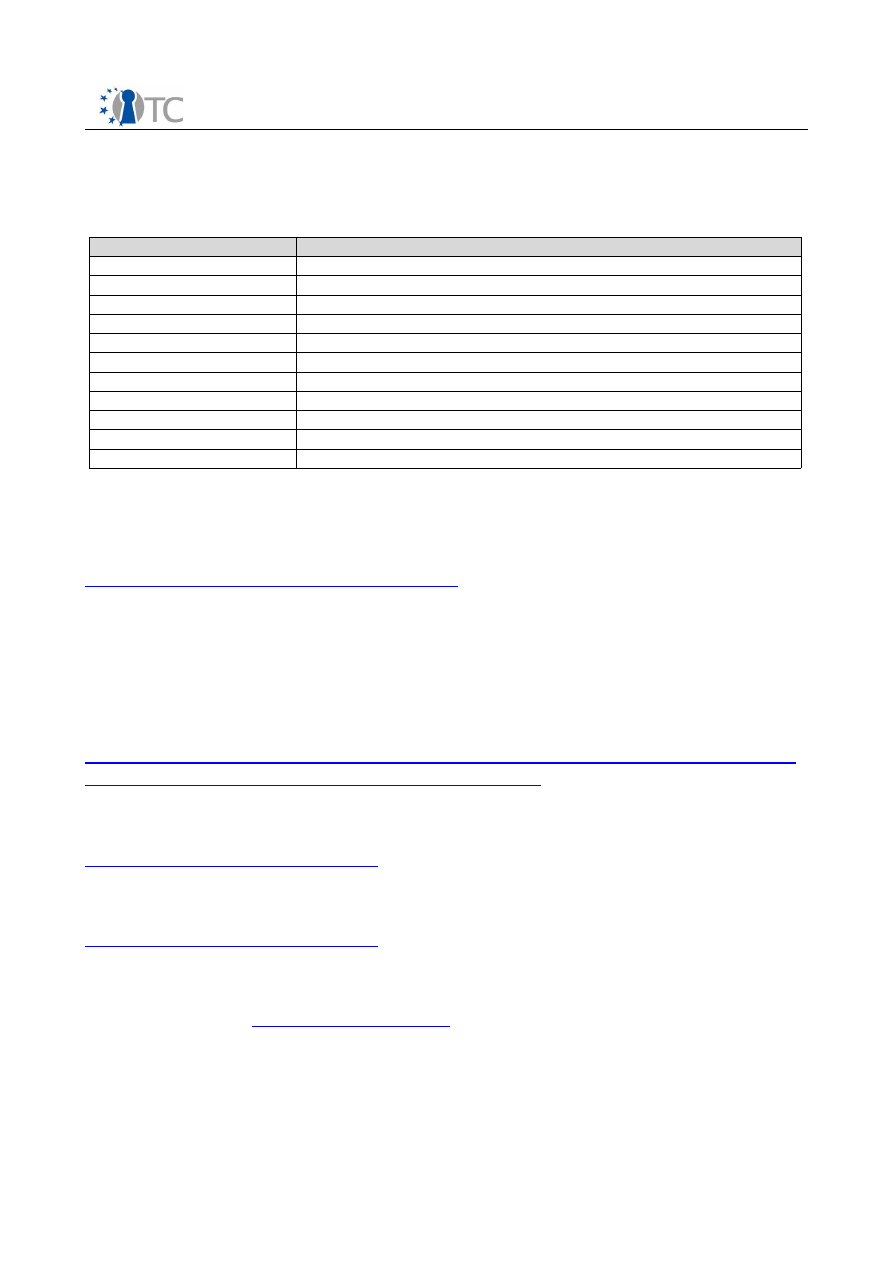
MFA Final System Specification
List of abbreviations
Listing of term definitions and abbreviations used in this document (IT expressions and
terms from the application domain).
Abbreviation
Explanation
AIK
Attestation Identity Key
API
Application Programming Interface
MFA
MultiFactor Authentication
OS
Operating System
PCR
Platform Configuration Register
SSL
Secure Sockets Layer
TC
Trusted Computing
TCB
Trusted Computing Base
TCG
Trusted Computing Group
TPM
Trusted Platform Module
TSS
Trusted Software Stack
8
Referenced Documents
/1/ TCG Specification, Architecture Overview.
http://www.trustedcomputing.org
April 28, 2004,
Version 1.2
/2/ TCG Software Stack (TSS) Specification
January 6, 2006,
Version 1.2
/3/ PAM
http://www.kernel.org/pub/linux/libs/pam/Linux-PAM-html/Linux-
PAM_ADG.html
http://msdn.microsoft.com
Version 0.99.6.0, 5. August 2006.
/4/ Secure Coding Guidelines
http://msdn.microsoft.com
2004
/5/ Improving Web Application Security: Threats and Countermeasures
http://msdn.microsoft.com
/6/ Writing Secure Code, Second Edition, by Michael Howard, David C. LeBlanc
/7/ OpenSSL Toolkit
www.openssl.org/
Open_TC Deliverable 6e.3
36/36
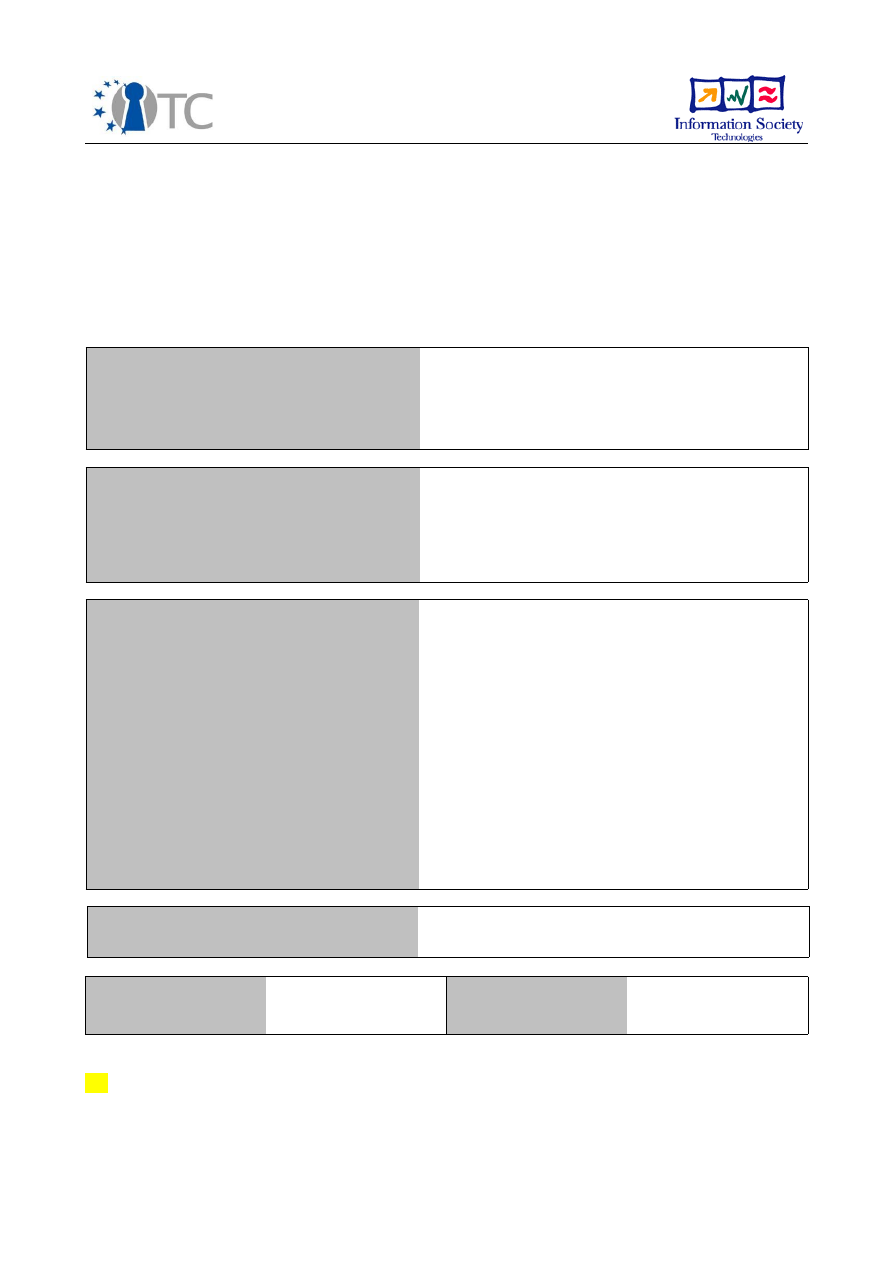
D6.3 Collection of all SWP deliverables (with
nature=R) produced during month 13-24
ANNEX
Project number
IST-027635
Project acronym
Open_TC
Project title
Open Trusted Computing
Deliverable type
Deliverable
Deliverable reference number
IST-027635/D06.3/FINAL | 1.00
Deliverable title
D6.3 Collection of all SWP deliverables (with
nature=R) produced during month 13-24
WP contributing to the deliverable
WP6
Due date
Oct 2007
Responsible Organisation
LDV,Lehrstuhl für Datenverarbeitung, TUM
Authors
Chun Hui Suen
Abstract
Keywords
OpenTC WP6
Dissemination level
Public
Revision
FINAL | 1.00
Instrument
IP
Start date of the
project
1
st
November 2005
Thematic Priority
IST
Duration
42 months
1.
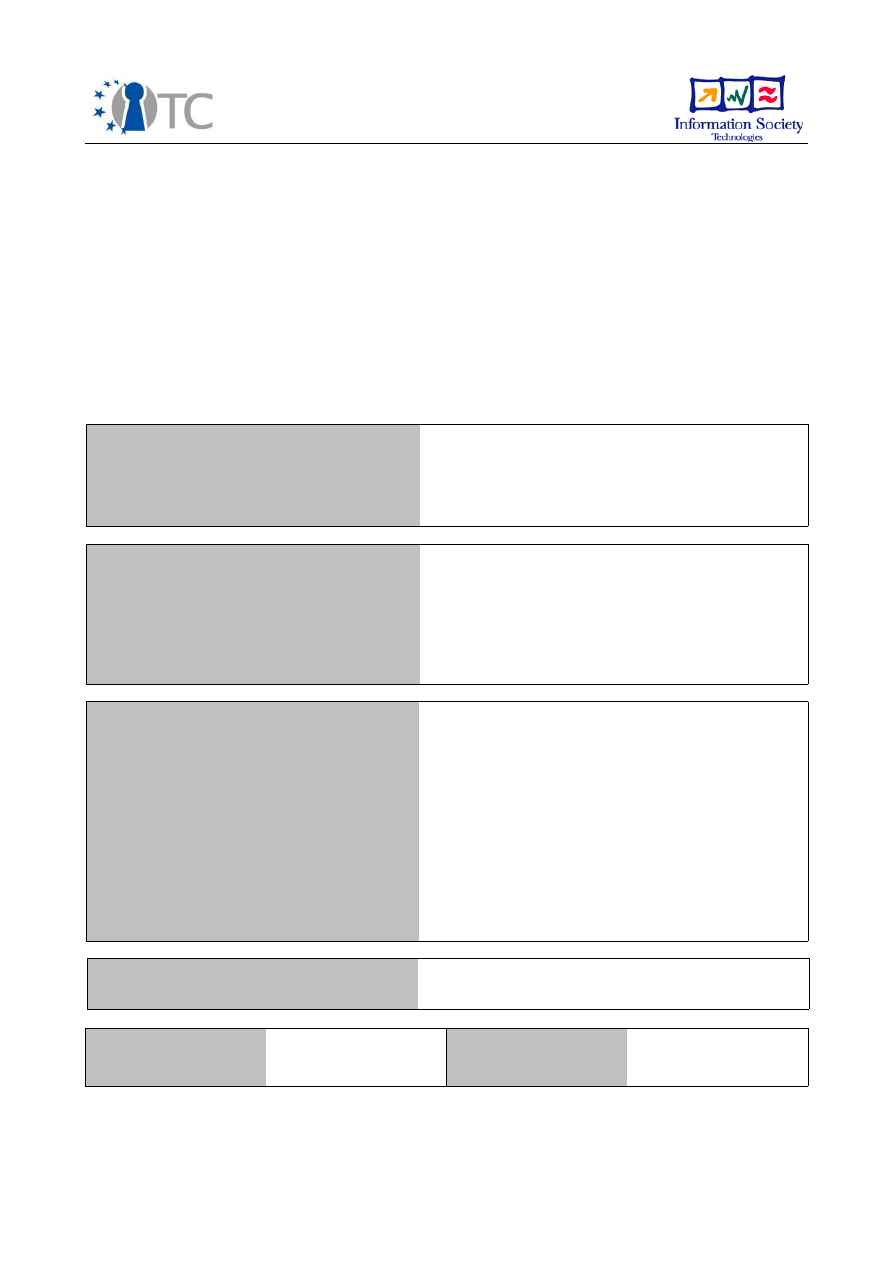
WP06d.1 Encrypted File Service
Application Programming Interface
Specification
Project number
IST-027635
Project acronym
Open_TC
Project title
Open Trusted Computing
Deliverable type
Deliverable
Deliverable reference number
IST-027635/D06d.1/Final/1.0
Deliverable title
WP06d.1: Compartmented Security
WP contributing to the deliverable
WP6d Trusted Computing Based Encrypted
File Service
Due date
Mar 2007
Actual submission date
April 2007
Responsible Organisation
PORT
Authors
Burak Oğuz, Baran Erdoğan, Bora Güngören
Abstract
Encrypted File Service comes with number of
features that are supported by trusted
computing infrastructure and Open Trusted
Computing enhancements for
compartmented operation on Xen and L4
hypervisors. EFS Application Programming
Interface(API) simplifies inclusion EFS
features in all type of applications
Keywords
Dissemination level
Public | Confidential
Revision
Instrument
IP
Start date of the
project
1
st
November 2005
Thematic Priority
IST
Duration
42 months

WP06d.1 Encrypted File Service C/C++ API Specification
Table of Contents
1 Introduction...............................................................................................................6
1.1 EFS Block Diagram.................................................................................................6
1.2 Target Audience.....................................................................................................6
1.3 API Method Description..........................................................................................7
1.4 Input Parameter Limitations...................................................................................9
1.5 Return Value Limitations........................................................................................9
1.6 OS Dependency......................................................................................................9
1.7 Abbreviations.........................................................................................................9
2 API Units...................................................................................................................11
2.1 Constants.............................................................................................................12
2.1.1 Return Types...................................................................................................12
2.1.1.1 SUCCESSFUL..............................................................................................12
2.1.1.2 FAILED.......................................................................................................12
2.1.1.3 NOT_IMPLEMENTED...................................................................................12
2.1.2 File Operation Types........................................................................................13
2.1.2.1 ENCRYPT....................................................................................................13
2.1.2.2 DECRYPT....................................................................................................13
2.1.2.3 SIGN..........................................................................................................13
2.1.2.4 VERIFY.......................................................................................................13
2.1.2.5 SHRED.......................................................................................................13
2.1.3 Encryption Algorithm Types.............................................................................14
2.1.3.1 AES-ECB ..................................................................................................14
2.1.3.2 AES-CBC....................................................................................................14
2.1.3.3 DES-ECB....................................................................................................14
2.1.3.4 DES-CBC....................................................................................................14
2.1.3.5 DESede-ECB..............................................................................................14
2.1.3.6 DESede-CBC..............................................................................................14
2.1.3.7 BLOWFISH..................................................................................................14
2.1.4 Key Types........................................................................................................16
2.1.4.1 KEY_BIND...................................................................................................16
2.1.4.2 KEY_SIGN...................................................................................................16
2.1.4.3 KEY_LEGACY..............................................................................................16
2.2 File Operations.....................................................................................................17
2.2.1 getLastCommandStatus..................................................................................17
2.2.2 hasOpenSession..............................................................................................18
2.2.3 openSession....................................................................................................19
2.2.4 checkUserPasswd............................................................................................20
2.2.5 fileOperation....................................................................................................21
2.2.6 decryptInVolatileMemory.................................................................................23
2.2.7 localFileRecovery.............................................................................................24
2.2.8 remoteRecovery..............................................................................................25
2.2.9 Sample CLI Commands for File Operations:.....................................................26
2.3 User Operations....................................................................................................27
2.3.1 listKeys............................................................................................................27
2.3.2 changeUserPasswd..........................................................................................28
2.3.3 listMACPolicies.................................................................................................29
2.3.4 listDACPolicies.................................................................................................30
2.3.5 setDACPolicy....................................................................................................31
Open_TC Deliverable
2/69

WP06d.1 Encrypted File Service C/C++ API Specification
2.3.6 resetDACPolicy................................................................................................32
2.3.7 setTrustedSignOnValue...................................................................................33
2.3.8 checkTrustedSignOn........................................................................................34
2.3.9 clearTrustedSignOnValue................................................................................35
2.4 Key Operations.....................................................................................................36
2.4.1 checkAdminPasswd.........................................................................................36
2.4.2 generateUserKey.............................................................................................37
2.4.3 addNewUserKey...............................................................................................38
2.4.4 deleteUserKey.................................................................................................39
2.4.5 RATrustedBackup............................................................................................40
2.4.6 trustedKeyBackup............................................................................................41
2.4.7 trustedKeyRestore...........................................................................................42
2.4.8 trustedKeyMigrate...........................................................................................43
2.4.9 trustedUserKeyBackup....................................................................................44
2.4.1 0trustedUserKeyRestore..................................................................................45
2.5 Recovery Agent Operations..................................................................................46
2.5.1 sendRARegistrationRequest............................................................................46
2.5.2 sendRAUnregistrationRequest.........................................................................47
2.5.3 recoveryAgentListUpdate................................................................................48
2.6 Recovery Server Operations.................................................................................49
2.6.1 distributeMACPolicies......................................................................................49
2.6.2 distributeRAPrivileges......................................................................................50
2.7 Administrative Operations....................................................................................51
2.7.1 listRegisteredPlatforms....................................................................................51
2.7.2 distributeMACPoliciesToSpecified....................................................................52
2.7.3 listRegistrationRequests..................................................................................53
2.7.4 listUnregistrationRequests...............................................................................54
2.7.5 permitRegistrationRequests............................................................................55
2.7.6 denyRegistrationRequests...............................................................................56
2.7.7 permitUnregistrationRequests.........................................................................57
2.7.8 denyUnregistrationRequests............................................................................58
2.7.9 listRecoveryRequests......................................................................................59
2.7.1 0permitRecoveryRequest................................................................................60
2.7.1 1denyRecoveryRequest...................................................................................61
2.7.1 2configureRS...................................................................................................62
2.7.1 3configureRSPolicy..........................................................................................63
2.7.1 4configureRAPrivilege......................................................................................64
3 Appendices : Other Public Classes ..........................................................................65
3.1 Appendix A : Platform Classes .............................................................................65
3.1.1 Platform...........................................................................................................65
3.1.2 PlatformResults................................................................................................66
3.2 Appendix B : Recovery Classes............................................................................67
3.2.1 RecoveryList....................................................................................................67
3.2.2 RecoveryResult................................................................................................68
3.3 Appendix C : Key Information Class......................................................................69
3.3.1 KeyInfo.............................................................................................................69
Open_TC Deliverable
3/69

WP06d.1 Encrypted File Service C/C++ API Specification
List of figures
Figure 1:EFS Building Blocks and Their interactions.......................................................7
Open_TC Deliverable
4/69

WP06d.1 Encrypted File Service C/C++ API Specification
List of Tables
Table 1:General structure of an API method entry.........................................................7
Table 2:Sample method definition..................................................................................7
Table 3:Explanation part of method...............................................................................8
Table 4:Input parameters explained in detail.................................................................8
Table 5:Return value......................................................................................................8
Table 6:Dependency.......................................................................................................8
Table 7:Sample usage scenarios....................................................................................9
Table 8:Abbreviations Table.........................................................................................10
Table 9:Platform Class Declaration...............................................................................65
Table 10:PlatformResults Class Declaration.................................................................66
Table 11:RecoveryList Class Declaration......................................................................67
Table 12:RecoveryResult Class Declaration..................................................................68
Table 13:KeyInfo Class Declaration..............................................................................69
Open_TC Deliverable
5/69

WP06d.1 Encrypted File Service C/C++ API Specification
1
Introduction
Encrypted File Service comes with number of features that are supported by trusted
computing infrastructure and Open Trusted Computing enhancements for
compartmented operation on Xen and L4 hypervisors. These features are also useful
by application programmers whom may want to use EFS functionalities on their
programs and may want to use trusted security service for ensuring trusted secure
data storage for their programs.
EFS Application Programming Interface(API) simplifies inclusion EFS features in all type
of applications
EFS API is a communication interface between EFS Core Service and applications. All
inputs and output messages shall be handled externally by applications using it.
Service related messages will be given as output parameter to API calling function.
1.1 EFS Block Diagram
EFS is composed of three main building blocks :
1. EFS Core : This block is the main operator block which manages file,key and
recovery operations for each platforms. Also responsible from administrative
tasks in non-networked environments.
2. EFS Recovery Server : Recovery Server manages recovery and administrative
operations in networked environments.
3. EFS API : API is responsible for establishing communication between user
interface (which is also an application) and EFS Core.
This relationship is shown in Figure 1
1.2 Target Audience
This document is written for application developers who are interested in using EFS's
features. In order to use this API, developer should have basic data security and
trusted computing knowledge. Furthermore, developer should know how to handle
passwords and other user-oriented important data. Also developer should have
knowledge on importing and using other API's in their source code.
Open_TC Deliverable
6/69
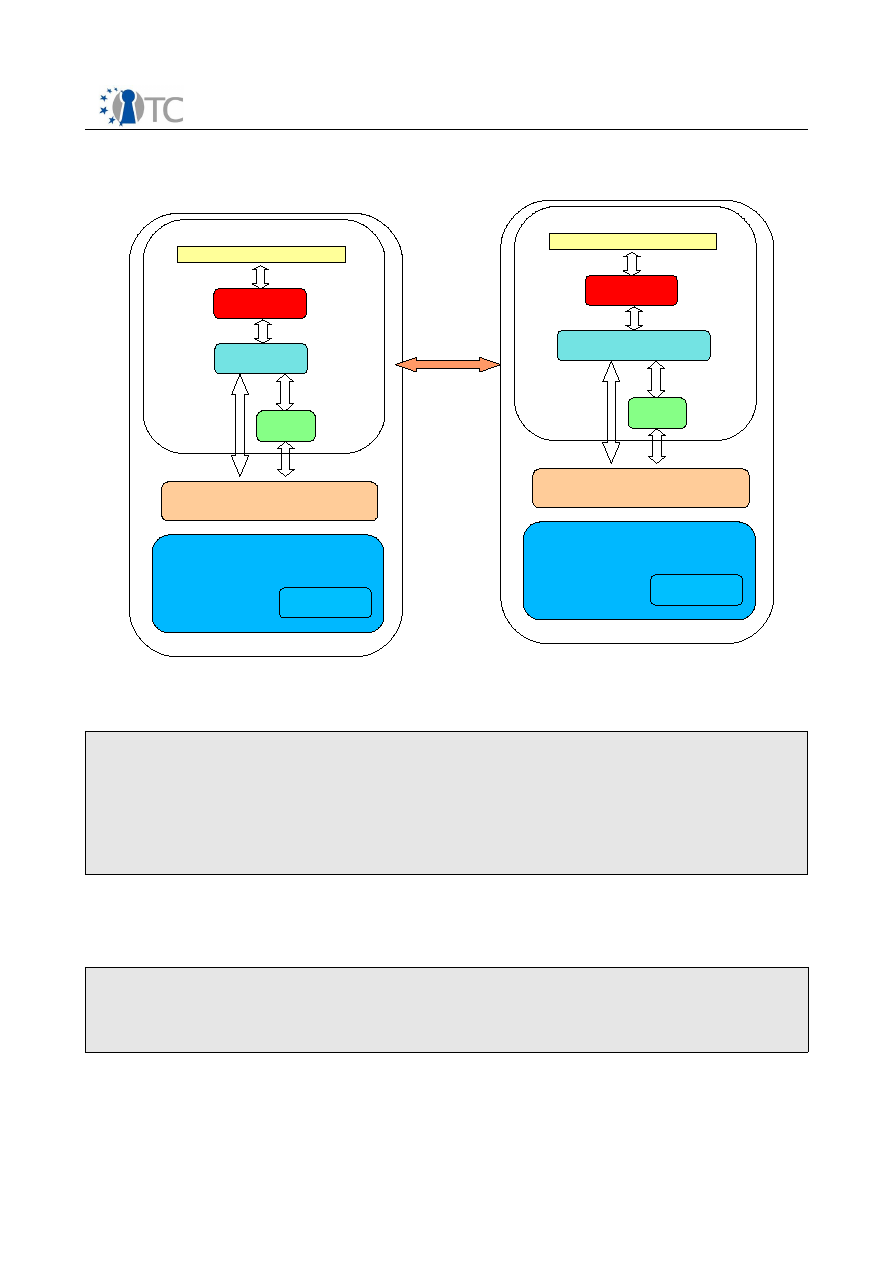
WP06d.1 Encrypted File Service C/C++ API Specification
1.3 API Method Description
EFS API is described in the following way explained below.
<
method name as header
>
<
method definition
>
<
method explanation
>
<
input parameters
(optional)>
<
return values
(optional)>
<
dependent methods
(optional)>
<
sample usage in CLI
(optional)>
Table 1:General structure of an API method entry
Each EFS method is explained under the name of the same topic.
Sample EFS API method declaration is shown in Table 2 below.
int trustedUserKeyBackup(String backupUrl,
byte* recoveryPasswd,
byte* userPasswd)
Table 2:Sample method definition
As it is seen from Table2, method name is represented in bold. Following the
declaration, input parameters of the method is specified.
Open_TC Deliverable
7/69
Figure 1:EFS Building Blocks and Their
interactions
SSL[Mutual Attestation]
Xen/L4
EFS API
User Interface
TPM
TPA
EFS Core
Trusted
Compartment
OTC Security and Management Services
Xen/L4
EFS API
User Interface
TPM
TPA
EFS Recovery Server
Trusted
Compartment
OTC Security and Management Services
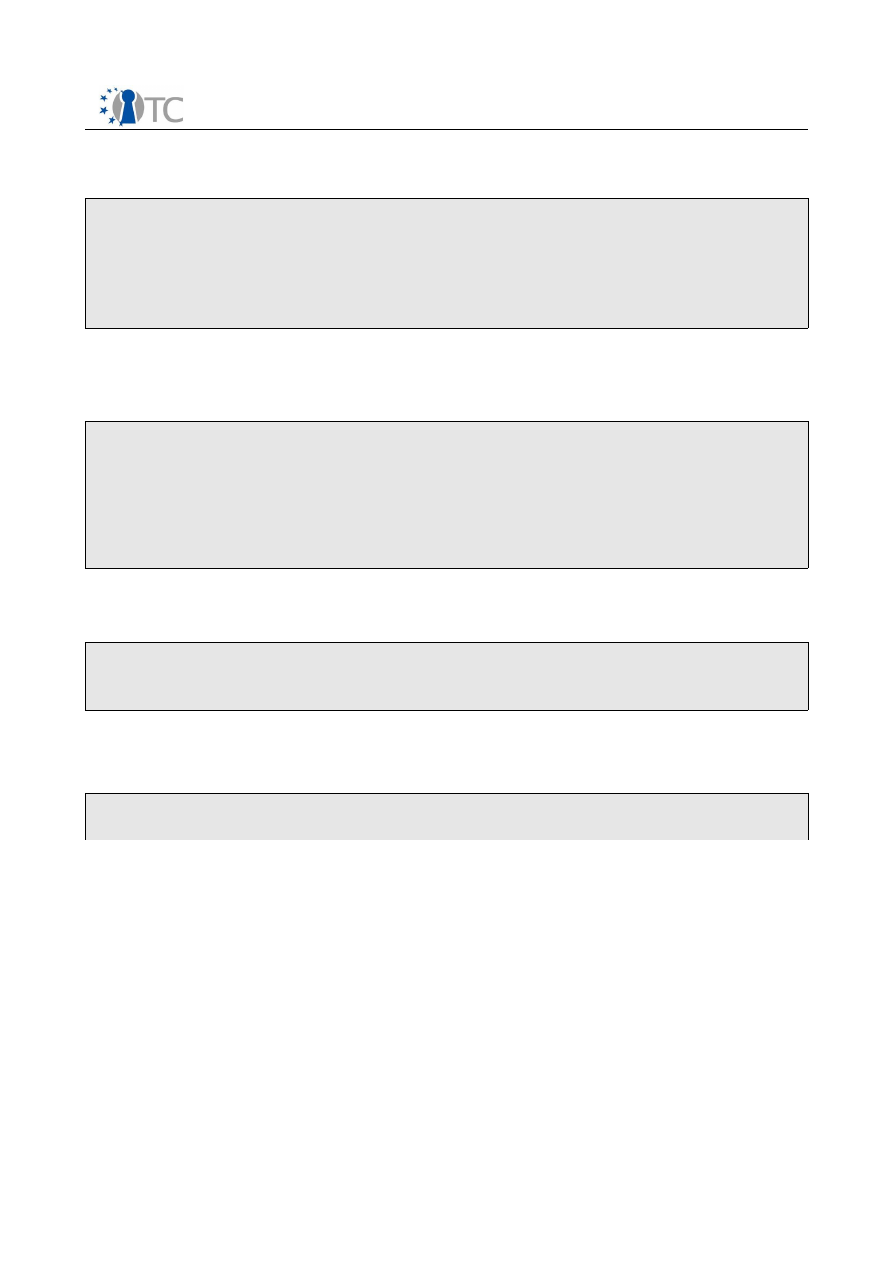
WP06d.1 Encrypted File Service C/C++ API Specification
Informative comment about each method is given following the method declaration.
Sample informative comment is shown in Table 3.
Start of informative comment
Trusted back up operation for user keys.
End of informative comment
Table 3:Explanation part of method
Informative comment of method is followed by detailed explanation of method
parameters. Sample “Parameters” section is shown in Table 4.
Parameters:
backupUrl
- URL of the directory which user keys will be backed
up
recoveryPasswd
- password for S2K encryption.
userPasswd
- password for keys which are going to be backed up.
Table 4:Input parameters explained in detail
As shown in Table 5, “Returns” field follows “Parameters” field. In “Returns” field,
return parameter of the method is explained in detail.
Returns:
status flag SUCCESSFUL/FAILED
Table 5:Return value
If the method have dependencies and preconditions for execution, “Dependency” field
will be used for specifying the methods dependencies.
Dependency:
openSession(String)
Table 6:Dependency
Finally there will be usage scenarios which explain usage of the API method in EFS CLI.
These part is a guide for application programmers, which explains logical flow of input
and output data to method. Such as specifying the execution step where to ask for
passwords or how to obtain some other user originated data. For EFS, CLI usage is
taken as a reference and “Sample Usage in CLI” section is added afterwards
“Dependency” section. This is shown in Table 7.
Open_TC Deliverable
8/69

WP06d.1 Encrypted File Service C/C++ API Specification
Sample Usage in CLI:
$ efscli --trusted-user-keys-backup /mnt/sdb1/foo/
Enter key password :
Enter key backup password :
Reenter key backup password :
User keys back up operation -> SUCCESSFUL/FAILED
Table 7:Sample usage scenarios
There is no sample source codes available in this document. For source code examples
EFS CLI have to be examined.
1.4 Input Parameter Limitations
Input parameters have certain limitations which should be obeyed strictly.
●
String
s should not be longer than 256 characters.
●
byte*
should end with null character.
●
boolean
should be “true” or “false”.
●
int
should be taken as an 32 bit integer value with sign.
1.5 Return Value Limitations
Return values have certain limitations which should be obeyed strictly.
●
int
type return values should be one of these constant values defined in 2.1.1
●
int*
type defines a file descriptors and should end with an EOF.
●
String
type should be handled as in <string.h> library.
●
Vector
type should be handled as in <vector> library
●
Platform*
should end with an zero valued id entry.
●
PlatformResults*
should end with an zero valued id entry.
●
RecoveryList*
should end with an zero valued id entry.
●
RecoveryResults*
should end with an zero valued id entry.
●
KeyInfo*
should end with an zero valued id entry.
1.6 OS Dependency
EFS API will be platform-independent, this means EFS API may not be restricted to any
operating systems, independent of the operating system's resource limitations and
user restrictions. However, it is the case that EFS Core should work for that OS where
API is going to run.
1.7 Abbreviations
Open_TC Deliverable
9/69

WP06d.1 Encrypted File Service C/C++ API Specification
Abrreviation
Description
API
Application Programming Interface
EFS
Encrypting File Service
CLI
Command Line Interface
RS
Recovery Server
RA
Recovery Agent
TPM
Trusted Platform Module
OS
Operating System
Table 8:Abbreviations Table
Open_TC Deliverable
10/69

WP06d.1 Encrypted File Service C/C++ API Specification
2
API Units
EFS API consists of 5 main parts.
●
File Operations
File operations are simple generic file encryption service operations which are
encryption, decryption ,signing ,verifying and shredding.
Remark: File recovery operation is distinguished from operations mentioned
above because there is a need for administrative authorization for both local
and networked file recovery operations.
●
User Operations
User operations cover operations related with end user like policy management
or keystore password operations.
●
Key Management Operations
Key management operations contains EFS key operations which will be used by
programmers. API programmers can create, delete, migrate, backup and restore
EFS keys. They can also import keys from GNU PG and PGP
●
Recovery Agent Operations
Application programmers can use EFS API for file recovery actions used in both
standalone and networked installations. They can manage file recovery actions
by using this part of EFS API.
●
Recovery Server Operations
EFS offers trusted central file recovery option with EFS Recovery Server.
Recovery server is also capable of distributing enforcing EFS policies to all
trusted recovery agents registered. These operations are managed by EFS API
functions explained in this section.
●
Administrative Operations
According to configured enforcing policies, EFS may need administrative
authentication and management actions from application programmer. These
functionalities are managed with the functions in this section.
Open_TC Deliverable
11/69

WP06d.1 Encrypted File Service C/C++ API Specification
2.1 Constants
EFS API calls have return values associated with the result of the action performed in
API function. In order to clarify return values between EFS API functions and
applications, constants in this section is introduced.
2.1.1 Return Types
2.1.1.1 SUCCESSFUL
static const int SUCCESSFUL
This is a static integer value which will be used as status flag that returns from a
method. It symbolizes success from the called method.
2.1.1.2 FAILED
static const int FAILED
This is a static integer value which will be used as status flag that returns from a
method. It symbolizes failure from the called method.
2.1.1.3 NOT_IMPLEMENTED
static const int NOT_IMPLEMENTED
This is a static integer value which will be used as status flag that returns from a
method. It symbolized that the called method is not implemented.
Open_TC Deliverable
12/69

WP06d.1 Encrypted File Service C/C++ API Specification
2.1.2 File Operation Types
2.1.2.1 ENCRYPT
static const int ENCRYPT
This
is a static integer value which will be used as a parameter to fileOperation
method as operation. It symbolizes file encryption.
2.1.2.2 DECRYPT
static const int DECRYPT
This
is a static integer value which will be used as a parameter to fileOperation
method as operation. It symbolizes file decryption.
2.1.2.3 SIGN
static const int SIGN
This
is a static integer value which will be used as a parameter to fileOperation
method as operation. It symbolizes file signing.
2.1.2.4 VERIFY
static const int VERIFY
This
is a static integer value which will be used as a parameter to fileOperation
method as operation. It symbolizes file verifying.
2.1.2.5 SHRED
static const int SHRED
This
is a static integer value which will be used as a parameter to fileOperation
method as operation. It symbolizes file shredding.
Open_TC Deliverable
13/69

WP06d.1 Encrypted File Service C/C++ API Specification
2.1.3 Encryption Algorithm Types
2.1.3.1 AES-ECB
static const int AESECB
This
is a static integer value which will be used as a parameter to fileOperation
method as symmetric encryption algorithm to be used in this single operation. It
symbolizes AES-ECB encryption scheme.
2.1.3.2 AES-CBC
static const int AESCBC
This
is a static integer value which will be used as a parameter to fileOperation
method as symmetric encryption algorithm to be used in this single operation. It
symbolizes AES-CBC encryption scheme.
2.1.3.3 DES-ECB
static const int DESECB
This
is a static integer value which will be used as a parameter to fileOperation
method as symmetric encryption algorithm to be used in this single operation. It
symbolizes DES-ECB encryption scheme.
2.1.3.4 DES-CBC
static const int DESCBC
This
is a static integer value which will be used as a parameter to fileOperation
method as symmetric encryption algorithm to be used in this single operation. It
symbolizes DES-CBC encryption scheme.
2.1.3.5 DESede-ECB
static const int DESedeECB
This
is a static integer value which will be used as a parameter to fileOperation
method as symmetric encryption algorithm to be used in this single operation. It
symbolizes DESede-ECB encryption scheme.
2.1.3.6 DESede-CBC
static const int DESedeCBC
This is a static integer value which will be used as a parameter to fileOperation
method as symmetric encryption algorithm to be used in this single operation. It
symbolizes DESede-CBC encryption scheme.
2.1.3.7 BLOWFISH
static const int BLOWFISH
This is a static integer value which will be used as a parameter to fileOperation
method as symmetric encryption algorithm to be used in this single operation. It
Open_TC Deliverable
14/69

WP06d.1 Encrypted File Service C/C++ API Specification
symbolizes BLOWFISH encryption scheme.
Open_TC Deliverable
15/69

WP06d.1 Encrypted File Service C/C++ API Specification
2.1.4 Key Types
2.1.4.1 KEY_BIND
static const int KEY_BIND
This is a static integer value which will be used as a parameter to key import operation
operation. It symbolizes
that given key will be used for binding purposes.
2.1.4.2 KEY_SIGN
static const int KEY_BIND
This is a static integer value which will be used as a parameter to key import operation
operation. It symbolizes that given key will be used for signing purposes.
2.1.4.3 KEY_LEGACY
static const int KEY_LEGACY
This is a static integer value which will be used as a parameter to key import operation
operation. It symbolizes that given key will be used for both binding and signing
purposes.
Open_TC Deliverable
16/69
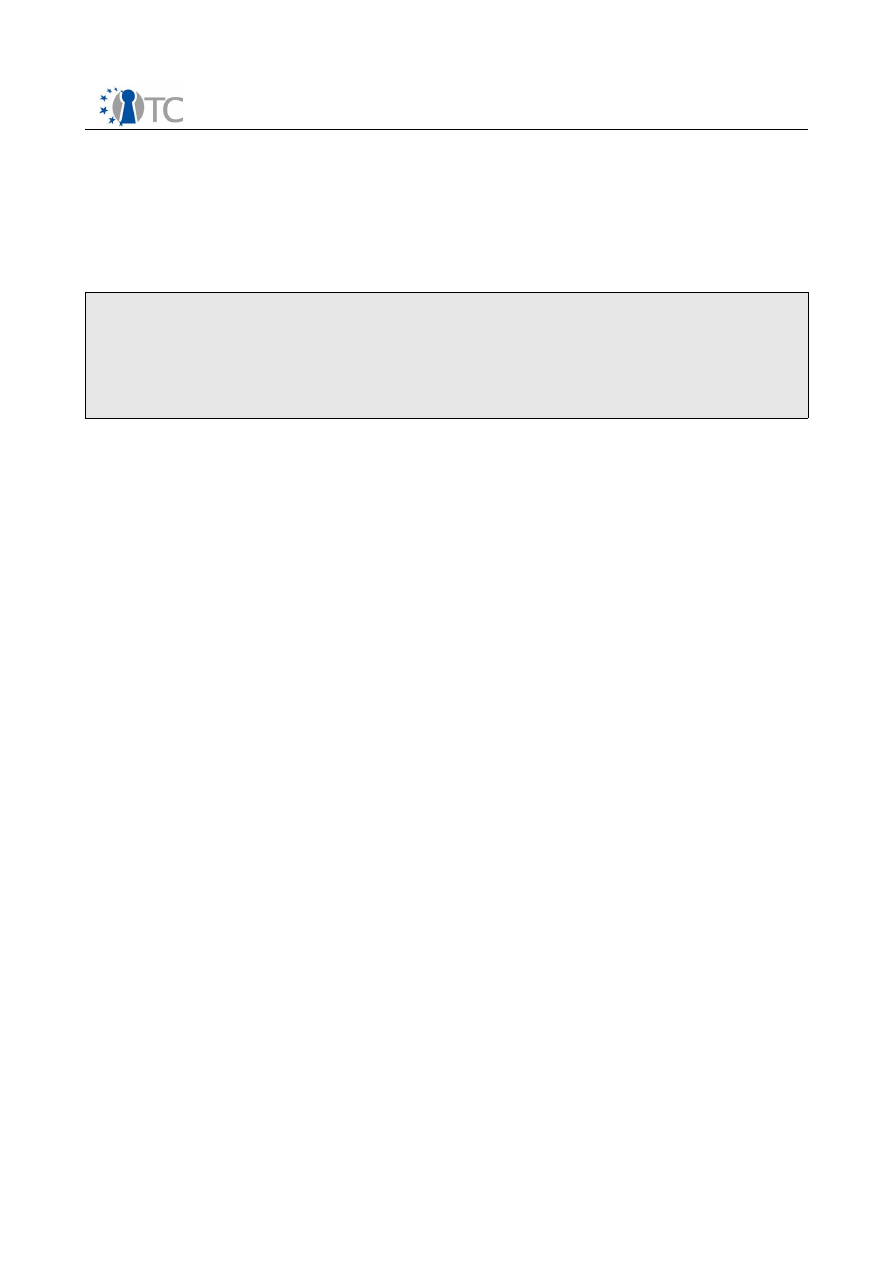
WP06d.1 Encrypted File Service C/C++ API Specification
2.2 File Operations
2.2.1 getLastCommandStatus
String getLastCommandStatus()
Start of informative comment
Returns detailed log for the last executed EFS command.
End of informative comment
Returns:
This function returns detailed output log of the last executed command.
Implemented to get detailed log of EFS last EFS executed command.
Open_TC Deliverable
17/69

WP06d.1 Encrypted File Service C/C++ API Specification
2.2.2 hasOpenSession
int hasOpenSession()
Start of informative comment
Checks whether user has an ongoing EFS session. If not, program should ask for EFS
session password of the user.
End of informative comment
Returns:
This function return status flag SUCCESSFUL/FAILED.
If SUCCESSFUL is returned, user has open EFS session.
If FAILED is returned, user does not have open EFS session. Application has
to open EFS session for user with
openSession
command.
Open_TC Deliverable
18/69

WP06d.1 Encrypted File Service C/C++ API Specification
2.2.3 openSession
int openSession(byte* password)
Start of informative comment
Opens a new EFS session for the user if supplied user name and password is valid.
End of informative comment
Parameters:
password
– user session password
Returns:
If password is correct a new session will be opened for the user and function
will return SUCCESSFUL. Otherwise it will return FAILED.
Open_TC Deliverable
19/69

WP06d.1 Encrypted File Service C/C++ API Specification
2.2.4 checkUserPasswd
int checkUserPasswd(byte* password)
Start of informative comment
Checks validity of user password.
End of informative comment
Parameters:
password
- Password of the user who sends request
Returns:
If user password is correct and opens keystore then method will return
SUCCESSFUL. Else function will return FAILED.
Open_TC Deliverable
20/69
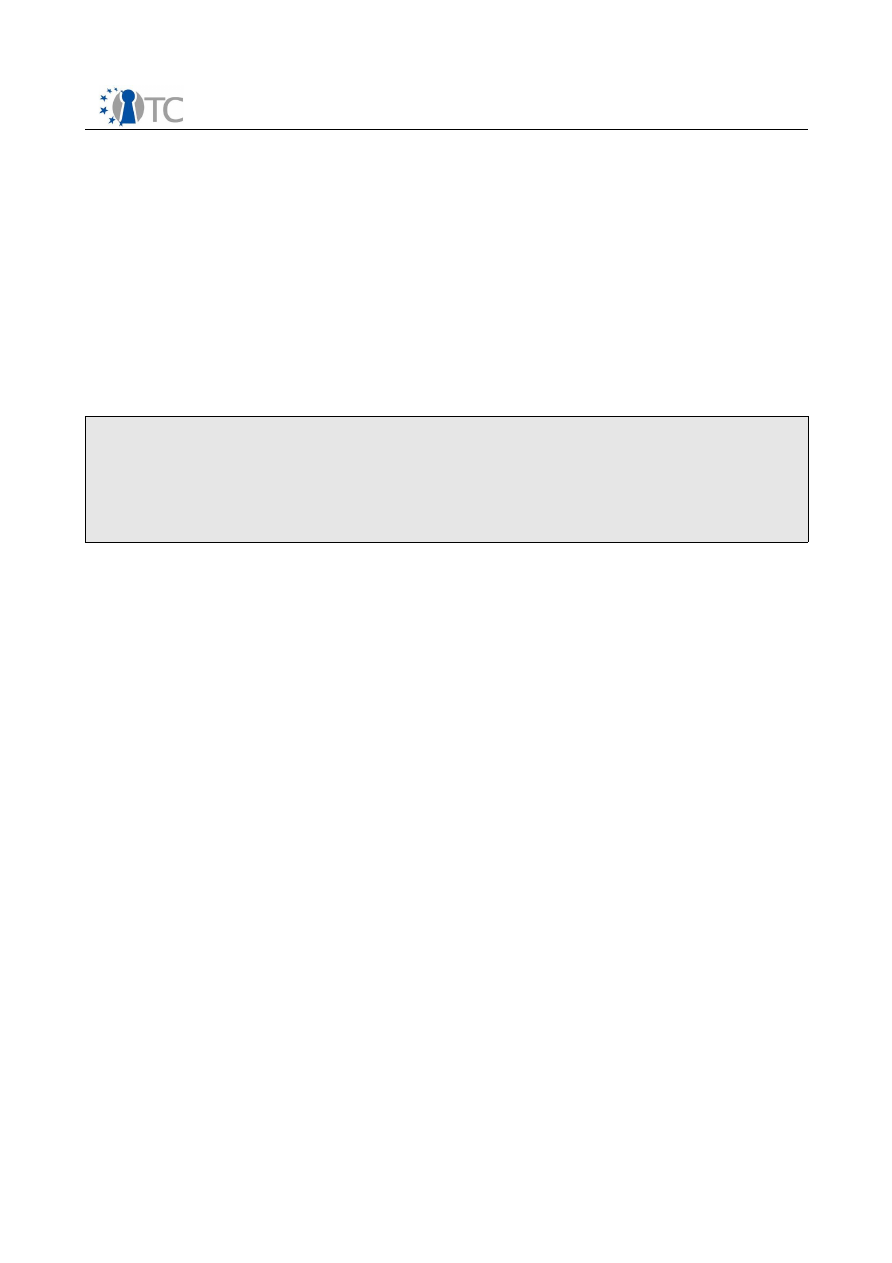
WP06d.1 Encrypted File Service C/C++ API Specification
2.2.5 fileOperation
int fileOperation(int operation,
String inputFile,
String outputFile,
int algorithm,
boolean isTar,
boolean open,
boolean shred,
String keyURL,
String keyType,
byte* userKeyPass
boolean verbose)
Start of informative comment
If user does not have an ongoing session, user have to be asked for password.
End of informative comment
Parameters:
operation
- operation name (see 2.1.2)
●
ENCRYPT
●
DECRYPT
●
SIGN
●
VERIFY
●
SHRED
inputFile
- name of the input file (absolute URL
like /home/foo/bar.txt)
outputFile
- name of the output file. If null, output file will be
named as inputFileName+".efs" . If no output file name
is supplied then EFS will decrypt file to the file's original
filename which was held in file header in decryption.
(absolute URL like /home/foo/bar.txt.efs)
algorithm
- name of the algorithm to be used in bulk file
encryption. If null, Blowfish will be used as default
symmetric encryption method. (see 2.1.3)
●
AES-ECB
●
AES-CBC
●
DES-ECB
●
DES-CBC
●
DESede-ECB
●
DESede-CBC
●
BLOWFISH
isTar
- creates an archive. Input file has to be a directory
open
- Opens EFS encrypted file with associated program to
its MIME type. File decryption is transparent to user.
Open_TC Deliverable
21/69

WP06d.1 Encrypted File Service C/C++ API Specification
Applicable on EFS encrypted files.
shred
- Shreds input file after file encryption/decryption.
Default value is true.
keyURL
- URL of the external asymmetric key to be used for
encryption. If null, default EFS JKS keys will be used.
(absolute URL like/home/foo/key.pub)
keyType
- type of the external asymmetric key to be used in
encryption. Possible values are
●
PGP
●
GPG
●
JKS
userKeyPass
- password of the keys given by the user externally.
verbose
- detailed output mode
Returns:
This function returns status flag FAILED if there is an error. Otherwise it will
return file descriptor of the processed file.
Dependency:
openSession(byte *)
checkUserPasswd(byte*)
Sample Usage in CLI:
1. Authenticate user.
Password for key id : xxxxxx
User authentication -> SUCCESFUL/FAILED
2. No Message (means successful operation)
3. File processes in verbose mode.
file name before operation -> operation name -> file name after operation
4. Id of the key and type which is going to be used in file operation
Keyid = <int> , Type = <string {PGP,GPG,JKS}>
Open_TC Deliverable
22/69

WP06d.1 Encrypted File Service C/C++ API Specification
2.2.6 decryptInVolatileMemory
int* decryptInVolatileMemory(String inputFile,
boolean open,
String keyURL,
String keyType,
byte* userKeyPass,
boolean verbose)
Start of informative comment
Decrypts an EFS encrypted file to volatile memory(RAM) instead of hard disk. In case
of sudden power disruption, decrypted open data does not reside on hard disk.
Remark: If user does not have an ongoing EFS session, user have to be asked for EFS
session password
End of informative comment
Parameters:
inputFile
- Name of an EFS encrypted input file (absolute URL like
/home/foo/bar.txt.efs)
open
- Opens EFS encrypted file with associated program to
its MIME type. File decryption is transparent to user.
Applicable on EFS encrypted files.
keyURL
- url of the external asymmetric key to be used in
encryption. If null, default EFS JKS keys will be used.
(absolute URL like /home/foo/key.pub)
keyType
- type of the external asymmetric key to be used in
encryption. Possible values are
●
PGP
●
GPG
●
JKS
userKeyPass
- password of the keys given by the user externally.
verbose
- detailed output mode
Returns:
This function returns status flag FAILED if there is an error. Otherwise it will
return a memory pointer to the processed file.
Dependency:
openSession
(String)
checkUserPasswd
(byte*)
Open_TC Deliverable
23/69
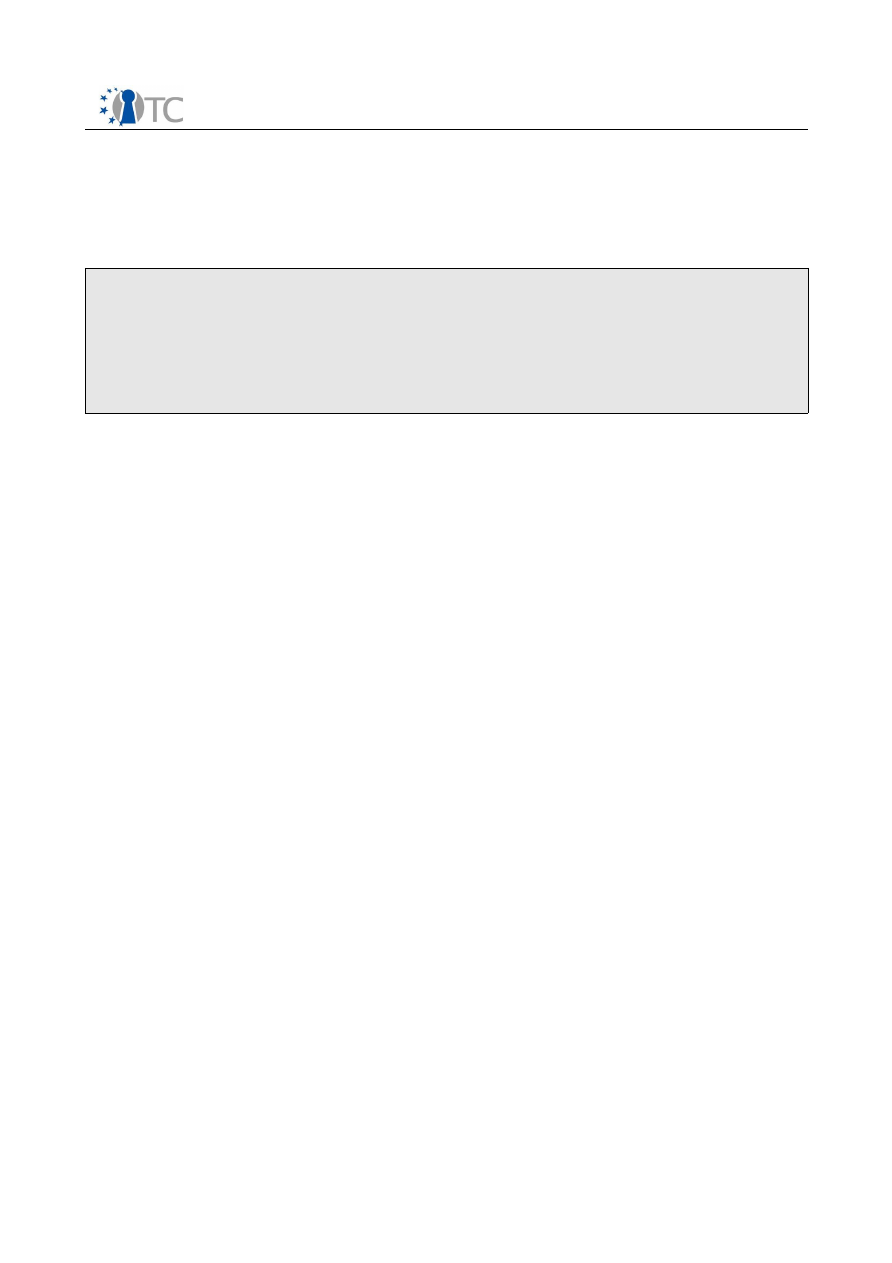
WP06d.1 Encrypted File Service C/C++ API Specification
2.2.7 localFileRecovery
int localFileRecovery(String inputFile,
byte* recoveryPasswd, String X509CerPath, String
X509PrivPath)
Start of informative comment
Local file recovery command. Requires administrator authorization to get Recovery
Agent Keys on local platform.
End of informative comment
Parameters:
inputFile
- name of the file to be recovered(absolute URL
eg. /home/foo/bar.txt.efs)
recoveryPasswd
- password for recovery agent keys.
X509CerPath
- absolute path to X.509 certificate file which contains
user's new certificate. If null EFS will generate new keys
for user.
X509PrivPath
- absolute path to X.509 private key file which contains
user's new private key. If null EFS will generate keys for
user.
Returns:
status flag SUCCESSFUL/FAILED
Sample Usage in CLI:
$ efscli --recover foo.txt,bar.pdf
Password for Recovery Keys : xxxxx
Authorization Granted/Denied.
Recovery -> SUCCESFUL/FAILED
Open_TC Deliverable
24/69

WP06d.1 Encrypted File Service C/C++ API Specification
2.2.8 remoteRecovery
int remoteRecovery(String inputFile, String X509CerPath, String X509PrivPath)
Start of informative comment
Command for networked recovery. Recovery is performed on EFS Recovery Server.
Requires administrative authority on recovery server.
End of informative comment
Parameters:
inputFile
- name of the file to be recovered. (absolute url
like /home/foo/bar.txt.efs)
X509CerPath
- absolute path to X.509 certificate file which contains
user's new certificate. If null EFS will generate keys for
user.
X509PrivPath
- absolute path to X.509 private key file which contains
user's new private key. If null EFS will generate keys for
user.
Returns:
status flag SUCCESSFUL/FAILED
Sample Usage in CLI:
$ efscli --recovery-request foo.txt,bar.pdf
Recovery Request is sent to Recovery Server. Waiting for administrative
approval.
Request approved/denied.
Recovery SUCCESFUL/FAILED
Open_TC Deliverable
25/69

WP06d.1 Encrypted File Service C/C++ API Specification
2.2.9 Sample CLI Commands for File Operations:
$ efscli -i /home/xxx/bar.txt -op encrypt
Enter user password :
User authentication -> SUCCESFUL/FAILED
$ efscli -v -i /home/xxx/bar.txt.efs -op decrypt
Keyid = <int> , Type = <string {PGP,GPG,JKS}>
bar.txt.efs -> decrypt -> bar.txt -> SUCCESSFUL
$ efscli -v -i /home/xxx/foo.odt -o /home/xxx/myfoo.efs -op encrypt –
uk /mnt/sdb1/mykey.pub -kt GPG
Password for key '/mnt/sdb1/mykey.pub' :
foo.odt -> encrypt -> myfoo.efs -> SUCCESSFUL
$ efscli -v -i /home/xxx/foo.odt -op decrypt –uk /mnt/sdb1/mykey.priv -kt GPG
Password for key '/mnt/sdb1/mykey.priv' :
myfoo.efs -> decrypt -> foo.odt -> SUCCESSFUL
Open_TC Deliverable
26/69
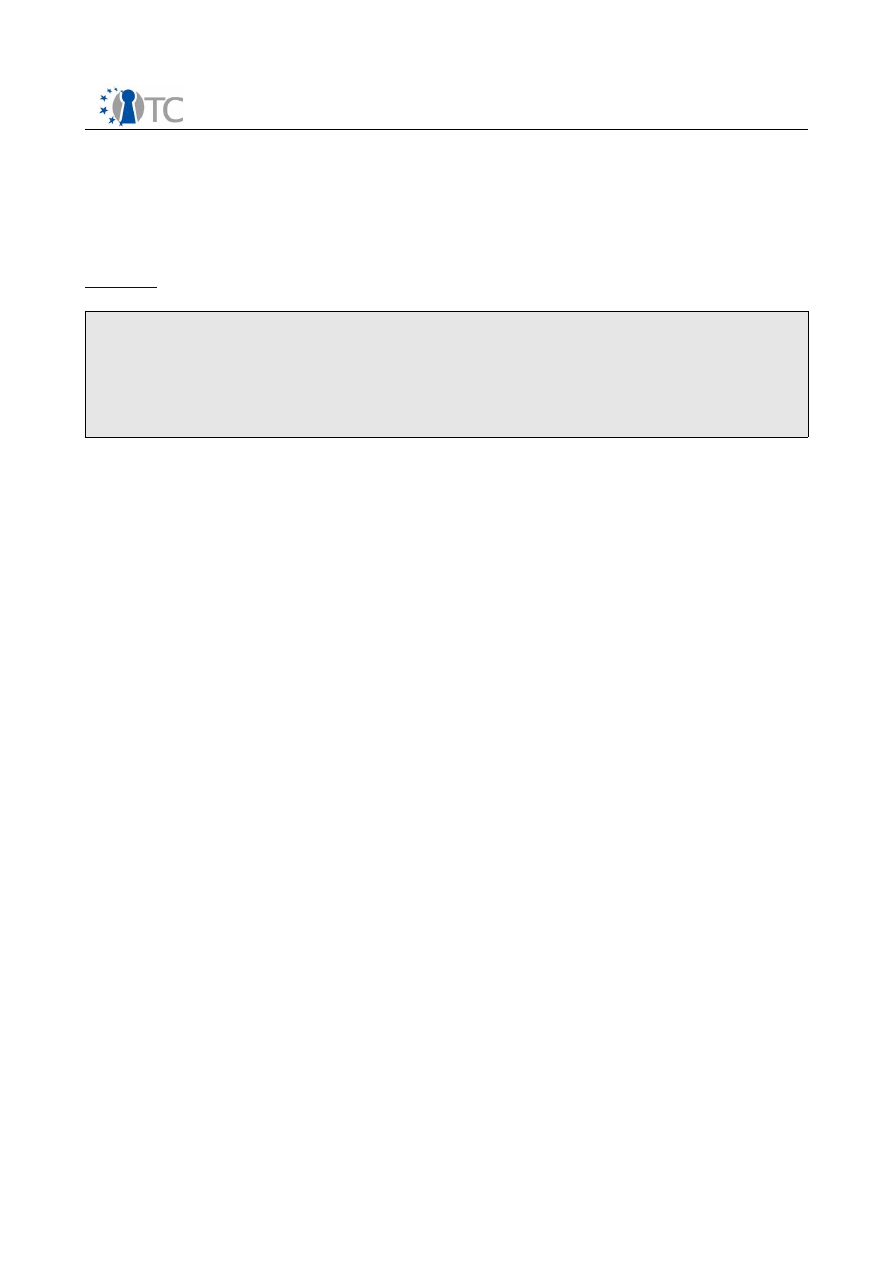
WP06d.1 Encrypted File Service C/C++ API Specification
2.3 User Operations
Operations under this section is dedicated to single specific user who has open EFS
session.
2.3.1 listKeys
KeyInfo*
listKeys(byte* userPasswd)
Start of informative comment
Returns detailed list of user EFS keys.
End of informative comment
Parameters:
userPasswd
– password for the user's current keystore.
Returns:
status flag SUCCESSFUL/FAILED
Dependency:
KeyInfo Class(see 3.3.1)
Sample Usage in CLI:
$ efscli --list-keys
Enter user password :
User authentication -> SUCCESFUL/FAILED
Keyid = 1, Name=MyKey, Hash=.... , Type = JKS
...
Keyid = 4, Name=FooKey, Hash=.... , Type = JKS
Open_TC Deliverable
27/69

WP06d.1 Encrypted File Service C/C++ API Specification
2.3.2 changeUserPasswd
int changeUserPasswd(byte* oldpassword,byte* newpassword)
Start of informative comment
Changes EFS session password of the user.
End of informative comment
Parameters:
oldpassword
- Old user password
newpassword
- New user password
Returns:
This method returns SUCCESSFUL if it can open keystore with old password
and save it with new password.
Sample Usage in CLI:
$ efscli --change-user-passwd
Enter old user password :
User authentication -> SUCCESSFUL/FAILED
Enter new user password :
Enter new user password (again):
User password change -> SUCCESSFUL/FAILED
Open_TC Deliverable
28/69

WP06d.1 Encrypted File Service C/C++ API Specification
2.3.3 listMACPolicies
Vector<String[]> listMACPolicies()
Start of informative comment
Lists mandatory access policies enforced by EFS specified by administrator.
End of informative comment
Returns:
This function returns a map which contains mandatory policy names with
regarding policy value.
Open_TC Deliverable
29/69

WP06d.1 Encrypted File Service C/C++ API Specification
2.3.4 listDACPolicies
Vector<String[]> listDiscretionaryPolicies(byte* password)
Start of informative comment
Lists discretionary access policies which are specified by individual EFS user.
End of informative comment
Parameters:
password
- Current user password
Returns:
This function returns a map which contains discretionary policy names
matched with specified policy value. Also whole policies are followed by
value formats(i.e. date Y-m-d)
Open_TC Deliverable
30/69

WP06d.1 Encrypted File Service C/C++ API Specification
2.3.5 setDACPolicy
int setDACPolicy(byte* password,
String policyName,
String policyValue)
Start of informative comment
Sets discretionary access policy with given name to a given value. If policy value
does not fit to given format, function will return failure. If policy value does not fit
mandatory access policy EFS will return error.
End of informative comment
Parameters:
password
- Current user password
policyName
- Name of the policy that user want to change
policyValue
- Value of the policy that user want to change
Returns:
This function returns successful if given password and policy name are
correct and policy value fits into the predefined for the specified policy.
Open_TC Deliverable
31/69

WP06d.1 Encrypted File Service C/C++ API Specification
2.3.6 resetDACPolicy
int resetDACPolicy(byte* password)
Start of informative comment
Resets discretionary access policies to default predefined values.
End of informative comment
Parameters:
password
- Current user password
Returns:
This function returns successful if given password is correct.
Open_TC Deliverable
32/69
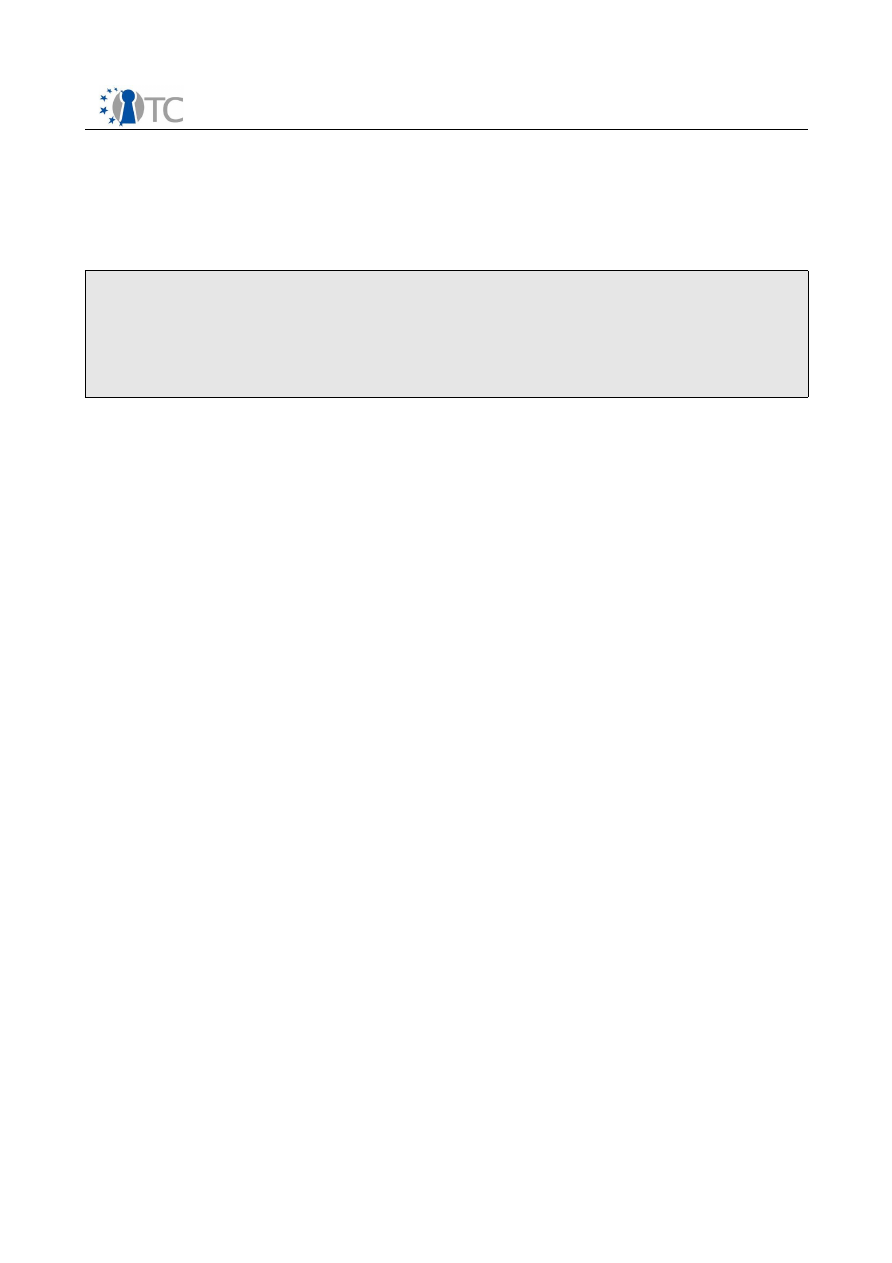
WP06d.1 Encrypted File Service C/C++ API Specification
2.3.7 setTrustedSignOnValue
int setTrustedSignOnValue(byte* userPassword,
String signOnPhrase)
Start of informative comment
Sets trusted sign on value which can be used in checking platform authentication.
End of informative comment
Parameters:
password
- Current user password
signonvalue
- 256 byte authentication value which will be used
for trusted sign on.
Returns:
This function returns successful if given password is true and trusted sign on
value is not null.
Open_TC Deliverable
33/69

WP06d.1 Encrypted File Service C/C++ API Specification
2.3.8 checkTrustedSignOn
String checkTrustedSignOn()
Start of informative comment
Returns the trusted sign on value which has been predefined by the user
End of informative comment
Returns:
This function returns trusted sign on value if password is correct and a
trusted sign on value is set before.
Open_TC Deliverable
34/69

WP06d.1 Encrypted File Service C/C++ API Specification
2.3.9 clearTrustedSignOnValue
int clearTrustedSignOnValue(byte* password)
Start of informative comment
Clears the trusted sign on value and unregisters TPM key dedicated to it.
End of informative comment
Parameters:
password
- Current user password
Returns:
This function returns successful if user password is correct and a trusted
sign on value is defined before.
Open_TC Deliverable
35/69

WP06d.1 Encrypted File Service C/C++ API Specification
2.4 Key Operations
2.4.1 checkAdminPasswd
int checkAdminPasswd(byte* password)
Start of informative comment
Checks whether compartment administrator password is correct or not.
End of informative comment
Parameters:
password
- Password of the EFS administrator on
compartment
Returns:
If platform administrator password is not correct, method returns FAILED.
Else it returns SUCCESSFUL.
Open_TC Deliverable
36/69

WP06d.1 Encrypted File Service C/C++ API Specification
2.4.2 generateUserKey
int generateUserKey(byte* userPass,int force, byte* adminPass)
Start of informative comment
Generates file encryption key for user to be used for file operations. If user has
generated keys, must be used with force=1 parameter to regenerate keys.
End of informative comment
Parameters:
userPass
- Authentication password for user keys
force
- If force is used method will generate a new
keystore by deleting the old one.
adminPass
- Password of the administrative user.
Returns:
If one of the user or administrator passwords is wrong, function will return
FAILED. If there exists a user keystore and force=1 will return FAILED.
Sample Usage in CLI:
$ efscli --generate-user-key
Enter administrator password :
Enter key password :
User key generation -> SUCCESSFUL/FAILED
Open_TC Deliverable
37/69

WP06d.1 Encrypted File Service C/C++ API Specification
2.4.3 addNewUserKey
int generateUserKey(byte* userPass, int keyType)
Start of informative comment
Generates new file encryption key for user to be used for file operations.
End of informative comment
Parameters:
userPass
- Authentication password for user keys
adminPass
- Type of the key (see 2.1.4)
●
KEY_BIND
●
KEY_SIGN
●
KEY_LEGACY
Returns:
If user password is wrong, function will return FAILED.
Open_TC Deliverable
38/69

WP06d.1 Encrypted File Service C/C++ API Specification
2.4.4 deleteUserKey
int deleteUserKey(byte* userPasswd,int keyid)
Start of informative comment
Deletes asymmetric key pair of the user which are used in file operations.
End of informative comment
Parameters:
userPasswd
- Password for user keys
keyid
- Identification number of the key which is going to
be deleted.
Returns:
If user password and key identification is correct method will return
SUCCESSFUL.
Sample Usage in CLI:
$ efscli --delete-user-key 3
Enter user password :
User key deletion -> SUCCESSFUL/FAILED
Open_TC Deliverable
39/69

WP06d.1 Encrypted File Service C/C++ API Specification
2.4.5 RATrustedBackup
int RATrustedBackup(String backupUrl,byte* recoveryPasswd, byte*
backupPasswd )
Start of informative comment
Trusted backup of the Recovery Agent keys on local platform.
End of informative comment
Parameters:
backupURL
- url of the directory which recovery agent keys will
be backed up(absolute url like /mnt/sda1/keys)
recoveryPasswd
- Password for recovery agent keys
backupPasswd
- Backup password for restore operation.
Returns:
If back up URL is valid, recovery password is correct and backup password is
not null it will return SUCCESSFUL.
Sample Usage in CLI:
$ efscli --trusted-backup-ra-keys /mnt/sdb1/foo/
Enter Recovery password :
Authorization granted/denied
RA keys back up -> SUCCESSFUL/FAILED
Open_TC Deliverable
40/69

WP06d.1 Encrypted File Service C/C++ API Specification
2.4.6 trustedKeyBackup
int trustedKeyBackup(String backupUrl,
byte* backupPasswd, byte* adminPass)
Start of informative comment
Trusted backup of EFS Key tree.
End of informative comment
Parameters:
backupUrl
- URL of the directory which EFS keys will be
backed up(absolute url like /mnt/sda1/keys)
backupPasswd
- password for S2K encryption.
adminPass
- Password of the administrative user.
Returns:
If back up URL is valid, administrator password is correct and backup
password is not null it will return SUCCESSFUL.
Sample Usage in CLI:
$ efscli --trusted-key-backup /mnt/sdb1/foo/
Enter administrator password :
Authorization granted/denied
Enter EFS Key Tree Recovery password :
Reenter EFS Key Tree Recovery password :
EFS Key Tree back up -> SUCCESSFUL/FAILED
Open_TC Deliverable
41/69
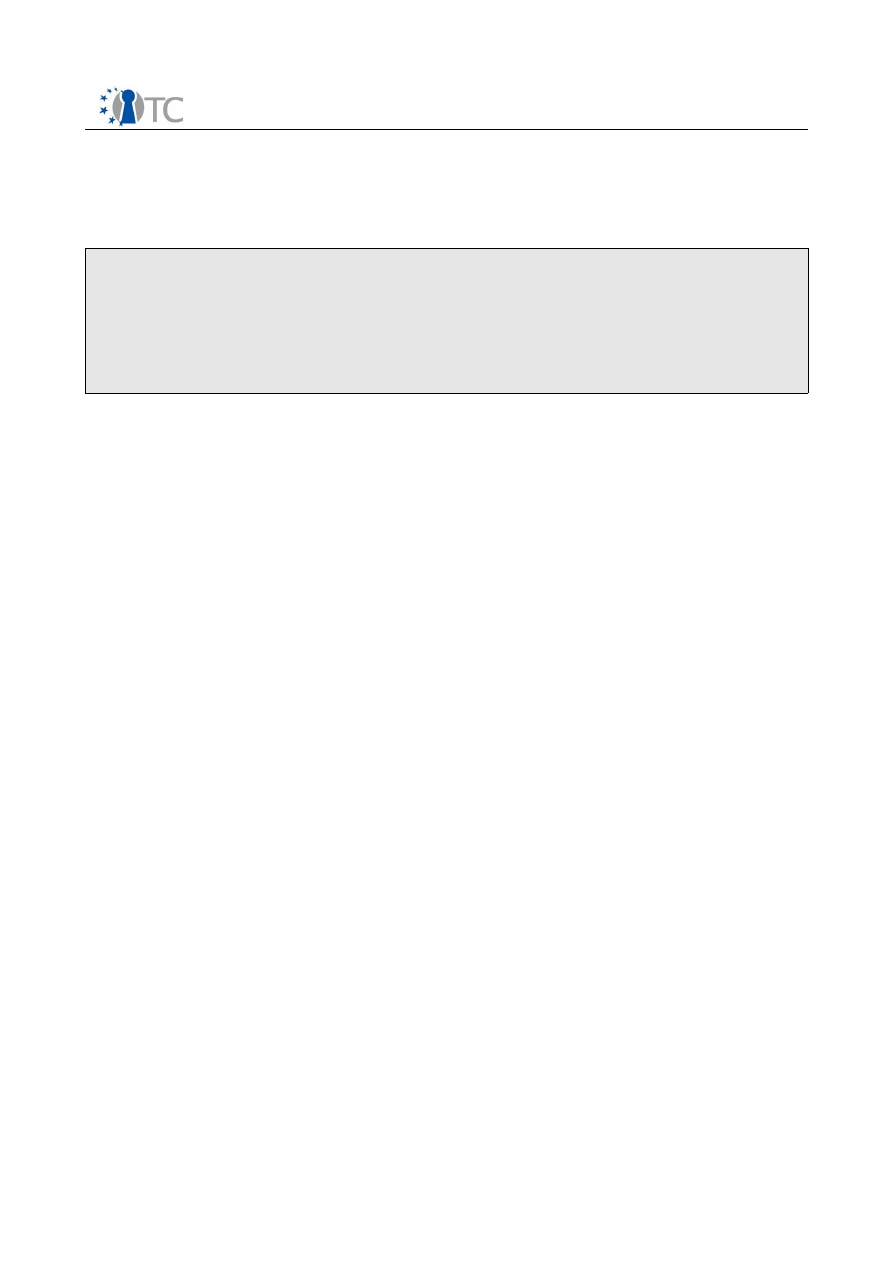
WP06d.1 Encrypted File Service C/C++ API Specification
2.4.7 trustedKeyRestore
int trustedKeyRestore(String restoreUrl,
byte* backupPasswd, byte* adminPass)
Start of informative comment
Restore operation of keys on a platform. Needs EFS key tree password and a recovery
password for S2K decryption.
End of informative comment
Parameters:
restoreUrl
- URL of the directory which EFS keys will be
restored. If null, they will be restored to default
directory.(absolute url like /mnt/sda1/keys)
backupPasswd
- password for S2K decryption.
adminPass
- Password of the EFS administrator.
Returns:
If restore URL is valid, administrator password is correct and backup
password is not null it will return SUCCESSFUL.
Sample Usage in CLI:
$ efscli --trusted-key-restore
Enter administrator password :
Authorization granted/denied
Enter EFS Key Tree password :
EFS Key Tree restore -> SUCCESSFUL/FAILED
Open_TC Deliverable
42/69

WP06d.1 Encrypted File Service C/C++ API Specification
2.4.8 trustedKeyMigrate
int trustedKeyMigrate(byte * migrationPassword)
Start of informative comment
This command migrates EFS key tree from one trusted platform/compartment to
other one.
Note: WP05 Key migration and backup services are unspecified. Waiting for further
clearance.
End of informative comment
Parameters:
migrationPassword
- Migration password
Returns:
status flag SUCCESSFUL/FAILED
Open_TC Deliverable
43/69
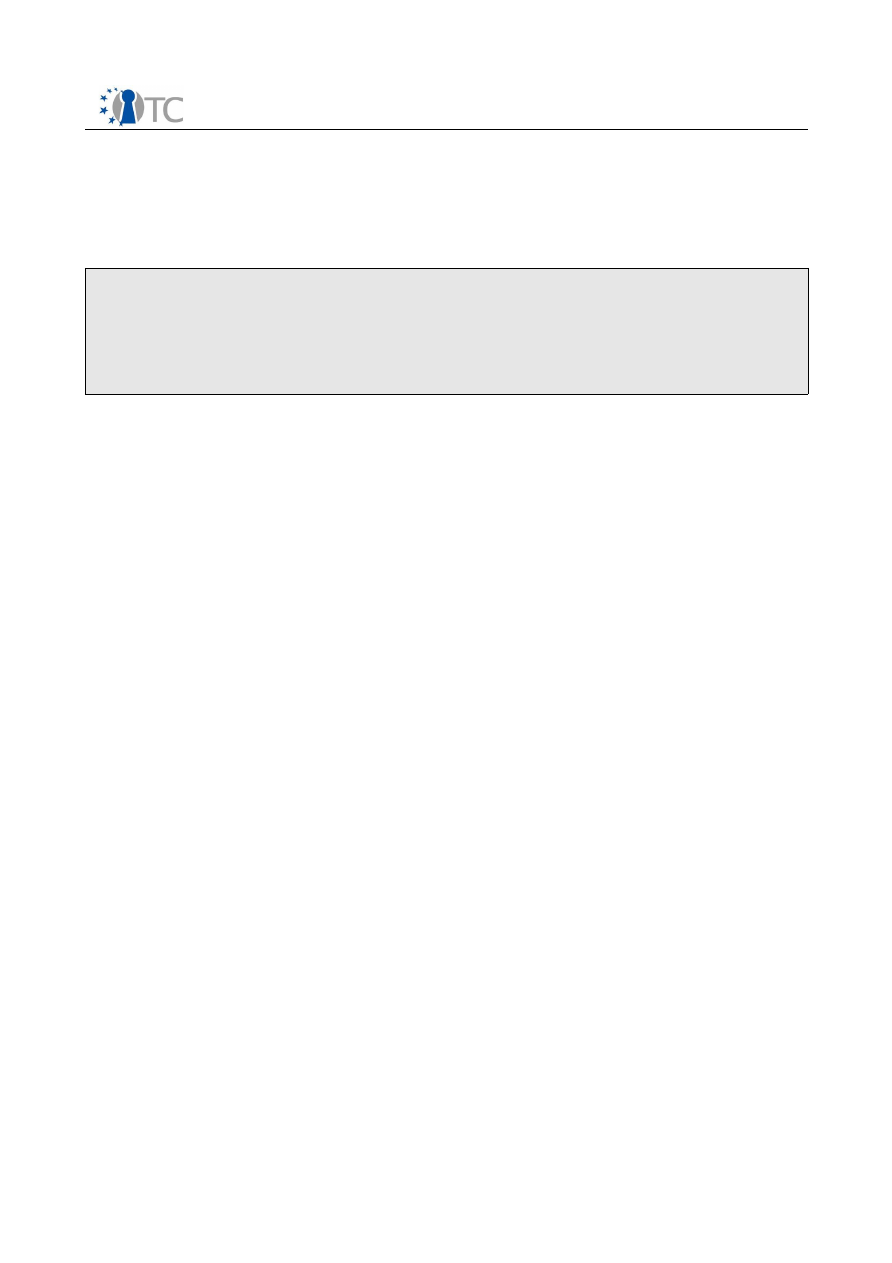
WP06d.1 Encrypted File Service C/C++ API Specification
2.4.9 trustedUserKeyBackup
int trustedUserKeyBackup(String backupUrl,
byte* backupPasswd,
byte* userPasswd)
Start of informative comment
Trusted back up operation for user keys.
End of informative comment
Parameters:
backupUrl
- URL of the directory which user keys will be
backed up(absolute url like /mnt/sda1/keys)
backupPasswd
- password for S2K encryption.
userPasswd
- password for keys which are going to be backed
up.
Returns:
If back up URL is valid, user password is correct and backup password is not
null it will return SUCCESSFUL.
Sample Usage in CLI:
$ efscli --trusted-user-keys-backup /mnt/sdb1/foo/
Enter key password :
Enter key backup password :
Reenter key backup password :
User keys back up operation -> SUCCESSFUL/FAILED
Open_TC Deliverable
44/69
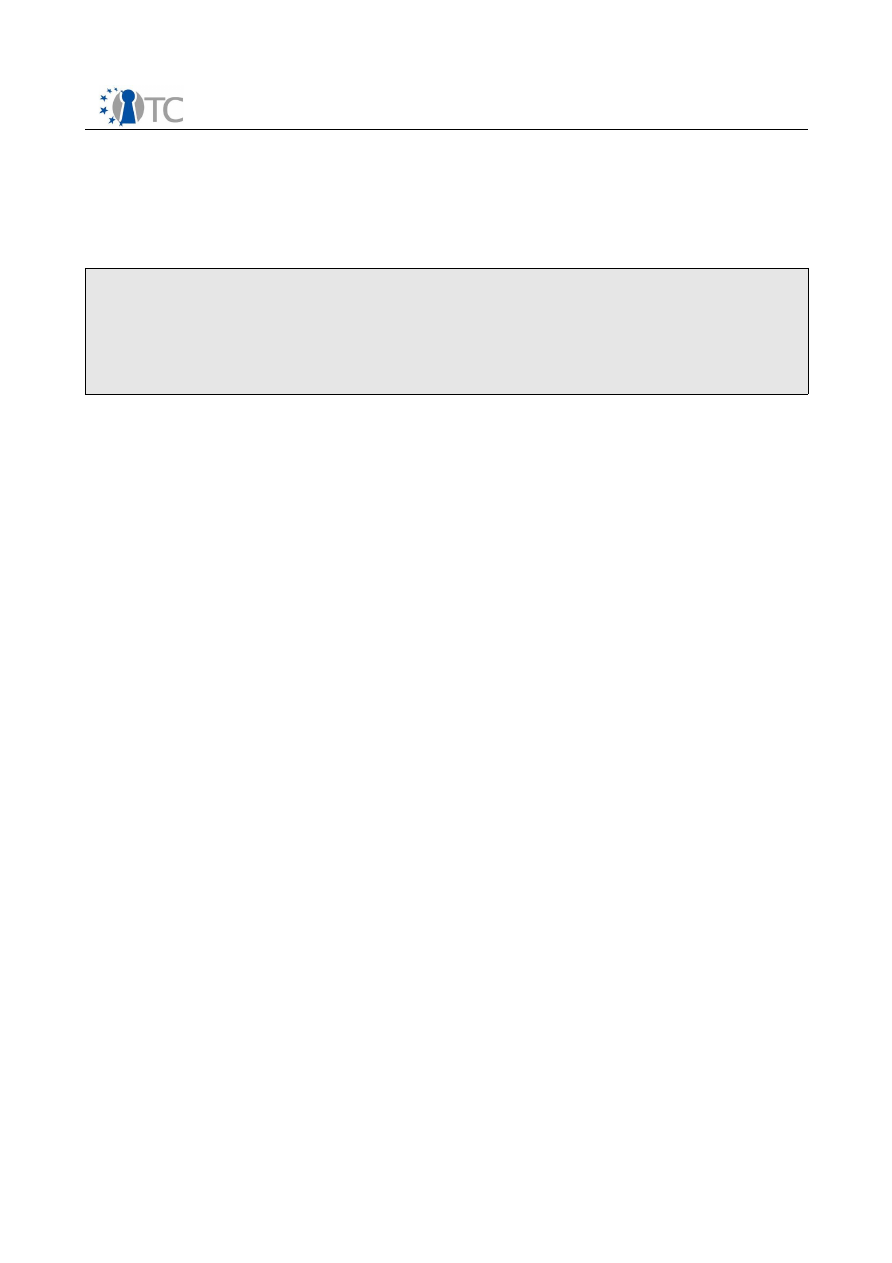
WP06d.1 Encrypted File Service C/C++ API Specification
2.4.10 trustedUserKeyRestore
int trustedUserKeysRestore(String restoreUrl,
byte* backupPasswd,
byte* userPasswd)
Start of informative comment
Trusted restore operation of user keys.
End of informative comment
Parameters:
restoreUrl
- URL of the directory which user keys will be
restored. If null they will be restored to default
directory. (absolute url like /mnt/sda1/keys)
backupPasswd
- password for S2K decryption.
userPasswd
- password for keys which are going to be restored.
Returns:
If back up URL is valid, user password is correct and backup password is not
null it will return SUCCESSFUL.
Sample Usage in CLI:
$ efscli --trusted-user-keys-restore
Enter key backup password :
Enter user password :
User keys restore operation -> SUCCESSFUL/FAILED
Open_TC Deliverable
45/69

WP06d.1 Encrypted File Service C/C++ API Specification
2.5 Recovery Agent Operations
2.5.1 sendRARegistrationRequest
int sendRARegistrationRequest(byte* adminPass)
Start of informative comment
Sends registration request to recovery server for this recovery agent.
End of informative comment
Parameters:
adminPass
- Password of the administrative user.
Returns:
If administrative password is true and an established trusted channel exists,
then it will return SUCCESSFUL.
Sample Usage in CLI:
$ efscli --register-ra
Enter Administrative Password :
Request delivery SUCCESFUL/FAILED
Open_TC Deliverable
46/69

WP06d.1 Encrypted File Service C/C++ API Specification
2.5.2 sendRAUnregistrationRequest
int sendRAUnregistrationRequest(byte* adminPass)
Start of informative comment
Sends unregistration request to recovery server for this recovery agent.
End of informative comment
Parameters:
adminPass
- Password of the administrative user.
Returns:
If administrative password is true and an established trusted channel exists,
then it will return SUCCESSFUL.
Sample Usage in CLI:
$ efscli --unregister-ra
Enter Administrative Password :
Request delivery SUCCESFUL/FAILED
Open_TC Deliverable
47/69

WP06d.1 Encrypted File Service C/C++ API Specification
2.5.3 recoveryAgentListUpdate
int recoveryAgentListUpdate(byte* adminPass)
Start of informative comment
Updates recovery agent list on registered Recovery Server if AIK credential is
reissued manually.
End of informative comment
Parameters:
adminPass
- Password of the administrative user.
Returns:
If administrative password is true and an established trusted channel exists,
then it will return SUCCESSFUL.
Sample Usage in CLI:
$ efscli --ra-list-update
Enter Administrative Password :
Request delivery SUCCESFUL/FAILED
Open_TC Deliverable
48/69

WP06d.1 Encrypted File Service C/C++ API Specification
2.6 Recovery Server Operations
2.6.1 distributeMACPolicies
int distributeMACPolicies(byte* adminPass)
Start of informative comment
Distributes current MAC policy to
all
registered Recovery Agents on Recovery Server.
End of informative comment
Parameters:
adminPass
- Password of the administrative user in RS.
Returns:
If administrative password is true and an established trusted channel exists,
then it will return SUCCESSFUL.
Sample Usage in CLI:
$ efscli --policy-distribution newpolicyfile.pol
Enter Administrative Password :
Distribution SUCCESFUL/FAILED
Open_TC Deliverable
49/69

WP06d.1 Encrypted File Service C/C++ API Specification
2.6.2 distributeRAPrivileges
int distributeRAPrivileges(byte* adminPass)
Start of informative comment
Distributes or updates privilege levels assigned to individual trusted compartments or
platforms which are represented by Recovery Agents
End of informative comment
Parameters:
adminPass
- Password of the administrative user.
Returns:
If administrative password is true and an established trusted channel exists,
then it will return SUCCESSFUL.
Sample Usage in CLI:
$ efscli --distribute-privileges newpriviledgefile.priv
Enter Administrative Password :
Distribution SUCCESFUL/FAILED
Open_TC Deliverable
50/69

WP06d.1 Encrypted File Service C/C++ API Specification
2.7 Administrative Operations
In order to complete administrative operations administrative user should have to be
logged in RS. Credential checks for this administrative user will be done by RS.
2.7.1 listRegisteredPlatforms
Platform
*
listRegisteredPlatforms()
Start of informative comment
Lists registered platforms on Recovery Server.
This command is only valid in Recovery Server
End of informative comment
Returns:
List of registered platforms
Dependency:
Platform Class(see 3.1.1)
Sample Usage in CLI:
$ efscli --list-registered-platforms
RA id - Registration Date - Update Date - Meta
1 – 12.03.2007 – 17.03.2007 – PlatformLocationAndSomeOtherMetaData
.........
23 – 14.03.2007 – 17.03.2007 – PlatformLocationAndSomeOtherMetaData
Open_TC Deliverable
51/69

WP06d.1 Encrypted File Service C/C++ API Specification
2.7.2 distributeMACPoliciesToSpecified
PlatformResults
*
distributeMACPoliciesToSpecified(int*
targetPlatformIds,int length)
Start of informative comment
Distributes policy file to the specified target platforms.
End of informative comment
Parameters:
targetPlatformsIds
- Platform ids which policies are going to be
distributed
length
- number of target platforms
Returns:
Returns policy distribution results per platform, if specified target platform
identifications are correct.
Dependency:
PlatformResults Class(see 3.1.2)
Sample Usage in CLI:
$ efscli --policy-distribution-platforms newpolicyfile.pol --target-platforms 4,7,12
Distribution of policies to the platform 4 -> SUCCESFUL/FAILED
Distribution of policies to the platform 7 -> SUCCESFUL/FAILED
Distribution of policies to the platform 12 -> SUCCESFUL/FAILED
Open_TC Deliverable
52/69

WP06d.1 Encrypted File Service C/C++ API Specification
2.7.3 listRegistrationRequests
Platform
*
listRegistrationRequests()
Start of informative comment
Lists the platform which have sent registration request to Recovery Server
End of informative comment
Returns:
List of the platforms which have registration requests
Dependency:
Platform Class(see 3.1.1)
Sample Usage in CLI:
$ efscli --list-registration-requests
RA id / Operation Request
27 -> Registration
.......
32 -> Registration
Open_TC Deliverable
53/69

WP06d.1 Encrypted File Service C/C++ API Specification
2.7.4 listUnregistrationRequests
Platform
*
listUnregistrationRequests()
Start of informative comment
Lists the unregistration requests pending on Recovery Server
End of informative comment
Returns:
List of the platforms which have unregistration requests
Dependency:
Platform Class(see 3.1.1)
Sample Usage in CLI:
$ efscli --list-unregistration-requests
RA id / Operation Request
3 -> Unregistration
.......
15 -> Unregistration
Open_TC Deliverable
54/69

WP06d.1 Encrypted File Service C/C++ API Specification
2.7.5 permitRegistrationRequests
PlatformResults
*
permitRegistrationRequests(int* platformIds, int length)
Start of informative comment
Approval of registration requests
End of informative comment
Parameters:
platformIds
- ids of the platforms which are going to be
approved for registration
length
- number of platform identification numbers
Returns:
Registration approval results per platform, if specified platform identification
numbers are correct.
Dependency:
PlatformResults Class(see 3.1.2)
Sample Usage in CLI:
$ efscli --permit-registration-request --target-platforms 4,7,12
Plaform 4 - Registration Request Approval -> SUCCESFUL/FAILED
Plaform 7 - Registration Request Approval -> SUCCESFUL/FAILED
Plaform 12 - Registration Request Approval -> SUCCESFUL/FAILED
Open_TC Deliverable
55/69

WP06d.1 Encrypted File Service C/C++ API Specification
2.7.6 denyRegistrationRequests
PlatformResults
*
denyRegistrationRequests(int* platformIds, int length)
Start of informative comment
Denial of registration requests
End of informative comment
Parameters:
platformIds
- ids of the platforms whose registration requests
are going to be rejected
length
- number of platform identification numbers
Returns:
Registration denial results per platform, if specified platform identification
numbers are correct.
Dependency:
PlatformResults Class(see 3.1.2)
Sample Usage in CLI:
$ efscli --deny-registration-request --target-platforms 4,7,12
Plaform 4 - Registration Request Denial -> SUCCESFUL/FAILED
Plaform 7 - Registration Request Denial -> SUCCESFUL/FAILED
Plaform 12 - Registration Request Denial-> SUCCESFUL/FAILED
Open_TC Deliverable
56/69

WP06d.1 Encrypted File Service C/C++ API Specification
2.7.7 permitUnregistrationRequests
PlatformResults
*
permitUnregistrationRequests(int* platformIds,int length)
Start of informative comment
Approval of unregistration requests
End of informative comment
Parameters:
platformIds
- ids of the platforms which are going to be
approved for unregistration
length
- number of platform identification numbers
Returns:
Unregistration approval results per platform, if specified platform
identification numbers are correct.
Dependency:
PlatformResults Class(see 3.1.2)
Sample Usage in CLI:
$ efscli --permit-unregistration-request --target-platforms 4,7,12
Plaform 4 - Unregistration Request Approval -> SUCCESFUL/FAILED
Plaform 7 - Unregistration Request Approval -> SUCCESFUL/FAILED
Plaform 12 - Unregistration Request Approval -> SUCCESFUL/FAILED
Open_TC Deliverable
57/69

WP06d.1 Encrypted File Service C/C++ API Specification
2.7.8 denyUnregistrationRequests
PlatformResults
*
denyUnregistrationRequests(int* platformIds, int length)
Start of informative comment
Denial of unregistration requests
End of informative comment
Parameters:
platformIds
- ids of the platforms whose unregistration
requests are going to be rejected
length
- number of platform identification numbers
Returns:
Unregistration denial results per platform, if specified platform identification
numbers are correct.
Dependency:
PlatformResults Class(see 3.1.2)
Sample Usage in CLI:
$ efscli --deny-unregistration-request --target-platforms 4,7,12
Plaform 4 - Unregistration Request Denial -> SUCCESFUL/FAILED
Plaform 7 - Unregistration Request Denial -> SUCCESFUL/FAILED
Plaform 12 - Unregistration Request Denial-> SUCCESFUL/FAILED
Open_TC Deliverable
58/69

WP06d.1 Encrypted File Service C/C++ API Specification
2.7.9 listRecoveryRequests
RecoveryList
*
listRecoveryRequests()
Start of informative comment
Lists the recovery request that comes in Recovery Server
End of informative comment
Returns:
List containing recovery items
Dependency:
RecoveryList Class(see 3.2.1)
Sample Usage in CLI:
$ efscli --list-recovery
Recovery id / RA id / RA Meta / Operation / fileName
1 / 4 /
PlatformLocationAndSomeOtherMetaData
/ Recovery / foo.txt.efs
2 / 34 /
PlatformLocationAndSomeOtherMetaData
/ Recovery / bar.pdf.efs
Open_TC Deliverable
59/69

WP06d.1 Encrypted File Service C/C++ API Specification
2.7.10 permitRecoveryRequest
RecoveryResults
*
permitRecoveryRequest(int* recoveryIds, int length)
Start of informative comment
Approval of recovery requests
End of informative comment
Parameters:
recoveryIds
- ids of the recovery requests which are waiting for
administrative approval
length
- number of platform identification numbers
Returns:
Recovery results per platform, if specified platform identification numbers
are correct.
Dependency:
RecoveryResults Class(see 3.2.2)
Sample Usage in CLI:
$ efscli --permit-recovery 2
Recovery request approved
File bar.pdf has been recovered
Open_TC Deliverable
60/69

WP06d.1 Encrypted File Service C/C++ API Specification
2.7.11 denyRecoveryRequest
RecoveryResults
*
denyRecoveryRequest(int* recoveryIds, int length)
Start of informative comment
Denial of recovery requests
End of informative comment
Parameters:
recoveryIds
- ids of the recovery requests which are waiting for
administrative approval
length
- number of platform identification numbers
Returns:
Recovery denial results per platform, if specified platform identification
numbers are correct.
Dependency:
RecoveryResults Class(see 3.2.2)
Sample Usage in CLI:
$ efscli --permit-recovery 2
Recovery request denied
File bar.pdf could not be recovered
Open_TC Deliverable
61/69

WP06d.1 Encrypted File Service C/C++ API Specification
2.7.12 configureRS
int configureRS(String confFile)
Start of informative comment
Configures Recovery Server with the given configuration file.
End of informative comment
Parameters:
confFile
- new configuration file(absolute url like /root/efsrs.conf)
Returns:
If configuration of RS has errors, function will yield FAILED. Else it will return
SUCCESSFUL.
Sample Usage in CLI:
$ efscli --rs-conf
RS Configuration update -> SUCCESFUL / FAILED
Open_TC Deliverable
62/69

WP06d.1 Encrypted File Service C/C++ API Specification
2.7.13 configureRSPolicy
int configureRSPolicy(String policyFile)
Start of informative comment
Configures policies in Recovery Server with the given policy file.
End of informative comment
Parameters:
policyFile
- new policy file (absolute url like /root/efsrs.pol)
Returns:
If policy file of RS has syntax or semantic errors, function will yield FAILED.
Else it will return SUCCESSFUL.
Sample Usage in CLI:
$ efscli --rs-policy
RS Policy update -> SUCCESFUL / FAILED
Open_TC Deliverable
63/69

WP06d.1 Encrypted File Service C/C++ API Specification
2.7.14 configureRAPrivilege
int configureRAPriviledge(String privilegeFile)
Start of informative comment
Configures priviledges in Recovery Server with the given privilege file.
End of informative comment
Parameters:
priviledgeFile
- new privileges file (absolute url
like /root/efsrs.priv)
Returns:
If privilege file of RS has syntax or semantic errors, function will yield
FAILED. Else it will return SUCCESSFUL.
Sample Usage in CLI:
$ efscli --rs-priviledge
RS Priviledge Table update -> SUCCESFUL / FAILED
Open_TC Deliverable
64/69

WP06d.1 Encrypted File Service C/C++ API Specification
3
Appendices : Other Public Classes
These classes will be used as helper classes which can be used both in delivering and
formatting the command output.
3.1 Appendix A : Platform Classes
3.1.1 Platform
Platform class helps keeping and processing information about the platforms that are
registered to RS or have registration request to RS. This class will be used to output
platform data which is easy to format.
Constructor :
Platform(int id,
String registrationDate,
String lastUpdateTime,
String metaInformation)
Creates a platform object with given information.
Parameters:
id
- - identification number of the platform
registrationDate
- - registration date of the platform
lastUpdateTime
- - Last list update time of the platform.
metaInformation
- - Other information like physical place and users
Getters :
int getId()
String getLastUpdateTime()
String getMetaInformation()
String getRegistrationDate()
Setters :
void setId(int id)
void setLastUpdateTime(String lastUpdateTime)
void setMetaInformation(String metaInformation)
void setRegistrationDate(String registrationDate)
Table 9:Platform Class Declaration
Open_TC Deliverable
65/69
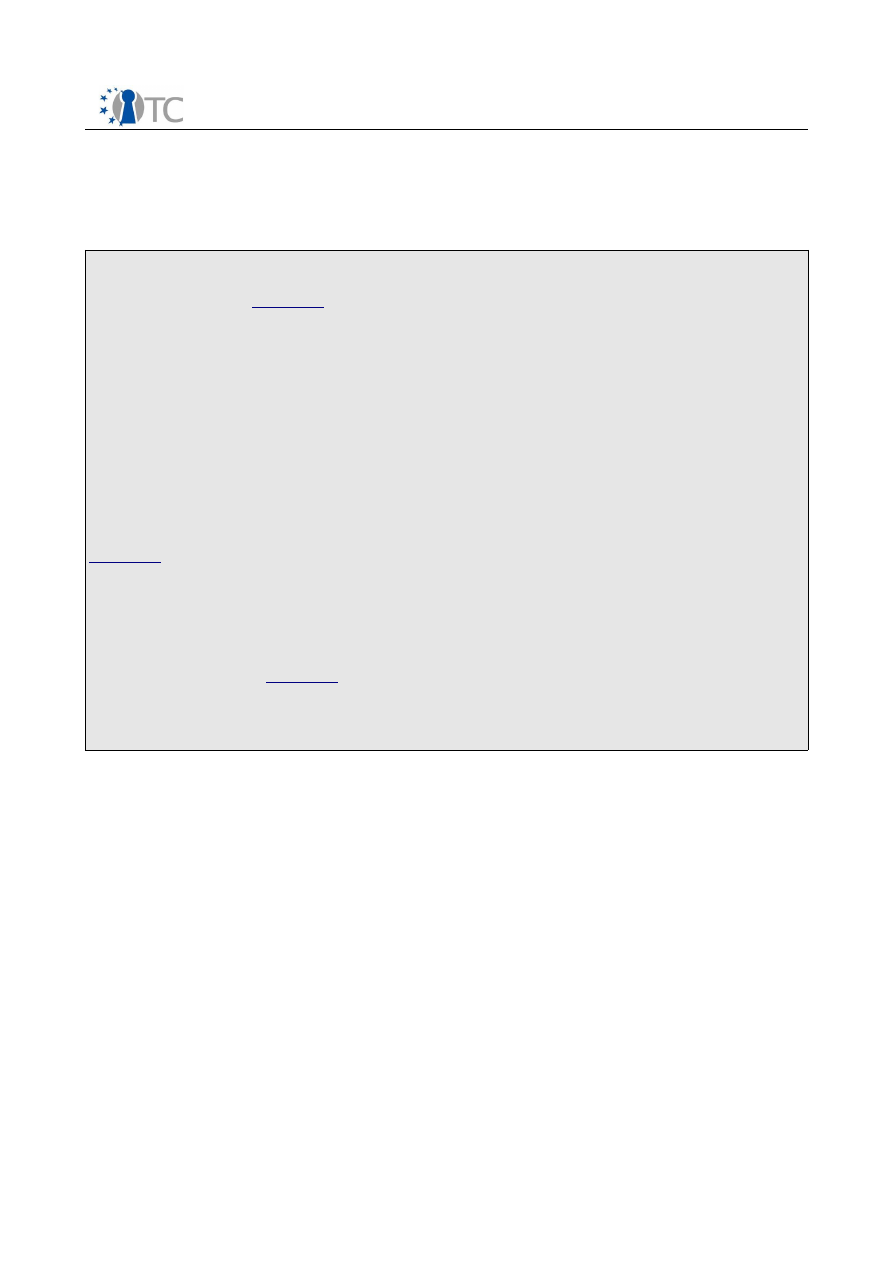
WP06d.1 Encrypted File Service C/C++ API Specification
3.1.2 PlatformResults
A helper class for displaying results of platform RA registration and unregistration
requests to RS.
Constructor :
PlatformResults(
Platform
platforms,
int result)
Creates a PlatformResults object which can keep the results of operations like
permitRegistrationRequest etc.
Parameters:
platforms
– platform that send the request
result
– result of the registration/unregistration request
Getters :
Platform
getPlatforms()
int getResult()
Setters :
void setPlatforms(
Platform
platforms)
void setResult(int result)
Table 10:PlatformResults Class Declaration
Open_TC Deliverable
66/69
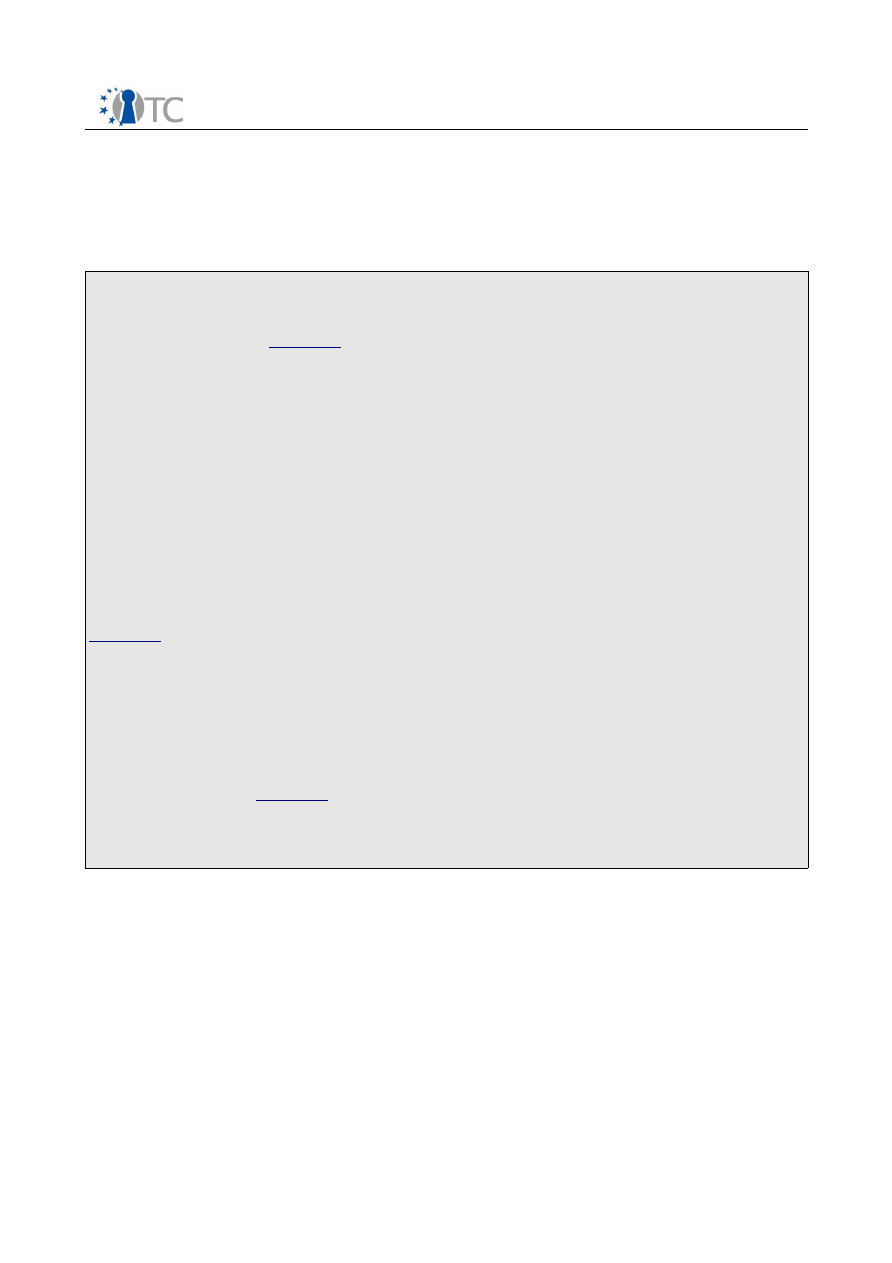
WP06d.1 Encrypted File Service C/C++ API Specification
3.2 Appendix B : Recovery Classes
3.2.1 RecoveryList
Helps keeping and listing recovery requests which arrives RS.
Constructor :
RecoveryList(int recoveryId,
Platform
platform,
String filename)
Helps keeping recovery request lists.
Parameters:
recoveryId
- identification number of the recovery request
platform
- platform which the recovery request comes from
filename
- name of the file which is going to be recovered
Getters :
String getFilename()
Platform
getPlatform()
int getRecoveryId()
Setters :
void setFilename(String filename)
void setPlatform(
Platform
platform)
void setRecoveryId(int recoveryId)
Table 11:RecoveryList Class Declaration
Open_TC Deliverable
67/69
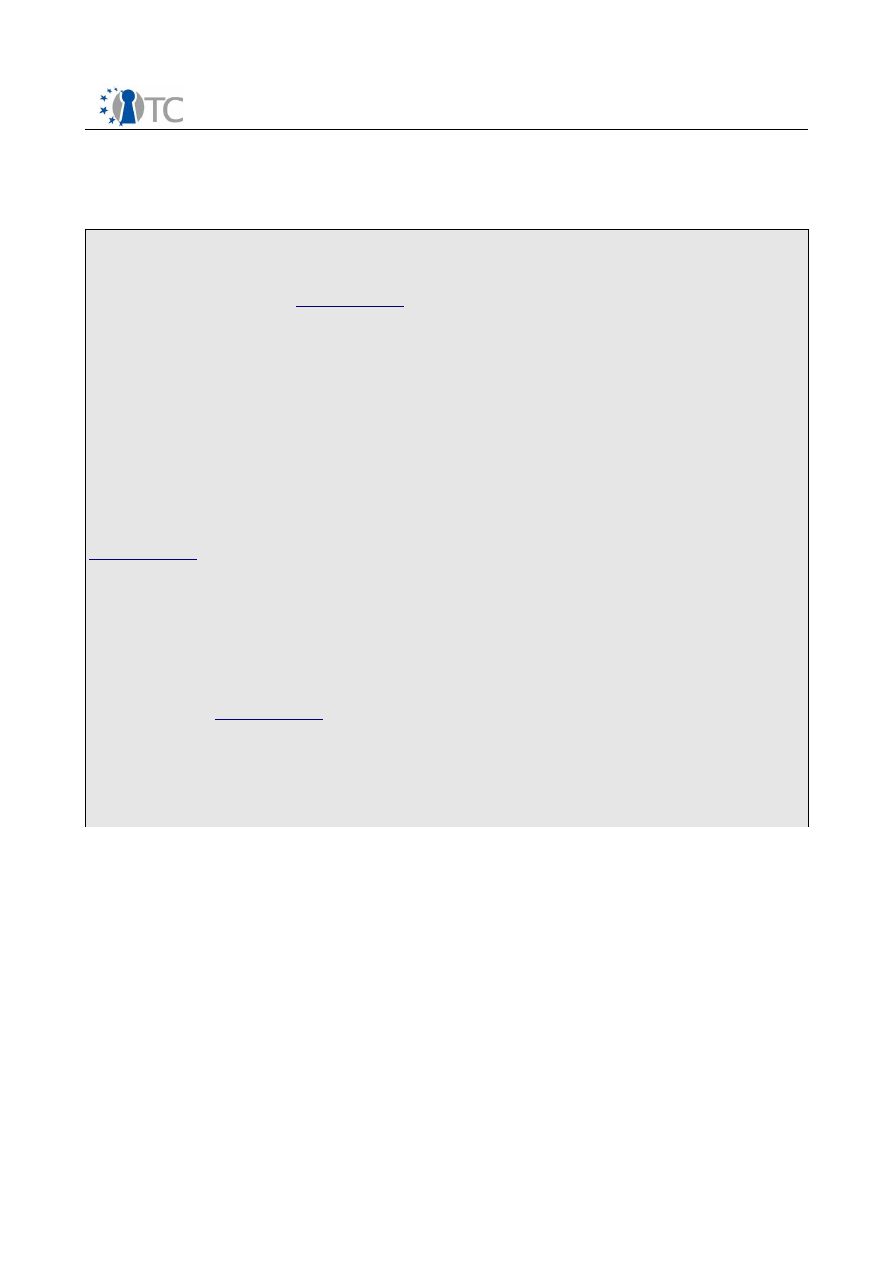
WP06d.1 Encrypted File Service C/C++ API Specification
3.2.2 RecoveryResult
Helps keeping and listing results of recovery requests which arrives RS.
Constructor :
RecoveryResults(int recoveryId,
RecoveryList
list,
int result)
Keeps the result of remote recovery opration.
Parameters:
recoveryId
- identification number of the recovery id
list
- list which keeps Recovery request
result
- result of the recovery process
Getters :
RecoveryList
getList()
int getRecoveryId()
int getResult()
Setters :
void setList(
RecoveryList
list)
void setRecoveryId(int recoveryId)
void setResult(int result)
Table 12:RecoveryResult Class Declaration
Open_TC Deliverable
68/69

WP06d.1 Encrypted File Service C/C++ API Specification
3.3 Appendix C : Key Information Class
3.3.1 KeyInfo
Helps keeping and listing user keys which is in user's keystore.
Constructor :
KeyInfo(int keyid,
String keyName,
byte* keyHash)
Creates a KeyInfo object for listing keys in he desired format.s
Parameters:
keyid
- identification number of the key
keyName
- name of the key
keyHash
- hash value of the key
Getters :
byte* getKeyHash()
int getKeyid()
String getKeyName()
Setters :
void setKeyHash(byte* keyHash)
void setKeyid(int keyid)
void setKeyName(String keyName)
Table 13:KeyInfo Class Declaration
Open_TC Deliverable
69/69










































































































































































































































































































